Birds of Islay listed by their systematic.
Schellente am Südende des Pfäffikersee Ich hätte gern ein besseres Foto aber die Schellenten waren nur etwa 100 Meter vom
Weg entfernt und dazu hinter Schilf. Auch mein 600mm Objektiv hat nicht gereicht,
aber zugegeben, ein Stativ hätte geholfen. 2021-01-26 15.36.26 Pfäffikersee
First observed in 🇨🇭 on 2021-01-26.
This bird appears across the great seas in the following continents:
Europe, North America.
Etymology: Nabu: Schellenten verdanken ihren Namen dem pfeifenden und wie ein Klingeln («Schellen») tönenden Fluggeräusch. [Vogelwarte.ch erklärt: ]
Gruener Kopf mit gelbem Auge (Goldeneye), weisser Kreis zwischen Auge und (schwarzem) Schnabel, weisser Bauch und Seiten mit etwa 5 duennen schwarzen Streifen, schwarzer Ruecken. In Island gibt's eine sehr aehnliche Ente und in kleineren Mengen auch diese.
Wintergast am Pfäffikersee.
Vocalization: ![]() Male display sound a dry nasal disyllabic "Ka-weerr". First note introductory and second longer and descending. Usually accompanied by back-throwing head motion. Female: dry harsh "aahrrrr aahrrrr aahrrrr ". Wings make a characteristic whistling sound. [Link]
Male display sound a dry nasal disyllabic "Ka-weerr". First note introductory and second longer and descending. Usually accompanied by back-throwing head motion. Female: dry harsh "aahrrrr aahrrrr aahrrrr ". Wings make a characteristic whistling sound. [Link]
Physical details: length=42-50 cm,
wingspan=65-80 cm,
weight=650-1200 g
Habitats:
River and lake
Mittelsaeger Weibchen auf Lago Maggiore, Locarno. 2021-04-06 13.18.48 Northern Lago Maggiore
First observed in 🇨🇭 on 2021-04-06.
This bird appears across the great seas in the following continents:
Europe, North America.
Personal notes: ![]() Zuerst gesehen in Lago Maggiore in Locarno. Jan 2022 auch als Wintergast am Pfaeffikersee. [Link]
Zuerst gesehen in Lago Maggiore in Locarno. Jan 2022 auch als Wintergast am Pfaeffikersee. [Link]
Appearance and identification: ![]() In winter you can admire a few of these birds with the straggly tuft. [Link]
In winter you can admire a few of these birds with the straggly tuft. [Link]
Habitats:
River and lake
Looks similar to:
Greater scaup.
Gänsesäger am Nordende des Pfäffikersee 2021-01-26 17.02.58 Pfäffikersee
First observed in 🇨🇭 on 2021-01-26.
This bird appears across the great seas in the following continents:
Europe, North America.
Zuerst gesehen am Pfäffikersee.
Vocalization: ![]() Male: Mostly heard when courting. A twanging, disyllabic "whip-ooooo", first syllable ascending and second whistle-like and rapidly falling. Female: A coarse "ahrrr ahrrrr", or a raspy drawn "ah-ahrrrrrr ah-ahrrrrr", slightly rising, then falling in pitch. Also various cackling sounds. [Link]
Male: Mostly heard when courting. A twanging, disyllabic "whip-ooooo", first syllable ascending and second whistle-like and rapidly falling. Female: A coarse "ahrrr ahrrrr", or a raspy drawn "ah-ahrrrrrr ah-ahrrrrr", slightly rising, then falling in pitch. Also various cackling sounds. [Link]
Physical details: length=58-66 cm,
wingspan=82-97 cm,
weight=900-2100 g
Habitats:
River and lake
Song:
Automatically generated from Xeno-Canto recording
Song attributes:
Frequency:
♫ Source: BirdNet
20210510_090939 birdnet 1539 - Common Merganser plus Golden Oriole - = - Common Merganser - Locarno.mp3
2021-05-10 09.09.39 Locarno (song)
Eiderente, vom Steg aus gesehen in Rapperswil. 2021-02-12 13.42.20 Rapperswil
First observed in Iceland on 2015-06-09.
This bird appears across the great seas in the following continents:
Europe, North America.
Etymology: Nabu: Auch heute noch erinnert ihr wissenschaftlicher Name an die Bedeutung ihrer isolierenden Daunen für die Menschen. Übersetzt bedeutet ihr Name nämlich „die Allerweichste mit dem schwarzen Körper“. [Link]
Geography: ![]() Die im Norden Europas häufige und wegen ihren Daunenfedern bekannte Eiderente war in der Schweiz früher ein seltener Gast. Doch in der zweiten Hälfte des 20. Jahrhunderts erfolgten mehrere grosse Einflüge. Dank der Wandermuschelvermehrung war das Nahrungsangebot ausreichend und die Vögel verbrachten zunehmend den Sommer bei uns. Mittlerweile gehört die Eiderente sogar zu den Brutvögeln, was für einen ans Meer angepassten Vogel bemerkenswert ist. [Link]
Die im Norden Europas häufige und wegen ihren Daunenfedern bekannte Eiderente war in der Schweiz früher ein seltener Gast. Doch in der zweiten Hälfte des 20. Jahrhunderts erfolgten mehrere grosse Einflüge. Dank der Wandermuschelvermehrung war das Nahrungsangebot ausreichend und die Vögel verbrachten zunehmend den Sommer bei uns. Mittlerweile gehört die Eiderente sogar zu den Brutvögeln, was für einen ans Meer angepassten Vogel bemerkenswert ist. [Link]
Calls: ![]() Males call a typical, pleasant, clear, 2-3 second long "aaaooooooh". Starting on a low note, slowly ascending and ending on a descending note. Usually accompanied by the female "ga ga ga ga". [Link]
Males call a typical, pleasant, clear, 2-3 second long "aaaooooooh". Starting on a low note, slowly ascending and ending on a descending note. Usually accompanied by the female "ga ga ga ga". [Link]
Physical details: length=50-71 cm,
wingspan=80-108 cm,
weight=1500-2800 g
Habitats:
River and lake
Mother and 4 of 9 babies on the Pfäffikersee 2020-05-20 09.12.44 Pfäffikersee
First observed in 🇨🇭 on 2020-05-20.
This bird appears across the great seas in the following continents:
Europe, North America, South America, Africa.
Common waterbird at Pfäffikersee
Etymology: ![]() Der heutige Name kann als Hinweis auf ihre Brutplätze verstanden werden, zu denen auf Stock gesetzte Weiden, Weidengebüsch oder auch Reisighaufen gehören.
['Stock' wird weiter erklärt: Als Stockausschlag bezeichnet man bei Bäumen und Sträuchern Triebe, die nach dem Verlust der primären Sprossachse
neu aus dem Stumpf oder Stubben (der dann „Stock“ genannt wird) austreiben.] [Link]
Der heutige Name kann als Hinweis auf ihre Brutplätze verstanden werden, zu denen auf Stock gesetzte Weiden, Weidengebüsch oder auch Reisighaufen gehören.
['Stock' wird weiter erklärt: Als Stockausschlag bezeichnet man bei Bäumen und Sträuchern Triebe, die nach dem Verlust der primären Sprossachse
neu aus dem Stumpf oder Stubben (der dann „Stock“ genannt wird) austreiben.] [Link]
![]() The name 'was derived from the Old French malart or mallart for "wild drake"' [Link]
The name 'was derived from the Old French malart or mallart for "wild drake"' [Link]
Vocalization: ![]() Female: A distinct coarse, laughing quacking; "haaa ha ha ha ha ha", with first note accented and then descending in pitch. Male: a more silent, very nasal "rriib". [Link]
Female: A distinct coarse, laughing quacking; "haaa ha ha ha ha ha", with first note accented and then descending in pitch. Male: a more silent, very nasal "rriib". [Link]
Calls: ![]() Display call a high-pitched short whistle. [Link]
Display call a high-pitched short whistle. [Link]
Physical details: length=50-65 cm,
wingspan=81-98 cm,
weight=750-1450 g
Habitats:
River and lake
Krickente am Aa-Bach beim Südende des Pfäffikersee 2021-01-26 15.41.54 Pfäffikersee
First observed in 🇨🇭 on 2021-01-26.
This bird appears across the great seas in the following continents:
Europe, North America, South America, Africa, Asia.
Wintergast am Teich am Aa-Bach beim Südende des Pfäffikersee
Etymology: ![]() Die hellen «krrik»-Rufe der stimmfreudigen Erpel verhalfen dieser Art zu ihrem deutschen Namen. [Link]
Die hellen «krrik»-Rufe der stimmfreudigen Erpel verhalfen dieser Art zu ihrem deutschen Namen. [Link]
Vocalization: ![]() Male: characteristic, short, highly resonant and metallic "plytt". A bit similar to Pintail, but higher pitched and lacking accompanying whistling sound. Female: various quacking sounds generally quicker paced, more nasal and noticeably higher pitched than Mallard. [Link]
Male: characteristic, short, highly resonant and metallic "plytt". A bit similar to Pintail, but higher pitched and lacking accompanying whistling sound. Female: various quacking sounds generally quicker paced, more nasal and noticeably higher pitched than Mallard. [Link]
Physical details: length=34-38 cm,
wingspan=58-64 cm,
weight=200-450 g
Habitats:
River and lake
Song:
Automatically generated from Xeno-Canto recording
Song attributes:
Frequency:
♫ XC619133-Krickente von Peter Bosman, Belgium. Source: XENOCANTO
XC619133-Krickente von Peter Bosman, Belgium.mp3
(song)

Call:
Blup blup, fast wie vom Computer generiert, fur mich nohe Noten (obwohl Sonogram nur 2.5 KHz zeigt)
Krickente Ruf von XenoCanto
♫ Krickente Ruf von XenoCanto Source: XENOCANTO
XC619133-Krickente von Peter Bosman, Belgium.mp3
(call)

Call attributes:
Call melody: simple rhythmic, slow, Frequency: low (1-3 KHz),
Loeffelenten am Greifensee bei Silberweide Es gab dutzende davon, dazwischen eine Krickente. 2021-02-08 15.20.36
First observed in 🇨🇭 on 2021-02-08.
This bird appears across the great seas in the following continents:
Europe, North America, South America, Africa.
Wintergast am Greifensee.
PK: white, black, rust-brown, yellow eyes, black spoonbill, red legs.
Vocalization: ![]() Male is characteristic and most often heard: A hoarse nasal knocking sound "took took", often staccato or disyllabic. Female similar to Mallard but flatter and more creaking. [Link]
Male is characteristic and most often heard: A hoarse nasal knocking sound "took took", often staccato or disyllabic. Female similar to Mallard but flatter and more creaking. [Link]
Physical details: length=44-52 cm,
wingspan=70-84 cm,
weight=470-800 g
Habitats:
River and lake
Profile Wikipedia eBird Vogelwarte BirdLife ZH ornitho.ch Audubon AllAboutBirds Xeno-Canto BirdID NABU
Spiessente Paar. 2022-02-05 13.14.54 Klingnauer Stausee (man-made lake)
First observed in 🇨🇭 on 2022-02-05.
This bird appears across the great seas in the following continents:
Europe, North America, South America, Africa, Asia.
Long tailfeathers make the name obvious, also a thin white stripe from the white neck up the back of the head.
Vocalization: ![]() Female: similar to Mallards coarse laughing sound, but with a more emphasized first "haaa", and a more silent accelerating subsequent "laugh". Male: Pleasant, resonant "plop" similar to Teal, but lower pitched, richer, mellower and not so metallic. Accompanied by a higher pitched, slightly raspy whistling "aiiooo" rising and falling in pitch. [Link]
Female: similar to Mallards coarse laughing sound, but with a more emphasized first "haaa", and a more silent accelerating subsequent "laugh". Male: Pleasant, resonant "plop" similar to Teal, but lower pitched, richer, mellower and not so metallic. Accompanied by a higher pitched, slightly raspy whistling "aiiooo" rising and falling in pitch. [Link]
Physical details: length=51-66 cm,
wingspan=51-66 cm,
weight=500-1100 g
Habitats:
River and lake
Pfeifente Erpel , Neeracher Ried. Die zehnte Entenart, die ich gefunden habe. 2021-02-24 14.05.08 Neeracherried
First observed in 🇨🇭 on 2021-02-24.
This bird appears across the great seas in the following continents:
Europe, North America, Africa.
Etymology: ![]() Es ist der Ruf des Männchens, der zu dem deutschen Namen der Art geführt hat. Das Männchen leitet seine kurzen, scharfen, zwei- bis dreisilbigen pfeifenden wiu-Rufe häufig mit einem krr krkrkrr ein. [Link]
Es ist der Ruf des Männchens, der zu dem deutschen Namen der Art geführt hat. Das Männchen leitet seine kurzen, scharfen, zwei- bis dreisilbigen pfeifenden wiu-Rufe häufig mit einem krr krkrkrr ein. [Link]
Funny red head (made me confused it with the Kolbente) that's brown with a golden forehead (Kolbente is brown, a bit lighter at the back of the head) is the obvious characteristic. Also has a nice black and white pattern on its back and wings with white-rimmed black feathers at the end of the wing, a bit of white before a black butt.
Vocalization: ![]() Male: a pleasant high pitched whistle "piiiiuuu", rapidly rising in pitch and then falling. Quite vocal. Female: a harsh "kraaa kraaa kraa" more like female diving-ducks than other dabbling-ducks. [Link]
Male: a pleasant high pitched whistle "piiiiuuu", rapidly rising in pitch and then falling. Quite vocal. Female: a harsh "kraaa kraaa kraa" more like female diving-ducks than other dabbling-ducks. [Link]
Physical details: length=45-51 cm,
wingspan=75-86 cm,
weight=500-1000 g
Habitats:
River and lake
Song:
Automatically generated from Xeno-Canto recording
Song attributes:
Frequency:
♫ XC613742-Pfeifente von Adrien Mauss. Source: XENOCANTO
XC613742-Pfeifente von Adrien Mauss.mp3
(song)
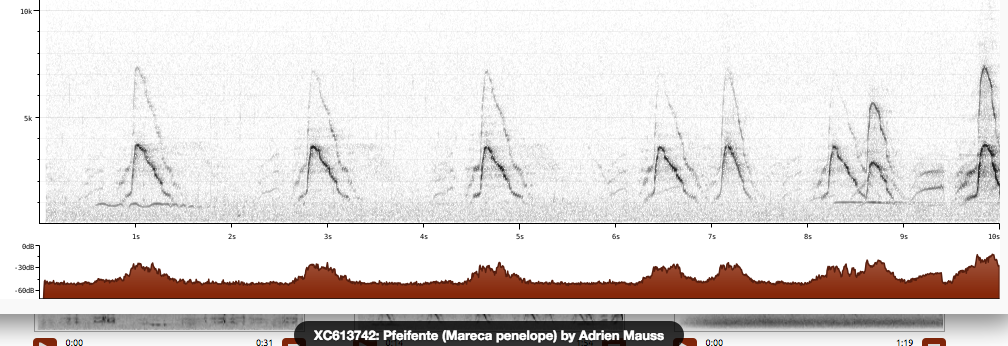
Call:
Pfeifen, fast wie ein Rotmilan oder Maeusebussard. Ton steigt und faellt!
Pfeifente von XenoCanto
♫ Pfeifente von XenoCanto Source: XENOCANTO
XC613742-Pfeifente von Adrien Mauss.mp3
(call)

Call attributes:
Call melody: simple rhythmic, slow, Frequency: low (1-3 KHz),
Schnatterente am Greifensee bei Silberweide Es gab dutzende davon, dazwischen eine Krickente. 2021-02-08 15.45.18
First observed in 🇨🇭 on 2021-02-08.
This bird appears across the great seas in the following continents:
Europe, North America, Africa.
In my mind this is the chocolate duck.
Etymology: ![]() The etymology of the word gadwall is not known, but the name has been in use since 1666.[9] [Link]
The etymology of the word gadwall is not known, but the name has been in use since 1666.[9] [Link]
Nabu: Die Schnatterente fällt aber – wie ihr Name schon vermuten lässt – durch ihre Art der Nahrungssuche auf. Sie durchschnattert das Wasser mit ihrem Schnabel. [Link]
Chocolate bill, black-and-white pattern on head, shoulders, belly, sides of wings, chocolate patterned wings, black butt, a bit of white before the butt.
Appearance and identification: Nabu: Die Schnatterente ähnelt auf den ersten Blick so sehr der weiblichen Stockente, dass man diese schnell verwechseln kann. [Link]
Wintergast am Greifensee.
Calls: ![]() Males display-call a short dry rattling or croaking sound and some high whistling notes. Female quacking similar to Mallard, but drier and shriller. [Link]
Males display-call a short dry rattling or croaking sound and some high whistling notes. Female quacking similar to Mallard, but drier and shriller. [Link]
Physical details: length=46-56 cm,
wingspan=84-95 cm,
weight=550-1000 g
Habitats:
River and lake
Song:
Automatically generated from Xeno-Canto recording
Song attributes:
Frequency:
♫ Schnatterenten, Moewen und an 29 Sekunden eindeutig ein Jet von Swiss, da wir in Neeracherried sehr nach am Kloten Flughafen sind, BirdNet schlaegt auch Teichrohrsaenger vor, wie auch ein Moewe-Typ aus Kalifornien. ![]() Source: Zoom H6 2021-10-24 13.12.46 Neeracherried (song)
Source: Zoom H6 2021-10-24 13.12.46 Neeracherried (song)
Tafelente in Rapperswil. 2021-02-12 13.34.38 Rapperswil
First observed in 🇨🇭 on 2021-02-08.
This bird appears across the great seas in the following continents:
Europe, North America, Africa.
Wintergast am Greifensee.
Etymology: ![]() Die in der deutschen Sprache übliche Bezeichnung Tafelente ist ein Hinweis auf das als schmackhaft angesehene Fleisch dieses Entenvogels. [Link]
Die in der deutschen Sprache übliche Bezeichnung Tafelente ist ein Hinweis auf das als schmackhaft angesehene Fleisch dieses Entenvogels. [Link]
Tafelente: Wiederspruch: wer isst ein Tier mit roten Augen?Rostbraun, schwarz, schwarz-weiss-gemustert, Schnabel schwarz UND weiss.
Vocalization: ![]() Female: a coarse "ahrrrrrrr-ahrrrrr-ahrrrr" with a vibrating quality. [Link]
Female: a coarse "ahrrrrrrr-ahrrrrr-ahrrrr" with a vibrating quality. [Link]
Calls: ![]() Male courting call a pleasant, drawn out, nasal whistle "tweeeeep", rising in pitch, often followed by a falling "puuuh" (e.g a long disyllabic tweeepuuuuuuh). Also a sharper "ki-ki-ki" or "ki-ki-kiko". [Link]
Male courting call a pleasant, drawn out, nasal whistle "tweeeeep", rising in pitch, often followed by a falling "puuuh" (e.g a long disyllabic tweeepuuuuuuh). Also a sharper "ki-ki-ki" or "ki-ki-kiko". [Link]
Physical details: length=42-49 cm,
wingspan=72-82 cm,
weight=650-1200 g
Habitats:
River and lake
Reiherente closeup bei Jona. 2021-02-12 10.34.46 Jona
First observed in Iceland on 2015-06-05.
Schwarz-weiss mit Muster auf Ruecken/Fluegel, gelbe Augen, blau-grauer Schnabel mit schwarzer Spitze
On a lake in wintertime.
Geography: ![]() 'Die Reiherente ... zählt zu den so genannten Tauchenten und gilt als die häufigste Süßwassertauchente. Es handelt sich um eine verhältnismäßig kleine, kompakt gebaute Ente. Auffällig sind der verhältnismäßig kurze Schnabel und der auffällig runde Kopf. Die Männchen haben am Hinterkopf einen langen, herabhängenden Schopf. Das Weibchen weist eine kurze Holle auf.
Die Reiherente ist in Mitteleuropa ein verbreiteter Brut- und Jahresvogel',
und in der Schweiz ein Wintergast. [Link]
'Die Reiherente ... zählt zu den so genannten Tauchenten und gilt als die häufigste Süßwassertauchente. Es handelt sich um eine verhältnismäßig kleine, kompakt gebaute Ente. Auffällig sind der verhältnismäßig kurze Schnabel und der auffällig runde Kopf. Die Männchen haben am Hinterkopf einen langen, herabhängenden Schopf. Das Weibchen weist eine kurze Holle auf.
Die Reiherente ist in Mitteleuropa ein verbreiteter Brut- und Jahresvogel',
und in der Schweiz ein Wintergast. [Link]
Vocalization: ![]() Male display sound: High pitched short whistling-like noises, "pjuu-uu", not very audible. [Link]
Male display sound: High pitched short whistling-like noises, "pjuu-uu", not very audible. [Link]
Calls: ![]() Both sexes have harsh "ahrrrr" calls like other diving ducks, sometimes with a crow-like quality. [Link]
Both sexes have harsh "ahrrrr" calls like other diving ducks, sometimes with a crow-like quality. [Link]
Physical details: length=40-47 cm,
wingspan=67-73 cm,
weight=500-1000 g
Habitats:
River and lake

Wikipedia: Greater scaup Source: OTHER
1200px-2017-03-24_Aythya_marila%2C_male%2C_Killingworth_Lake%2C_Northumberland_15.jpg
This bird appears across the great seas in the following continents:
Europe, North America.
Deutschland: Zugvogel, Wintergast RL R
Calls: ![]() Male call carries only a few meters: a whistling "po-ho" last syllable slowly descending. Female calls with harsh "harr-harrr-harrr". [Link]
Male call carries only a few meters: a whistling "po-ho" last syllable slowly descending. Female calls with harsh "harr-harrr-harrr". [Link]
Physical details: length=42-51 cm,
wingspan=72-84 cm,
weight=700-1300 g
Habitats:
River and lake
Looks similar to:
Red-breasted merganser.
Profile Wikipedia eBird Vogelwarte BirdLife ZH ornitho.ch Xeno-Canto BirdID NABU
Brandgans mal zwei. 2022-02-05 13.43.48 Klingnauer Stausee (man-made lake)
First observed in 🇨🇭 on 2022-02-05.
Deutschland: Brut-, Jahres-, Zugvogel, Wintergast
Vocalization: ![]() Male: Various whistling sounds. Often series of ricochet-like "piu" repeated with gradually rising and falling intensity. Also passerine-like "tzzrrrr". Female: different variants on deeper hoarse sounds like "ar-ar-ar-ar" sometimes with accented endings with rising pitch. [Link]
Male: Various whistling sounds. Often series of ricochet-like "piu" repeated with gradually rising and falling intensity. Also passerine-like "tzzrrrr". Female: different variants on deeper hoarse sounds like "ar-ar-ar-ar" sometimes with accented endings with rising pitch. [Link]
Physical details: length=58-67 cm,
wingspan=110-133 cm,
weight=800-1450 g
Habitats:
River and lake
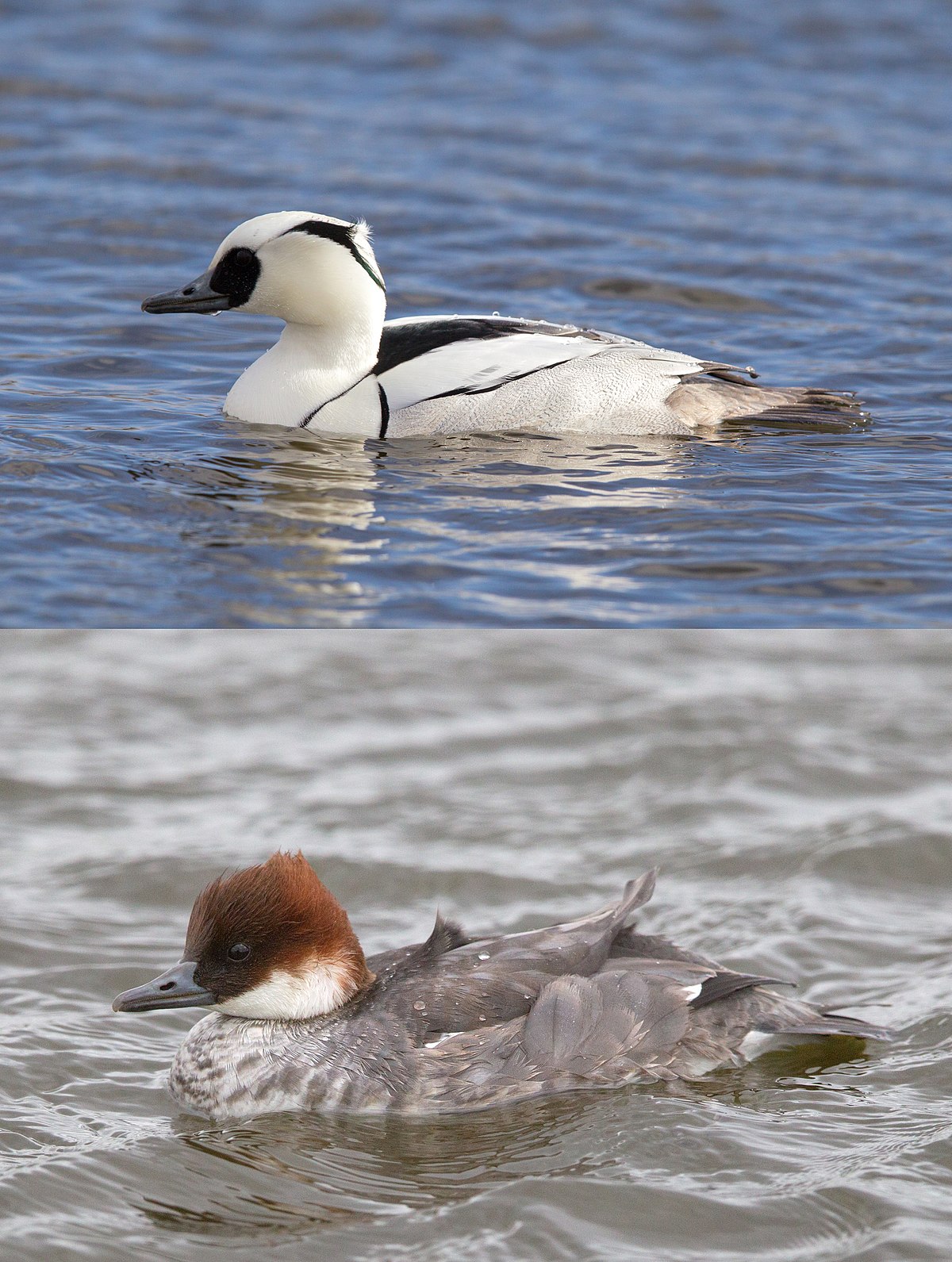
Wikipedia: Smew Source: OTHER
1200px-Zwergsaeger_maenchen_weibchen.jpg
Deutschland: Zugvogel, Wintergast
Vocalization: ![]() Mostly quiet except when displaying, and even then difficult to hear. Male: an ascending, froglike, rattling pulse of clicks. Also various grunting sounds. [Link]
Mostly quiet except when displaying, and even then difficult to hear. Male: an ascending, froglike, rattling pulse of clicks. Also various grunting sounds. [Link]
Calls: ![]() Alarm call a harsh "Kraaa". [Link]
Alarm call a harsh "Kraaa". [Link]
Physical details: length=38-44 cm,
wingspan=55-69 cm,
weight=500-800 g
Habitats:
River and lake
Profile Wikipedia eBird Vogelwarte BirdLife ZH ornitho.ch Audubon AllAboutBirds Xeno-Canto NABU

Wikipedia: Long-tailed duck Source: OTHER
Long-tailed-duck.jpg
This bird appears across the great seas in the following continents:
Europe, North America.
Deutschland: Zugvogel, Wintergast
Habitats:
River and lake
Sieben Samtenten, Durchzuegler die nicht in der Schweiz bleiben. 2023-02-09 16.15.58 Sils
First observed in 🇨🇭 on 2023-02-09.
This bird appears across the great seas in the following continents:
Europe, North America.
Deutschland: Zugvogel, Wintergast
Vocalization: ![]() Seldom heard. [Link]
Seldom heard. [Link]
Calls: ![]() Calls: Short accented "tup tup tup" and a shivering "gahhahahaha". [Link]
Calls: Short accented "tup tup tup" and a shivering "gahhahahaha". [Link]
Physical details: length=51-58 cm,
wingspan=90-99 cm,
weight=1100-2000 g
Habitats:
River and lake

Wikipedia: Common scoter Source: OTHER
1200px-Eurasian_common_scoter.jpg
This bird appears across the great seas in the following continents:
Europe, North America, Africa.
General: ![]() Anas nigra Linnaeus, 1758
[more]
Anas nigra Linnaeus, 1758
[more]
Vocalization: ![]() More vocal than other Scoters. Short, whistling sounds, sometimes reminiscent of a male teal, but a little bit deeper in pitch. [Link]
More vocal than other Scoters. Short, whistling sounds, sometimes reminiscent of a male teal, but a little bit deeper in pitch. [Link]
Physical details: length=44-54 cm,
wingspan=79-90 cm,
weight=650-1300 g
Habitats:
River and lake
Graugans paar. 2021-03-07 12.23.32
First observed in 🇨🇭 on 2021-02-26.
Found on practically all Swiss lakes, especially north of the alps.
Appearance and identification: ![]() Grösste europäische Wildgans. [Link]
Grösste europäische Wildgans. [Link]
Vocalization: ![]() Various cackling and honking sounds "gaiiiaia-ga-ga". [Link]
Various cackling and honking sounds "gaiiiaia-ga-ga". [Link]
Calls: ![]() Typically the first syllable is accented, and given with a register break into higher pitch (at 0:18 in recording). [Link]
Typically the first syllable is accented, and given with a register break into higher pitch (at 0:18 in recording). [Link]
Physical details: length=75-90 cm,
wingspan=147-180 cm,
weight=2100-4300 g
Habitats:
River and lake
Profile Wikipedia eBird Xeno-Canto NABU
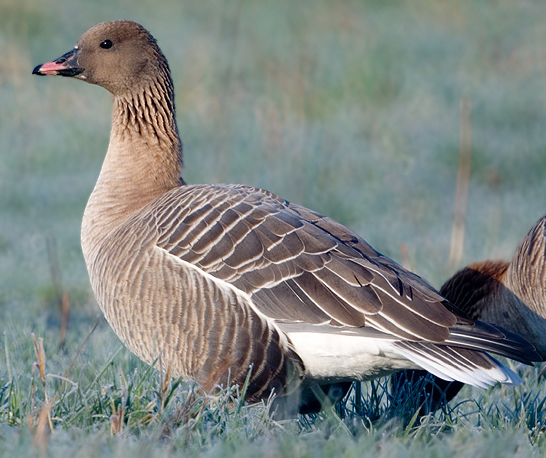
Wikipedia: Pink-footed goose Source: OTHER
KurzschnabelgansRL.jpg
Deutschland: Zugvogel, Wintergast Bruten gehen auf entflogene Tiere zurück

Wikipedia: Taiga bean goose Source: OTHER
Bean.goose.600pix.jpg
This bird appears across the great seas in the following continents:
Europe, North America, Africa.
Deutschland: Zugvogel, Wintergast Bruten gehen auf entflogene Tiere zurück
Calls: ![]() Do not call as much as other grey geese. Sounds similar to the lower sounds of Pink-footed goose, with various reedy calls, but harder, less nasal and more of a "sore throat". [Link]
Do not call as much as other grey geese. Sounds similar to the lower sounds of Pink-footed goose, with various reedy calls, but harder, less nasal and more of a "sore throat". [Link]
Physical details: length=66-84 cm,
wingspan=142-175 cm,
weight=2220-4060 g
Habitats:
River and lake
White-fronted goose closeup, on the way home from Laphroiag? 2023-08-11 13.38.38 Islay
First observed in Islay on 2023-08-11.
This bird appears across the great seas in the following continents:
Europe, North America, Africa.
Deutschland: Zugvogel, Wintergast Bruten gehen auf entflogene Tiere zurück
Habitats:
River and lake
On the frozen Pfäffikersee with coots After a week of freezing temperatures, the lake developed a thin layer of ice. 2021-02-15 08.28.58
First observed in 🇨🇭 on 2021-02-12.
This bird appears across the great seas in the following continents:
Europe, North America, Africa.
Common waterbird at Pfäffikersee, very common on Lake Zurich.
Vocalization: ![]() Silent compared to other swans. A repertoire of snorting, grunting and hissing sound when interacting. No far carrying sounds. [Link]
Silent compared to other swans. A repertoire of snorting, grunting and hissing sound when interacting. No far carrying sounds. [Link]
Calls: ![]() Wings produce prominent singing sound which may function as a flight contact-call. [Link]
Wings produce prominent singing sound which may function as a flight contact-call. [Link]
Physical details: length=145-160 cm,
wingspan=208-238 cm,
weight=7000-14000 g
Habitats:
River and lake
Whooper swan, Iceland. 2015-06-03 16.01.16 Iceland
First observed in Iceland on 2015-06-03.
This bird appears across the great seas in the following continents:
Europe, North America.
Deutschland: Zugvogel, Wintergast RL R
Vocalization: ![]() Quite vocal. Trumpet-like clear honks of half a second length most frequent in flight and take-off/landing. Often voiced with a register break. [Link]
Quite vocal. Trumpet-like clear honks of half a second length most frequent in flight and take-off/landing. Often voiced with a register break. [Link]
Physical details: length=145-160 cm,
wingspan=218-243 cm,
weight=8500-10000 g
Habitats:
River and lake
Canada goose. 2022-05-01 09.55.20 Maryland
First observed in Maryland on 2022-05-01.
This bird appears across the great seas in the following continents:
Europe, North America, Australia.
vagrant, presumably from introduced NZ population
Vocalization: ![]() Trumpet like, resonant, honking sounds. Closer to Whooper Swans than many of the other geese. [Link]
Trumpet like, resonant, honking sounds. Closer to Whooper Swans than many of the other geese. [Link]
Physical details: length=80-105 cm,
wingspan=160-175 cm,
weight=3670-5410 g
Song:
Automatically generated from Xeno-Canto recording
Song attributes:
Frequency:
♫ Source: BirdNet
20220503_104414 birdnet - Canada Goose - 2022-05-03 10:44:14 - Canada Goose - Cockeysville.mp3
2022-05-03 10.44.14 Cockeysville (song)

Wikipedia: Brant Source: OTHER
Brent-Goose.jpg
This bird appears across the great seas in the following continents:
Europe, North America.
Deutschland: Zugvogel, Wintergast
Vocalization: ![]() A bubbling, trembling, ascending, three syllable "ahrahrrhit", quite different from other geese. [Link]
A bubbling, trembling, ascending, three syllable "ahrahrrhit", quite different from other geese. [Link]
Physical details: length=56-61 cm,
wingspan=110-120 cm,
weight=1300-1600 g
Weisswangengans am Pfaeffikersee. 2021-04-22 11.58.06 Pfäffikersee
First observed in 🇨🇭 on 2021-04-22.
Deutschland: Brut-, Jahresvogel, Wintergast nach 1975 in Deutschland brütend
Vocalization: ![]() Voice: Quite vocal. Also other lower, grunting sounds when grazing. [Link]
Voice: Quite vocal. Also other lower, grunting sounds when grazing. [Link]
Calls: ![]() Contact call a short yapping, barking sound like a small dog. [Link]
Contact call a short yapping, barking sound like a small dog. [Link]
Physical details: length=58-70 cm,
wingspan=132-145 cm,
weight=1300-2200 g
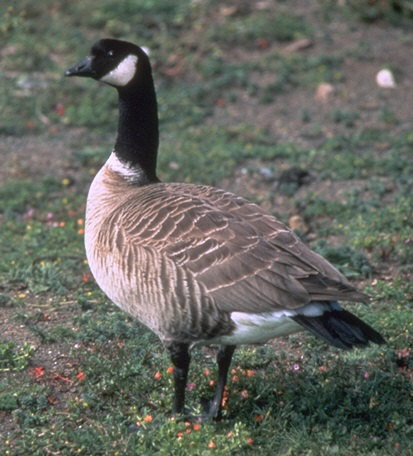
Wikipedia: Cackling goose Source: OTHER
AleutianCanadaGoose2.jpg
This bird appears across the great seas in the following continents:
Europe, North America.
General: ![]() The cackling goose (Branta hutchinsii) is a North American bird of the genus Branta of black geese, which contains species with largely black plumage, distinguishing them from the grey Anser species.
[more]
The cackling goose (Branta hutchinsii) is a North American bird of the genus Branta of black geese, which contains species with largely black plumage, distinguishing them from the grey Anser species.
[more]
Garganey (alternate) / Spatula querquedula (alternate) (Spatula querquedula)
![]() Die Knäkente (Spatula querquedula, Syn.: Anas querquedula) ist eine kleine Entenart, die unter anderem in Mitteleuropa brütet. Sie ist ein wenig größer als die in Mitteleuropa häufigere Krickente, jedoch in ihrer Gestalt insgesamt etwas schlanker und zierlicher. Auffälliges Unterscheidungsmerkmal des Erpels im Prachtkleid ist der breite bogenförmige Streifen über dem Auge, der bis in den Nacken reicht und der sich deutlich vom rötlichbraunen Kopf sowie dem dunklen Nacken abhebt. Im Flug kann die Knäkente anhand ihres hellblaugrauen Vorderflügels identifiziert werden.
[more]
Die Knäkente (Spatula querquedula, Syn.: Anas querquedula) ist eine kleine Entenart, die unter anderem in Mitteleuropa brütet. Sie ist ein wenig größer als die in Mitteleuropa häufigere Krickente, jedoch in ihrer Gestalt insgesamt etwas schlanker und zierlicher. Auffälliges Unterscheidungsmerkmal des Erpels im Prachtkleid ist der breite bogenförmige Streifen über dem Auge, der bis in den Nacken reicht und der sich deutlich vom rötlichbraunen Kopf sowie dem dunklen Nacken abhebt. Im Flug kann die Knäkente anhand ihres hellblaugrauen Vorderflügels identifiziert werden.
[more]
Vocalization: ![]() Male display sound a characteristic dry rattling, like the sound of running fingernails along the teeth of a comb. A bit similar to Ptarmigan. Also heard at other times than when courting. [Link]
Male display sound a characteristic dry rattling, like the sound of running fingernails along the teeth of a comb. A bit similar to Ptarmigan. Also heard at other times than when courting. [Link]
Calls: ![]() Female: like female Teal, but typically a bit deeper and shorter calls. [Link]
Female: like female Teal, but typically a bit deeper and shorter calls. [Link]
Physical details: length=37-41 cm,
wingspan=60-63 cm,
weight=250-450 g
Great cormorant / Kormoran (Phalacrocorax carbo)
Profile Wikipedia eBird Vogelwarte BirdLife ZH ornitho.ch Audubon AllAboutBirds Xeno-Canto BirdID NABU
Cormorant Cormorants' feathers lack the waterproofing that ducks have,
so you often see them drying their wings on a convenient perch. 2021-01-26 15.56.30 Pfäffikersee
First observed in 🇨🇭 on 2021-01-26.
This bird appears across the great seas in the following continents:
Europe, North America, Africa, Asia.
Seasonal Behavior: ![]() Lokaler Brutvogel, regelmässiger, häufiger Durchzügler und Wintergast.[Brutpaare am Zuerichsee und Greifensee bei Moenchaltorf] [Link]
Lokaler Brutvogel, regelmässiger, häufiger Durchzügler und Wintergast.[Brutpaare am Zuerichsee und Greifensee bei Moenchaltorf] [Link]
Vocalization: ![]() Mostly heard at breeding ground. Also deep, rattling and creaking sounds. [Link]
Mostly heard at breeding ground. Also deep, rattling and creaking sounds. [Link]
Calls: ![]() Coarse, vibrating calls "hahahahaharo". [Link]
Coarse, vibrating calls "hahahahaharo". [Link]
Physical details: length=80-100 cm,
wingspan=130-160 cm,
weight=1700-3000 g
Habitats:
River and lake
Song:
Automatically generated from Xeno-Canto recording
Song attributes:
Frequency:
♫ Source: BirdNet
20210519_073923 birdnet 1559 - Great Cormorant - 2021-05-19 07:39:23 - Great Cormorant - Cudrefin.mp3
2021-05-19 07.39.23 La Sauge (song)
European shag (Phalacrocorax aristotelis)
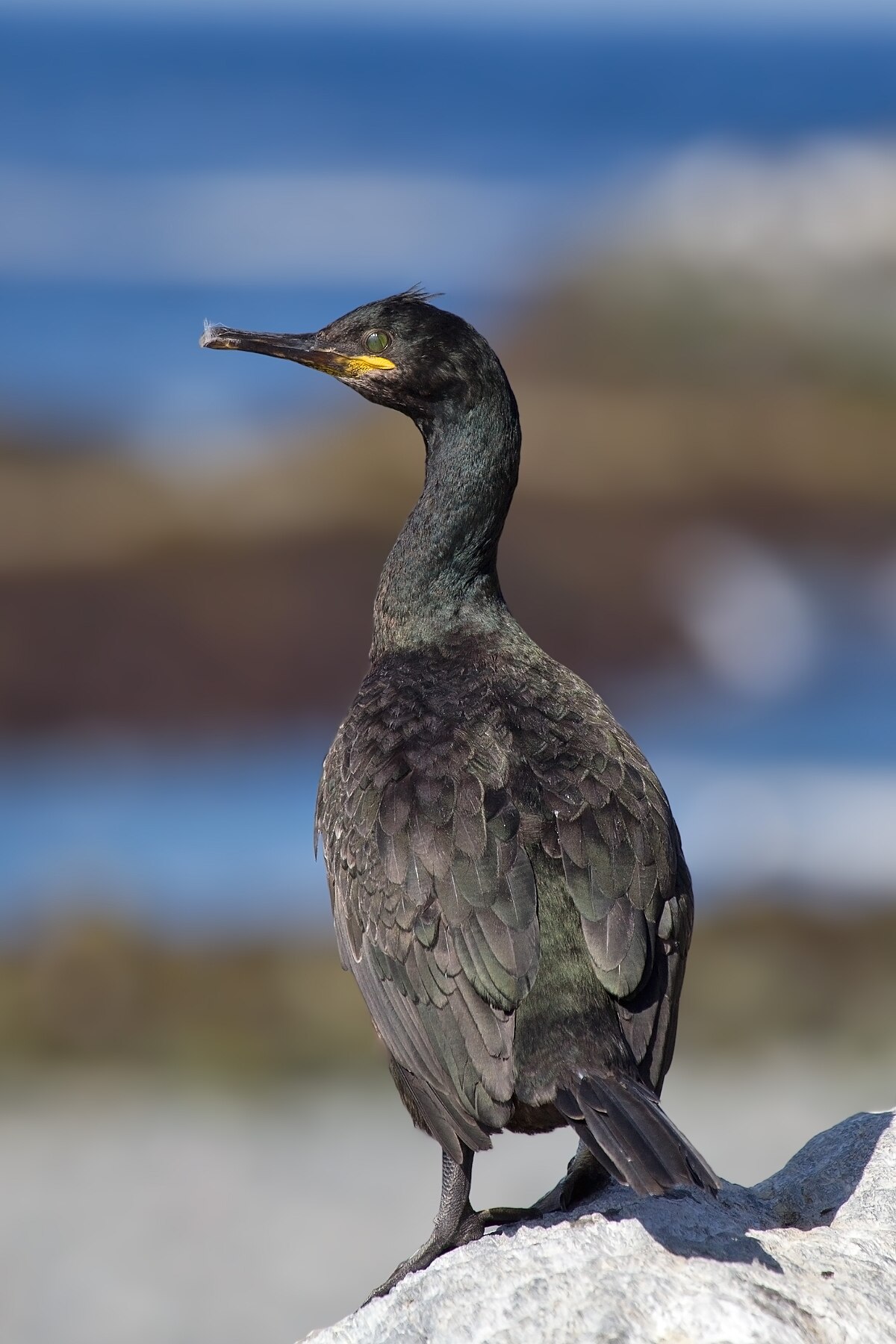
Wikipedia: European shag Source: OTHER
1200px-Shag_Phalacrocorax_aristotelis.jpg
General: ![]() The European shag or common shag (Phalacrocorax aristotelis) is a species of cormorant. It breeds around the rocky coasts of western and southern Europe, southwest Asia and north Africa, mainly wintering in its breeding range except for the northernmost birds. In Britain this seabird is usually referred to as simply the shag.[2] The scientific genus name is Latinised Ancient Greek, from φαλακρός (phalakros, "bald") and κόραξ (korax, "raven"). The species name aristotelis commemorates the Greek philosopher Aristotle.[3] Due having some notable differences from all other cormorants, some recent studies instead support placing it in the monotypic genus Gulosus.[4]
[more]
The European shag or common shag (Phalacrocorax aristotelis) is a species of cormorant. It breeds around the rocky coasts of western and southern Europe, southwest Asia and north Africa, mainly wintering in its breeding range except for the northernmost birds. In Britain this seabird is usually referred to as simply the shag.[2] The scientific genus name is Latinised Ancient Greek, from φαλακρός (phalakros, "bald") and κόραξ (korax, "raven"). The species name aristotelis commemorates the Greek philosopher Aristotle.[3] Due having some notable differences from all other cormorants, some recent studies instead support placing it in the monotypic genus Gulosus.[4]
[more]
Vocalization: ![]() Very deep and harsh voice heard at breeding ground. Deep grunts alternated, or ended with clicking sounds. [Link]
Very deep and harsh voice heard at breeding ground. Deep grunts alternated, or ended with clicking sounds. [Link]
Physical details: length=65-80 cm,
wingspan=90-105 cm,
weight=1760-2154 g
Grey heron / Graureiher (Ardea cinerea)
Graureiher mit Zöpfchen am Meteorwasserkanal Pfäffikersee 2021-02-15 09.08.30 Pfäffikersee
First observed in 🇨🇭 on 2020-05-07.
Frequent visitor.
Normally in the fields looking for food, also seen flying over or standing in the Luppmen (brook).
Vocalization: ![]() Quite vocal. At breeding ground a varied repertoire of harsh and clattering sounds. [Link]
Quite vocal. At breeding ground a varied repertoire of harsh and clattering sounds. [Link]
Calls: ![]() Most common call a short, far reaching and extremely harsh, rasping sound. [Link]
Most common call a short, far reaching and extremely harsh, rasping sound. [Link]
Physical details: length=90-98 cm,
wingspan=175-195 cm,
weight=1020-2073 g
Habitats:
Wetland
Song:
Automatically generated from Xeno-Canto recording
Song attributes:
Frequency:
♫ XC876171 - Grey Heron - Ardea cinerea - call - Manyeleti Game Reserve, South Africa. Source: XENOCANTO
XC876171 - Grey Heron - Ardea cinerea - call - Manyeleti Game Reserve, South Africa.mp3
South Africa (call)
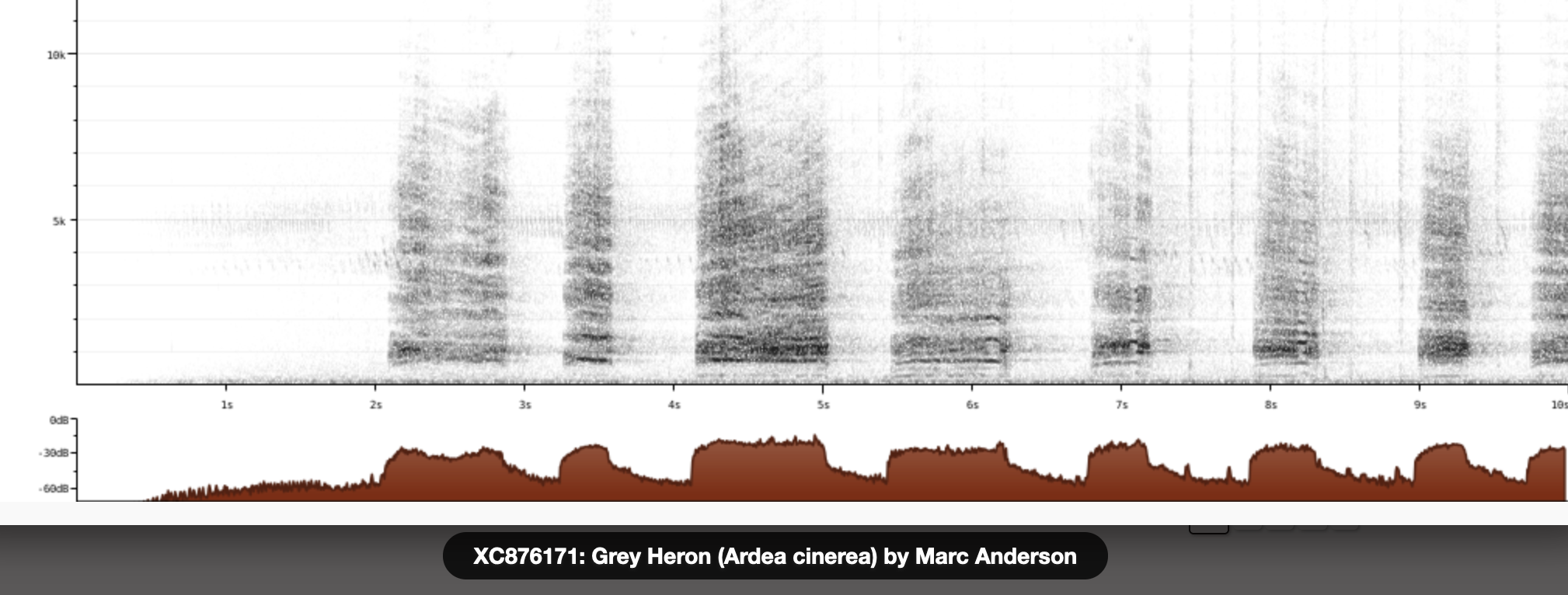
Call:
General: Mechanical-sounding sort-of-a-quack
Call: ![]() Quite vocal. Most common call a short, far reaching and extremely harsh, rasping sound. At breeding ground a varied repertoire of harsh and clattering sounds. [Link]
Quite vocal. Most common call a short, far reaching and extremely harsh, rasping sound. At breeding ground a varied repertoire of harsh and clattering sounds. [Link]
Call attributes:
Call melody: non-musical, slow, Frequency: low (1-3 KHz),
Little egret / Seidenreiher (Egretta garzetta)
Profile Wikipedia eBird Vogelwarte BirdLife ZH ornitho.ch Xeno-Canto BirdID NABU
Seidenreiher. 2022-02-05 11.42.26 Klingnauer Stausee (man-made lake)
First observed in 🇨🇭 on 2022-02-05.
General: ![]() The little egret (Egretta garzetta) is a species of small heron in the family Ardeidae. The genus name comes from the Provençal French Aigrette, "egret", a diminutive of Aigron," heron". The species epithet garzetta is from the Italian name for this bird, garzetta or sgarzetta.[2]
[more]
The little egret (Egretta garzetta) is a species of small heron in the family Ardeidae. The genus name comes from the Provençal French Aigrette, "egret", a diminutive of Aigron," heron". The species epithet garzetta is from the Italian name for this bird, garzetta or sgarzetta.[2]
[more]
Vocalization: ![]() Sometimes utters a dry, rasping "kerrr" when flushed, but is mostly silent away from breeding ground. In colonies a peculiar gurgling and vibrating sound is heard; "ghala-la-la-la". [Link]
Sometimes utters a dry, rasping "kerrr" when flushed, but is mostly silent away from breeding ground. In colonies a peculiar gurgling and vibrating sound is heard; "ghala-la-la-la". [Link]
Physical details: length=55-65 cm,
wingspan=88-95 cm,
weight=350-550 g
Habitats:
Wetland
Song:
Automatically generated from Xeno-Canto recording
Song attributes:
Frequency:
♫ XC799679 - Little Egret - Egretta garzetta - call that sounds like its vomiting - Catalunya, Spain. Source: XENOCANTO
XC799679 - Little Egret - Egretta garzetta - call that sounds like its vomiting - Catalunya, Spain.mp3
Spain (call)
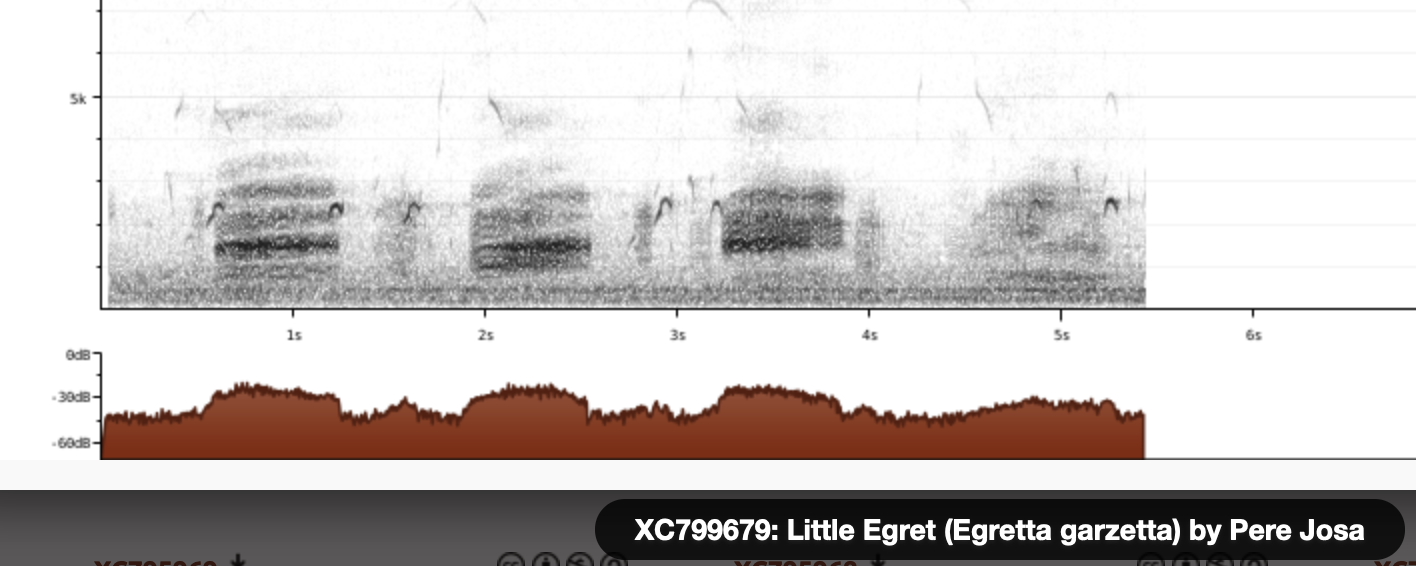
Call:
Sort of a quack, brighter and higher than grey heron, with a bit of wawa.
Call attributes:
Call melody: non-musical, slow, Frequency: low (1-3 KHz),
Northern gannet / Basstölpel (Morus bassanus)

Wikipedia: Northern gannet Source: OTHER
1200px-Morus_bassanus_adu.jpg
This bird appears across the great seas in the following continents:
Europe, North America, Africa.
Deutschland: Brut-, Jahres-, Zugvogel, Wintergast RL R
Vocalization: ![]() Heard mostly at breeding ground. Even, rhythmical series of harsh "harrr, harrr, harrr,". [Link]
Heard mostly at breeding ground. Even, rhythmical series of harsh "harrr, harrr, harrr,". [Link]
Physical details: length=87-100 cm,
wingspan=165-180 cm,
weight=2400-3600 g
Schwanzmeise am Pfäffikersee 2021-02-05 13.32.24 Pfäffikersee
First observed in 🇨🇭 on 2020-04-13.
Quite surprised to identify this bird at the Hungerseeli,
but have since realized they can be found here in the woods and in the reeds.
They're small birds that look bigger because they fluff up their feathers and have a very long tail,
which is just what I saw when I first sighted a pair June 3, 2020 at the Hungerseeli.
Appearance and identification: ![]() The subspecies europaeus occurs in Switzerland; it has a broad dark stripe over each eye,
whereas the nominate caudatus has a pure white head.
'The long-tailed tit was first classified as a true tit of the Parus group. Parus has since been split from the Aegithalidae.' [Link]
The subspecies europaeus occurs in Switzerland; it has a broad dark stripe over each eye,
whereas the nominate caudatus has a pure white head.
'The long-tailed tit was first classified as a true tit of the Parus group. Parus has since been split from the Aegithalidae.' [Link]
Song: high tsee-tsee; funny downhill trill
Habitats:
Forest
Song:
General: Meistens hoert man das Pfief...chk..chk..Pfief von den Rufen, siehe dort.
Song: Nabu: Der Gesang ist ein feines Trillern und selten zu hören (someone at XenoCanto compares it to a blue tit trill). [Link]
Song attributes:
Mnemnoic: Diddly doot-doot-doot-doot Melody: stereotype melodic, slow, Frequency: high (3-9 KHz)
♫ Source: XENOCANTO
XC572437 - Long-tailed Tit - Aegithalos caudatus - song.mp3
(song)

Call:
![]() Die fast ständig geäusserten, hohen Rufe verraten die kleinen, rastlosen Turner im Gezweig meist schon, bevor sie zu sehen sind. [Link]
Die fast ständig geäusserten, hohen Rufe verraten die kleinen, rastlosen Turner im Gezweig meist schon, bevor sie zu sehen sind. [Link]
Flight call from XenoCanto
♫ Flight call from XenoCanto Source: XENOCANTO
XC517804 Long-tailed tit flight call.mp3
(flight call)

Call attributes:
flight call Call melody: simple rhythmic, slow, Frequency: high (3-9 KHz),
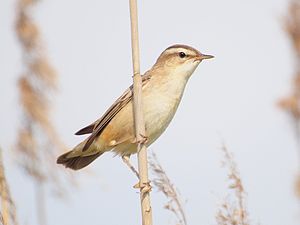
Plainish brown-white bird with black accents usually hidden in the reeds. Source: WIKIPEDIA
Wikipedia Schilfrohrsaenger.jpg
First observed in 🇨🇭 on 2020-05-20.
Bruetet hier nicht, darum eher selten, Durchzuegler.
Song: ![]() Gesang sehr ähnlich dem Teichrohrsänger. Aber nicht so im Takt. Bevorzugte Tongebilde werden mehrmals wiederholt. Des öftern Singflug über dem Schilf.
[Link]
Gesang sehr ähnlich dem Teichrohrsänger. Aber nicht so im Takt. Bevorzugte Tongebilde werden mehrmals wiederholt. Des öftern Singflug über dem Schilf.
[Link]
![]() Song vigorous and varied. [Link]
Song vigorous and varied. [Link]
Calls: ![]() Rufe:“zäck“, „zieck“, „err“.
[Link]
Rufe:“zäck“, „zieck“, „err“.
[Link]
![]() Alarm call a hard "check". Anxiety call a dry and rolling "rrrrr". A mixture of musical sounds, expert mimicry and characteristic harsh and strident calls. Not as rhythmic and evenly paced as Reed Warbler, but varies tempo a lot. [Link]
Alarm call a hard "check". Anxiety call a dry and rolling "rrrrr". A mixture of musical sounds, expert mimicry and characteristic harsh and strident calls. Not as rhythmic and evenly paced as Reed Warbler, but varies tempo a lot. [Link]
Physical details: length=13 cm,
wingspan=17-21 cm,
weight=9-15 g
Habitats:
Wetland
Song:
Constant stream of equally spaced sounds.
vogelwarte.ch has a sample that churrs and trills,
similar rhythm to reed warbler / Teichrohrsänger, so maybe that's what it was.
Listening on YouTube videos, you'd call it percussion rather than song!
Song attributes:
Melody: sings 30 seconds or longer, slow, Frequency: medium (1-5 KHz) Special sounds: mimicry
♫ Source: XENOCANTO
XC661577 - Sedge Warbler - Acrocephalus schoenobaenus - song.mp3
(song)

This fellow is singing in a bush across the street from us, at Bahnhofstrasse 18 They seldom like to show themselves, so I was pleased to see him. 2020-04-15 09.20.34 Bahnhofstrasse 18
First observed in 🇨🇭 on 2019-08-30.
On a tree branch, but not usually on the treetop.
Etymology: ![]() Grayish bird with black cap (or brown in the case of females), for which reason the German
name refers to them as monks. [Link]
Grayish bird with black cap (or brown in the case of females), for which reason the German
name refers to them as monks. [Link]
Song: ![]() Mit schwätzendem Vorgesang, (kann auch kurz sein oder ganz fehlen) der dann in klare, kräftige, zum Ende hin in wehmütige Flötentöne übergeht (Überschlag)
[Link]
Mit schwätzendem Vorgesang, (kann auch kurz sein oder ganz fehlen) der dann in klare, kräftige, zum Ende hin in wehmütige Flötentöne übergeht (Überschlag)
[Link]
![]() Song pleasing, varied and loud. Sometimes very similar to Garden Warbler. A typical phrase starts with soft, staccato chattering and mimicry, which after a few seconds changes to a much louder, pure and resonant stream of notes for about 3-5 seconds. No fixed motif, but may end phrases with recurring notes. Often deviates from the characteristic type of song, and identification from song alone may be impossible. May sing first part of song for extended periods without ever reaching the characteristic ending. [Link]
Song pleasing, varied and loud. Sometimes very similar to Garden Warbler. A typical phrase starts with soft, staccato chattering and mimicry, which after a few seconds changes to a much louder, pure and resonant stream of notes for about 3-5 seconds. No fixed motif, but may end phrases with recurring notes. Often deviates from the characteristic type of song, and identification from song alone may be impossible. May sing first part of song for extended periods without ever reaching the characteristic ending. [Link]
Calls: ![]() „täck“ oft wiederholt
[Link]
„täck“ oft wiederholt
[Link]
![]() Alarm call a hard "check", similar to Lesser White-throat. Sometimes with an additional hoarse and nasal "cherrrr". [Link]
Alarm call a hard "check", similar to Lesser White-throat. Sometimes with an additional hoarse and nasal "cherrrr". [Link]
Physical details: length=13 cm,
wingspan=20-23 cm,
weight=16-25 g
Habitats:
Forest
Song:
They sometimes sing like a blackbird on speed - also non-stereotypic, seemingly improvised,
in short bursts.
Our local guy ends most of his songs with the same seven notes, which I find a good way to confirm the identification. In Ticino we often heard the 'Leiern' sound - the warblers would sing just the first 3 notes of a longer song, then stop. The order varied; high-medium-low I call 'Figaro' as in the opera, low-high-medium 'whiskey bar', as it sounded to me like the Kurt Weill lyrics, 'O-oh-show me-the-way to-the-next whis-ke-bar' - but the warbler usually stopped after 'way' or 'next' The British authors of The Sound Approach claim to hear 'a warblel and a whistle'.
Song attributes:
Melody: improvised melodic (hml), fast, Frequency: 2-5 KHz Special sounds: mimicry Singing season: 03-01 - 07-31 Dawn chorus start, 45 minutes before dawn.
♫ Source: BirdNet
20210331_191200 birdnet 1356 - Eurasian Blackcap hml - 2021-03-31 19:12:00 - Eurasian Blackcap - Lugano.mp3
2021-03-31 19.12.00 Lugano (song)
♫ Tenero, lokaler Moenchsgrasmuecke Gesang endet meistens mit hlhl oder hlhlh. ![]() Source: Zoom H6 2023-06-20 07.52.22 Bolle di Magadino (song)
Source: Zoom H6 2023-06-20 07.52.22 Bolle di Magadino (song)
Call:
General: Sputtery/stoney, but may have other calls too.
Call: ![]() The Blackcap may generate a perplexing variety of territorial calls, though the typical contact call is a hard, tongue-clicking "teck teck" which has a scolding quality to it. It's not dissimilar to the 'pebble-clacking' call of the Stonechat. [Suffex Wildlife Trust]
The Blackcap may generate a perplexing variety of territorial calls, though the typical contact call is a hard, tongue-clicking "teck teck" which has a scolding quality to it. It's not dissimilar to the 'pebble-clacking' call of the Stonechat. [Suffex Wildlife Trust]
Call attributes:
Call melody: one note, slow, Frequency: high (3-9 KHz), Special sounds: sputter/pebble-clatter.
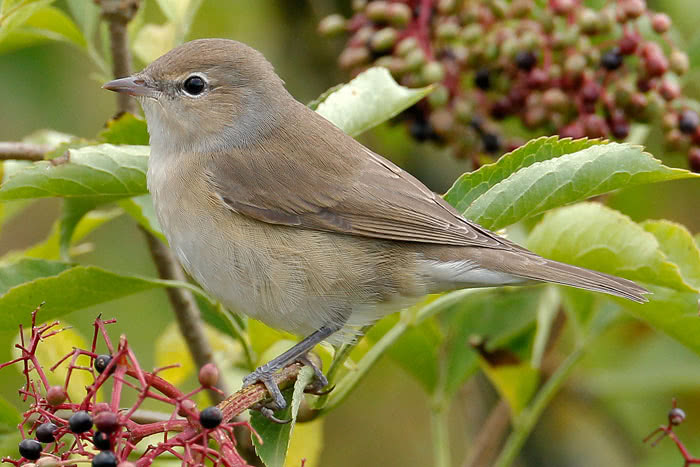
Vogelwarte Gartengrasmuecke. Source: VOGELWARTE
Vogelwarte Gartengrasmuecke.jpg
First observed in 🇨🇭 on 2020-04-27.
Nondescript, shy.
Hidden in the branches. Does change trees though.
Appearance and identification: Nabu: Das Hauptbestimmungsmerkmal dieser sehr unauffällig gefärbten Grasmücke ist,
dass sie kein besonderes Merkmal besitzt.
Im gegensatz zu ihrem Namen kommt die Gartengrasmücke
eher seltener in Gärten vor, häufiger ist sie in Hecken und grossen Büschen in waldrandlage anzutreffen, wo sie recht versteckt lebt. [Aus der NABU Android-App]
Song: ![]() Sprudelnd, orgelnd, die längsten Strophen aller hiesigen Grasmücken. Mit vielen reinen, volltönenden Tönen. Ohne Überschlag der Mönchsgrasmücke.
[Link]
Sprudelnd, orgelnd, die längsten Strophen aller hiesigen Grasmücken. Mit vielen reinen, volltönenden Tönen. Ohne Überschlag der Mönchsgrasmücke.
[Link]
![]() Song: a full bodied, flowing, melodious stream of notes, distinguished by its almost constant, warbled quality and lack of clear whistling notes (see Blackcap). Tempo is fairly even. Beware confusion possibility with occasional subsong of Blackcap that never reaches the whistling part! Call a nasal "che". [Link]
Song: a full bodied, flowing, melodious stream of notes, distinguished by its almost constant, warbled quality and lack of clear whistling notes (see Blackcap). Tempo is fairly even. Beware confusion possibility with occasional subsong of Blackcap that never reaches the whistling part! Call a nasal "che". [Link]
Calls: ![]() Alarm call a hard "check", and a hoarse "tcherr". [Link]
Alarm call a hard "check", and a hoarse "tcherr". [Link]
Physical details: length=14 cm,
wingspan=20-24 cm,
weight=16-22 g
Habitats:
Forest
Song:
Hard to distinguish from mönchsgrasmücke/black cap.
Song attributes:
Melody: improvised melodic (hm), fast, Frequency: medium (1-5 KHz)
♫ Source: XENOCANTO
XC728379 - Garden Warbler - Sylvia borin - song.png
(song)
Presence: 04-15 - 10-05
Breeding: 04-30 - 08-10
Migration in: 04-15 - 05-30
Migration out: 08-01 - 10-05
Song:
Automatically generated from Xeno-Canto recording
Song attributes:
Frequency:
♫ XC344648 - Common Whitethroat - Sylvia communis communis - song, recorded in Germany. Source: XENOCANTO
XC344648 - Common Whitethroat - Sylvia communis communis - song, recorded in Germany.mp3
Germany (song)
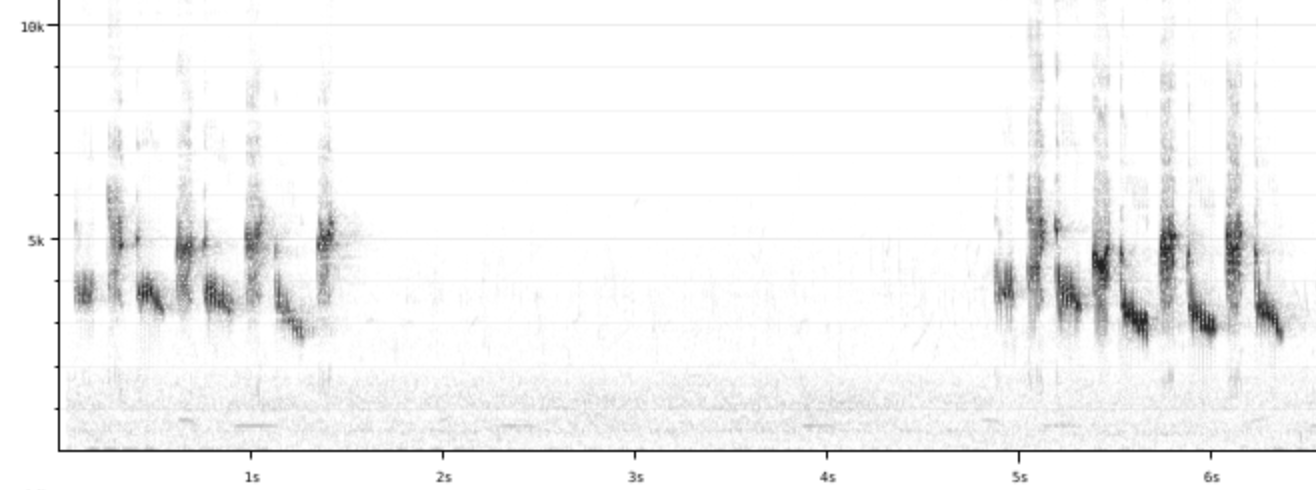
Profile Wikipedia eBird Vogelwarte BirdLife ZH ornitho.ch bird-song.ch Xeno-Canto BirdID NABU
Wintergoldhähnchen beim Meteorwasserkanal am Pfäffikersee. Endlich habe ich einen bei uns gesehen! 2020-10-30 16.44.10 Pfäffikersee
First observed in 🇨🇭 on 2020-07-13.
I'd often heard the high-pitched song and call in the woods by Fehraltorf
but had doubts I'd ever see one (they're the smallest bird in Switzerland,
fairly shy, and I seemed to only hear them in very tall trees).
I didn't see one until hiking at the Pragelpass.
And finally in October 2020, I saw them near Rumlikon and at the
Pfaeffikersee, where I took the new profile picture.
In December I saw give of them cruise through the bushes beside our house,
hopping from branch to branch, snapping up insects - something I'd never have
believe in spring 2020.
Song: ![]() Kurze Reihe von sehr hohen, leisen Tönen in auf-absteigender Tonhöhe, an das „W“-im Namen erinnernd. [Link]
Kurze Reihe von sehr hohen, leisen Tönen in auf-absteigender Tonhöhe, an das „W“-im Namen erinnernd. [Link]
![]() Song: a very high-pitched, undulating series of arpeggiated notes moving down and up again, repeated 4-5 times ending with a marked "conclusion" (like "trying to start a tiny motor and failing"). Timbre of song similar to contact call. [Link]
Song: a very high-pitched, undulating series of arpeggiated notes moving down and up again, repeated 4-5 times ending with a marked "conclusion" (like "trying to start a tiny motor and failing"). Timbre of song similar to contact call. [Link]
Calls: ![]() 'sisisi' [Link]
'sisisi' [Link]
![]() Contact call a very high pitched "zit zit zit", only similar to Firecrest and treecreepers. Treecreepers usually calls with longer "zzzziiiiit" repeated at regular intervals, while Goldcrest calls in phrases with two to four calls in series in an uneven rhythm. Firecrest contact calls lower pitched than Goldcrest, and in a softer tone (but quite similar). [Link]
Contact call a very high pitched "zit zit zit", only similar to Firecrest and treecreepers. Treecreepers usually calls with longer "zzzziiiiit" repeated at regular intervals, while Goldcrest calls in phrases with two to four calls in series in an uneven rhythm. Firecrest contact calls lower pitched than Goldcrest, and in a softer tone (but quite similar). [Link]
Physical details: length=9 cm,
wingspan=13-15 cm,
weight=4-7 g
Habitats:
Forest
Song:
![]() Vogelwarte.ch says high-pitched song that gently rises and falls. This song starts out with a repeated note. [Link]
Vogelwarte.ch says high-pitched song that gently rises and falls. This song starts out with a repeated note. [Link]
Song attributes:
Melody: stereotype melodic, slow, Frequency: 6-8 KHz
Profile Wikipedia eBird A-Z Animals Vogelwarte BirdLife ZH ornitho.ch bird-song.ch Audubon AllAboutBirds Xeno-Canto BirdID NABU
Barn swallow. 2022-05-05 09.41.44 Maryland
First observed in 🇨🇭 on 2020-04-16.
This bird appears across the great seas in the following continents:
Europe, North America, South America, Africa, Asia.
Die langen Schwanzfedern vom Rauchschwalbe und anderen geben auch dem Schmetterling Schwalbenschwanz seine deutschen Namen.
Etymology: ![]() In früheren Jahrhunderten flogen sie vielfach durch die Öffnungen im Giebel ein und aus, durch die auch der Rauch des Herdfeuers abzog. So erhielten sie den Namen Rauchschwalben. [Link]
In früheren Jahrhunderten flogen sie vielfach durch die Öffnungen im Giebel ein und aus, durch die auch der Rauch des Herdfeuers abzog. So erhielten sie den Namen Rauchschwalben. [Link]
Appearance and identification: ![]() Rauchschwalbes Bauch ist etwas braun rot, nicht weiss wie der von der Mehlschwalbe - was wahrscheinlich Quelle der zwei Namen ist. [Link]
Rauchschwalbes Bauch ist etwas braun rot, nicht weiss wie der von der Mehlschwalbe - was wahrscheinlich Quelle der zwei Namen ist. [Link]
Song: ![]() Characteristic calls and song. Song a sparkling, squeaky energetic improvisation with interspersed contact calls, often with diagnostic ending; an electric and drawn-out "su-eerrrrrrrrrrrrrrr". [Link]
Characteristic calls and song. Song a sparkling, squeaky energetic improvisation with interspersed contact calls, often with diagnostic ending; an electric and drawn-out "su-eerrrrrrrrrrrrrrr". [Link]
Calls: ![]() Contact call a short and sharp "weet" or "kee-weet". [Link]
Contact call a short and sharp "weet" or "kee-weet". [Link]
Physical details: length=17-19 cm,
wingspan=32-34 cm,
weight=16-22 g
Habitats:
Settlement
Looks similar to:
Common house martin.
Song:
General: Squeaky with occasional buzzes, usually heard in flock.
Song: ![]() Kann melodisch sein wenn einzeln gehört statt viele zusammen. [Link]
Kann melodisch sein wenn einzeln gehört statt viele zusammen. [Link]
Song attributes:
Melody: stereotype melodic, fast, Frequency: 2-6 KHz
Bank swallow. 2024-01-26 15.58.58 Thailand
First observed in Thailand on 2024-01-26.
This bird appears across the great seas in the following continents:
Europe, North America, South America, Africa, Asia.
General: ![]() The sand martin (Riparia riparia) or European sand martin, bank swallow, and collared sand martin in India, is a migratory passerine bird in the swallow family. It has a wide range in summer, embracing practically the whole of Europe and the Mediterranean countries and across the Palearctic to the Pacific Ocean. It is a Holarctic species also found in North America. It winters in eastern and southern Africa, South America, and the Indian Subcontinent.
[more]
The sand martin (Riparia riparia) or European sand martin, bank swallow, and collared sand martin in India, is a migratory passerine bird in the swallow family. It has a wide range in summer, embracing practically the whole of Europe and the Mediterranean countries and across the Palearctic to the Pacific Ocean. It is a Holarctic species also found in North America. It winters in eastern and southern Africa, South America, and the Indian Subcontinent.
[more]
Song: ![]() Song a primitive improvisation on the contact call. [Link]
Song a primitive improvisation on the contact call. [Link]
Calls: ![]() Contact call a mono- or disyllabic "trrrrt". Similar to House Martin but more raucous and less crisp, with less rolling r's, and with stable pitch throughout. Alarm call similar to House Martin; a sharp plaintive "tseep", but somewhat purer and more drawn. [Link]
Contact call a mono- or disyllabic "trrrrt". Similar to House Martin but more raucous and less crisp, with less rolling r's, and with stable pitch throughout. Alarm call similar to House Martin; a sharp plaintive "tseep", but somewhat purer and more drawn. [Link]
Physical details: length=12 cm,
wingspan=26-29 cm,
weight=11-16 g
Habitats:
Wetland
Song:
Fast raspy one-noter.
Song attributes:
Melody: non-musical, fast, Frequency: 1-7 KHz Special sounds: rasp
♫ Source: XENOCANTO
XC344092 - Sand Martin - Riparia riparia - raspy song but note, does not sing often.mp3
(song)

Mehlschwalben in Maienfeld. 2021-05-29 08.11.14 Maienfeld
First observed in 🇨🇭 on 2020-08-10.
This one is a swallow in German but a martin in English.
Song: ![]() Song a merry improvisation of chirping, contact call-like sounds (sometimes recalling a budgerigar). [Link]
Song a merry improvisation of chirping, contact call-like sounds (sometimes recalling a budgerigar). [Link]
Calls: ![]() Contact call a rolling "krreet". Similar to Sand Martin but noticeably dryer, more rolling and less raucous. Typically varies the pitch of the call more. Warning call a sharp and plaintive "tsreee". [Link]
Contact call a rolling "krreet". Similar to Sand Martin but noticeably dryer, more rolling and less raucous. Typically varies the pitch of the call more. Warning call a sharp and plaintive "tsreee". [Link]
Physical details: length=12 cm,
wingspan=26-29 cm,
weight=15-23 g
Habitats:
Settlement
Looks similar to:
Barn swallow.
Song:
Song: ![]() Mehlschwalbe klingt weniger melodisch als der Rauchschwalbe [Link]
Mehlschwalbe klingt weniger melodisch als der Rauchschwalbe [Link]
![]() Merry improv of chirping, contact call [Link]
Merry improv of chirping, contact call [Link]
Song attributes:
Melody: stereotype melodic, fast, Frequency: 2-7 KHz
♫ Source: XENOCANTO
XC730813 - Common House Martin - Delichon urbicum - song and call according to recordist Fernando Aranguren Jiménez, recorded in Spain.mp3
Spain (song)

Call:
Automatically generated from Xeno-Canto recording
♫ Source: BirdNet
20200810_144528 birdnet 864 flight call - Common house martin.mp3
2020-08-10 14.45.28 Luppmen (flight call)
Call attributes:
flight call Frequency: ,
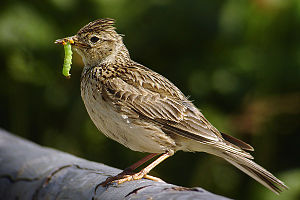
Wikipedia Eurasian Skylark (Alauda arvensis). Source: WIKIPEDIA
Wikipedia Eurasian Skylark (Alauda_arvensis).jpg
First observed in 🇨🇭 on 2022-06-25.
This bird appears across the great seas in the following continents:
Europe, North America (introduced), Africa.
Good to know: ![]() Aus dem Kurzjahresbericht BirdLife Schweiz 2022: Die Feldlerche, vogel der Jahres 2022..., ist eihne dieser bredrohten Arten, welche durch die Industrialisierung der Landwirtschaft ausgerottet wird. [Link]
Aus dem Kurzjahresbericht BirdLife Schweiz 2022: Die Feldlerche, vogel der Jahres 2022..., ist eihne dieser bredrohten Arten, welche durch die Industrialisierung der Landwirtschaft ausgerottet wird. [Link]
Appearance and identification: ![]() Somewhat like a house sparrow but 18-19 cm long, not 14-15, kleiner als Star. Ruffled head feathers. NABU says streaks on breast contrast with white belly. [Link]
Somewhat like a house sparrow but 18-19 cm long, not 14-15, kleiner als Star. Ruffled head feathers. NABU says streaks on breast contrast with white belly. [Link]
Geography: ![]() Introduced population in North America is gradually declining. [Link]
Introduced population in North America is gradually declining. [Link]
Stark gefährdet durch Verlust von geeignetem Lebensraum. Eine Massnahme ist die Erstellung von Lerchenfenstern auf den Feldern - eine kleine Fläche mitten im Feld, die nicht bepflanzt oder gemäht wird. So was sieht man bei uns, z.B. zwischen Freudwil und Gutenswil, wobei ich nicht genau weiss, ob Feldlerchen das Ziel davon sind. Die Infos habe ich vom FOK Kurs 2021-2022 von Christina Ebneter.
Song: ![]() Song a pleasing energetic stream of chirping, merry trills, interspersed with mimicry. Trills quite resonant with fairly full tone. Song usually given in flight high in the air. Less characteristic, shorter, weaker and more varied song when given from ground. [Link]
Song a pleasing energetic stream of chirping, merry trills, interspersed with mimicry. Trills quite resonant with fairly full tone. Song usually given in flight high in the air. Less characteristic, shorter, weaker and more varied song when given from ground. [Link]
Calls: ![]() Most typical flight call a short trilling "chirrup", with the end note noticeably lower pitched than the start. Also several other more cryptic calls. [Link]
Most typical flight call a short trilling "chirrup", with the end note noticeably lower pitched than the start. Also several other more cryptic calls. [Link]
Physical details: length=18-19 cm,
wingspan=30-36 cm,
weight=26-50 g
Habitats:
Agricultural
Song:
Fast chirpy improvization without a break, not very high, reminds me of a nightingale or a Eurasian reed warbler/Teichrohrsänger with the exact rhythm, but most likely sung in a cornfield. Or a Singdrossel that repeats its elements longer that that guy. Repeats elements 1-8 times. Sometimes buzzy/trilly. Can go on for minutes at a time. Ich habe es auch mit einem Amsel verwechselt, da er lang und melodisch, fast wie Amsel aber hört nicht auf.
Song attributes:
Melody: sings 30 seconds or longer, slow, Frequency: 2-6 KHz Special sounds: mimicry
♫ Source: XENOCANTO
XC685846 - Eurasian Skylark - Alauda arvensis - song, recorded in France.mp3
(song)

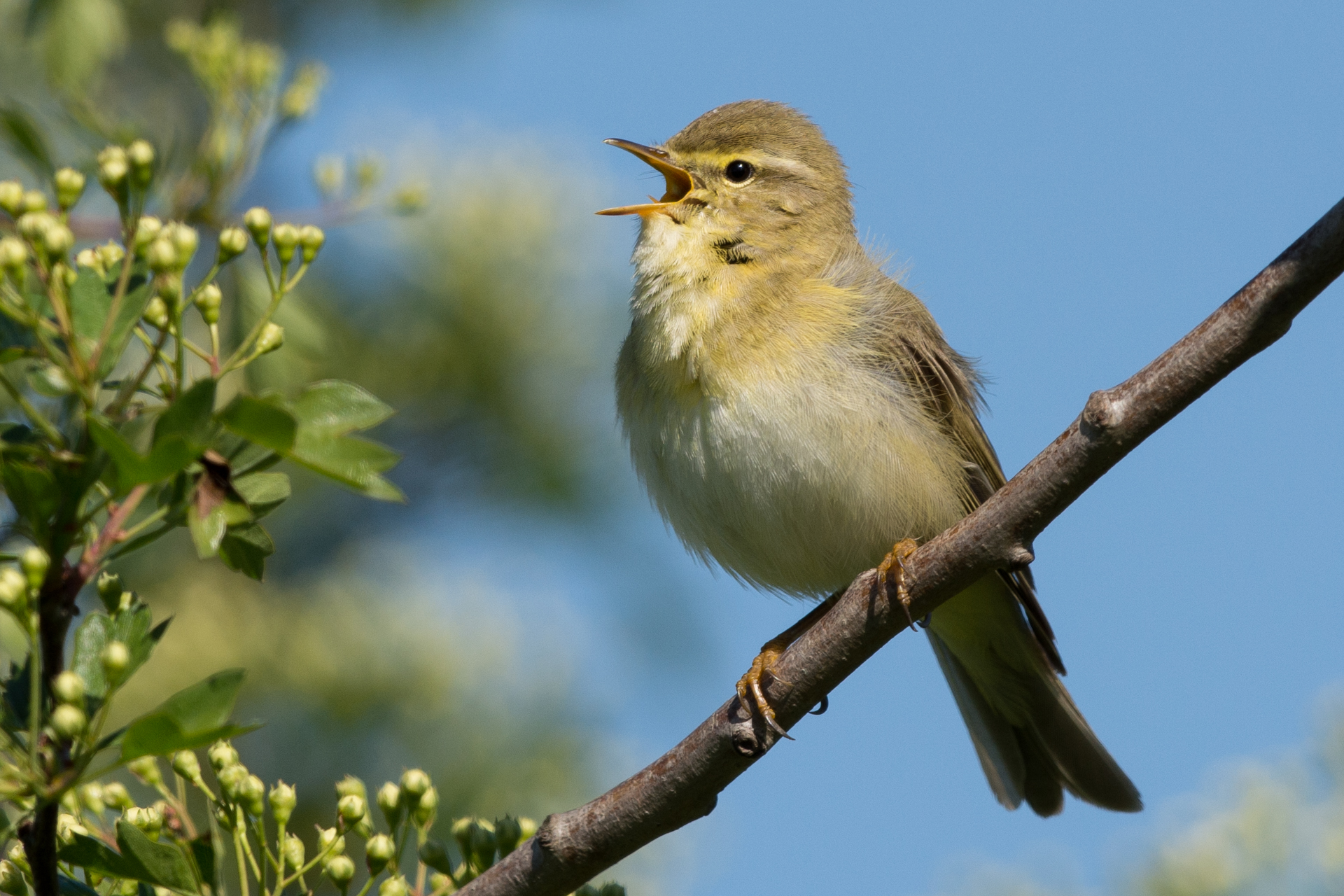
WikiCommons Fitis 13901013023. Source: WIKIPEDIA
WikiCommons Fitis 13901013023.jpg
First observed in 🇨🇭 on 2020-04-24.
General: ![]() The willow warbler (Phylloscopus trochilus) is a very common and widespread leaf warbler which breeds throughout northern and temperate Europe and the Palearctic, from Ireland east to the Anadyr River basin in eastern Siberia. It is strongly migratory, with almost all of the population wintering in Sub-Saharan Africa.[2][3]
[more]
The willow warbler (Phylloscopus trochilus) is a very common and widespread leaf warbler which breeds throughout northern and temperate Europe and the Palearctic, from Ireland east to the Anadyr River basin in eastern Siberia. It is strongly migratory, with almost all of the population wintering in Sub-Saharan Africa.[2][3]
[more]
Song: ![]() Reihe v. Pfeiflauten (ca 12) etwas abfallend. Klingt ähnlich Buchfink, aber etwas traurig, melancholisch, wie in moll-Tonart. [Link]
Reihe v. Pfeiflauten (ca 12) etwas abfallend. Klingt ähnlich Buchfink, aber etwas traurig, melancholisch, wie in moll-Tonart. [Link]
![]() By far most easily identified by it's call or song. Song: A 3-5 second, falling phrase of soft, rippling "svi-svi" sounds, starting high with some attack, and then falling in a mellow manner. The phrase lacks any conclusion, and diminishes both in strength and tempo. [Link]
By far most easily identified by it's call or song. Song: A 3-5 second, falling phrase of soft, rippling "svi-svi" sounds, starting high with some attack, and then falling in a mellow manner. The phrase lacks any conclusion, and diminishes both in strength and tempo. [Link]
Calls: ![]() ähnlich oben, aber mehr zweisilbig [Link]
ähnlich oben, aber mehr zweisilbig [Link]
![]() Contact/alarm call a soft, plaintive ascending "hoo-eet". Similar to Chiff-chaff, but first part more drawn, giving it a disyllabic feel. [Link]
Contact/alarm call a soft, plaintive ascending "hoo-eet". Similar to Chiff-chaff, but first part more drawn, giving it a disyllabic feel. [Link]
Physical details: length=10-11 cm,
wingspan=16-22 cm,
weight=7-12 g
Habitats:
Forest
Song:
Song similar to common chaffinch but higher, faster, tendency to descend but with more ups and downs.
Song attributes:
Mnemnoic: Buchfink diva Melody: stereotype melodic, fast, Frequency: high (3-9 KHz) Singing season: 04-01 - 06-30 Dawn chorus start, 22 minutes before dawn.
Call:
Whoop very similar to chiffchaff, etc. but starts at an even level, then ascends.
Call recorded in UK, sounds typical to me, and spiced up by a yellowhammer in the background and several other birds
♫ Call recorded in UK, sounds typical to me, and spiced up by a yellowhammer in the background and several other birds Source: XENOCANTO
XC444002 - Willow Warbler - Phylloscopus trochilus trochilus - call in UK, with yellowhammer in background.mp3
(call)

Call attributes:
contact call Call melody: simple rhythmic, slow, Frequency: 2-4 KHz, Special sounds: whoop.
In our back yard in Fehraltorf 2020-10-03 12.44.50 Luppmen
First observed in 🇨🇭 on 2019-06-04.
In the survey of 2008, there was only 1 Chiffchaff in Fehraltorf for every 7 blackbirds, and it was ranked 19th in the village.
Yet in summer 2020 I heard them in nearly every recording I make, whether at home by the brook (Luppmen) or in the woods.
I presume their population has exploded in the last 10 years.
I see them in middle branches, but not in particularly exposed places.
Song: ![]() [Translated from German:] From the middle of August till the end of September the chiffchaff offers regular autumn song. [Link]
[Translated from German:] From the middle of August till the end of September the chiffchaff offers regular autumn song. [Link]
![]() Lange Reihen (6-20) von „zilp-zalp“-Rufen, meist abwechselnd in Tonhöhe. (Als bemühe sich der Sänger vergeblich den ersten Ton wieder zu treffen , ohne jedoch weit zu verfehlen.) „Zins zahl, Zins zahl, zahl Zins, Zins Zins zahl“ („Zins“ etwas höher als „zahl“) [Link]
Lange Reihen (6-20) von „zilp-zalp“-Rufen, meist abwechselnd in Tonhöhe. (Als bemühe sich der Sänger vergeblich den ersten Ton wieder zu treffen , ohne jedoch weit zu verfehlen.) „Zins zahl, Zins zahl, zahl Zins, Zins Zins zahl“ („Zins“ etwas höher als „zahl“) [Link]
![]() Song a very distinct: "chiff-chaff-chiff-chiff-chaff-chiff", in a regular clock-like rhythm. Each syllable at seemingly random pitch, but no large intervals tonally. Sometimes "get stuck" at one note. [Link]
Song a very distinct: "chiff-chaff-chiff-chiff-chaff-chiff", in a regular clock-like rhythm. Each syllable at seemingly random pitch, but no large intervals tonally. Sometimes "get stuck" at one note. [Link]
Calls: ![]() Rufe :einsilbiges „hüid“, hinaufgezogen, wandelbar. [Link]
Rufe :einsilbiges „hüid“, hinaufgezogen, wandelbar. [Link]
![]() Contact/alarm call a soft, plaintive ascending "hooeet". Similar to W.Warbler, but shorter with a monosyllabic feel. [Link]
Contact/alarm call a soft, plaintive ascending "hooeet". Similar to W.Warbler, but shorter with a monosyllabic feel. [Link]
Physical details: length=10-11 cm,
wingspan=15-21 cm,
weight=6-10 g
Habitats:
Forest
Song:
Seems to consist of 3 notes repeated randomly, occasionally just 2 notes.
Though NABU.de says they stop singing at the end of July, I do hear their 3-note song occasionally in October,
but just one or two repetitions.
Song attributes:
Melody: simple rhythmic, slow, Frequency: high (3-9 KHz) Singing season: 03-01 - 07-31 Dawn chorus start, 35 minutes before dawn.
Call:
Repeated rising note, not too loud
♫ Source: XENOCANTO
XC656913 - Common Chiffchaff - Phylloscopus collybita - call recorded in Belgium.mp3
(contact call)

Call attributes:
Call melody: one note, slow, Frequency: 2-4 KHz, Special sounds: whoop.
Song:
Automatically generated from Xeno-Canto recording
Song attributes:
Frequency:
♫ XC727564 - Wood Warbler - Phylloscopus sibilatrix - song. Source: XENOCANTO
XC727564 - Wood Warbler - Phylloscopus sibilatrix - song.mp3
(song)
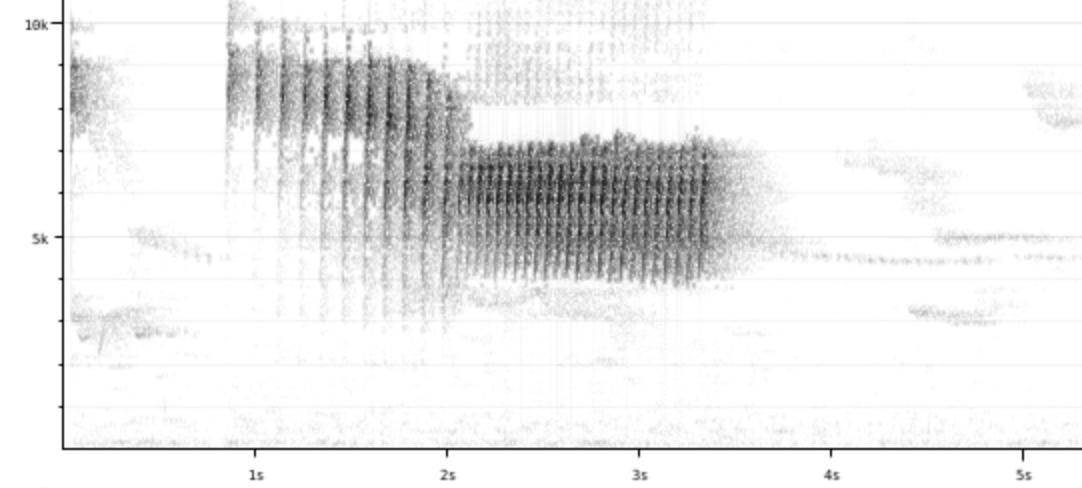

Wikipedia: Common grasshopper warbler Source: OTHER
Grashoppsangare-070512.jpg
General: ![]() The common grasshopper warbler (Locustella naevia) is a species of Old World warbler in the grass warbler genus Locustella. It breeds across much of temperate Europe and the western Palearctic. It is migratory, wintering in north and west Africa.
[more]
The common grasshopper warbler (Locustella naevia) is a species of Old World warbler in the grass warbler genus Locustella. It breeds across much of temperate Europe and the western Palearctic. It is migratory, wintering in north and west Africa.
[more]
Song: ![]() Sehr lang anhaltendes Schwirren. Die einzelnen Schlage noch zu erkennen. Der Klang erinnert etwas an Heuschreckenzirpen (alter Name Heuschreckenrohrsänger, langer Name, lange Strophe) und klingt etwas blechern., d.h. Mit Oberton. (fast wie ein Wecker bei dem man den Finger etwas auf die Glocke hält)
[Link]
Sehr lang anhaltendes Schwirren. Die einzelnen Schlage noch zu erkennen. Der Klang erinnert etwas an Heuschreckenzirpen (alter Name Heuschreckenrohrsänger, langer Name, lange Strophe) und klingt etwas blechern., d.h. Mit Oberton. (fast wie ein Wecker bei dem man den Finger etwas auf die Glocke hält)
[Link]
![]() Song insect-like and high-pitched. A monotonous stream of even clicks similar to a running fishing line. Maintained for seemingly endless periods, and often hard to locate. Song most similar to Savi's Warbler but is slower (each click more separated), and higher pitched with a metallic, ringing quality. Short sequences of song also functions as contact call. Also a Robin-like "tick". [Link]
Song insect-like and high-pitched. A monotonous stream of even clicks similar to a running fishing line. Maintained for seemingly endless periods, and often hard to locate. Song most similar to Savi's Warbler but is slower (each click more separated), and higher pitched with a metallic, ringing quality. Short sequences of song also functions as contact call. Also a Robin-like "tick". [Link]
Calls: ![]() Rufe:“pswitt“ (spitz)
[Link]
Rufe:“pswitt“ (spitz)
[Link]
Physical details: length=12-13 cm,
wingspan=15-19 cm,
weight=11-16 g
Habitats:
Wetland
Song or calls similar to:
Savi's warbler.
Song:
Buzzing like an insect or machinery. BirdLife Schweiz says like a grasshopper (which is after all the English name).
Song attributes:
Melody: simple rhythmic, fast, Frequency: 5-8 KHz
Profile Wikipedia eBird Vogelwarte BirdLife ZH ornitho.ch bird-song.ch Audubon AllAboutBirds Xeno-Canto BirdID NABU
Pair of house sparrows in a tree near Zürichstrasse, Fehraltorf 2020-04-11 07.54.30 Luppmen
First observed in 🇨🇭 on 2019-05-14.
This bird appears across the great seas in the following continents:
Europe, North America (introduced), South America, Africa, Asia.
One of the most common birds anywhere in Europe and North America.
In Fehraltorf there are 5 house sparrows for every one tree sparrow.
Eugene Schieffelin brought house sparrows and starlings to North Ameria.
As a Shakespeare fan, it is often claimed that he wanted to introduce all species to North America that are mentioned in Shakespeare,
but apparently this is not supported by any records
Found practically everywhere. Often on the ground or on your table in a cafe (they're very bold)
or in groups in bushes and hedges
Song: ![]() Song a primitive, monosyllabic, or slightly disyllabic "chilp", hard to distinguish from Tree Sparrow. [Link]
Song a primitive, monosyllabic, or slightly disyllabic "chilp", hard to distinguish from Tree Sparrow. [Link]
Calls: ![]() Most calls very similar to Tree Sparrow, but lacks said species' distinct high pitched call (chew-itt), and alarm call is less dry and raucous. [Link]
Most calls very similar to Tree Sparrow, but lacks said species' distinct high pitched call (chew-itt), and alarm call is less dry and raucous. [Link]
Physical details: length=14-15 cm,
wingspan=21-25 cm,
weight=24-38 g
not sexually dimporphic.
No breeding plumage
Identifying characteristics:
Youth:
beak = yellow (Makes it look like a finch)
Habitats:
Settlement
Song:
An monotone chirping. Mainly 2-5 KHz with higher overtones.
Song attributes:
Melody: simple rhythmic, slow, Frequency: 2-5 KHz Singing season: 01-01 - 08-31 Dawn chorus start, 30 minutes before dawn.
Call:
Automatically generated from Xeno-Canto recording
♫ Source: BirdNet
20200725_091827 birdnet 825 chittering could be alarm call, - House sparrow.mp3
2020-07-25 09.18.27 Luppmen (alarm call)
Call attributes:
alarm call Frequency: ,
Profile Wikipedia eBird Vogelwarte BirdLife ZH ornitho.ch bird-song.ch Xeno-Canto BirdID NABU
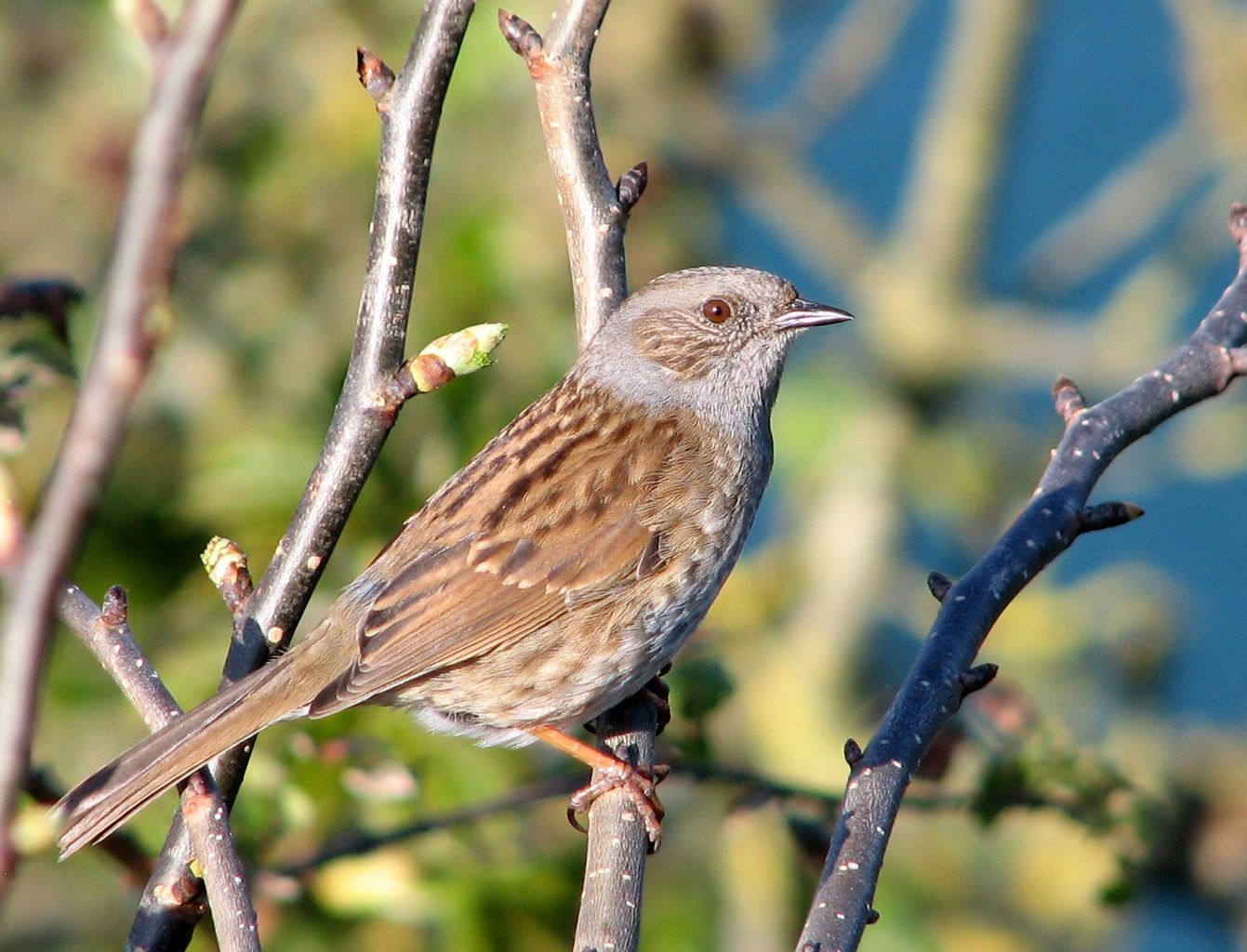
Wikpedia photo because mine is poor. Source: WIKIPEDIA
Dunnock oder Heckenbraunelle aus Wikipedia weil nur gehört.jpg
First observed in 🇨🇭 on 2020-04-16.
Heard at Hungerseeli and near Lendikon according to BirdNET. Finally seen near Amden 2023.
Song: ![]() Singt schon im Vorfrühling. Klangfarbe ähnlich Gartenbaumläufer. Aufbau ähnlich Zaunkönig, aber ohne Triller. Viel leiser und dünner.
[Link]
Singt schon im Vorfrühling. Klangfarbe ähnlich Gartenbaumläufer. Aufbau ähnlich Zaunkönig, aber ohne Triller. Viel leiser und dünner.
[Link]
![]() Song a fast and evenly paced, high pitched stream of clear notes. No consistent phrasing. Similar in timbre to Robin, but does not vary tempo or pitch nearly as much. Often compared to the sound of a squeaky wheelbarrow. [Link]
Song a fast and evenly paced, high pitched stream of clear notes. No consistent phrasing. Similar in timbre to Robin, but does not vary tempo or pitch nearly as much. Often compared to the sound of a squeaky wheelbarrow. [Link]
Calls: ![]() Hohe „zi“ „tsi“. Auf dem Zug „zieht“. Etwas absinkend..
[Link]
Hohe „zi“ „tsi“. Auf dem Zug „zieht“. Etwas absinkend..
[Link]
![]() Contact call a dry, thick trill "trrr", and a short King Fisher-like, high-pitched "zeep". [Link]
Contact call a dry, thick trill "trrr", and a short King Fisher-like, high-pitched "zeep". [Link]
Physical details: length=14 cm,
wingspan=19-21 cm,
weight=16-25 g
Habitats:
Forest
Song:
General: High-pitched, repetitive but complex little tune.
Song: ![]() Melodisch, slowly rising, roughly like black-cap warbler, which I guessed in the bird-song.ch quiz. [Link]
Melodisch, slowly rising, roughly like black-cap warbler, which I guessed in the bird-song.ch quiz. [Link]
Song attributes:
Melody: stereotype melodic, fast, Frequency: 4-8 KHz Singing season: 02-15 - 07-31 Dawn chorus start, 45 minutes before dawn.
Call:
Swooping staccato call 0.5 seconds long heard near Lendikon. Repeated irregularly after 1-3.5 seconds.
♫ Source: XENOCANTO
XC594397 - Dunnock - Prunella modularis modularis - call recorded in Poland.mp3
(call)
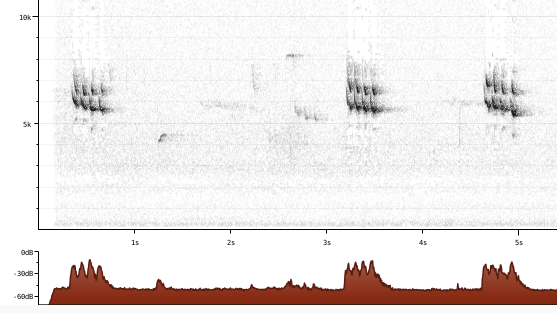
Call attributes:
Call melody: one note, fast, Frequency: 5-7 KHz, Special sounds: swoop.
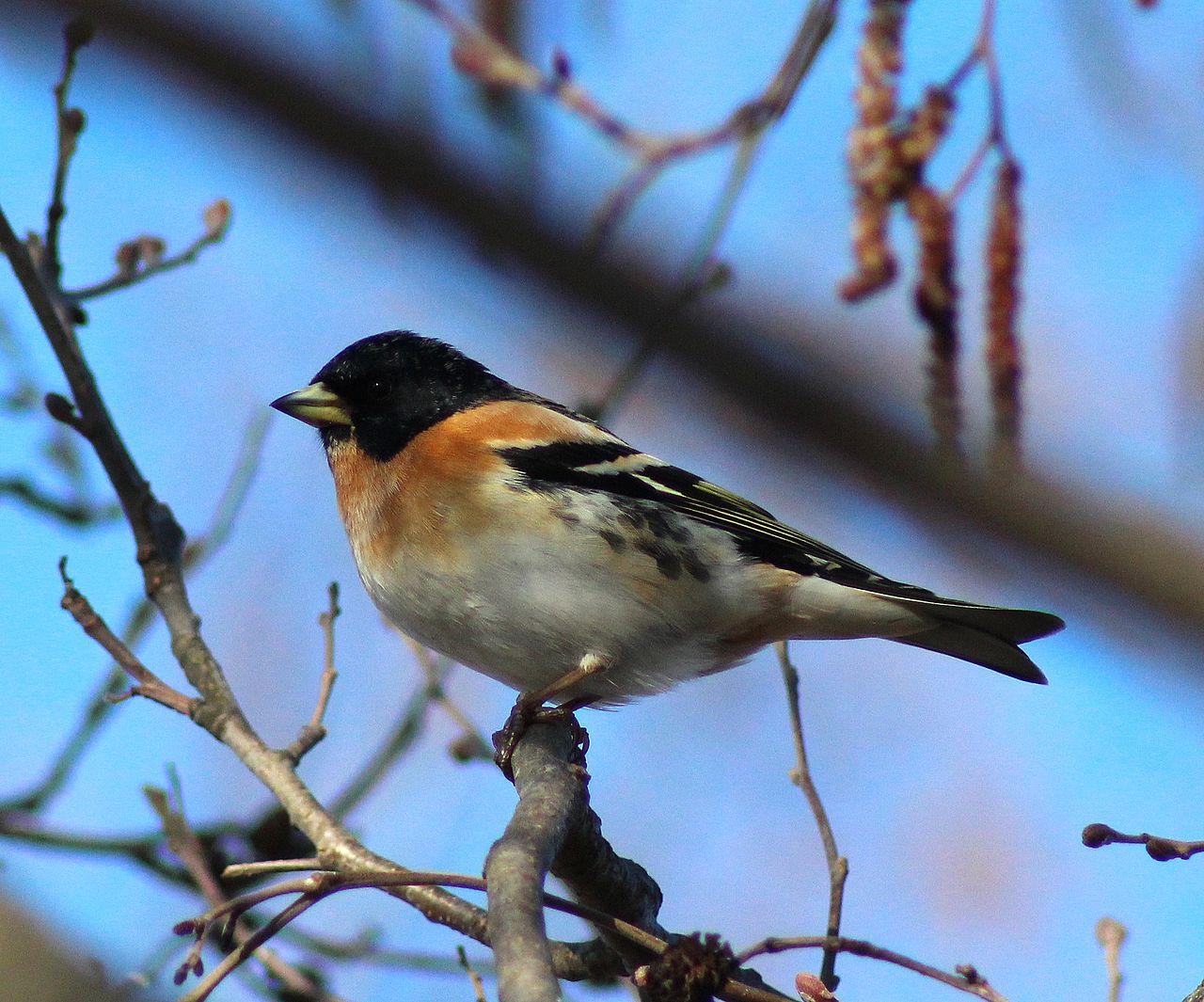
Wikipedia Bergfink. Foto: Source: WIKIPEDIA
Wikipedia Bergfink.jpg
This bird appears across the great seas in the following continents:
Europe, North America, Africa.
Geography: ![]() the Brambling appears regularly in small numbers in Alaska during migration, straying the short distance across the Bering Sea. Some of those that stray across in autumn apparently then continue south on the American side, and there have been winter records for numerous states and provinces east to the Atlantic Coast and south to Colorado. Many of these vagrant Bramblings have been found visiting bird feeders. [Link]
the Brambling appears regularly in small numbers in Alaska during migration, straying the short distance across the Bering Sea. Some of those that stray across in autumn apparently then continue south on the American side, and there have been winter records for numerous states and provinces east to the Atlantic Coast and south to Colorado. Many of these vagrant Bramblings have been found visiting bird feeders. [Link]
Vocalization: ![]() Large repertoire of mostly characteristic sounds. [Link]
Large repertoire of mostly characteristic sounds. [Link]
Song: ![]() Song very distinct; a soft, wheezing, drawn-out single note. Repeated at the same pitch in a monotonous manner. [Link]
Song very distinct; a soft, wheezing, drawn-out single note. Repeated at the same pitch in a monotonous manner. [Link]
Calls: ![]() Contact calls include a short, nasal, ascending "keeaa", a short high-pitched, piercing "tzeet" and a linnet-like "chepp". May be mistaken for Greenfinch, but note softer timbre and stable pitch throughout the call. [Link]
Contact calls include a short, nasal, ascending "keeaa", a short high-pitched, piercing "tzeet" and a linnet-like "chepp". May be mistaken for Greenfinch, but note softer timbre and stable pitch throughout the call. [Link]
Physical details: length=14 cm,
wingspan=25-26 cm,
weight=17-30 g
Habitats:
Forest
Song:
General: Bergfink - call cheep plus two ascending Grünfink squawks. Song? Grünfink squawk but not descending, every 3-4 seconds.
Song: ![]() Song very distinct; a soft, wheezing, drawn-out single note. Repeated at the same pitch in a monotonous manner. [Link]
Song very distinct; a soft, wheezing, drawn-out single note. Repeated at the same pitch in a monotonous manner. [Link]
Song attributes:
Melody: simple rhythmic, slow, Frequency: medium (1-5 KHz) Special sounds: rasp Singing season: 04-14 - 09-15
♫ Source: XENOCANTO
XC731031 - Brambling - Fringilla montifringilla.mp3
(song)
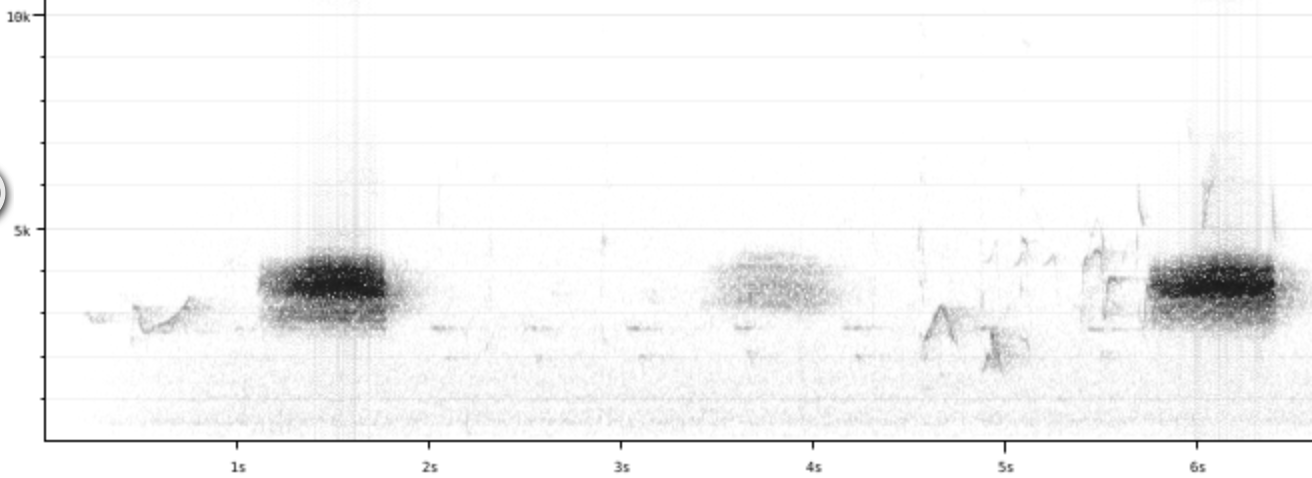
Profile Wikipedia eBird Vogelwarte BirdLife ZH ornitho.ch bird-song.ch Xeno-Canto BirdID NABU
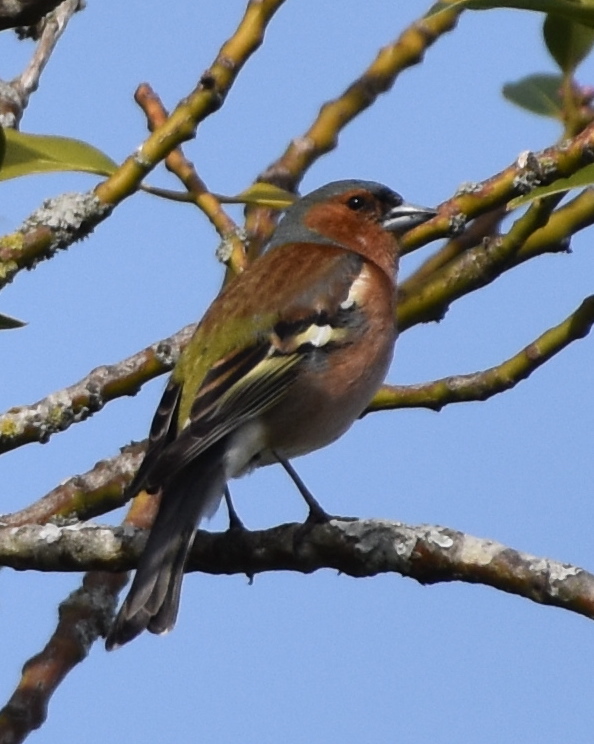
In tree by First, ZH. 2020-05-04 17.33.36 Luppmen
First observed in 🇨🇭 on 2019-06-04.
Heard everywhere locally but less often seen.
In winter 2020-2021 it often accompanied tits to our feeder (2021-2022 less often). While they grabbed
sunflower seeds, the chaffinch would hunt for food on the ground or in bushes.
On Dec 8 2021, was surprised to see flocks of collared doves, chaffinches and a few sparrows in a harvested corn field as it was snowing. I wasn't aware that chaffinches formed flocks, but the Merlin BirdID app told me 'forms flocks in winter'.
I've caught it on stubby branches of an evergreen, in a lone tree in a farmyard, and in Brittany even on
a lightpost. And I seem to see one every time I go to Zurich, so they're happy in an urban setting.
Etymology: ![]() Als Kontakt- und Alarmruf dient «pink», von dem wahrscheinlich die deutsche Bezeichnung «Fink» herkommt. [Von BirdLifes Schweizer 'bird song' Website]
Als Kontakt- und Alarmruf dient «pink», von dem wahrscheinlich die deutsche Bezeichnung «Fink» herkommt. [Von BirdLifes Schweizer 'bird song' Website]
Appearance and identification: ![]() Interesting tidbit: the chaffinch is one bird
that can change colors without molting. Its new feathers in autumn are grayish, but by late spring
the edges of the feathers have worn away, revealing the chaffinch's brightest colors of the year. [Lovette and Fitzpatrick's Handbook of Bird Biology]
Interesting tidbit: the chaffinch is one bird
that can change colors without molting. Its new feathers in autumn are grayish, but by late spring
the edges of the feathers have worn away, revealing the chaffinch's brightest colors of the year. [Lovette and Fitzpatrick's Handbook of Bird Biology]
Song: ![]() Song a falling 5 sec. phrase "zitt-zitt-chep-chepp-chu-chu-churrurrwitt". Structurally similar to Willow Warbler, but with a conclusive, ascending and accented ending, and with a much harder, finch-like, timbre. [Link]
Song a falling 5 sec. phrase "zitt-zitt-chep-chepp-chu-chu-churrurrwitt". Structurally similar to Willow Warbler, but with a conclusive, ascending and accented ending, and with a much harder, finch-like, timbre. [Link]
Physical details: length=14 cm,
wingspan=24-28 cm,
weight=18-29 g
Habitats:
Forest
Social groups can include up to 10 members.
Song:
General: A medium long phrase that slowly descends (I think of it bouncing down a staircase), then usually takes a
jump up before a final descent.
Song: ![]() In Bavaria the mnemonic for the typical chaffinch song is: „Ich hätte gerne ein Weizenbier“,
i.e. "I'd like another Weizenbier". [DasHaus]
In Bavaria the mnemonic for the typical chaffinch song is: „Ich hätte gerne ein Weizenbier“,
i.e. "I'd like another Weizenbier". [DasHaus]
Song attributes:
Melody: stereotype melodic (mmmmmmmmLlhH), slow, Frequency: medium (1-5 KHz) Singing season: 02-01 - 07-31 Dawn chorus start, 10 minutes before dawn.
♫ 2024-04-30 12 55 Fehraltorf - Buchfink Gesang-Variante, steigt am Schluss - mmmmmmmmLlhH. 2024-04-30 12.55.00 Fehraltorf (song)
♫ Source: BirdNet
20210419_142922 birdnet 1449 - Common Chaffinch but who is the hhll behind him - Common Chaffinch - Fehraltorf.mp3
2021-04-19 14.29.22 Fehraltorf (song)
Calls:
1:
General: Repeated ascending note, faster than the long starling whoops, but compare with the black redstart.
There are many different calls, the Marler book describes the 'chink' call as functioning as a mobbing and separation call.
At XenoCanto I find calls described as "ping", "pik" (same thing?), "pchew", "duit", "huit", "ti-huit".
Call: ![]() Der sogenannte Regenruf der Männchen, „schrrüt“, der selbst in benachbarten Ortsteilen deutlich variieren kann, erklingt nur während der Brutzeit. Als Regenruf wird er bezeichnet, weil er kurz vor oder sogar während des Regens zu hören ist, wenn die anderen Vögel verstummen. [DasHaus]
Der sogenannte Regenruf der Männchen, „schrrüt“, der selbst in benachbarten Ortsteilen deutlich variieren kann, erklingt nur während der Brutzeit. Als Regenruf wird er bezeichnet, weil er kurz vor oder sogar während des Regens zu hören ist, wenn die anderen Vögel verstummen. [DasHaus]
Rain call from XenoCanto
♫ Rain call from XenoCanto Recorded by Paul Driver in Mundford, Norfolk, UK Source: XENOCANTO
XC71019 common chaffinch rain call.mp3
(rain call)
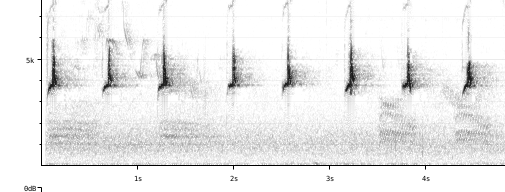
2:
Call: ![]() Als Alarmsignal dient ein mehrsilbiges „pink“. [DasHaus]
Als Alarmsignal dient ein mehrsilbiges „pink“. [DasHaus]
Ping call from XenoCanto
♫ Ping call from XenoCanto Source: XENOCANTO
XC460303 common chaffinch ping call.mp3
(alarm call)

Call attributes:
rain call Call melody: one note, slow, Frequency: 3-5 KHz, Special sounds: whoop.
Presence: 01-01 - 12-31
Breeding: 04-01 - 07-31
Migration in: 02-20 - 04-15
Migration out: 09-10 - 11-15
Nach Disteln mögen sie Sonnenblumenkerne 2020-10-13 09.21.10 Luppmen
First observed in 🇨🇭 on 2019-09-22.
One of the more colorful birds in our area, but fairly shy and skittish, so you don't see them much.
Supposedly a bit smaller than a sparrow or a great tit, but to me they look bigger and heavier?
Well hidden in the tree branches; at thistles or sunflowers.
Name stammt angeblich vom Gesang: ein steigernder sti-ge-litt.
My first (multilingual) notes: Stieglitz like Grünfink, fast, high, occasional trills. Occasionally ends a bit with falling note like buchfink
Mir wurde erst in St. Moritz in Juli 2021 bewusst wie aehnlich der Steiglitz wie ein Gruenfink klingt - beide koennen lange Gesang mit Trillern und rauhen sinkenden Toenen singen, und ich habe Stieglitz v.a. durch dieses Stoehnen fuer Gruenfink gehalten.
Song: ![]() Contact-call distinct, and also constitutes a major part of the song. A sharp and explosive "witt", or "tzee-witt". Sometimes given as a single syllable, di- or trisyllabic, or as continuous series. The song is comprised of rapid series of the contact call, interrupted by drawn-out melodic notes and trills. [Link]
Contact-call distinct, and also constitutes a major part of the song. A sharp and explosive "witt", or "tzee-witt". Sometimes given as a single syllable, di- or trisyllabic, or as continuous series. The song is comprised of rapid series of the contact call, interrupted by drawn-out melodic notes and trills. [Link]
Calls: ![]() Other calls: A harsh budgerigar or house martin-like "trrrtt-trrrrt". [Link]
Other calls: A harsh budgerigar or house martin-like "trrrtt-trrrrt". [Link]
Physical details: length=12 cm,
wingspan=21-25 cm,
weight=14-19 g
Habitats:
Settlement
Song:
General: Hectic sing-song, quite chaotic in feeding groups. But kept as songbird, so I guess more melodic when singing solo. A bit like a black cap warbler (Mönchsgrasmücke).
Gesang hat eine Struktur (und ist langsamer als der Girlitz): Zuerst eine kleine Melodie hoch und runter; dann vielleicht ein Gruenfink-Triller, dann 4 wiederholte Noten oder ein neues Melodiechen. (Oder kommen diese Elemente eher zufaellig?)
Song attributes:
Melody: stereotype melodic, fast, Frequency: 2-7 KHz Special sounds: fluting, rattle Singing season: year round Only pauses singing while molting and thus endangered. Dawn chorus start, 20 minutes before dawn.
♫ Source: XENOCANTO
XC638230 - European Goldfinch - Carduelis carduelis.mp3
(song)

Call:
![]() Wild melody (remember these birds are also kept as songbirds in cages.
the German name Stieglitz imitates its call (sti-ge-lit) - though I don't hear that! [Link]
Wild melody (remember these birds are also kept as songbirds in cages.
the German name Stieglitz imitates its call (sti-ge-lit) - though I don't hear that! [Link]
Xeno-Canto recording
♫ Xeno-Canto recording Adult call recorded in the UK. Source: XENOCANTO
XC468566 European Goldfinch call in UK.mp3
(call)
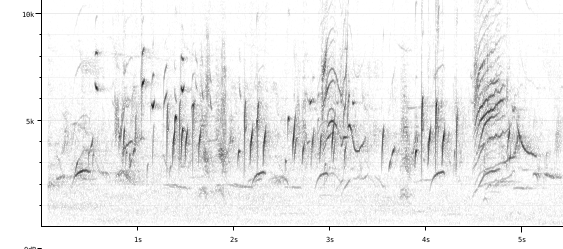 Xeno-Canto recording
Xeno-Canto recording
♫ Xeno-Canto recording Record in Lège-Cap-Ferret, France byStanislas Wroza and described by him as a 'tik' call and a flight call. Source: XENOCANTO
XC526383 European Goldfinch flight call.mp3
(call)
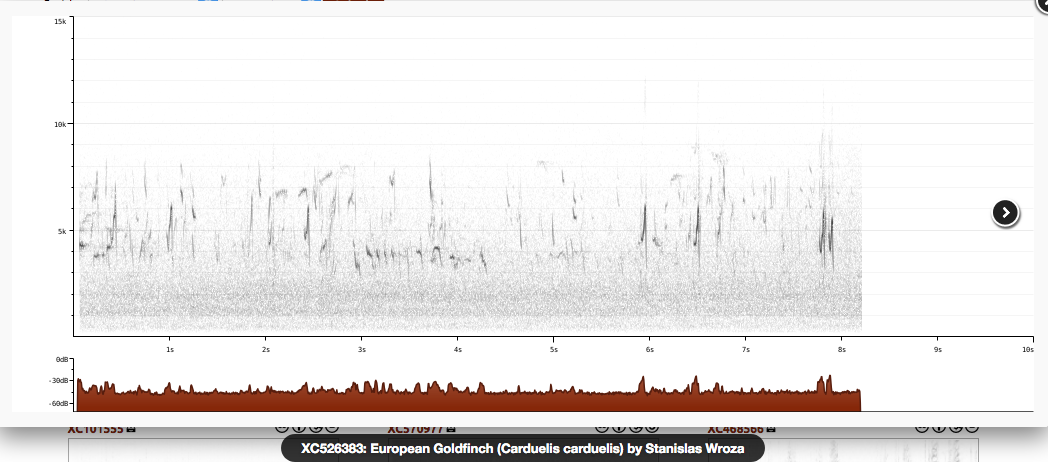
Call attributes:
Call melody: stereotype melodic, fast, Frequency: 2-8 KHz,

Wikipedia: Common redpoll Source: OTHER
1200px-Carduelis_flammea_CT6.jpg
This bird appears across the great seas in the following continents:
Europe, North America.
roter Punkt auf Kopf, sonst weiss+braun, teilweise hell-rot auf brust.
Behavior: ![]() Trotz Ihrer roten Abzeichen sind die bräunlich-weiss gestreiften Vögel wenig auffällig, und wenn sie nicht gerade rufen, bleiben sie meist unentdeckt. Oft fliegen sie unvermittelt auf, drehen im Schwarm eine Runde und fallen wieder ein. [Link]
Trotz Ihrer roten Abzeichen sind die bräunlich-weiss gestreiften Vögel wenig auffällig, und wenn sie nicht gerade rufen, bleiben sie meist unentdeckt. Oft fliegen sie unvermittelt auf, drehen im Schwarm eine Runde und fallen wieder ein. [Link]
Song: ![]() Song an improvised chattering on various contact calls with no apparent phrasing. [Link]
Song an improvised chattering on various contact calls with no apparent phrasing. [Link]
Calls: ![]() Contact call diagnostic. A chattering "Chutt-utt-utt", with a more metallic and nasal timbre than Linnet and Twite. Other sound includes plaintive call mostly given when perched. Uttered as a continuous sound, but with a disyllabic feel. First part ascending slowly, then faster before it is cut off "tsooeet". [Link]
Contact call diagnostic. A chattering "Chutt-utt-utt", with a more metallic and nasal timbre than Linnet and Twite. Other sound includes plaintive call mostly given when perched. Uttered as a continuous sound, but with a disyllabic feel. First part ascending slowly, then faster before it is cut off "tsooeet". [Link]
Physical details: length=11-14 cm,
wingspan=20-25 cm,
weight=9-16 g
Habitats:
Mountain
Song:
A few chirps and a trill, then repeat.
Song attributes:
Melody: simple rhythmic, fast, Frequency: 2-6 KHz Special sounds: trill
Profile Wikipedia eBird Vogelwarte BirdLife ZH ornitho.ch bird-song.ch Xeno-Canto BirdID NABU
Gimpel gesehen das erste Mal, Ammler Höhenweg. 2021-08-02 15.55.56
First observed in 🇨🇭 on 2021-02-21.
General: ![]() The Eurasian bullfinch, common bullfinch or bullfinch (Pyrrhula pyrrhula) is a small passerine bird in the finch family, Fringillidae. In Anglophone Europe it is known simply as the bullfinch, as it is the original bird to bear the name bullfinch.
[more]
The Eurasian bullfinch, common bullfinch or bullfinch (Pyrrhula pyrrhula) is a small passerine bird in the finch family, Fringillidae. In Anglophone Europe it is known simply as the bullfinch, as it is the original bird to bear the name bullfinch.
[more]
Song: ![]() Song a quiet, modest mix of contact call and various chirping sounds, with peculiar harmonics. [Link]
Song a quiet, modest mix of contact call and various chirping sounds, with peculiar harmonics. [Link]
Calls: ![]() Contact call a soft, full-bodied, descending, pure whistle; "peeuu". [Link]
Contact call a soft, full-bodied, descending, pure whistle; "peeuu". [Link]
Physical details: length=14-16 cm,
wingspan=22-29 cm,
weight=27-38 g
Habitats:
Forest
Song:
3-note long M, pause, HL (somewhat falling)...Gim! Gim-peeel! Sounds a bit like a pirol.
Song attributes:
Melody: stereotype melodic, slow, Frequency: 2-8 KHz
♫ Source: XENOCANTO
XC637392 - Eurasian Bullfinch - Pyrrhula pyrrhula - song, recorded in France.mp3
(song)

Call:
laconic 1 note call w slight dip? Song NABU 1 parakeet like puppy-dog whining, NABU 2 whistles, 2-syllable peek-a-boo, ...
♫ Source: XENOCANTO
XC214867 - Eurasian Bullfinch - Pyrrhula pyrrhula - contact call, recorded in Germany.mp3
Germany (contact call)

Call attributes:
contact call Call melody: one note, slow, Frequency: 2-3 KHz,

Wikimedia Red Crossbills (Male). Source: WIKIPEDIA
Wikimedia Red_Crossbills_(Male).jpg
First observed in 🇨🇭 on 2020-06-13.
This bird appears across the great seas in the following continents:
Europe, North America, Africa.
Forests with conifers. Some spend the winter in Switzerland, others are here year-round.
Appearance and identification: ![]() Nabu.de: das Männchen schon von weitem durch seine ziegelrote Farbe auf. Das Weibchen dagegen ist unscheinbar graugrün gefärbt.Größe: 15 bis 17 Zentimeter
Zugtyp: Teilzieher
Beobachtungszeitraum: Oktober bis April, im Mittelgebirge und Alpenraum ganzjährig. [Link]
Nabu.de: das Männchen schon von weitem durch seine ziegelrote Farbe auf. Das Weibchen dagegen ist unscheinbar graugrün gefärbt.Größe: 15 bis 17 Zentimeter
Zugtyp: Teilzieher
Beobachtungszeitraum: Oktober bis April, im Mittelgebirge und Alpenraum ganzjährig. [Link]
![]() New research suggests that there may be as many as eight different full species of Red Crossbills on [North America]. [Link]
New research suggests that there may be as many as eight different full species of Red Crossbills on [North America]. [Link]
Behavior: ![]() Wikipedia: a small passerine bird in the finch family Fringillidae, also known as the Common Crossbill in Eurasia. Crossbills have distinctive mandibles, crossed at the tips, which enable them to extract seeds from conifer cones and other fruits. [Link]
Wikipedia: a small passerine bird in the finch family Fringillidae, also known as the Common Crossbill in Eurasia. Crossbills have distinctive mandibles, crossed at the tips, which enable them to extract seeds from conifer cones and other fruits. [Link]
Song: ![]() The song consist of improvised, resonant twittering, and series of contact calls with no apparent phrases. It is generally faster, with less marked pauses than in Parrot Crossbill, and the phrasing seems more random. [Link]
The song consist of improvised, resonant twittering, and series of contact calls with no apparent phrases. It is generally faster, with less marked pauses than in Parrot Crossbill, and the phrasing seems more random. [Link]
Calls: ![]() Contact call similar to Parroy Crossbill's "tupp", but is on average higher and less powerful, with a "cut-off" ending. In sum: Parrot Crossbill; hard attack, soft ending, Crossbill: softer attack, cut-off ending. Beware regional variations and overlap in pitch of calls with Parrot. [Link]
Contact call similar to Parroy Crossbill's "tupp", but is on average higher and less powerful, with a "cut-off" ending. In sum: Parrot Crossbill; hard attack, soft ending, Crossbill: softer attack, cut-off ending. Beware regional variations and overlap in pitch of calls with Parrot. [Link]
Physical details: length=16 cm,
wingspan=27-30 cm,
weight=35-50 g
Habitats:
Forest
Song:
Repeated hi-low pattern...well, doesn't always sound like that.
The very short beginning of my Stazersee recording before the static sets in does,
as well as a song found online.
One recording reminds me of cicada sounds.
Song attributes:
Melody: stereotype melodic, slow, Frequency: 2-10 KHz
Erlenzeisig bei Rapperswil. 2021-02-12 13.07.42 Rapperswil
First observed in 🇨🇭 on 2021-02-12.
Also lives in North America!
Gelb aber schwarz/weiss auf dem Kopf, bauch/fluegel wie weiss mit schwarzen Streifen, mehr braun bei weibchen?
Song: ![]() Distinct calls and song. The contact call is also prominent in the improvised song. Other typical sounds in the song includes a peculiar wheeze, like someone sucking their teeth, and lots of expert mimicry. [Link]
Distinct calls and song. The contact call is also prominent in the improvised song. Other typical sounds in the song includes a peculiar wheeze, like someone sucking their teeth, and lots of expert mimicry. [Link]
Calls: ![]() Most often heard is the sharp and disyllabic contact call: "doo-lee", with both notes descending. Sometimes given a in monosyllabic manner "dlyy". [Link]
Most often heard is the sharp and disyllabic contact call: "doo-lee", with both notes descending. Sometimes given a in monosyllabic manner "dlyy". [Link]
Physical details: length=12 cm,
wingspan=20-23 cm,
weight=11-18 g
Habitats:
Mountain
Song:
![]() bird-song.ch sagt Gesang zwitschernd und trillernd und aehnlich wie Girlitz - ich finde auch, es hat das hohe chaotische von den mit ab und zu was rohem. [Link]
bird-song.ch sagt Gesang zwitschernd und trillernd und aehnlich wie Girlitz - ich finde auch, es hat das hohe chaotische von den mit ab und zu was rohem. [Link]
Song attributes:
Melody: sings 30 seconds or longer, fast, Frequency: high (3-9 KHz) Special sounds: mimicry
♫ Source: XENOCANTO
XC714393 - Eurasian Siskin - Spinus spinus.mp3
(song)

A rare visitor by our bird feeder in Fehraltorf 2023-01-16 10.54.12 Fehraltorf
First observed in 🇨🇭 on 2019-08-01.
Vogelewarte.ch: Neben Haussperling und Amsel ist er einer der zahlreichsten Vögel der Städte und Dörfer.
Ich habe Monate lang nur eins in Pfäffikon gehört,
dann ein Schwarm im Fehraltorfer Industriegebiet.
Endlich in Juli 2020 ist eine Gruppe zu uns gezogen und entweder im Birkenbaum
oder hinter der Kinderkrippe zu hören gewesen.
Im Birkenbaum habe ich endlich eins fotografieren können.
In Laubbäumen
Song: ![]() Song composed of various sequences of linked sounds, repeated in a vibrating manner; "trrrrrrrrr", "chechechecheche". Sometimes resembles Brambling when making the wheezy "rrrrrrrrr" sound, but differs in being harsher and by "pulling" the pitch downwards (or sometimes upwards) at the end. [Link]
Song composed of various sequences of linked sounds, repeated in a vibrating manner; "trrrrrrrrr", "chechechecheche". Sometimes resembles Brambling when making the wheezy "rrrrrrrrr" sound, but differs in being harsher and by "pulling" the pitch downwards (or sometimes upwards) at the end. [Link]
Calls: ![]() Contact call a fairly resonant "chep-chep", resembling Redpoll, but less nasal and with a fuller tone. Also a sharp, drawn, ascending "kooeee", (perhaps not obviously recognized as a finch). [Link]
Contact call a fairly resonant "chep-chep", resembling Redpoll, but less nasal and with a fuller tone. Also a sharp, drawn, ascending "kooeee", (perhaps not obviously recognized as a finch). [Link]
Physical details: length=15 cm,
wingspan=24-27 cm,
weight=17-34 g
Habitats:
Settlement
Song or calls similar to:
Tree pipit.
Song:
General: Sequence of 4-6 rhythmic elements at different pitches.
A sort of trill is often start or end of the sequence,
there are slides.
Song attributes:
Melody: stereotype melodic (m), fast, Frequency: 2-7 KHz Special sounds: rasp, trill Singing season: 01-01 - 07-31 Dawn chorus start, 15 minutes before dawn.
♫ Source: BirdNet
20210731_102232 birdnet 1877 - European Greenfinch, h trill, m trill, 4x m swoop - European Greenfinch - Fehraltorf.mp3
2021-07-31 10.22.32 Fehraltorf (song)
Call:
Raspy descending note
Call attributes:
Call melody: one note, slow, Frequency: medium (1-5 KHz), Special sounds: swoop, rasp.
Bluthänfling. 2023-05-27 13.11.50 Amden Hinder Hoechi
First observed in Mallorca on 2022-04-15.
Etymology: ![]() Herkunft: von der Hanf-Pflanze (Cánnabis), deren Samen zu seiner Nahrung gehören [Link]
Herkunft: von der Hanf-Pflanze (Cánnabis), deren Samen zu seiner Nahrung gehören [Link]
Rote Stirn, Bauch; Kopf grau, Kinn weiss.
Appearance and identification: ![]() The summer male has a grey nape, red head-patch and red breast. Females and young birds lack the red and have white underparts, the breast streaked buff. [Link]
The summer male has a grey nape, red head-patch and red breast. Females and young birds lack the red and have white underparts, the breast streaked buff. [Link]
Gesang fuer mich aehnlich wie Gruenfink.
Song: ![]() Song a varied, sweet stream of contact calls, mimicry and trills with a staccato feel. [Link]
Song a varied, sweet stream of contact calls, mimicry and trills with a staccato feel. [Link]
Calls: ![]() Flight-call a quick and "bouncing" "gig-gig" or "tchett-tchett". Most often disyllabic utterances, while Twite seems to vary more the number of syllables. Tone harder and more bouncing. Most easily recognized by the frequently interwoven, disyllabic contact calls. [Link]
Flight-call a quick and "bouncing" "gig-gig" or "tchett-tchett". Most often disyllabic utterances, while Twite seems to vary more the number of syllables. Tone harder and more bouncing. Most easily recognized by the frequently interwoven, disyllabic contact calls. [Link]
Physical details: length=13 cm,
wingspan=21-25 cm,
weight=15-22 g
Habitats:
Agricultural
Song:
General: Aehnlich wie ein Rohrsaenger aber nur kurze Segmente mit klaren Pausen.
Song: Nabu: Sein Gesang umfasst trillernde, kurze und musikalische pfeifende Laute, unter anderem „piUU“, „trrüh“ und „tu-ki-jüüh“. [Link]
Song: ![]() Gesang ist fast Rohrsänger-artig, relativ hoch und zirpend. Manchmal mit kleinen Pausen. bird-song Aufnahme where kurz, llll mhllll [Link]
Gesang ist fast Rohrsänger-artig, relativ hoch und zirpend. Manchmal mit kleinen Pausen. bird-song Aufnahme where kurz, llll mhllll [Link]
Song attributes:
Melody: stereotype melodic, fast, Frequency: 2-7 KHz Special sounds: mimicry
♫ Source: XENOCANTO
XC705526 - Common Linnet - Linaria cannabina cannabina - song, recorded in England.mp3
(song)


Wikipedia: Twite Source: OTHER
Twite_%28Carduelis_flavirostris%29_-_geograph.org.uk_-_676590.jpg
The Twite or Berghänfling is said to be a bird of Islay, which I'll visit in August 2023.
Vocalization: ![]() Lacks Linnet's frequent inclusion of "gig-gig" sounds. [Link]
Lacks Linnet's frequent inclusion of "gig-gig" sounds. [Link]
Song: ![]() Song a rapid alternation of trills and nasal "twites", given in an even tempo with phrases of variable length. [Link]
Song a rapid alternation of trills and nasal "twites", given in an even tempo with phrases of variable length. [Link]
Calls: ![]() Contact call a short "chep" given in series, similar to Brambling, Redpoll and Linnet. Easiest identified by other distinct call given both in flight and on ground; a peculiar, nasal and twangy "twite", from which the species name originates. Each "twite" gives the impression of the pitch being "out of control", like cartoon-like sound-effects. [Link]
Contact call a short "chep" given in series, similar to Brambling, Redpoll and Linnet. Easiest identified by other distinct call given both in flight and on ground; a peculiar, nasal and twangy "twite", from which the species name originates. Each "twite" gives the impression of the pitch being "out of control", like cartoon-like sound-effects. [Link]
Physical details: length=14 cm,
wingspan=22-24 cm,
weight=13-18 g
Profile Wikipedia eBird Vogelwarte BirdLife ZH ornitho.ch bird-song.ch Xeno-Canto BirdID NABU
Goldammer am Aabach, Wetzikon. 2021-03-10 10.36.28 Wetzikon
First observed in 🇨🇭 on 2020-05-26.
Habe ihn im Fehraltorfer-Wald endlich gesehen
als er von einem Baum in die Spitze eines anderen geflogen ist.
The English language Wikipedia page for bunting says: The genus name Emberiza is from Old German Embritz, a bunting.[6] The origin of the English "bunting" is unknown. I always though it makes little sense that these birds are Ammer in German and Hammer in English, though neither seems logical. Ammer is just a corruption of Embritz, and Hammer presumably a folk etymology - 'oh, this sounds a bit like hammer, let's call it that!'.
vogelwarte.ch says it prefers areas around agriculture: hedges, orchards, fields, meadows.
Heard in the woods next to farmer's fields in Fehraltorf. (Weidholzweg, next farm is Tuschacher.
The breast has a checkerd pattern apparently typical of buntings (Emberizidae),
that to me resembles that of many thrushes - but this seems to be coincidence.
Song: ![]() Kurzes Liedchen. „ Wie wie wie hab ich dich liiieb“ Das „Lieb“ ist meist etwas tiefer, kann aber auch höher sein oder doppelt, dabei das eine höher und das andere tiefer. Sehr variabel!
[Link]
Kurzes Liedchen. „ Wie wie wie hab ich dich liiieb“ Das „Lieb“ ist meist etwas tiefer, kann aber auch höher sein oder doppelt, dabei das eine höher und das andere tiefer. Sehr variabel!
[Link]
![]() Song a series of 6-8 (or more) slightly ascending "tze" 's, rising in volume and ending on a sustained note, which may be lower or higher than the others. Often rendered as "little-bit-of-cheese-and-no-bread". Last note is often omitted, which may lead to confusion with Cirl Bunting. Timbre with prominent harmonics as in other bunting songs. [Link]
Song a series of 6-8 (or more) slightly ascending "tze" 's, rising in volume and ending on a sustained note, which may be lower or higher than the others. Often rendered as "little-bit-of-cheese-and-no-bread". Last note is often omitted, which may lead to confusion with Cirl Bunting. Timbre with prominent harmonics as in other bunting songs. [Link]
Calls: ![]() „zick“ „zeck“
[Link]
„zick“ „zeck“
[Link]
![]() Distinct contact call: A short and brittle "zeet", rich in harmonics. [Link]
Distinct contact call: A short and brittle "zeet", rich in harmonics. [Link]
Physical details: length=16 cm,
wingspan=23-29 cm,
weight=25-36 g
Habitats:
Agricultural
Song:
High-pitched, two notes that sound like one, repeated 10-12 times, with a higher tweet and then a whistle that sounds higher to me but usually shows up on the sonogram as the same range.
The mnemonic for the staccato song in German is: «Wie, wie, wie, wie hab ich dich lieb». See the image for dialects noted by yellowhammers.net - the most common Swiss dialect is said to be XlB, though I don't always hear the second note myself (and interestingly enough, it doesn't play on my Bose headphones). Pavel Pipek of the yellowhammers project kindly explained to me: 'Regarding the XlB and other dialects, these codes were defined by a Danish scientist Poul Hansen in his paper from 1985. In this case Xl stands for a syllable with high frequency (and long) and B for a syllable with low frequency.'
Song attributes:
Melody: simple rhythmic, fast, Frequency: 4-8 KHz Singing season: 03-01 - 09-30 Dawn chorus start, 45 minutes before dawn.
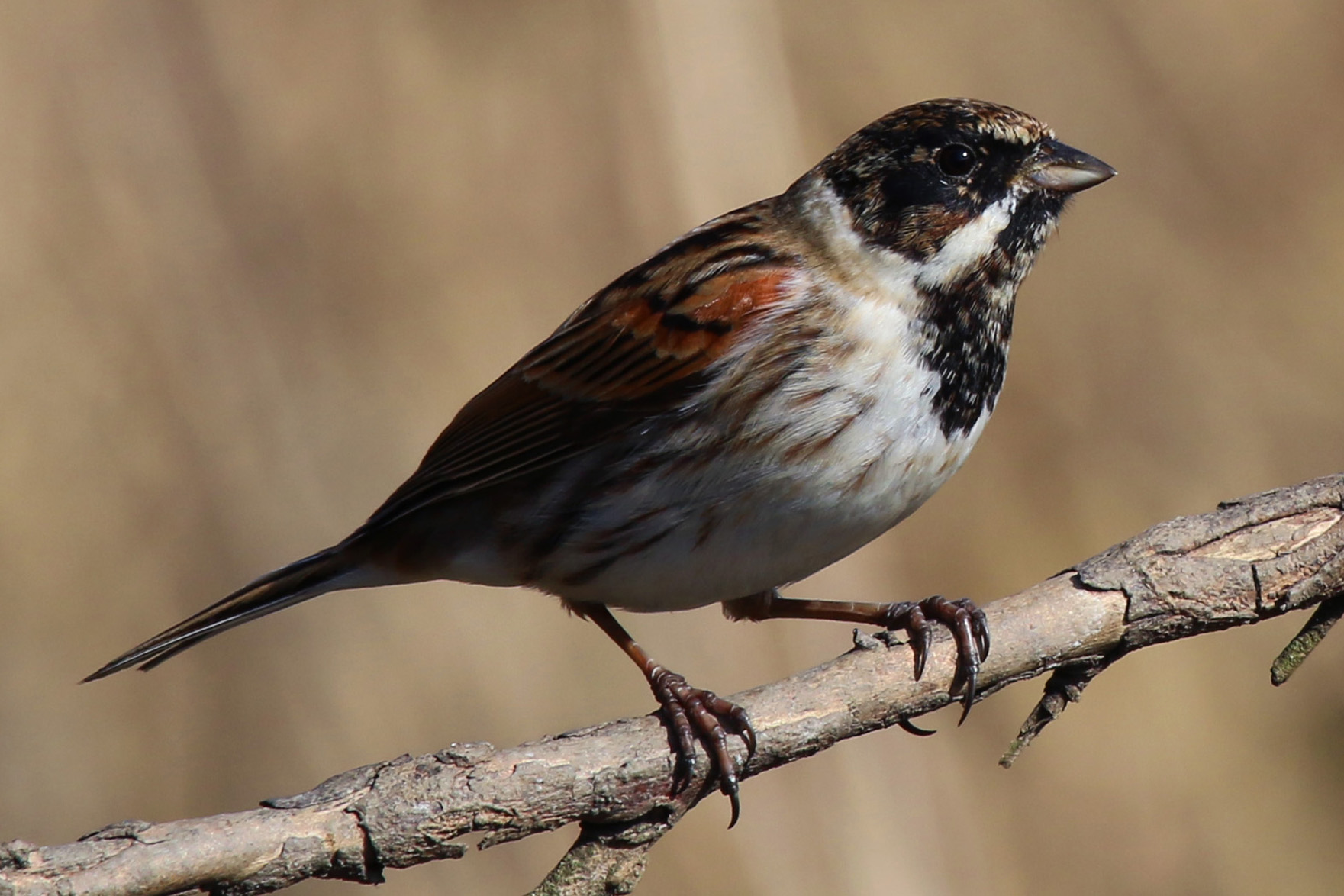
Wikipedia Common reed bunting (emberiza schoeniclus) m. By Charles J. Sharp - Own work, from Sharp Photography, sharpphotography, CC BY-SA 3.0, https://commons.wikimedia.org/w/index.php?curid=31607772 Source: WIKIPEDIA
Wikipedia Common_reed_bunting_(emberiza_schoeniclus)_m.jpg
First observed in 🇨🇭 on 2020-04-27.
Appearance and identification: ![]() A bit like General Burnsides: white sideburns, here curling back around a black head. [Link]
A bit like General Burnsides: white sideburns, here curling back around a black head. [Link]
Song: ![]() Song variable between individuals and breeding status: A short sequence of 3-5 brittle and buzzing sounds, repeated consistently with marked pauses. Last sound in phrase often has a conclusive feel, but not always. Paired males sing slower than unpaired. Unpaired male song also more contracted, making the pauses between each phrase stand out. [Link]
Song variable between individuals and breeding status: A short sequence of 3-5 brittle and buzzing sounds, repeated consistently with marked pauses. Last sound in phrase often has a conclusive feel, but not always. Paired males sing slower than unpaired. Unpaired male song also more contracted, making the pauses between each phrase stand out. [Link]
Calls: ![]() Contact call a sharp, descending and drawn "tseeeoo". A bit similar to Yellow Wagtail, but not as sharp and explosive. In migration a thick, and unmusical "chong" is often heard. [Link]
Contact call a sharp, descending and drawn "tseeeoo". A bit similar to Yellow Wagtail, but not as sharp and explosive. In migration a thick, and unmusical "chong" is often heard. [Link]
Physical details: length=15-16 cm,
wingspan=21-28 cm,
weight=16-25 g
Habitats:
Wetland
Song:
General: At Fanel I heard sequences of whistles and trills (buzzes?), just a few notes, but wandering up and down: m h lll, or l m hhh m. Listen to recording of 2022-06-25 13.37.28
Song: ![]() BirdID: A short sequence of 3-5 brittle and buzzing sounds, repeated consistently with marked pauses. Last sound in phrase often has a conclusive feel, but not always. [Link]
BirdID: A short sequence of 3-5 brittle and buzzing sounds, repeated consistently with marked pauses. Last sound in phrase often has a conclusive feel, but not always. [Link]
Song attributes:
Melody: stereotype melodic, slow, Frequency: 3-7 KHz Special sounds: trill
♫ Source: XENOCANTO
XC723277 - Common Reed Bunting - Emberiza schoeniclus - song.mp3
(song)

♫ Source: BirdNet
20220625_133728 birdnet - Rohrammer - Rohrammer - Neuchâtel.mp3
2022-06-25 13.37.28 (song)
♫ Source: XENOCANTO
XC665288 - Common Reed Bunting - Emberiza schoeniclus schoeniclus - song.mp3
(song)
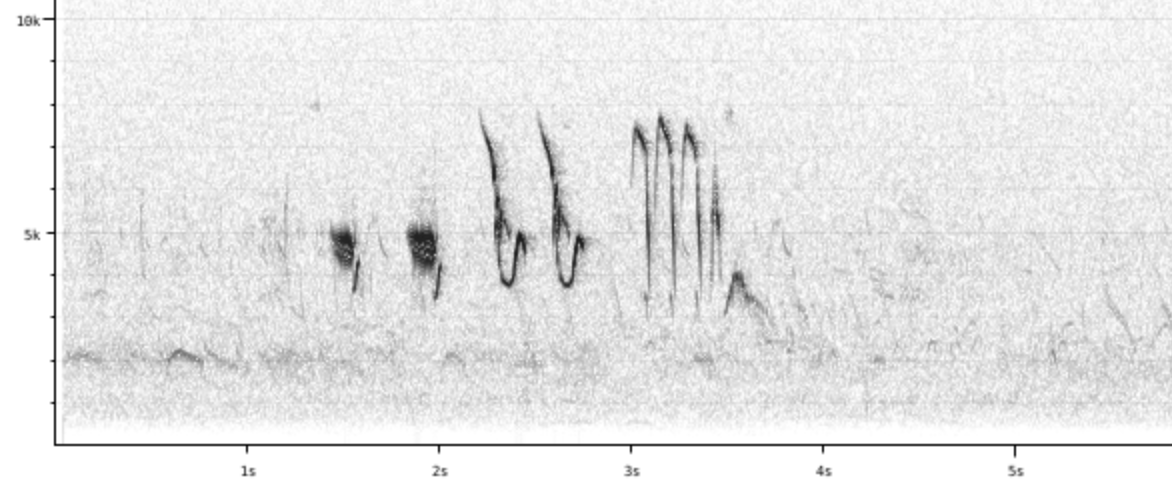
♫ Source: XENOCANTO
XC694863 - Common Reed Bunting - Emberiza schoeniclus - song.mp3
(song)

♫ Source: XENOCANTO
XC719864 - Common Reed Bunting - Emberiza schoeniclus - song.mp3
(song)
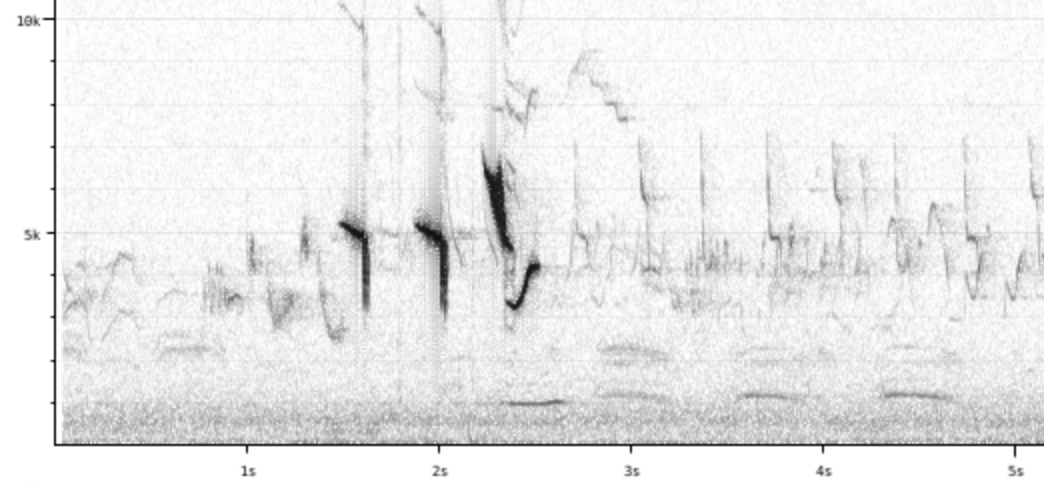
♫ Source: XENOCANTO
XC656275 - Common Reed Bunting - Emberiza schoeniclus - song.mp3
(song)

♫ Source: XENOCANTO
XC572969 - Common Reed Bunting - Emberiza schoeniclus - song.mp3
(song)

Profile Wikipedia eBird Audubon AllAboutBirds Xeno-Canto BirdID NABU
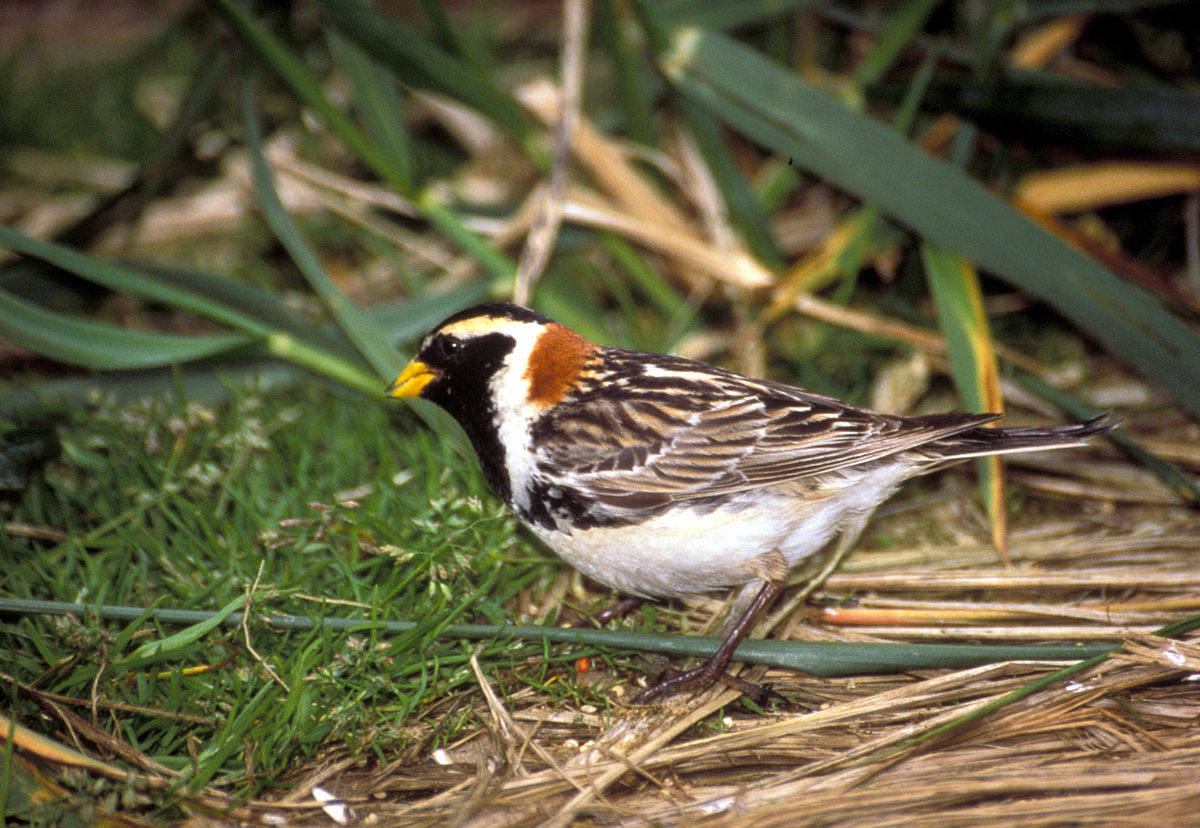
Wikipedia: Lapland longspur Source: OTHER
1200px-Lapland_Longspur_%28Calcarius_lapponicus%29.jpg
This bird appears across the great seas in the following continents:
Europe, North America.
Deutschland: Zugvogel, Wintergast
Song: ![]() Song: a short, creaky, brittle phrase, rich in harmonics; "kril-trrlrtt-ti-trlllkrlltrrt". Somewhat reminiscent of Horned Lark, but without its hesitating intro. In form a bit like Snow Bunting, but much less clear tones. [Link]
Song: a short, creaky, brittle phrase, rich in harmonics; "kril-trrlrtt-ti-trlllkrlltrrt". Somewhat reminiscent of Horned Lark, but without its hesitating intro. In form a bit like Snow Bunting, but much less clear tones. [Link]
Calls: ![]() Call: A Snow Bunting-like "prrrrit", but tone harder. Also a Snow Bunting-like "pjuu". Other sounds: soft, whistling calls reminiscent of Bullfinch, but with richer harmonics. [Link]
Call: A Snow Bunting-like "prrrrit", but tone harder. Also a Snow Bunting-like "pjuu". Other sounds: soft, whistling calls reminiscent of Bullfinch, but with richer harmonics. [Link]
Physical details: length=15-16 cm,
wingspan=25-28 cm,
weight=20-28 g
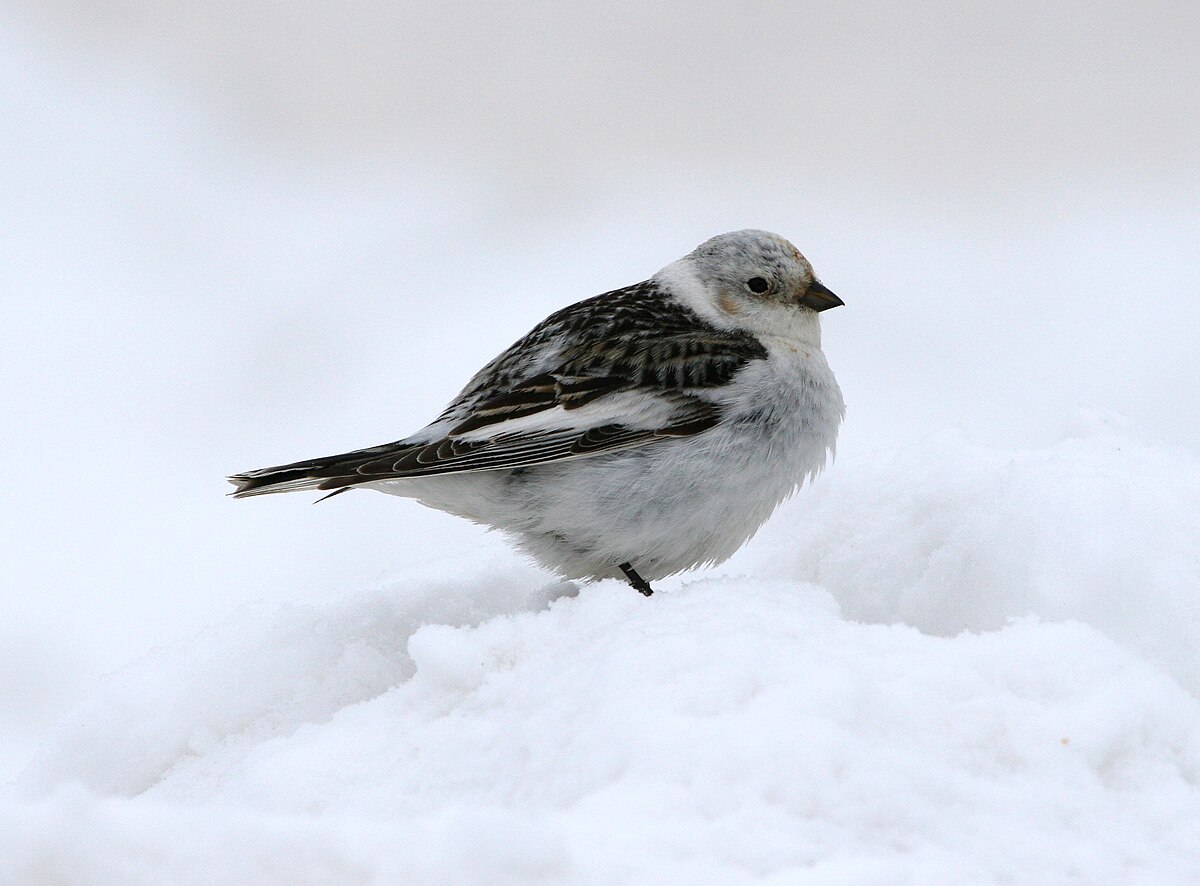
Wikipedia: Snow bunting Source: OTHER
1200px-Plectrophenax_nivalis1.jpg
This bird appears across the great seas in the following continents:
Europe, North America.
Deutschland: Wintergast
Song: ![]() Song simple and melodic. 2-5 syllable motifs with fairly wide tonal range. Can be confused with Lapland Bunting, but is much purer in tone with a less jingling timbre. Local dialects. [Link]
Song simple and melodic. 2-5 syllable motifs with fairly wide tonal range. Can be confused with Lapland Bunting, but is much purer in tone with a less jingling timbre. Local dialects. [Link]
Calls: ![]() Contact call a short, melodic and rapidly descending "peeuu". Often alternating with a rattling "trrreet". "Peeuu"-call quite similar to Lapland Bunting, but harder, purer in tone and less nasal. [Link]
Contact call a short, melodic and rapidly descending "peeuu". Often alternating with a rattling "trrreet". "Peeuu"-call quite similar to Lapland Bunting, but harder, purer in tone and less nasal. [Link]
Physical details: length=16-17 cm,
wingspan=32-38 cm,
weight=28-50 g
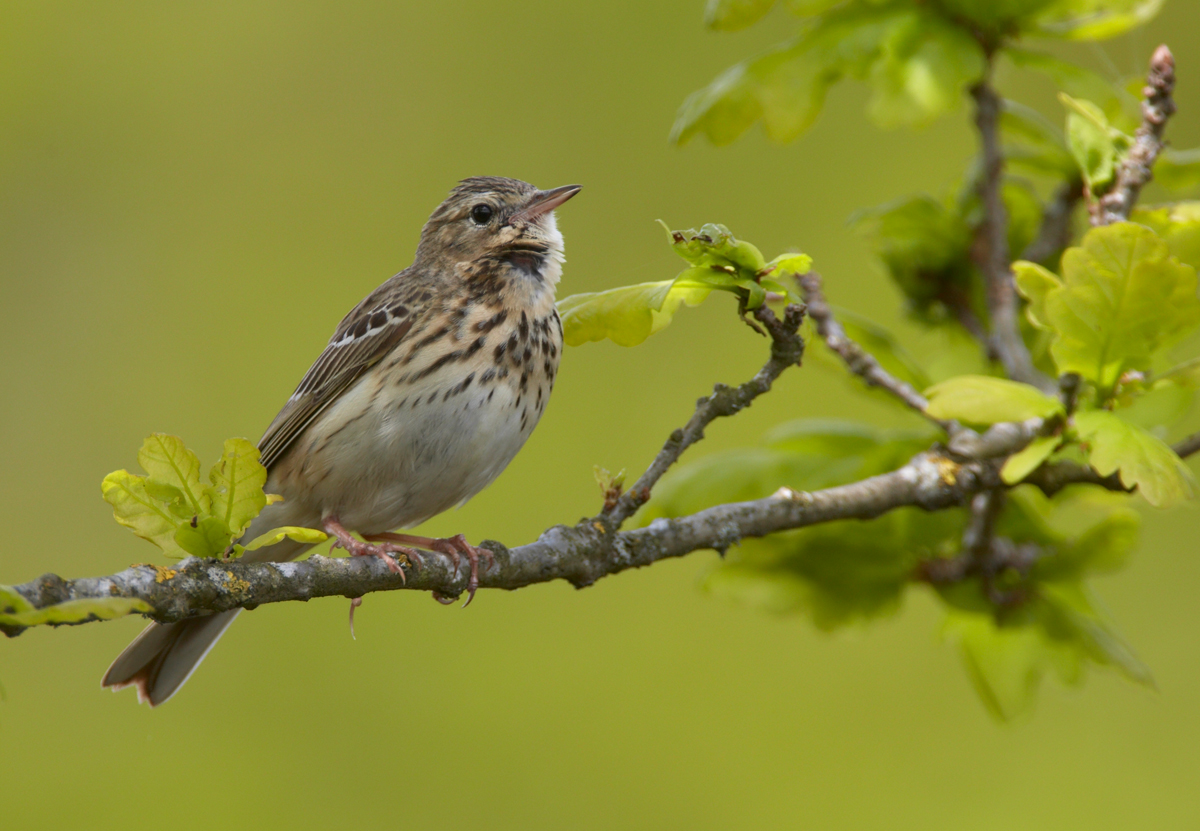
Wikipedia baumpieper Anthus trivialis. Von Vogelartinfo - Eigenes Werk, GFDL 1.2, Link Source: WIKIPEDIA
Wikipedia baumpieper Anthus_trivialis.jpg
First observed in 🇨🇭 on 2020-06-12.
Sieht aus wie ein Drossel
Song: ![]() Mehrere unterschiedliche Tonreihen aneinandergefügt. Zuletzt „zia zia zia ziah“. Zuerst auf Baum sitzend, dann im Singflug, Zia-Rufe während Gleitflug (Fallschirmvogel) [Link]
Mehrere unterschiedliche Tonreihen aneinandergefügt. Zuletzt „zia zia zia ziah“. Zuerst auf Baum sitzend, dann im Singflug, Zia-Rufe während Gleitflug (Fallschirmvogel) [Link]
![]() Song characteristic. Starts with a series of Chaffinch-like "che-che-che" which gives way to long, descending, "ricocheting" whistling notes (especially at the end of song-flight). [Link]
Song characteristic. Starts with a series of Chaffinch-like "che-che-che" which gives way to long, descending, "ricocheting" whistling notes (especially at the end of song-flight). [Link]
Calls: ![]() “psiet“ etwas nach unten gezogen. Auch „zieh“
[Link]
“psiet“ etwas nach unten gezogen. Auch „zieh“
[Link]
![]() Flight call a short buzzing "tzzzeet". Given at even pitch, and in a fuller tone than Red-Throated Pipit. [Link]
Flight call a short buzzing "tzzzeet". Given at even pitch, and in a fuller tone than Red-Throated Pipit. [Link]
Physical details: length=15 cm,
wingspan=25-27 cm,
weight=18-29 g
Habitats:
Mountain
Song or calls similar to:
European greenfinch, European greenfinch.
Song:
Reminds me of a greenfinch - series of trills, whoops and other sounds with a long pause
Song attributes:
Melody: simple rhythmic, slow, Frequency: medium (1-5 KHz) Special sounds: whoop, trill
♫ Source: XENOCANTO
XC570506 - Tree Pipit - Anthus trivialis - song.mp3
(song)

♫ Source: XENOCANTO
XC649035 - Tree Pipit - Anthus trivialis - song.mp3
(song)

Profile Wikipedia eBird Vogelwarte BirdLife ZH ornitho.ch bird-song.ch Xeno-Canto BirdID NABU
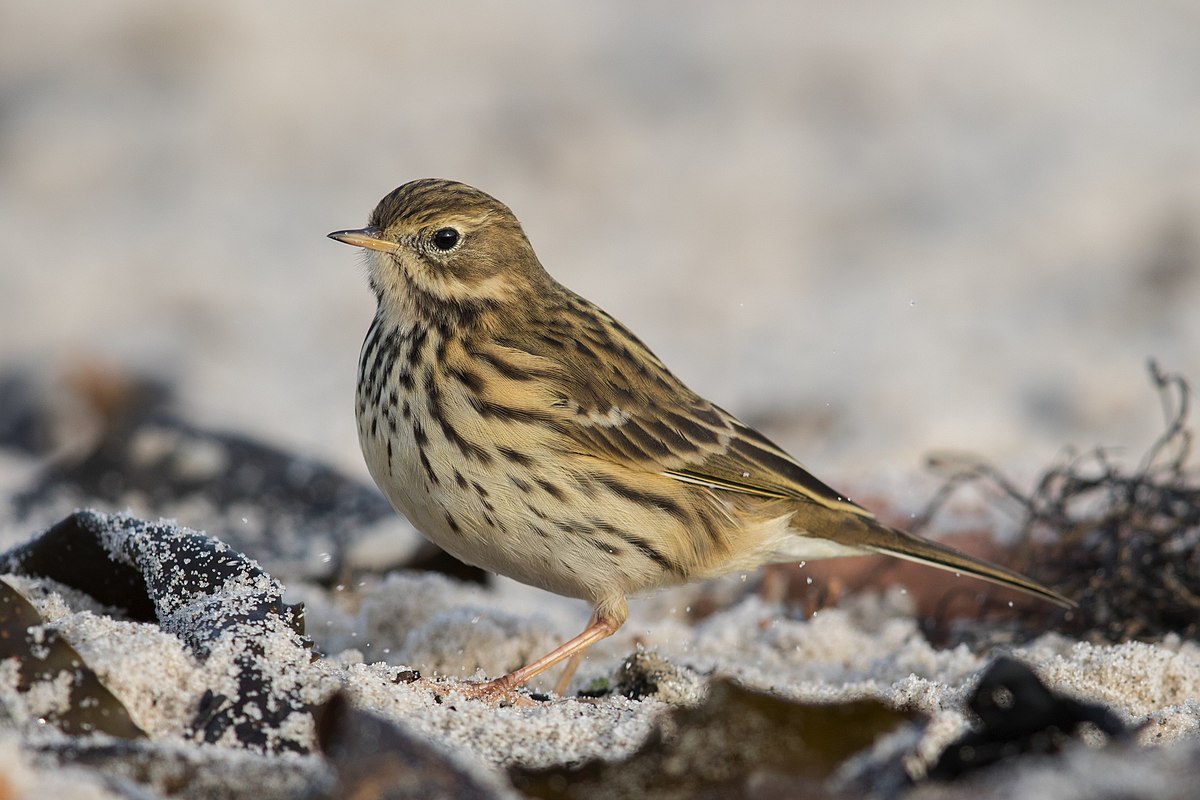
Wikipedia: Meadow pipit Source: OTHER
1200px-Wiesenpieper_Meadow_pipit.jpg
First observed in 🇨🇭 on 2021-06-27.
Looks like Misteldrossel
Song: ![]() Ähnlich Baumpieper, aber ohne Zia-Rufe. Vollständiger Gesang nur in flatterndem Singflug. Lange Strophen. Mittelstück meist zart und hoch [Link]
Ähnlich Baumpieper, aber ohne Zia-Rufe. Vollständiger Gesang nur in flatterndem Singflug. Lange Strophen. Mittelstück meist zart und hoch [Link]
![]() Song very similar to Rock Pipit, but tone less full and more brittle. Lacks Rock Pipit's closing trill, and beginning is less "hammering". [Link]
Song very similar to Rock Pipit, but tone less full and more brittle. Lacks Rock Pipit's closing trill, and beginning is less "hammering". [Link]
Calls: ![]() fast tonlos „ist, ist.“
[Link]
fast tonlos „ist, ist.“
[Link]
![]() Contact call a short "eest". Similar to Rock Pipit but shorter,cleaner and most often in quick series. Warning call a sharp, high pitched "tzeet". Also a rattling "trrrrt". [Link]
Contact call a short "eest". Similar to Rock Pipit but shorter,cleaner and most often in quick series. Warning call a sharp, high pitched "tzeet". Also a rattling "trrrrt". [Link]
Physical details: length=14 cm,
wingspan=22-25 cm,
weight=15-22 g
Habitats:
Mountain
Looks similar to:
Mistle thrush.
Song:
Single note, possibly rising at the end. (Or: long 4 second phrases, gradually louder then softer; swoopy or whoopy.) Sings in flight. BirdID: Song very similar to Rock Pipit, but tone less full and more brittle. Lacks Rock Pipit's closing trill, and beginning is less "hammering". - but what does a rock pipit sound like?
Song attributes:
Melody: one note, fast, Frequency: medium (1-5 KHz)
♫ Source: XENOCANTO
XC722919 - Meadow Pipit - Anthus pratensis - song.mp3
(song)


Wikipedia: Rock pipit Source: OTHER
1200px-Eurasian_Rock_Pipit%2C_Helgoland_1.jpg
Deutschland: ausnahmsweise Brutvogel, Wintergast
Vocalization: ![]() All sounds very similar to Water Pipit. [Link]
All sounds very similar to Water Pipit. [Link]
Song: ![]() Song very similar to Meadow Pipit but much louder. Starting notes often with masked double accents, giving it a hammering tone. Terminal trill stronger and more pronounced. [Link]
Song very similar to Meadow Pipit but much louder. Starting notes often with masked double accents, giving it a hammering tone. Terminal trill stronger and more pronounced. [Link]
Calls: ![]() Flight call a very sibilant, rippling "weesst", more drawn than in Meadow Pipit. Usually given as clearly separated single calls, but sometimes in quick successions like M. Pipit. Alarm call a sharp "tseet". [Link]
Flight call a very sibilant, rippling "weesst", more drawn than in Meadow Pipit. Usually given as clearly separated single calls, but sometimes in quick successions like M. Pipit. Alarm call a sharp "tseet". [Link]
Physical details: length=16-17 cm,
wingspan=22-28 cm,
weight=20-27 g
Profile Wikipedia eBird Vogelwarte BirdLife ZH ornitho.ch bird-song.ch Audubon AllAboutBirds Xeno-Canto BirdID NABU
White wagtail at edge of field near Mesikon 2020-04-25 07.21.02 Luppmen
First observed in Iceland on 2015-06-05.
This bird appears across the great seas in the following continents:
Europe, North America, Africa, Asia.
General: ![]() The white wagtail (Motacilla alba) is a small passerine bird in the family Motacillidae, which also includes pipits and longclaws. The species breeds in much of Europe and the Asian Palearctic and parts of North Africa. It has a toehold in Alaska as a scarce breeder. It is resident in the mildest parts of its range, but otherwise migrates to Africa. In Ireland and Great Britain, the darker subspecies, the pied wagtail or water wagtail[2] (M. a. yarrellii) predominates. In total, there are between 9 and 11 subspecies.
[more]
The white wagtail (Motacilla alba) is a small passerine bird in the family Motacillidae, which also includes pipits and longclaws. The species breeds in much of Europe and the Asian Palearctic and parts of North Africa. It has a toehold in Alaska as a scarce breeder. It is resident in the mildest parts of its range, but otherwise migrates to Africa. In Ireland and Great Britain, the darker subspecies, the pied wagtail or water wagtail[2] (M. a. yarrellii) predominates. In total, there are between 9 and 11 subspecies.
[more]
Song: ![]() Song either slow and primitive, consisting of sharp falling notes given by perched birds, or longer fast and energic bursts in excited song-flight. [Link]
Song either slow and primitive, consisting of sharp falling notes given by perched birds, or longer fast and energic bursts in excited song-flight. [Link]
Calls: ![]() Contact calls short and sharp. Usually with disyllabic, "bouncing" quality, and with each syllable only accented, not clearly separated from the other (see Grey Wagtail). [Link]
Contact calls short and sharp. Usually with disyllabic, "bouncing" quality, and with each syllable only accented, not clearly separated from the other (see Grey Wagtail). [Link]
Physical details: length=18 cm,
wingspan=25-30 cm,
weight=17-25 g
Habitats:
Settlement
Song:
General: Usually just calls. This song is just a few chirpy slurs, sometimes rising-rising-falling.
Song: ![]() Zirpt wie ein Sperling aber weniger Noten. Lh lh lh [Link]
Zirpt wie ein Sperling aber weniger Noten. Lh lh lh [Link]
Song attributes:
Melody: stereotype melodic, slow, Frequency: 2-7 KHz
♫ Source: XENOCANTO
XC694995 - White Wagtail - Motacilla alba - song recorded in Spain.mp3
Spain (song)

Call:
bird-song.ch: zweisilbig «zilipp» oder einsilbig «zipp»
♫ Source: XENOCANTO
XC644775 - White Wagtail - Motacilla alba alba - call, recorded in Estonia.mp3
(call)

Call attributes:
Call melody: one note, slow, Frequency: 3-7 KHz,
Gebirgsstelze am Wissbach. 2024-04-27 09.16.16 Schachen, Tobel Wissbach till Degersheim
First observed in 🇨🇭 on 2022-02-05.
Yellow breast and butt end, white belly, light grey head and back, white eye stripe and stripe above black beard, dark wings with 3 white V's, long tail.
Song: ![]() Song simple but variable. Sometimes with more elaborate song-flight like White Wagtail. [Link]
Song simple but variable. Sometimes with more elaborate song-flight like White Wagtail. [Link]
Calls: ![]() Contact call short, metallic and with a clipped ending. Often disyllabic, "tzeet-tzeet", with each syllable more separated than in White Wagtail, and timbre more "dirty". Often starts with the contact call, followed by short melodic phrases. [Link]
Contact call short, metallic and with a clipped ending. Often disyllabic, "tzeet-tzeet", with each syllable more separated than in White Wagtail, and timbre more "dirty". Often starts with the contact call, followed by short melodic phrases. [Link]
Physical details: length=18-19 cm,
wingspan=25-27 cm,
weight=14-22 g
Habitats:
Wetland
Song:
![]() BirdID says Song simple but variable. I hear trills up to 2 seconds long and chirps. Another description says a series of calls, not very melodic. I noted zwitx3, sometimes hhhhhll. [Link]
BirdID says Song simple but variable. I hear trills up to 2 seconds long and chirps. Another description says a series of calls, not very melodic. I noted zwitx3, sometimes hhhhhll. [Link]
Song attributes:
Melody: stereotype melodic, fast, Frequency: high (3-9 KHz) Special sounds: trill
♫ Source: XENOCANTO
XC767550 - Grey Wagtail - Motacilla cinerea - song with trills and a cheek-cheek.mp3
(song)

♫ Source: XENOCANTO
XC757193 - Grey Wagtail - Motacilla cinerea - one-note song recorded in Germany.mp3
Germany (song)

Great tit / Kohlmeise (Parus major)
Profile Wikipedia eBird Vogelwarte BirdLife ZH ornitho.ch bird-song.ch Xeno-Canto BirdID NABU
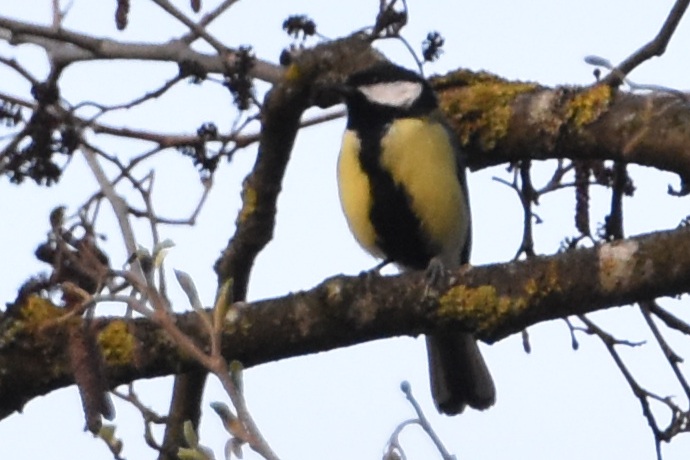
Kohlmeise auf ast. 2020-04-13 10.29.27 Luppmen
First observed in 🇨🇭 on 2019-04-22.
Most common year-round bird at our house.
Often seen at the suet balls we hang out, or in fall at our sunflowers.
It's said that they will sound a false alarm at a feeding source, knowing that other birds listen for
their alarms and flee!
There are many entertaining stories in the Norwegian book 'The Secret Life of Small Birds'.
It's a favorite food of the Eurasian sparrowhawk, though I'm sure cats are the greater danger.
They flit from tree to tree in small scattered groups,
and often avail themselves of the seeds on our sunflowers. They can be heard on the Luppman
in Fehraltorf at any time of year and day.
Etymology: ![]() (Conrad) Gessner also notes that the coal tit was known as Kohlmeiß in German – the literal equivalent of its English name, though in its modern orthography Kohlmeise it refers to the great tit (Parus major). That bird was in Gessner's day usually called Spiegelmeiß ("multicoloured tit"[5]), Brandtmeiß ("burnt tit") or grosse Meiß ("great tit") in German. [Link]
(Conrad) Gessner also notes that the coal tit was known as Kohlmeiß in German – the literal equivalent of its English name, though in its modern orthography Kohlmeise it refers to the great tit (Parus major). That bird was in Gessner's day usually called Spiegelmeiß ("multicoloured tit"[5]), Brandtmeiß ("burnt tit") or grosse Meiß ("great tit") in German. [Link]
Behavior: ![]() 'Studies in Europe on tits showed a 2-way doubly asymmetric interaction: the great tit (Parus major) is dominant over the blue tit (Cyanistes caeruleus)
during the nonbreeding season (Haftorn 1993), and the smaller blue tit is competitively dominant during the breeding season (Dhondt 1989).'
Another cited work notes that the coal tit is considered the bottom of the hierarchy in Scandinavia. [Interspecific dominance relationships and hybridization between black-capped and mountain chickadees | Behavioral Ecology]
'Studies in Europe on tits showed a 2-way doubly asymmetric interaction: the great tit (Parus major) is dominant over the blue tit (Cyanistes caeruleus)
during the nonbreeding season (Haftorn 1993), and the smaller blue tit is competitively dominant during the breeding season (Dhondt 1989).'
Another cited work notes that the coal tit is considered the bottom of the hierarchy in Scandinavia. [Interspecific dominance relationships and hybridization between black-capped and mountain chickadees | Behavioral Ecology]
![]() Like all tits it is a cavity nester, usually nesting in a hole in a tree. [Link]
Like all tits it is a cavity nester, usually nesting in a hole in a tree. [Link]
![]() Sie lernen voneinander und sogar von den verwandten Blaumeisen und finden neue Nahrungsquellen. Aber sie merken es sich auch, wenn sie sehen das andere Vögel etwas fressen, was ihnen nicht zukömmlich ist. [Schlaue Kohlmeisen gucken voneinander ab]
Sie lernen voneinander und sogar von den verwandten Blaumeisen und finden neue Nahrungsquellen. Aber sie merken es sich auch, wenn sie sehen das andere Vögel etwas fressen, was ihnen nicht zukömmlich ist. [Schlaue Kohlmeisen gucken voneinander ab]
Song: Nabu: Die erste Vogelart, die wir im Jahr hören, ist meistens die Kohlmeise mit ihrem typischen Läuten: "Zip Zäh" oder "Zip zip Zäh". [NABU Experte Lars Lachmann bei Deutschlandfunk Nova]
![]() Song highly variable, but usually consisting of two to three notes repeated in a motif. Same birds have many different motifs but generally repeat them many times before switching. Identified by its timbre and often metallic resonant quality, more than by actual phrasing (which is very variable). Often includes buzzing sounds in song. [Link]
Song highly variable, but usually consisting of two to three notes repeated in a motif. Same birds have many different motifs but generally repeat them many times before switching. Identified by its timbre and often metallic resonant quality, more than by actual phrasing (which is very variable). Often includes buzzing sounds in song. [Link]
Calls: ![]() Generally more full-bodied and resonant calls than blue tit, and not so high-pitched. Characteristic Chaffinch-like "tink tink tink" often uttered by male. [Link]
Generally more full-bodied and resonant calls than blue tit, and not so high-pitched. Characteristic Chaffinch-like "tink tink tink" often uttered by male. [Link]
Physical details: length=14 cm,
wingspan=22-25 cm,
weight=14-22 g
Habitats:
Settlement
Song:
Said to have a repertoire as a species of 50 or more different songs, albeit simple ones, up to 10 per individual.
Females prefer a male with a large repertoire. One two-note song sounds like a squeaky bed.
Song attributes:
Melody: simple rhythmic (hmhmlmlmhmh), slow, Frequency: medium (1-5 KHz) Singing season: 01-01 - 06-30 Dawn chorus start, 30 minutes before dawn.
♫ Ungewöhnlicher kohlmeise gesang hmhmlmlmhmh, approximately notes GCGCgCgCGCG. 2024-05-02 15.36.26 Fehraltorf (song)
♫ Source: BirdNet
20200930_170429 birdnet 960 lhm glide saw great tit - Great tit - Fehraltorf.mp3
2020-09-30 17.04.29 Fehraltorf (song)
♫ Kohlmeise llh, Gartenbaumläufer 5-noter zb at 22, 33, to id at 47 evtl sdrossel. ![]() Source: Zoom H6 2024-03-22 06.43.22 Staldenweiher (song)
Source: Zoom H6 2024-03-22 06.43.22 Staldenweiher (song)
♫ Kohlmeise lh 2-noter. ![]() Source: Zoom H6 2024-03-22 06.46.48 Staldenweiher (song)
Source: Zoom H6 2024-03-22 06.46.48 Staldenweiher (song)
♫ Source: BirdNet
20201030_072023 birdnet 1055 hlll - Great tit - Fehraltorf.mp3
2020-10-30 07.20.23 Fehraltorf (song)
♫ Source: BirdNet
20200603_091437 birdnet 577 lmh kohlmeise - Great tit.mp3
2020-06-03 09.14.37 Hungerseeli (song)
♫ 2024-04-27 09 40 kohlmeise mlh mlh etwa 5,5, 4,0, 7.5 MHz. 2024-04-27 09.40.00 Schachen, Tobel Wissbach till Degersheim (song)
♫ Source: BirdNet
20201031_093140 birdnet 1067 lhlh wild guess great tit - No confident detection - Fehraltorf.mp3
2020-10-31 09.31.40 Fehraltorf (song)
Call:
Chuck-a-chuck-a-chuck, sometimes preceded by higher 'wheat!'
Call from Xeno-Canto
♫ Call from Xeno-Canto Illustrates higher 'wheat' before the 'chuck-a-chuck' Source: XENOCANTO
XC586723 great tit call wheat chuck-a-chuck.mp3
(call)
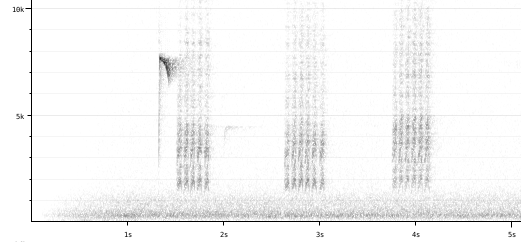 Call from Xeno-Canto
Call from Xeno-Canto
♫ Call from Xeno-Canto Source: XENOCANTO
XC592152 great tit call.mp3
(call)

Call attributes:
Call melody: simple rhythmic, fast, Frequency: 1-7 KHz,
Eurasian blue tit / Blaumeise (Cyanistes caeruleus)
Erste Blaumeise aufgenommen in Fehraltorf Ich hatte sie lange gehoert aber als Kohlmeise miserkannt (es ist oft aehnlich und ich war Anfaenger. Dann habe ich diesen auf einem Baum gesehen, und es wurde klar, dass sie wirklich auch bei uns leben. 2020-04-15 19.12.31 Luppmen
First observed in 🇨🇭 on 2020-04-13.
Ich habe das erste mal eine Blaumeise bei uns daheim erkannt in April 2020, eine junge erst Juni 2020, und den Unterschied zwischen Jugendkleid und Schlicht/Prachtkleid erst in Juli 2021 kennengelertn.
In How to be a Bad Birdwatcher, Simon Barnes nicely explains hierarchies in feeding groups and how niches prevent blue tits from being starved by the larger, more dominant great tits. Normally they forage differently, he says, and at feeders it's simply clear to both that the great tit goes first. However in May 2021, we watched a blue tit repeatedly chase off a great tit that landed at the feeder where he was already enjoying some sunflower seeds! There are always exceptions to the rules!
Song: ![]() Song: Characteristic, clear, high-pitched, vibrating call. Usually introduced by a couple of accenting syllables, followed by ringing vibrating notes: "ti ti chuhuhuhuhuhuhuhuhuhu". [Link]
Song: Characteristic, clear, high-pitched, vibrating call. Usually introduced by a couple of accenting syllables, followed by ringing vibrating notes: "ti ti chuhuhuhuhuhuhuhuhuhu". [Link]
Calls: ![]() Scolding alarm call: "tee-tee-tee-chirruwitt" similar to Great Tit. [Link]
Scolding alarm call: "tee-tee-tee-chirruwitt" similar to Great Tit. [Link]
Physical details: length=11 cm,
wingspan=17-20 cm,
weight=9-12 g
Habitats:
Settlement
Social groups can include up to 12 members.
Can appear in social groups with other species: Great tit.
Song:
General: High-pitched, often descending (hhll), occasionally ascending. "Christina compares it to a ping-pong ball dropping.
[In Januar singt die Kohlmeise als erster Vogel in Deutschland], dann kommt die Blaumeise dazu.
Song attributes:
Melody: simple rhythmic, slow, Frequency: 3-9 KHz Special sounds: trill Singing season: 01-01 - 06-30 Dawn chorus start, 35 minutes before dawn.
Call:
Low-high-high, with lightly raspy start, rather high.
Call attributes:
Call melody: simple rhythmic, slow, Frequency: high (3-9 KHz),
Coal tit / Tannenmeise (Periparus ater)
Coal tit in Wikipedia. Source: WIKIPEDIA
Coal tit in Wikipedia.JPG
First observed in 🇨🇭 on 2020-04-18.
Periparus ater at Xeno-Canto - a small classification fight
Etymology: ![]() The German Wikipedia page says 'ater' from the genus 'Periparus ater' is Latin for 'düster' meaning dark or even gloomy. [Link]
The German Wikipedia page says 'ater' from the genus 'Periparus ater' is Latin for 'düster' meaning dark or even gloomy. [Link]
![]() In German the name means fir tit - so obviously found in woods with many firs [Link]
In German the name means fir tit - so obviously found in woods with many firs [Link]
Appearance and identification: Nabu: Mit ihrem schwarzen Kopf und den weißen Wangen erinnert sie an eine kleine Kohlmeise, jedoch ist die Unterseite der Tannenmeise eher beige statt gelb, und ihr fehlt der dunkle Längsstreifen an der Unterseite. [Link]
Song: ![]() Song: Various repeated motifs, consisting of two to three notes with alternating accents. Slightly similar to Great Tit, but faster, not so metallic and with a less full tone. Can be mistaken for Marsh Tit when singing single or double notes, but tone is softer and notes more clearly separated (if disyllabic). [Link]
Song: Various repeated motifs, consisting of two to three notes with alternating accents. Slightly similar to Great Tit, but faster, not so metallic and with a less full tone. Can be mistaken for Marsh Tit when singing single or double notes, but tone is softer and notes more clearly separated (if disyllabic). [Link]
Calls: ![]() Call: short soft and clear "piu", first rapidly rising and then falling in pitch. [Link]
Call: short soft and clear "piu", first rapidly rising and then falling in pitch. [Link]
Physical details: length=11 cm,
wingspan=17-21 cm,
weight=8-10 g
Habitats:
Forest
Song:
Higher-pitched than great tit,
with more slurs instead of pure notes.
Usually 2 or 3 notes in varied order.
To me it seems they have a repertoire of songs, like their 'big brothers', the great tits.
Song attributes:
Melody: simple rhythmic (lmhlmhlmh), fast, Frequency: 3-9 KHz Special sounds: slur
♫ Tannenmeise lmhlmhlmh plus kettensäge. 2020-12-14 11.41.25 Luppmen (song)
♫ Tannenmeise lmh, Buntspecht, Aaskraehe, Kohlmeise, weiter weg ein Amsel. ![]() Source: Zoom H6 2023-02-23 17.17.08 (song)
Source: Zoom H6 2023-02-23 17.17.08 (song)
Call:
Analyze stuff at XC vs my BirdNet 962 - several notes, not sure if all coal tit as BirdNet suggested. XC has two-note high-low alarm call but simple song-like calls too
Call attributes:
Call melody: simple rhythmic, slow, Frequency: high (3-9 KHz),
Common starling / Star (Sturnus vulgaris)
Im richtigen Licht schimmern die Federn. 2020-04-11 07.54.52 Luppmen
First observed in 🇨🇭 on 2020-04-11.
This bird appears across the great seas in the following continents:
Europe, North America (introduced), Africa.
Learned on BBC's Winterwatch: the movement of a swarm of starlings is called a murmuration! Check out this this video or even an entire half hour
In trees or in the fields by the cows.
Frequently seen here, for instance by their nests under the eaves of one of the Toblerone houses.
Introduced to North America from Europe by Eugene Schieffelin.
Eine der Vogelarten, die gleichzeitig zwei Töne singen kann!
Vocalization: ![]() Among the best of imitators. Mimics birds, animals and mechanical noises. Often makes several sounds at the same time. [Link]
Among the best of imitators. Mimics birds, animals and mechanical noises. Often makes several sounds at the same time. [Link]
Song: ![]() Song a highly varied mix of falling whistles, bill-clappering and various masterful mimicry. [Link]
Song a highly varied mix of falling whistles, bill-clappering and various masterful mimicry. [Link]
Calls: ![]() Other calls; a harsh "chaee" and a short sharp "tink". [Link]
Other calls; a harsh "chaee" and a short sharp "tink". [Link]
Physical details: length=21 cm,
wingspan=37-42 cm,
weight=60-90 g
Habitats:
Agricultural
Song:
I find their individual song amusing, with its (long) whoops and weird noises.
As a group, they're just noisy!
Song attributes:
Melody: improvised melodic, slow, Frequency: medium (1-5 KHz) Special sounds: whoop, mimicry, weird Singing season: 01-01 - 09-30 Dawn chorus start, 15 minutes before dawn.
Call:
I hear this occasionally and really enjoy it - a long rising 'whoop', as I call it', starting low at 1 1/2 KHz and rising to 6 1/2 KHz!
♫ Source: BirdNet
20210823_172609 birdnet 1968 - European Starling long whoop call - 2021-08-23 17:26:09 - European Starling - Fehraltorf.mp3
2021-08-23 17.26.09 Fehraltorf (call)
Call attributes:
Call melody: one note, slow, Frequency: 1-6 KHz, Special sounds: whoop.
Song thrush / Singdrossel (Turdus philomelos)
Profile Wikipedia eBird Vogelwarte BirdLife ZH ornitho.ch bird-song.ch Xeno-Canto BirdID NABU
Singdrossel Isle de Brehat, Brittany. 2019-06-16 15.35.33 Île-de-Bréhat
First observed in Brittany on 2019-06-16.
General: ![]() The song thrush (Turdus philomelos) is a thrush that breeds across the West Palearctic. It has brown upper-parts and black-spotted cream or buff underparts and has three recognised subspecies. Its distinctive song, which has repeated musical phrases, has frequently been referred to in poetry.
[more]
The song thrush (Turdus philomelos) is a thrush that breeds across the West Palearctic. It has brown upper-parts and black-spotted cream or buff underparts and has three recognised subspecies. Its distinctive song, which has repeated musical phrases, has frequently been referred to in poetry.
[more]
Vocalization: ![]() Very melodious, varied and a master imitator. Still easily distinguished by its tendency to repeat introductory motives two or more times, and its many high pitched themes. Each phrase is loud and penetrating and the tempo deliberate. [Link]
Very melodious, varied and a master imitator. Still easily distinguished by its tendency to repeat introductory motives two or more times, and its many high pitched themes. Each phrase is loud and penetrating and the tempo deliberate. [Link]
Song: ![]() Klangfarbe ähnlich obiger Art [Amsel], aber jedes Element 2-4mal wiederholt, Pausen zwischen den Phrasen.(klingt oft wie „Philipp“, oder „Judith“) Einzige Drossel unseres Gebietes die diese Wiederholungen macht. Singt oft nicht von Baumspitze aus, sondern aus dem Geäst.
[Link]
Klangfarbe ähnlich obiger Art [Amsel], aber jedes Element 2-4mal wiederholt, Pausen zwischen den Phrasen.(klingt oft wie „Philipp“, oder „Judith“) Einzige Drossel unseres Gebietes die diese Wiederholungen macht. Singt oft nicht von Baumspitze aus, sondern aus dem Geäst.
[Link]
Calls: ![]() Rufe :“zipp“, oft beim abfliegen.
[Link]
Rufe :“zipp“, oft beim abfliegen.
[Link]
![]() Most heard (but easily overlooked) contact call is a dry and very short "zip", sometimes given as a two syllable call "zip-ip". [Link]
Most heard (but easily overlooked) contact call is a dry and very short "zip", sometimes given as a two syllable call "zip-ip". [Link]
Physical details: length=23 cm,
wingspan=33-36 cm,
weight=65-100 g
Habitats:
Forest
Song:
Paced like a blackbird, humorous mix of elements like a nightingale. Huge range, elements from 2-5 KHz, others 6.5-9 KHz. Can sing for up to 50 minutes, and a male may know 100 melodies in its repertoire.
Song attributes:
Melody: improvised melodic, slow, Frequency: 2-9 KHz Special sounds: swoop Singing season: 02-01 - 07-31 Dawn chorus start, 60 minutes before dawn.
Call:
One or two high chirps followed by long pause of 1-2 seconds
Call attributes:
contact call Call melody: one note, slow, Frequency: 7-10 KHz,
Mistle thrush / Misteldrossel (Turdus viscivorus)
Profile Wikipedia eBird Vogelwarte BirdLife ZH ornitho.ch bird-song.ch Xeno-Canto BirdID NABU
Misteldrossel. 2020-05-07 12.56.02 Hungerseeli
First observed in 🇨🇭 on 2020-05-07.
After a long outing in the woods with no 'new' discoveries where I hoped there might be,
I followed a woodpecker-like rattle deep into the woods,
and eventually managed a clear view of a mistle thrush (German Misteldrossel)
while standing directly under the tree where I heard it.
I believe it was a pair, but I only got a picture of one.
The breast has that checkerboard look that thrushes have.
I initially saw them in the woods but later by Neschwil they came
out of the woods into the fields to feed.
Song: ![]() Gesang ähnlich dem der Amsel, aber weniger abwechslungsreich und melancholisch, fast weinerlich klingend. Meist von Tannenspitze aus.
[Link]
Gesang ähnlich dem der Amsel, aber weniger abwechslungsreich und melancholisch, fast weinerlich klingend. Meist von Tannenspitze aus.
[Link]
![]() Song loud, far reaching and melodic. Most similar to Blackbird, but pitch is higher, phrases shorter (3-6 notes) and most notably, pauses between phrases are much shorter. All which gives the song a much more hurried feel than that of the Blackbird. Timbre is thinner and slightly shivering, and tonal range more limited. May have recurring favourite motifs, but does not repeat phrases like Song Thrush. Sometimes adds higher pitched parts and imitations. [Link]
Song loud, far reaching and melodic. Most similar to Blackbird, but pitch is higher, phrases shorter (3-6 notes) and most notably, pauses between phrases are much shorter. All which gives the song a much more hurried feel than that of the Blackbird. Timbre is thinner and slightly shivering, and tonal range more limited. May have recurring favourite motifs, but does not repeat phrases like Song Thrush. Sometimes adds higher pitched parts and imitations. [Link]
Calls: ![]() Rufe:schnarrend „kerr“, daneben „tück-tück-tück“
[Link]
Rufe:schnarrend „kerr“, daneben „tück-tück-tück“
[Link]
![]() Other calls; a dry rattle, likened to the sound of a piece of wood drawn over a coarse comb, and a Fieldfare-like "chuck". [Link]
Other calls; a dry rattle, likened to the sound of a piece of wood drawn over a coarse comb, and a Fieldfare-like "chuck". [Link]
Physical details: length=27 cm,
wingspan=42-47 cm,
weight=100-150 g
Habitats:
Forest
Looks similar to:
Meadow pipit.
Song:
Song: ![]() Gesang ähnlich Amsel, aber eintöniger mit geringerem Tonumfang [auch kürzer, kein schnirpsliges Ende -- Bill] [Link]
Gesang ähnlich Amsel, aber eintöniger mit geringerem Tonumfang [auch kürzer, kein schnirpsliges Ende -- Bill] [Link]
Song attributes:
Melody: non-musical, fast, Frequency: 2-9 KHz Special sounds: rattle
Call:
General: I mistook this one for a woodpecker the first time I heard it,
partly because BirdNet also did!
Rattle generated in vocal tract, not with the beak!
Call attributes:
Call melody: non-musical, fast, Frequency: 2-9 KHz, Special sounds: rattle.
Redwing / Rotdrossel (Turdus iliacus)
Profile Wikipedia eBird Vogelwarte BirdLife ZH ornitho.ch bird-song.ch Xeno-Canto BirdID NABU
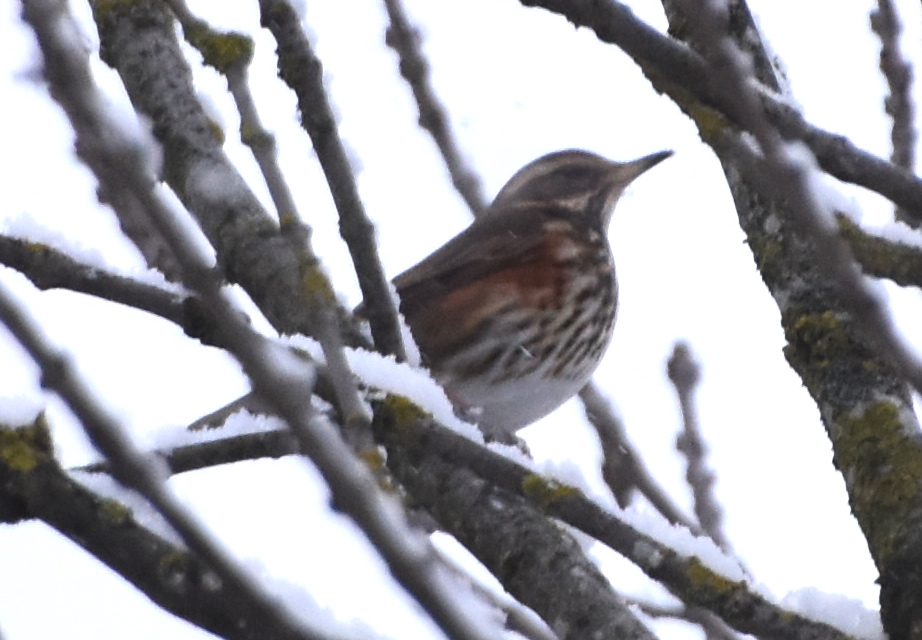
Rotdrossel in einem baum neben dem Luppmen, rot unter den Fluegeln gut erkennbar, auch weisser Ueberaugenstreif. 2020-12-30 10.33.36 Luppmen
First observed in Iceland on 2015-06-05.
In Switzerland these are migrants or winter guests that breed in Scandinavia.
I saw a group that landed in a tree by the Luppmen.
Some sang an odd song that I didn't recognize but unfortunately couldn't record.
They were rather nervous and quickly flew off.
I had an interesting educational experience with fieldfares!
At the end of December 2020 I saw redwings in Fehraltorf for the first time.
They're a winter guest that breeds in Scandinavia.
Jan 2021 I saw one from our dining room window, and two days later
saw 31 of them land in four trees along the Luppmen brook,
and spontaneously decided to report them via the eBird app.
The next day I got an automated response saying this was an unusually high number,
and that I should document the sighting further. I added pictures of the group in the trees
pus one of an individual close up. Then I got a nice e-mail from eBird volunteer Raphaël Nussbaumer,
an Earth Science PhD and postdoc at the Swiss Ornithological Institute, saying that my redwings were fieldfares.
I checked the guide books and apps, and that seemed plausible. I was surprised that none of them mentioned the danger
of confusing the two, which are actually quite similar (and related). I checked the closeup I took on December 31
and asked Raphaël if it was actually a redwing, and he confirmed it. So I actually found two (to me) new thrushes
within 3 weeks. He noted 'they are often found mixed with fieldfare or mistle thrush, so one has to be careful to check the entire group and not assume that all are redwings.
I saw 8 similar looking birds when I saw the actual redwing, and while I think there's more than one redwing there,
I can't see the whole flock well enough to be sure.
Appearance and identification: ![]() Vogelwarte.ch describes just what I saw. In translation, somewhat smaller than a song thrush and distinguishable from them by the prominent white stripe above the eye and the rust-red feathers under the wings. [Link]
Vogelwarte.ch describes just what I saw. In translation, somewhat smaller than a song thrush and distinguishable from them by the prominent white stripe above the eye and the rust-red feathers under the wings. [Link]
Vocalization: ![]() First a simple, melodic phrase of 3 - 6 notes, usually followed by a more silent, indistinct, fast and less melodic, chattering sequence. First part highly variable from place to place, but constant in individuals. Often causes confusion when a new dialect is heard at a distance, since only the first part is far-reaching, and the diagnostic two-part structure gets lost. [Link]
First a simple, melodic phrase of 3 - 6 notes, usually followed by a more silent, indistinct, fast and less melodic, chattering sequence. First part highly variable from place to place, but constant in individuals. Often causes confusion when a new dialect is heard at a distance, since only the first part is far-reaching, and the diagnostic two-part structure gets lost. [Link]
Song: ![]() Song delivered in two parts. [Link]
Song delivered in two parts. [Link]
Calls: ![]() Contact call a thin, drawn and sharp "sreee". Often heard at night during migration. Alarm call harder, dryer and more raucous than other thrushes. [Link]
Contact call a thin, drawn and sharp "sreee". Often heard at night during migration. Alarm call harder, dryer and more raucous than other thrushes. [Link]
Physical details: length=21 cm,
wingspan=33-34 cm,
weight=50-75 g
Habitats:
Forest
Song:
![]() Song delivered in two parts. First a simple, melodic phrase of 3 - 6 notes, usually followed by a more silent, indistinct, fast and less melodic, chattering sequence. First part highly variable from place to place, but constant in individuals. [Link]
Song delivered in two parts. First a simple, melodic phrase of 3 - 6 notes, usually followed by a more silent, indistinct, fast and less melodic, chattering sequence. First part highly variable from place to place, but constant in individuals. [Link]
Song attributes:
Mnemnoic: down 6+chattering Melody: stereotype melodic, slow, Frequency: 3-5 KHz
♫ Source: XENOCANTO
XC320315 - Redwing - Turdus iliacus.mp3
(song)

Fieldfare / Wacholderdrossel (Turdus pilaris)
Profile Wikipedia eBird Vogelwarte BirdLife ZH ornitho.ch bird-song.ch Xeno-Canto BirdID NABU
Wacholderdrossel am Luppmen in Fehraltorf 2021-01-16 14.28.10
First observed in 🇨🇭 on 2021-01-16.
I had an interesting educational experience with fieldfares!
Check it out under Redwing.
Appearance and identification: ![]() The fieldfare is 25 cm (10 in) long, with a grey crown, neck and rump, a plain brown back, dark wings and tail and white underwings. [Link]
The fieldfare is 25 cm (10 in) long, with a grey crown, neck and rump, a plain brown back, dark wings and tail and white underwings. [Link]
Geography: Nabu: 'Die ursprüngliche Heimat dieser nordischen Drossel ist die Sibirische Taiga.
Vor etwa 200 Jahren begann ihre Ausbreitung in den südwestlichen Raum Europas.'Wie der Misteldrossel vertreibt der Wacholderdrossel Feinde wie Elster, Rabenkrähe oder Bussard
vom Nestgebiet mit Kotbomben. ['Die Wacholderdrossel - Turdus pilaris
Ein Wintergast wird heimisch', von Paul Laakmann aus Buntspecht 3/1986]
Behavior: ![]() Misteldrossel greifen Vögel an die ihr Nest bedrohen koennten.
Das nennt man eine Kopropolemische Reaktion - vom griechischen für Kot under Krieg.
Mester meint Hauptziel der Angriffe waere meistens der Kopf.
Woanders wurde erwahnt, dass der Kot der Misteldrosseln besonders klebrig ist,
eben weil der Vogel viele Mistelbeeren frisst, und wenn die Feder zusammenkleben,
koennt das Opfer nicht optimal fliegen. [Artikel 'Defensive Defaekation in der Vogelwelt' von Horst Mester, erschienen Oktober 1976 in 'Der Ornithologische Beobachter']
Misteldrossel greifen Vögel an die ihr Nest bedrohen koennten.
Das nennt man eine Kopropolemische Reaktion - vom griechischen für Kot under Krieg.
Mester meint Hauptziel der Angriffe waere meistens der Kopf.
Woanders wurde erwahnt, dass der Kot der Misteldrosseln besonders klebrig ist,
eben weil der Vogel viele Mistelbeeren frisst, und wenn die Feder zusammenkleben,
koennt das Opfer nicht optimal fliegen. [Artikel 'Defensive Defaekation in der Vogelwelt' von Horst Mester, erschienen Oktober 1976 in 'Der Ornithologische Beobachter']
Vocalization: ![]() Very vocal. [Link]
Very vocal. [Link]
Song: ![]() Gesang nicht melodisch,aus gepressten, quietschenden Tönen bestehend, fast nur im Flug vorgetragen.
[Link]
Gesang nicht melodisch,aus gepressten, quietschenden Tönen bestehend, fast nur im Flug vorgetragen.
[Link]
![]() Song a mix of dry contact calls; "trrrt trrrrt", and high pitched, drawn out, chattering improvisations. [Link]
Song a mix of dry contact calls; "trrrt trrrrt", and high pitched, drawn out, chattering improvisations. [Link]
Calls: ![]() Schackernd, ähnlich obiger Art [Misteldrossel], aber weicher. Am Brutplatz raue krächzende Rufe.
[Link]
Schackernd, ähnlich obiger Art [Misteldrossel], aber weicher. Am Brutplatz raue krächzende Rufe.
[Link]
![]() Scolding call a hard "check", often given in decelerating series. Contact call in migration a soft, pleasant but, buzzy "weet". Typically bursts into continuos, squeaky chattering at takeoff. [Link]
Scolding call a hard "check", often given in decelerating series. Contact call in migration a soft, pleasant but, buzzy "weet". Typically bursts into continuos, squeaky chattering at takeoff. [Link]
Physical details: length=25 cm,
wingspan=39-42 cm,
weight=80-120 g
Habitats:
Forest
Song:
BirdID says song a mix of dry contact calls, BirdLife that it's almost only heard in flight. The XC recording is a bit of a chuckle to me.
Song attributes:
Melody: non-musical, slow, Frequency: 1-6 KHz Special sounds: rasp
♫ Source: XENOCANTO
XC769296 - Fieldfare - Turdus pilaris - song, a series of contactcalls.mp3
(song)

Common blackbird / Amsel (Turdus merula)

Amsel bei friedliweid. 2020-04-13 10.28.42 Friedliweid
First observed in Australia on 2008-01-01.
The first bird I loved listening to
Song: ![]() Melodisch flötend dazwischen auch zerquetschte Töne. Die Elemente werden nicht wiederholt. Singt von Singwarte aus. Ca. 100 verschiedene Strophentypen.
[Link]
Melodisch flötend dazwischen auch zerquetschte Töne. Die Elemente werden nicht wiederholt. Singt von Singwarte aus. Ca. 100 verschiedene Strophentypen.
[Link]
![]() One of the most appreciated song birds. Very melodious and resonant, with long mellow notes and a large register. Less high pitched sounds than Song Thrush, and seldom repeats a phrase. Timbre fuller than both Song Thrush and Mistle Thrush. Well defined pauses between phrases, giving the song a relaxed pace. [Link]
One of the most appreciated song birds. Very melodious and resonant, with long mellow notes and a large register. Less high pitched sounds than Song Thrush, and seldom repeats a phrase. Timbre fuller than both Song Thrush and Mistle Thrush. Well defined pauses between phrases, giving the song a relaxed pace. [Link]
Calls: ![]() Je nach Situation, „duck duck duck“, „tix-tix-tix“ in rascher Folge, „srieh“ (auch als Flugwarnruf)
[Link]
Je nach Situation, „duck duck duck“, „tix-tix-tix“ in rascher Folge, „srieh“ (auch als Flugwarnruf)
[Link]
![]() Large repertoire of calls. Most characteristic is a hysterical rattle often given when flushed. Sometimes preceded by a hard "tok tok", which then accelerates into a panicky arpeggio-like crescendo. Contact call a thin redwing-like "srrreee". Alarm calls: a sharp "tink, tink" or a very high pitch falling whistle. [Link]
Large repertoire of calls. Most characteristic is a hysterical rattle often given when flushed. Sometimes preceded by a hard "tok tok", which then accelerates into a panicky arpeggio-like crescendo. Contact call a thin redwing-like "srrreee". Alarm calls: a sharp "tink, tink" or a very high pitch falling whistle. [Link]
Physical details: length=24-25 cm,
wingspan=34-38 cm,
weight=80-125 g
Habitats:
Settlement
Song:
Other: Gut zu erkennen ist die Amsel.
Sie singt melodiös, erklärt Heller, «zuerst flötend und dann gegen Schluss so schnirpslig».
Die Amsel singe gerne dort, wo sie gut gehört werde, etwa vor Hauswänden, die den Schall nicht schlucken.
Ich wollte schauen was schnirpslig heisst, aber diese ist diese einzige Verwendung, die Google kennt!
Der flötende Teil ist relativ tief, 1.5-3 KHz, der schnirpslige aber 2.5-7 KHz.
(Schnirpslig ist ein schones Wort das der Redner erfunden hat - Google findet nur diese eine Webseite mit dem Wort!) [Von der SRF Webseite:]
Song attributes:
Melody: improvised melodic (lmh), slow, Frequency: 1-7 KHz Special sounds: flourish Singing season: 02-01 - 07-31 Dawn chorus start, 45 minutes before dawn.
♫ Repetitiver, einfallsloser Amsel den ich für einen Misteldrossel gehalten habe, dazu eine Kohlemeise der lmh singt und ich mit einer Tannen-meise gewechselt habe. ![]() Source: Zoom H6 2023-02-23 17.40.48 (song)
Source: Zoom H6 2023-02-23 17.40.48 (song)
Call:
Loud falling series of notes, unlike anything else you hear from a blackbird
Call attributes:
alarm call Call melody: simple rhythmic, slow, Frequency: medium (1-5 KHz),
European robin / Rotkehlchen (Erithacus rubecula)
Profile Wikipedia eBird Vogelwarte BirdLife ZH ornitho.ch bird-song.ch Xeno-Canto BirdID NABU
Rotkehlchen. 2020-04-02 09.39.00 Luppmen
First observed in 🇨🇭 on 2020-04-02.
Red face and breast, light colored belly, brown and gray back and wings.
Singing in a tree, searching for food on the ground.
Song: ![]() Song medium to very high pitched, with mostly clear tones with a liquid quality. Timbre reminiscent of Wren or Dunnock, but with a much more varied structure and tempo. Pitch ranges from very high to low, almost thrush-like, notes. No recognizable motifs. Often ends on a rising or falling pitch, giving it a "Chinese" accent. [Link]
Song medium to very high pitched, with mostly clear tones with a liquid quality. Timbre reminiscent of Wren or Dunnock, but with a much more varied structure and tempo. Pitch ranges from very high to low, almost thrush-like, notes. No recognizable motifs. Often ends on a rising or falling pitch, giving it a "Chinese" accent. [Link]
Calls: ![]() Alarm call a thin, electric "tick", often in series with decelerating tempo. [Link]
Alarm call a thin, electric "tick", often in series with decelerating tempo. [Link]
Physical details: length=14 cm,
wingspan=20-22 cm,
weight=14-21 g
Habitats:
Forest
Song:
General: High pitched but also going low, e.g. 2.9-7.7 KHz.
Song: ![]() Only for a short period in late summer while they are moulting and inconspicuous do robins stop singing. Both sexes sing. [RSPB article]
Only for a short period in late summer while they are moulting and inconspicuous do robins stop singing. Both sexes sing. [RSPB article]
Song attributes:
Melody: improvised melodic, fast, Frequency: high (3-9 KHz) Special sounds: fluting Singing season: 02-01 - 07-31 Only pauses singing while molting and thus endangered. Dawn chorus start, 50 minutes before dawn.
Calls:
1:
"ticking call", "tik", "tek", .
Personal: A single note usually repeated twice. Somewhat sputtery. BirdID refers to 'a thin, electric "tick". In one source said to be used as alarm call.
Call: ![]() A variety of calls is also made at any time of year, including a ticking note indicating anxiety or mild alarm. [Link]
A variety of calls is also made at any time of year, including a ticking note indicating anxiety or mild alarm. [Link]
I heard 3 or 4 scattered birds calling it in woods with underbrush but saw no birds. BirdNet told me they were robins, which I found hard to believe, but on comparing it with recordings at XenoCanto, I was convinced! Maybe they were telling each other "Don't show yourself to that alarming guy!".
♫ I heard 3 or 4 scattered birds calling it in woods with underbrush but saw no birds. BirdNet told me they were robins, which I found hard to believe, but on comparing it with recordings at XenoCanto, I was convinced! Maybe they were telling each other "Don't show yourself to that alarming guy!". 2021-07-03 08.05.14 (call)
2:
"srii".
Low chirpy to sputtery monotone
Xeno-Canto recording by Stanislas Wroza noted as 'srii' call
♫ Xeno-Canto recording by Stanislas Wroza noted as 'srii' call Source: XENOCANTO
XC496627 European robin srii call.mp3
(call)
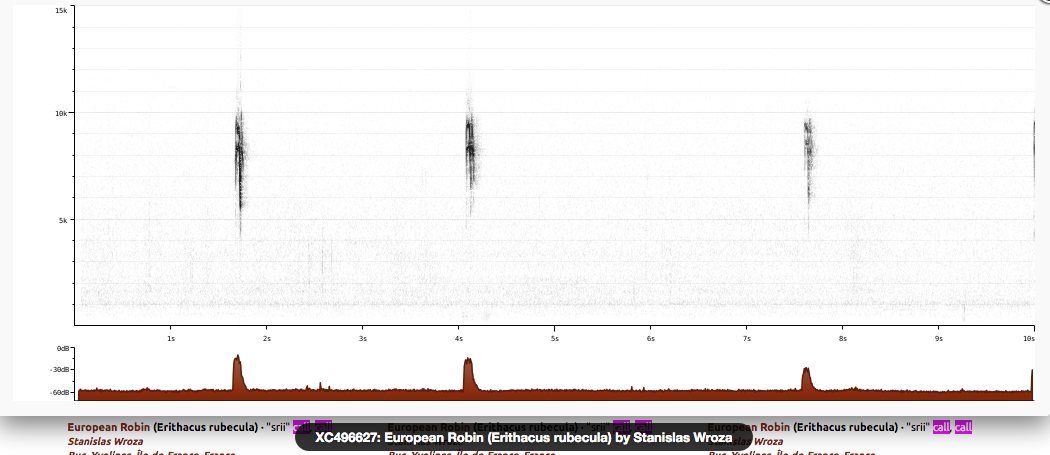
3:
"tsii".
General: A longer falling note (9Khz-7Khz) called a tsii by the recordist.
Call: ![]() Sound Approach: If you listen carefully you may notice that in the daytime, apart from the ubiquitous tik call, Robins also give a shrill tsi rather frequently. It is this tsi that they adapt for use as a nocturnal flight call. Nfc=night flight call. [Link]
Sound Approach: If you listen carefully you may notice that in the daytime, apart from the ubiquitous tik call, Robins also give a shrill tsi rather frequently. It is this tsi that they adapt for use as a nocturnal flight call. Nfc=night flight call. [Link]
In the sonogram it's a longer, falling note.
♫ In the sonogram it's a longer, falling note. Source: XENOCANTO
XC512416 - European Robin - Erithacus rubecula - named tsii or alarm call by recordist Marcin Solowiej in Poland.mp3
(call)
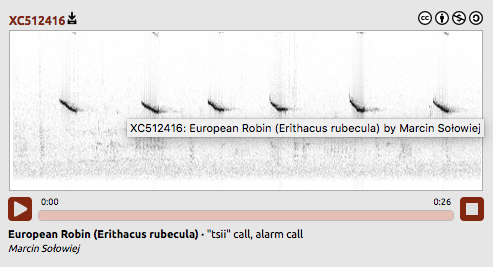
4:
Here is an audio of a high-pitched hawk call (7.5-8.5 KHz). See also a YouTube video comparing ground threats from aerial threats.
♫ Source: XENOCANTO
XC139085 - European Robin - Erithacus rubecula - hawk alarm call from Paul Driver.mp3
(alarm call)
Call attributes:
Call melody: one note, slow, Frequency: 4-9 KHz, Special sounds: sputter/pebble-clatter.
European pied flycatcher / Trauerschnäpper (Ficedula hypoleuca)
Profile Wikipedia eBird Vogelwarte BirdLife ZH ornitho.ch bird-song.ch Xeno-Canto BirdID NABU
Trauerschnaepper. 2021-05-04 09.33.06 Flachsee am Reuss
First observed in 🇨🇭 on 2020-04-15.
Appearance and identification: ![]() Kleiner SW Vogel, Kopf schwarz mit weissem Punkt an der Stirn, Bauch weiss. Gesang gar nicht traurig! [Link]
Kleiner SW Vogel, Kopf schwarz mit weissem Punkt an der Stirn, Bauch weiss. Gesang gar nicht traurig! [Link]
Song: ![]() Song a pleasant, tuneful, simple but varied phrase. [Link]
Song a pleasant, tuneful, simple but varied phrase. [Link]
Calls: ![]() Alarm call a sharp, energetic "wit", often in combination with a short "tic"; "whit-tic". Typically starts with disyllabic notes being repeated 3-5 times, diminishing in pitch and intensity like an echo of the first two syllables. Occasionally throws in a quick diagnostic ascending scale excercise. Clear notes and well defined pauses between phrases. [Link]
Alarm call a sharp, energetic "wit", often in combination with a short "tic"; "whit-tic". Typically starts with disyllabic notes being repeated 3-5 times, diminishing in pitch and intensity like an echo of the first two syllables. Occasionally throws in a quick diagnostic ascending scale excercise. Clear notes and well defined pauses between phrases. [Link]
Physical details: length=13 cm,
wingspan=21-24 cm,
weight=10-15 g
Habitats:
Forest
Song:
Nice short melody, often with 2-note parts. Blackbird-like but little variation (though differs in dialect).
Song attributes:
Mnemnoic: Schwarzer Kopf aber nicht traurig Melody: stereotype melodic, fast, Frequency: 3-10 KHz
♫ Source: XENOCANTO
XC723965 - European Pied Flycatcher - Ficedula hypoleuca - song.mp3
(song)

Spotted flycatcher / Grauschnäpper (Muscicapa striata)
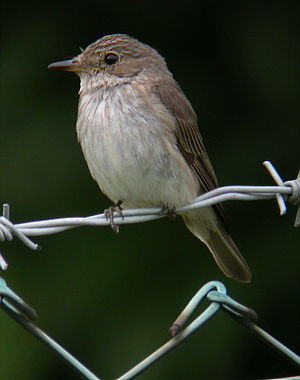
In a pinch barbed wire will do instead of a tree branch. Source: WIKIPEDIA
Wikipedia-300px-SpottedFlycatcheronfence.jpg
First observed in 🇨🇭 on 2020-06-03.
Perches on limbs in forest to swoop for insects and return to perch, specifically heard in woods near Staldenweiher.
Heard in woods near Staldenweiher, seen at Kaltbrunnerriet.
Has streaks on crown and breast, rather than spots.
Medium brown on head and back, light colored belly.
'Pincette-shaped beak'.
Gesang 'unauffaellig' - zirp x 2-3, mal steigender tWIT
Song: ![]() Song a primitive, slow series of various buzzing and very high pitched sounds. No recurring phrases. [Link]
Song a primitive, slow series of various buzzing and very high pitched sounds. No recurring phrases. [Link]
Calls: ![]() The discreet calls often goes unnoticed. Most calls high pitched with a buzzing, "electric" timbre. Alarm call a sharp, drawn "tzreeeee-check", with the second syllable abruptly clipping the sound. [Link]
The discreet calls often goes unnoticed. Most calls high pitched with a buzzing, "electric" timbre. Alarm call a sharp, drawn "tzreeeee-check", with the second syllable abruptly clipping the sound. [Link]
Physical details: length=14 cm,
wingspan=23-25 cm,
weight=14-20 g
Habitats:
Settlement
Song:
High (6-8 KHz?) short sound repeated every half to 5 seconds.
Song attributes:
Melody: simple rhythmic, slow, Frequency: 6-8 KHz
Call:
General: To me something between a one-note and an extremely simple melody, namely med-med chk-hi-med-med, with a very irregular speed, not at all like a metronome.
Call: ![]() Most calls high pitched with a buzzing, "electric" timbre. [Link]
Most calls high pitched with a buzzing, "electric" timbre. [Link]
XC656714 - Spotted Flycatcher - Muscicapa striata - Sounds similar to what I know.
♫ XC656714 - Spotted Flycatcher - Muscicapa striata - Sounds similar to what I know. Source: XENOCANTO
XC656714 - Spotted Flycatcher - Muscicapa striata.mp3
(call)
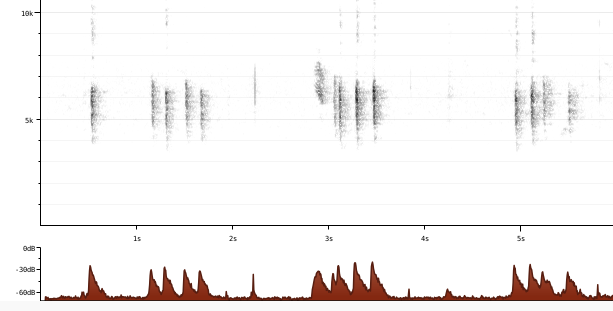
Call attributes:
Call melody: stereotype melodic, slow, Frequency: 4-7 KHz,
Stonechat / Schwarzkehlchen (Saxicola rubicola)
Schwarzkehlchen, Neunkirch. 2023-07-16 10.52.36 Neunkirch, Schaffhausen
First observed in 🇨🇭 on 2021-04-27.
Etymology: Nabu: Der wissenschaftlich Name „rubicola“ bedeutet „Brombeerstrauch-Bewohner“. Einzelne Sträucher auf einer sonst offenen Fläche fliegt das Schwarzkehlchen gerne an.
[Link]
![]() They breed in heathland, coastal dunes and rough grassland with scattered small shrubs and bramble, open gorse, tussocks or heather. [Link]
They breed in heathland, coastal dunes and rough grassland with scattered small shrubs and bramble, open gorse, tussocks or heather. [Link]
Song: ![]() The English name derives from its call, sounding like two stones knocked together. [Link]
The English name derives from its call, sounding like two stones knocked together. [Link]
![]() Gesang ähnlich obiger Art [Braunkehlchen]. Reine und kratzende Laute abwechselnd, wellenförmig
[Link]
Gesang ähnlich obiger Art [Braunkehlchen]. Reine und kratzende Laute abwechselnd, wellenförmig
[Link]
![]() The song is a sweet stream of scratchy notes. Much more even, and less chattering than the Whinchat. Almost like a short and scratchy Dunnock phrase. [Link]
The song is a sweet stream of scratchy notes. Much more even, and less chattering than the Whinchat. Almost like a short and scratchy Dunnock phrase. [Link]
Calls: ![]() hart „track“ oder „fiet-track-track“
[Link]
hart „track“ oder „fiet-track-track“
[Link]
![]() Alarm call an alternation of a high-pitched "weet" and a hard "check", like other chats. The "weet" is much higher pitched than the similar call of Whinchat, and Stonechat repeats the "check" more frequently. [Link]
Alarm call an alternation of a high-pitched "weet" and a hard "check", like other chats. The "weet" is much higher pitched than the similar call of Whinchat, and Stonechat repeats the "check" more frequently. [Link]
Physical details: length=12 cm,
wingspan=18-21 cm,
weight=13-17 g
Habitats:
Agricultural
Song:
General: Series of short, often squawky little bits, sometimes like a house sparrow, often repeated with only small variation. E.g. MmLMH?
Song: ![]() Kurzer Gesang, eher steigend 8-19 slurred notes. Or 21 43 2143 [Link]
Kurzer Gesang, eher steigend 8-19 slurred notes. Or 21 43 2143 [Link]
Song attributes:
Melody: improvised melodic, fast, Frequency: 2-7 KHz
♫ Source: XENOCANTO
XC710467 - European Stonechat - Saxicola rubicola rubicola.mp3
(song)
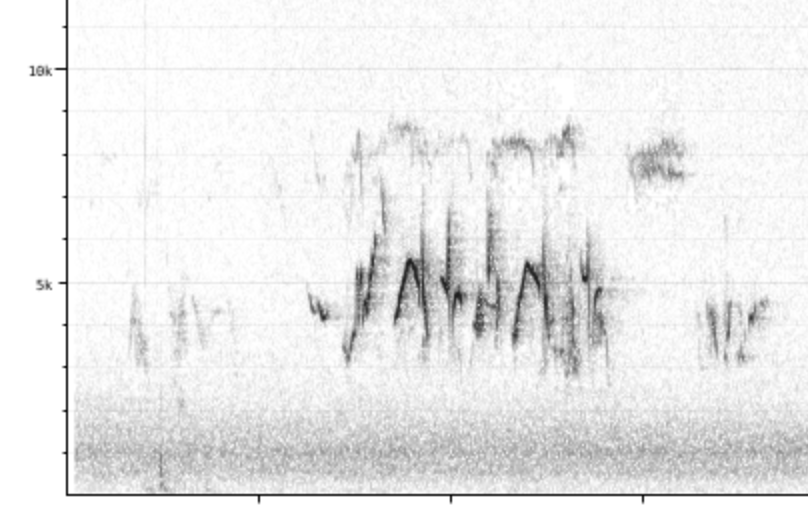
♫ Source: XENOCANTO
XC633658 - European Stonechat - Saxicola rubicola - song.mp3
(song)

Whinchat / Braunkehlchen (Saxicola rubetra)
Profile Wikipedia eBird Vogelwarte BirdLife ZH ornitho.ch bird-song.ch Xeno-Canto BirdID NABU
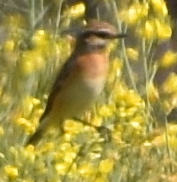
Mysterium im Rapsfeld von Friedliweid 2020-04-27 11.29.08 Luppmen
First observed in 🇨🇭 on 2020-05-07.
Die bauen ein Nest auf dem Boden auf einer Wiese oder Feld und brauchen relativ lang bis die Jungen flugge sind,
darum hoffe ich, dass sie weitergezogen sind. Da Felder selten so lang ungestört bleiben im Mittelland,
sind sie immer mehr in höheren Lagen zu finden.
Diesen Vogel haben wir paarweise in einem Rapsfeld entdeckt.
Von weitem konnte man nur etwas orange Farbe entdecken.
Ich habe ihn 2 Tage später im gleichen Feld gesucht und bin um das ganze Feld gelaufen.
Erst am Ende habe ich ihn gesehen: am Anfang, sicher 100m von mit entfernt und um 2 Ecken.
Da habe ich dieses Foto gemacht und in Büchern, Apps und Internet nach seiner Identität gesucht.
Als ich ein sehr ähnliches Bild auf ornitho.ch gefunden habe, wo er auch auf einer Rapspflanze drauf sitzt,
sah ich es als bestätigt, dass es ein Braunkelchen war.
Vocalization: ![]() The "peeu"-sound is depper and more resonant than similar sounds by Wheatear and Stonechat. [Link]
The "peeu"-sound is depper and more resonant than similar sounds by Wheatear and Stonechat. [Link]
Song: ![]() Kurzes (3-7 Töne) Liedchen mit 1-2 Kreischlauten, (ähnlich der Mittellaute b. Hausrotschwanz) variabel. Ahmt auch andere Vögel nach.
[Link]
Kurzes (3-7 Töne) Liedchen mit 1-2 Kreischlauten, (ähnlich der Mittellaute b. Hausrotschwanz) variabel. Ahmt auch andere Vögel nach.
[Link]
![]() Song variable with lots of mimicry. The short phrases starts with dry, rattling or sneering trills, followed by clear whistling notes and expert mimicry. More varied, both in tone and tempo, than both Stonechat and Wheatear. [Link]
Song variable with lots of mimicry. The short phrases starts with dry, rattling or sneering trills, followed by clear whistling notes and expert mimicry. More varied, both in tone and tempo, than both Stonechat and Wheatear. [Link]
Calls: ![]() „teck, teck“ (ähnlich wie wenn man zwei Steine zusammen schlägt)
[Link]
„teck, teck“ (ähnlich wie wenn man zwei Steine zusammen schlägt)
[Link]
![]() Contact call resembles many of it relatives. A short, soft "peeu", followed by a hard "check" (like hitting two rocks together). [Link]
Contact call resembles many of it relatives. A short, soft "peeu", followed by a hard "check" (like hitting two rocks together). [Link]
Physical details: length=12 cm,
wingspan=21-24 cm,
weight=14-19 g
Habitats:
Agricultural
Song:
General: Short buzzy trilly sounds, 5-8 notes, high.
Song: ![]() Gesang hat zwei Teile wie erster und dritter vom Hausrotschwanz. Steigend, fallend. [Link]
Gesang hat zwei Teile wie erster und dritter vom Hausrotschwanz. Steigend, fallend. [Link]
Song attributes:
Melody: improvised melodic, fast, Frequency: high (3-9 KHz) Special sounds: mimicry
Presence: 03-20 - 10-15
Breeding: 05-10 - 08-10
Migration in: 03-20 - 05-15
Migration out: 07-20 - 10-15
Common redstart / Gartenrotschwanz (Phoenicurus phoenicurus)
Common redstart on a cable In Locarno-Monti 2020-06-17 14.29.54 Locarno
First observed in 🇨🇭 on 2020-04-27.
I'd only seen them in Locarno - but I liked them! Later in our FOK expediton to cultural areas around Maienfeld, they were quite common. Also heard many near Frankfurt and Mainz.
I'd only seen them in Locarno - but I liked them! Later in our FOK expediton to cultural areas around Maienfeld, they were quite common. Also heard many near Frankfurt and Mainz.
Red-orange belly with white further down, grey back and head, black beard up to eyes with white eyebrows
In Locarno in 2020, they were often hidden in trees but also visible on powerlines. In 2021 one sang every morning at 5:00 in a gingko tree next to our room in Casa Egner.
Song: ![]() Fängt immer mit denselben 3 Tönen an, einem „dih dede“, wobei das dih etwa ein bis zwei Töne höher liegt. Dann folgt eine kurze Strophe mehr oder weniger reine Töne. Das Ganze ist ziemlich individuell.
[Link]
Fängt immer mit denselben 3 Tönen an, einem „dih dede“, wobei das dih etwa ein bis zwei Töne höher liegt. Dann folgt eine kurze Strophe mehr oder weniger reine Töne. Das Ganze ist ziemlich individuell.
[Link]
![]() Song distinct, with three parts: First an ascending single note, immediately followed by a trill, then concluding with a squeaky, rattling improvisation that usually contains some mimicry. [Link]
Song distinct, with three parts: First an ascending single note, immediately followed by a trill, then concluding with a squeaky, rattling improvisation that usually contains some mimicry. [Link]
Calls: ![]() „Füid-tack“ das füid ähnlich dem des Fitislaubsängers, das tack schnalzend. (wie wenn man die Zunge schnell vom Gaumen abzieht)
[Link]
„Füid-tack“ das füid ähnlich dem des Fitislaubsängers, das tack schnalzend. (wie wenn man die Zunge schnell vom Gaumen abzieht)
[Link]
![]() Alarm call a slightly drawn, Willow Warbler-like "huit" with a rising pitch, followed by a short, soft "tuc". [Link]
Alarm call a slightly drawn, Willow Warbler-like "huit" with a rising pitch, followed by a short, soft "tuc". [Link]
Physical details: length=14 cm,
wingspan=20-24 cm,
weight=11-19 g
Habitats:
Settlement
Song:
I though I had these guys figured out after hearing them in Locarno several times, but they're hard to get a handle on! At BirdID they are described the first two parts of a three-part song like this: 'an ascending single note, immediately followed by a trill', whereas in Locarno I heard an initial high-low-high-low, sometimes without the final low, perhaps also a quick middle note, and no trill. Then a relatively short blackbird or warbler-like tune of maybe 5-8 notes. Listening to more recordings at XenoCanto has completely confused me now! BirdID also says the song is similar to the black redstart, which I sometimes hear at XenoCanto, but never did in Locarno! They also note a similarity to the Lesser Whitethroat (Klappergrasmücke), which I hope to hear in Maienfeld.
Song attributes:
Melody: stereotype melodic, slow, Frequency: high (3-9 KHz) Special sounds: mimicry Singing season: 04-01 - 07-31 Dawn chorus start, 80 minutes before dawn.
♫ 2021-05-10 05.07.35 Locarno (song)
Call:
At least in French, this is called the huit call. Not very consistent in tone from one note to another. Some stick to 3-4 or 3-4.5 KHz, others 2.5-5.5.
♫ Source: XENOCANTO
XC551707 - Common Redstart - Phoenicurus phoenicurus.mp3
(call)
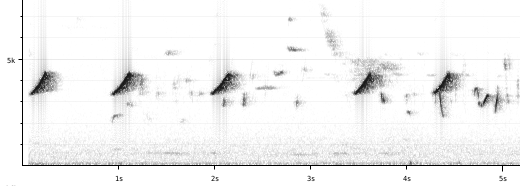
♫ Seine-et-Marne, Île-de-France recorded by Julien Rochefort - perhaps this isn't a good example as he writes 'An independent juvenile. Its calls are quite irregular. Difficult to distinguish from Phylloscopus collybita, when they don't insert the "tec tec" calls between "huit ...... huit"! But it was really a phoenicurus phoenicurus juvenile, easy to see, perched 15m from me.' Source: XENOCANTO
XC146715 common redstart huit call.mp3
(call)

♫ Source: XENOCANTO
XC560039 - Common Redstart - Phoenicurus phoenicurus phoenicurus.mp3
(alarm call)
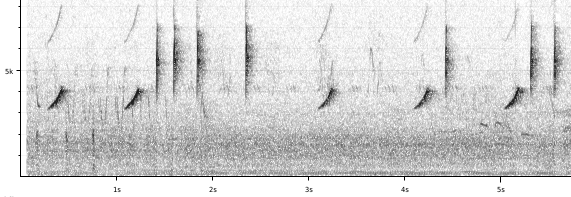
Call attributes:
contact call Call melody: one note, slow, Frequency: 2-5 KHz, Special sounds: whoop.
Presence: 03-20 - 10-25
Breeding: 05-01 - 07-15
Migration in: 03-20 - 05-07
Migration out: 07-15 - 10-25
Northern wheatear / Steinschmätzer (Oenanthe oenanthe)
Profile Wikipedia eBird Vogelwarte BirdLife ZH ornitho.ch Audubon AllAboutBirds Xeno-Canto BirdID NABU

Male northern wheatear, photo by Andreas Trepte - Own work, CC BY-SA 2.5 Source: WIKIPEDIA
Wikimedia Steinschmaetzer_Northern_wheatear_male.jpg
First observed in 🇨🇭 on 2021-07-29.
This bird appears across the great seas in the following continents:
Europe, North America, Africa.
General: I thought after seeing these at over 2700 meters that they must be a typical mountain bird (and in the FOK Zurich materials they were in the mountain section), however Wikipedia explains that such a stony landscape is the key, whether that is high or not:
Geography: ![]() The northern wheatear is a migratory insectivorous species breeding in open stony country in Europe and east across the Palearctic with footholds in northeastern Canada and Greenland as well as in northwestern Canada and Alaska. It nests in rock crevices and rabbit burrows. All birds spend most of their winter in Africa. ... Miniature tracking devices have recently shown that the northern wheatear has one of the longest migratory flights known - 30,000 km (18,640 miles), from sub-Saharan Africa to their Arctic breeding grounds.[15] [Link]
The northern wheatear is a migratory insectivorous species breeding in open stony country in Europe and east across the Palearctic with footholds in northeastern Canada and Greenland as well as in northwestern Canada and Alaska. It nests in rock crevices and rabbit burrows. All birds spend most of their winter in Africa. ... Miniature tracking devices have recently shown that the northern wheatear has one of the longest migratory flights known - 30,000 km (18,640 miles), from sub-Saharan Africa to their Arctic breeding grounds.[15] [Link]
Strangely the residence and migration maps differ greatly by source: in Wikipedia the northern wheatear spends winter in subsaharan Africa, while the authoratitive Kosmos-Vogelführer shows some in northern Africa like Morocco. Most other sources agree with Wikipedia and Sub-Saharan Africa.
I thought the German name Steinschmätzer, presumably stone kisser (no one explains it, oddly enough) to be much more logical than the English northern wheatear. I was greatly amused to look it up and find it to be a 'folk etymology of "white" and "arse"' (Wikipedia).
Etymology: ![]() The genus name Oenanthe is derived from the Greek oenos (οίνος) "wine" and anthos (ανθός) "flower". It refers to the northern wheatear's return to Greece in the spring just as the grapevines blossom. [Link]
The genus name Oenanthe is derived from the Greek oenos (οίνος) "wine" and anthos (ανθός) "flower". It refers to the northern wheatear's return to Greece in the spring just as the grapevines blossom. [Link]
It has an evil-looking black eye stripe like the shrike. (I liked Nici Baiker's description of it in the FOK field ornithology course as 'Zorro look'.) I saw one flying on Muottas Muragl and thought the striking gray oval surrounded by dark feathers has to be typical and seems unique to the northern wheatear.
In den FOK Unterlagen werden die Zugrouten von Alaska und von nordosten Kanada gezeigt, die beide fuer Winter nach Afrika ziehen. Die aus Alaska fliegen ueber Asien unglaubliche 15000 Kilometer! Die in Kanada haben es auch nicht leicht, da sie zuerst ueber den Atlantik nach Spanien fliegen!
Vocalization: ![]() Each phrase is often introduced by the "weet" sound, then followed by hastened, creaking, rattling and warbling sounds of 1-2 seconds duration. [Link]
Each phrase is often introduced by the "weet" sound, then followed by hastened, creaking, rattling and warbling sounds of 1-2 seconds duration. [Link]
Song: ![]() Kurze, wechselvolle Strophe mit vielen unreinen Tönen. Meist von erhöhter Warte aus oder in kurzem Singflug vorgetragen.
[Link]
Kurze, wechselvolle Strophe mit vielen unreinen Tönen. Meist von erhöhter Warte aus oder in kurzem Singflug vorgetragen.
[Link]
![]() The Wheatear song consists of short phrases with marked pauses. The "check" sound is also often included in the song. [Link]
The Wheatear song consists of short phrases with marked pauses. The "check" sound is also often included in the song. [Link]
Calls: ![]() „Tschack“ auch „hiit“ (saugend)
[Link]
„Tschack“ auch „hiit“ (saugend)
[Link]
![]() Contact and alarm call a high pitched, sharp "weet", followed by a hard "check", like hitting two rocks together. The "weet" sound is much sharper than the similar sound in Whinchat and Stonechat. Wheater usually repeats the "weet" sound more frequently than the "check" sound. The "check" of Stonechat is less pure and more gritty. [Link]
Contact and alarm call a high pitched, sharp "weet", followed by a hard "check", like hitting two rocks together. The "weet" sound is much sharper than the similar sound in Whinchat and Stonechat. Wheater usually repeats the "weet" sound more frequently than the "check" sound. The "check" of Stonechat is less pure and more gritty. [Link]
Physical details: length=14-15 cm,
wingspan=26-32 cm,
weight=18-29 g
Habitats:
Mountain
Looks similar to:
Red-backed shrike.
Song:
![]() The Wheatear song consists of short phrases with marked pauses. Each phrase is often introduced by the "weet" sound, then followed by hastened, creaking, rattling and warbling sounds of 1-2 seconds duration. The "check" sound is also often included in the song. [Link]
The Wheatear song consists of short phrases with marked pauses. Each phrase is often introduced by the "weet" sound, then followed by hastened, creaking, rattling and warbling sounds of 1-2 seconds duration. The "check" sound is also often included in the song. [Link]
Song attributes:
Melody: improvised melodic, fast, Frequency: 2-6 KHz Special sounds: rattle, rasp
♫ Source: XENOCANTO
XC730221 - Northern Wheatear - Oenanthe oenanthe - song recorded in France, just 2-3 notes, then long pause.mp3
(song)

♫ Source: XENOCANTO
XC764932 - Northern Wheatear - Oenanthe oenanthe - song recorded in Sweden with lots of whoops and swoops, about 2 seconds long, then 3-4 seconds pause.mp3
(song)

♫ Source: XENOCANTO
XC319898 - Northern Wheatear - Oenanthe oenanthe - song recorded in Scotland and includes creaking or rattling mentioned at Nord U BirdID.mp3
Scotland (song)

♫ Source: XENOCANTO
XC769228 - Northern Wheatear - Oenanthe oenanthe - song recorded in the Netherlands.mp3
(song)

European nuthatch / Kleiber (Sitta europaea)
Kleiber schwaendi. 2020-04-04 15.28.00 Luppmen
First observed in 🇨🇭 on 2020-04-04.
Maybe 8 or 10 short loud notes, a bit of a whoop on the sonogram
Vocalization: Other: Eurasian Nuthatch is very vocal. [Link]
![]() Very varied voice. [Link]
Very varied voice. [Link]
Song: Other: The song is very variable, with rising and falling notes, sometimes with repetition of excitement calls. [Link]
![]() The song is a slow whistled pee-pee-pee with many variants, including a faster version, and may be intermingled with the call. [Link]
The song is a slow whistled pee-pee-pee with many variants, including a faster version, and may be intermingled with the call. [Link]
Other: Song a simple series of loud notes. [Link]
![]() Song a simple series of loud notes. [Link]
Song a simple series of loud notes. [Link]
Calls: Other: It gives loud calls when excited, an abrupt ‘twit”, only one, or in slow series, but often in phrases of 3-4 notes in rapid succession. But in great excitement, it utters phrases of about ten notes per second!
We can also hear some shrill “sirrrr”, becoming harsher in alarm call. The contact call is a thin “tsit” uttered before to take off.
[Link]
![]() The Eurasian nuthatch calls frequently, usually with a loud, sharp dwip normally repeated twice, sometimes more often if excited. It has a shrill sirrrr or tsi-si-si alarm call, and a thin tsit pre-flight call. [Link]
The Eurasian nuthatch calls frequently, usually with a loud, sharp dwip normally repeated twice, sometimes more often if excited. It has a shrill sirrrr or tsi-si-si alarm call, and a thin tsit pre-flight call. [Link]
Other: Very varied voice. Ranging from very high pitched whistles and melodic resonant calls, to chattering and nasal mocking sounds. Characteristic warning call a hard "check" or "chwit", often in rapid series, like a pebble bouncing on hollow ice. [Link]
![]() Ranging from very high pitched whistles and melodic resonant calls, to chattering and nasal mocking sounds. Characteristic warning call a hard "check" or "chwit", often in rapid series, like a pebble bouncing on hollow ice. [Link]
Ranging from very high pitched whistles and melodic resonant calls, to chattering and nasal mocking sounds. Characteristic warning call a hard "check" or "chwit", often in rapid series, like a pebble bouncing on hollow ice. [Link]
Physical details: length=14 cm,
wingspan=22-27 cm,
weight=21-26 g
Habitats:
Forest
Song:
Song: ![]() Song a simple series of loud notes [Link]
Song a simple series of loud notes [Link]
Song attributes:
Melody: one note (ll), fast, Frequency: medium (1-5 KHz) Singing season: 02-01 - 07-31 Dawn chorus start, 10 minutes before dawn.
♫ Is the brevity what makes it a song, whereas calls seem to go on endlessly? Source: XENOCANTO
XC777051 - Eurasian Nuthatch - Sitta europaea, recorded in France and designated as song - a series of 5-6 whoops, pause and repeat, hard for me to distinguish from a ca-ll.mp3
(song)
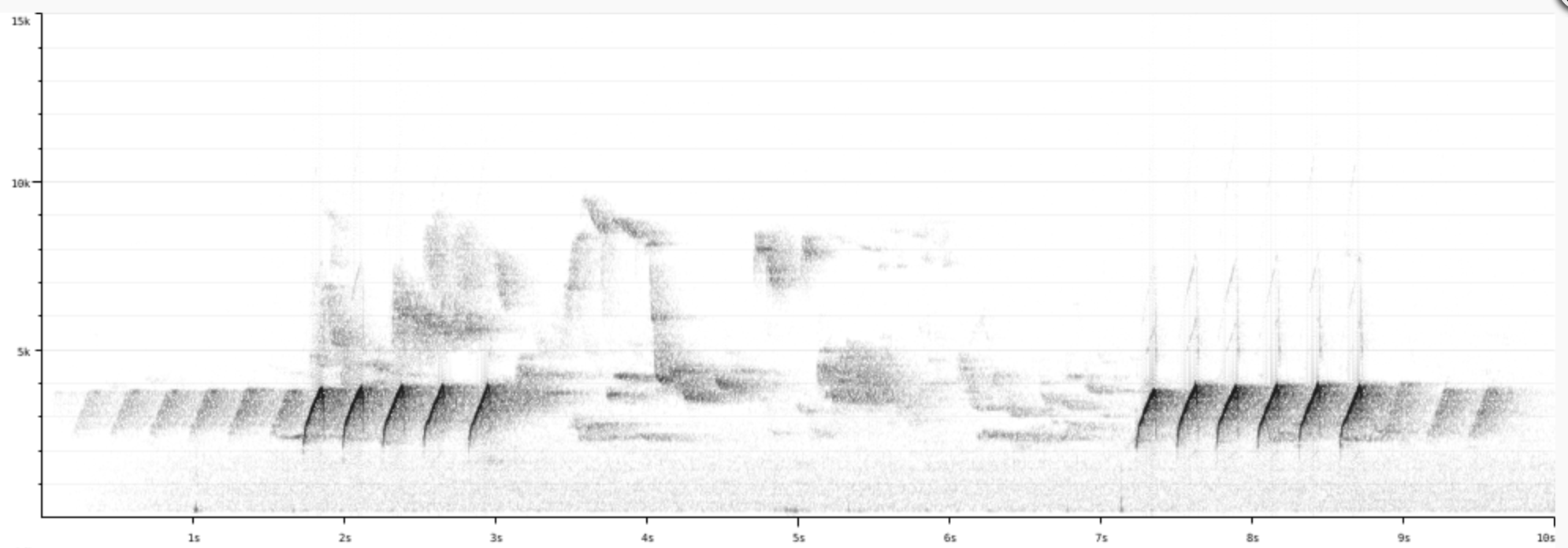
Calls:
1:
Twit, dwip.
A long fast sequence of notes - is it the 'twit' call mentioned above?
Long fast sequence of identical whoops, possibly 'twit' call.
♫ Long fast sequence of identical whoops, possibly 'twit' call. Source: XENOCANTO
XC129686 - Eurasian Nuthatch - Sitta europaea caesia.mp3
(call)
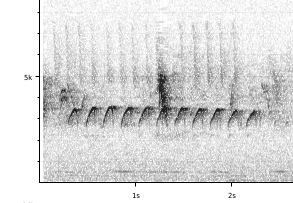 Similar to XC423335 but very regular rhythm
Similar to XC423335 but very regular rhythm
♫ Similar to XC423335 but very regular rhythm Source: XENOCANTO
XC781193 - Eurasian Nuthatch - Sitta europaea - call, one note, regular rhythm, 2 per second, recorded in Spain.mp3
Spain (call)
 One note, irregular rhythm. A bird calling while moving up a pine tree (says recordist Nick Talbot).
One note, irregular rhythm. A bird calling while moving up a pine tree (says recordist Nick Talbot).
♫ One note, irregular rhythm. A bird calling while moving up a pine tree (says recordist Nick Talbot). Source: XENOCANTO
XC423335 - Eurasian Nuthatch - Sitta europaea caesia.mp3
(call)

2:
The Nuthatch whoop call is similar to that of the chaffinch.
It repeats it about 4 times.
3:
Tsit.
Recordist Stanislav Wroz says flight call.
Flight call in Dampierre-en-Yvelines, Yvelines, Île-de-France. Wikipedia describes a 'thin tsit pre-flight call'.
♫ Flight call in Dampierre-en-Yvelines, Yvelines, Île-de-France. Wikipedia describes a 'thin tsit pre-flight call'. Source: XENOCANTO
XC522601 - Eurasian Nuthatch - Sitta europaea.mp3
(flight call)
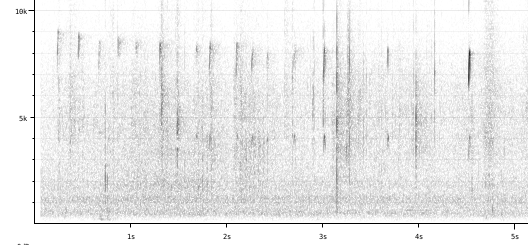
Call attributes:
Call melody: one note, fast, Frequency: 2-3 KHz,
Eurasian Wren foraging in the reeds at the frozen Lake Pfaeffikon 2021-02-15 08.41.30 Pfäffikersee
First observed in 🇨🇭 on 2019-07-07.
Etymology: ![]() The scientific name is taken from the Greek word "troglodytes" (from trogle a hole, and dyein to creep), meaning "cave-dweller",[4] and refers to its habit of disappearing into cavities or crevices whilst hunting arthropods or to roost. [Link]
The scientific name is taken from the Greek word "troglodytes" (from trogle a hole, and dyein to creep), meaning "cave-dweller",[4] and refers to its habit of disappearing into cavities or crevices whilst hunting arthropods or to roost. [Link]
Song: ![]() Auffällig laut für den kleinen Vogel. Singt auch im Winter! Schmetternd, mit einem bis zwei Trillern als letztes oder vorletztes Glied.
[Link]
Auffällig laut für den kleinen Vogel. Singt auch im Winter! Schmetternd, mit einem bis zwei Trillern als letztes oder vorletztes Glied.
[Link]
![]() Song surprisingly loud. A high-pitched stream of clear notes resembling Robin and Dunnock in timbre. Differs from those in showing frequent shifts in pitch with much larger register than Dunnock, and by the unique, numerous, interspersed long trills. [Link]
Song surprisingly loud. A high-pitched stream of clear notes resembling Robin and Dunnock in timbre. Differs from those in showing frequent shifts in pitch with much larger register than Dunnock, and by the unique, numerous, interspersed long trills. [Link]
Calls: ![]() „zerr“ (z-und rr-gleichzeitig) auch durchdringendes „tzr“(Gezetter)
[Link]
„zerr“ (z-und rr-gleichzeitig) auch durchdringendes „tzr“(Gezetter)
[Link]
![]() Warning call a short hard "teck", like banging two rocks together. Often repeated in series when excited to form machine-gun-like "firing". [Link]
Warning call a short hard "teck", like banging two rocks together. Often repeated in series when excited to form machine-gun-like "firing". [Link]
Physical details: length=9-10 cm,
wingspan=13-17 cm,
weight=7-12 g
Habitats:
Forest
Song:
High-pitched, melodic, very variable with many trills and whistles.
Song attributes:
Melody: improvised melodic, fast, Frequency: high (3-9 KHz) Special sounds: trill Singing season: 02-01 - 07-31 Dawn chorus start, 40 minutes before dawn.
Call:
Sputtery/drippy/trilly repeated notes at 3-8 KHz. June 2022 heard check calls that were distinctly irregularly in their rhythm.
Call attributes:
Call melody: one note, slow, Frequency: 3-8 KHz, Special sounds: sputter/pebble-clatter.
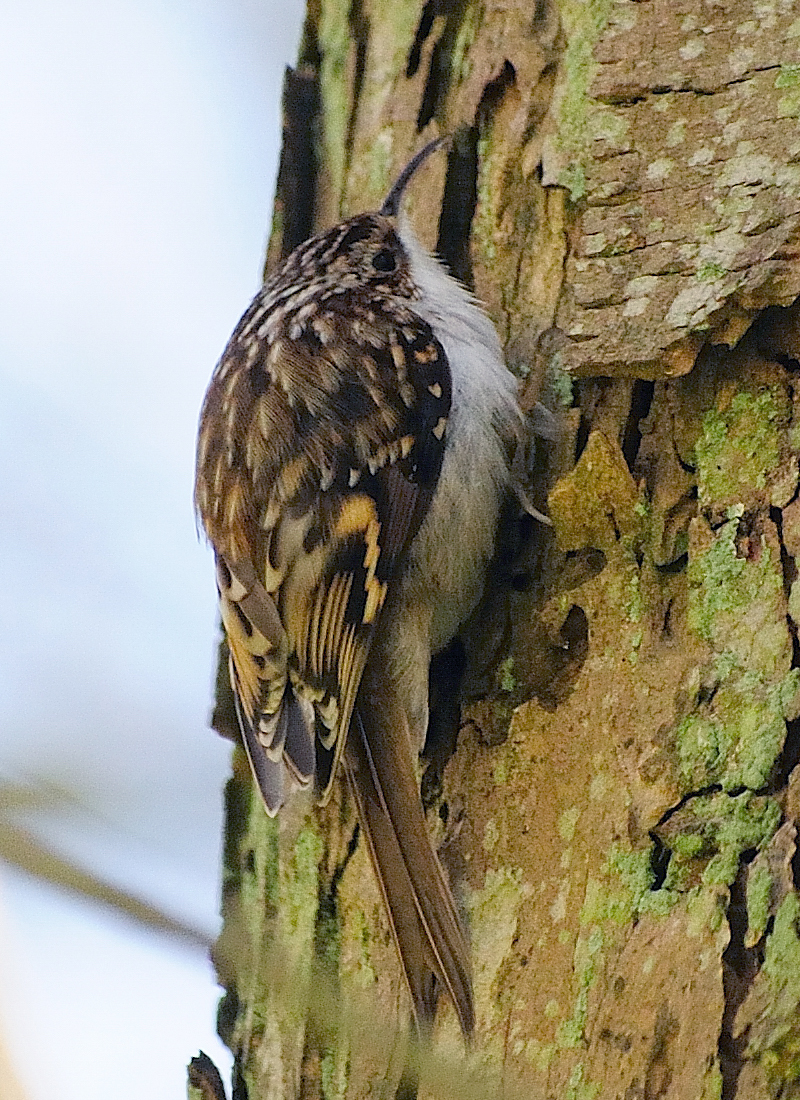
As seen creeping up a tree trunk Source: WIKIPEDIA
Wikimedia - European Treecreeper - Certhia_familiaris_-climbing_tree-8_(cropped_version).jpg
First observed in 🇨🇭 on 2020-04-25.
General: ![]() The Eurasian treecreeper or common treecreeper (Certhia familiaris) is a small passerine bird also known in the British Isles, where it is the only living member of its genus, simply as treecreeper. It is similar to other treecreepers, and has a curved bill, patterned brown upperparts, whitish underparts, and long stiff tail feathers which help it creep up tree trunks. It can be most easily distinguished from the similar short-toed treecreeper, which shares much of its European range, by its different song.
[more]
The Eurasian treecreeper or common treecreeper (Certhia familiaris) is a small passerine bird also known in the British Isles, where it is the only living member of its genus, simply as treecreeper. It is similar to other treecreepers, and has a curved bill, patterned brown upperparts, whitish underparts, and long stiff tail feathers which help it creep up tree trunks. It can be most easily distinguished from the similar short-toed treecreeper, which shares much of its European range, by its different song.
[more]
Song: ![]() Lang u. klar! (Waldwege sind lang). Tonreihe im Ganzen absinkend, nur letzter Ton höher. [Link]
Lang u. klar! (Waldwege sind lang). Tonreihe im Ganzen absinkend, nur letzter Ton höher. [Link]
![]() Song a short, continuous three-part phrase. [Link]
Song a short, continuous three-part phrase. [Link]
Calls: ![]() weniger scharf, „srih,“ weniger eindringlich als oben
[Link]
weniger scharf, „srih,“ weniger eindringlich als oben
[Link]
![]() Contact call a drawn, high-pitched "tzreeee". Similar to Goldcrest in timbre, but of longer duration with a vibrating and slightly rolling tone. Generally repeated in evenly paced, slow series (unlike Goldcrest). Each phrase starts with a few contact call-like notes followed by a Willow Warbler-like descending part, which then jumps to a few descending high notes to form a marked conclusion. Note that "mixed singers" are not uncommon in areas where both species of treecreepers occur. [Link]
Contact call a drawn, high-pitched "tzreeee". Similar to Goldcrest in timbre, but of longer duration with a vibrating and slightly rolling tone. Generally repeated in evenly paced, slow series (unlike Goldcrest). Each phrase starts with a few contact call-like notes followed by a Willow Warbler-like descending part, which then jumps to a few descending high notes to form a marked conclusion. Note that "mixed singers" are not uncommon in areas where both species of treecreepers occur. [Link]
Physical details: length=12 cm,
wingspan=17-21 cm,
weight=8-11 g
Habitats:
Forest
Looks similar to:
Short-toed treecreeper.
Song:
I say: it sounds like a faster higher chaffinch song. Wikipedia says: The male's song begins with srrih, srrih followed in turn by a few twittering notes, a longer descending ripple, and a whistle that falls and then rises.
Song attributes:
Mnemnoic: Sagging tree branch Melody: stereotype melodic, slow, Frequency: medium (1-5 KHz)
Call:
General: Wikipedia says: The contact call is a very quiet, thin and high-pitched sit, but the most distinctive call is a penetrating tsree, with a vibrato quality, sometimes repeated as a series of notes.
Fairly regularly spaced single tseep at 7-9KHz.
Call: ![]() Contact call a drawn, high-pitched "tzreeee". Similar to Goldcrest in timbre, but of longer duration with a vibrating and slightly rolling tone. Generally repeated in evenly paced, slow series (unlike Goldcrest). [Link]
Contact call a drawn, high-pitched "tzreeee". Similar to Goldcrest in timbre, but of longer duration with a vibrating and slightly rolling tone. Generally repeated in evenly paced, slow series (unlike Goldcrest). [Link]
Call attributes:
Call melody: one note, slow, Frequency: 7-9 KHz,
Bohemian waxwing / Seidenschwanz (Bombycilla garrulus)

Wikipedia: Bohemian waxwing Source: OTHER
1200px-Bombycilla_garrulusII.jpg
This bird appears across the great seas in the following continents:
Europe, North America.
Seasonal Behavior: ![]() Seltener Durchzügler, seltener Wintergast [Link]
Seltener Durchzügler, seltener Wintergast [Link]
Song: ![]() Song more or less a variation on the contact call. [Link]
Song more or less a variation on the contact call. [Link]
Calls: ![]() Contact call weak, but distinct and typically alert one to the presence of a flock. A thin, high pitched, ringing "tzrrrrrrr". [Link]
Contact call weak, but distinct and typically alert one to the presence of a flock. A thin, high pitched, ringing "tzrrrrrrr". [Link]
Physical details: length=18 cm,
wingspan=32-35 cm,
weight=50-75 g
Habitats:
Settlement
Song:
![]() Lots of trills. [Link]
Lots of trills. [Link]
Song attributes:
Melody: simple rhythmic, fast, Frequency: 5-7 KHz
White-throated dipper / Wasseramsel (Cinclus cinclus)
Profile Wikipedia eBird Vogelwarte BirdLife ZH ornitho.ch bird-song.ch Xeno-Canto BirdID NABU
Wasseramsel am Wissbach bei der Grenze zwischen Appenzell-Ausserrhoden und St Gallen. 2024-04-27 10.10.00
First observed in 🇨🇭 on 2024-04-27.
I saw a bird in Meride, Ticino in October 2020 on a tree limb that showed three bands of strong colors
that I recall as black, white and red-brown. Unfortunately I discovered that my camera battery
was dead, so I can only rely on a very shaky memory. I've speculatively identified it as a
White-throated Dipper (German Wasseramsel), which are present in that area, though are most
expected at water (there's a river nearby though). At least I'll have this bird on my radar now.
Expected near rivers and streams.
Song: ![]() Song a mid tempo, staccato improvisation on contact call-like sounds. Not unlike a budgerigar. Both sexes sing, the female less melodic and more staccato than the male. [Link]
Song a mid tempo, staccato improvisation on contact call-like sounds. Not unlike a budgerigar. Both sexes sing, the female less melodic and more staccato than the male. [Link]
Calls: ![]() Contact call a short, metallic and explosive "zrreet", often betraying its presence perched among boulders or when flying up and down a stream. [Link]
Contact call a short, metallic and explosive "zrreet", often betraying its presence perched among boulders or when flying up and down a stream. [Link]
Physical details: length=18 cm,
wingspan=25-30 cm,
weight=49-84 g
Habitats:
Wetland
Song:
Wonderfully weird sequence of chirps, cheeps, growls. Elements often repeated twice. In a quiz, I mistook it for a starling. This recording reminds me of other water songbirds like the Marsh warbler and various reed warblers.
Song attributes:
Melody: improvised melodic, fast, Frequency: 1-7 KHz Special sounds: weird, rasp
Call:
Chirp repeated 1-2s.
Call attributes:
Call melody: one note, slow, Frequency: 4-7 KHz,
Dohle, Haus bei chiesa St Antonio. 2023-06-19 18.31.46 Bolle di Magadino
First observed in 🇨🇭 on 2023-05-26.
Nabu: Ein hartes „kjack“ oder „schack“ sowie ein raues „tschräh“ hört man am häufigsten von der Dohle. Sie ist ein begabtes Stimmwunder und hat eine Vielzahl von Lauten und Imitationen auf Lager. [Link]
![]() meist angenehm klingende, kurze Rufe: "kja", oft mehrfach wiederholt, härteres "kjack!" oder gezogenes "kjaar". [Link]
meist angenehm klingende, kurze Rufe: "kja", oft mehrfach wiederholt, härteres "kjack!" oder gezogenes "kjaar". [Link]
Habitats:
Settlement
Song:
Automatically generated from Xeno-Canto recording
Song attributes:
Frequency:
♫ XC604997 - Western Jackdaw - Coloeus monedula - call, recorded in England. Source: XENOCANTO
XC604997 - Western Jackdaw - Coloeus monedula - call, recorded in England.mp3
(call)

Call:
Strange tone, Almost barking or a gull cry.
♫ Source: XENOCANTO
XC604997 - Western Jackdaw - Coloeus monedula - call, recorded in England.mp3
(call)

Call attributes:
Call melody: simple rhythmic, fast, Frequency: 1-3 KHz, Special sounds: weird.
Kraehe am luppmen. 2020-04-15 09.15.28 Luppmen
First observed in 🇨🇭 on 2020-04-22.
General: ![]() The carrion crow (Corvus corone) is a passerine bird of the family Corvidae and the genus Corvus which is native to western Europe and the eastern Palearctic.
[more]
The carrion crow (Corvus corone) is a passerine bird of the family Corvidae and the genus Corvus which is native to western Europe and the eastern Palearctic.
[more]
Vocalization: ![]() Probably impossible to tell from Hooded Crow by sound with certainty, but tends to sound harder, and more mean. [Link]
Probably impossible to tell from Hooded Crow by sound with certainty, but tends to sound harder, and more mean. [Link]
Physical details: length=45-47 cm,
wingspan=93-104 cm,
weight=370-650 g
Habitats:
Agricultural
Song:
Automatically generated from Xeno-Canto recording
Song attributes:
Frequency:
♫ Source: BirdNet
20200603_094458 birdnet 580 not interested in the crow - Carrion crow.mp3
2020-06-03 09.44.58 Hungerseeli (song)
Call:
Graak!
Call attributes:
Call melody: non-musical, slow, Frequency: low (1-3 KHz), Special sounds: cawing.
Kolkrabe am Aabach, Wetzikon. 2021-03-10 09.49.56 Wetzikon
First observed in 🇨🇭 on 2021-03-10.
This bird appears across the great seas in the following continents:
Europe, North America, Africa.
The raven is often mentioned in word puzzles as the largest songbird.
Good to know: Other: A flock of ravens may be called an unkindness [Literary names of groups and flocks]
Etymology: ![]() Kolk, die erste Silbe seines seit dem 16. Jahrhundert bezeugten deutschen Namens, ist vermutlich lautmalerischen Ursprungs, ahmt also den Ruf des Vogels nach. [Link]
Kolk, die erste Silbe seines seit dem 16. Jahrhundert bezeugten deutschen Namens, ist vermutlich lautmalerischen Ursprungs, ahmt also den Ruf des Vogels nach. [Link]
Appearance and identification: ![]() It is one of the two largest corvids, alongside the thick-billed raven, and is possibly the heaviest passerine bird [Link]
It is one of the two largest corvids, alongside the thick-billed raven, and is possibly the heaviest passerine bird [Link]
![]() Ravens are larger, the size of a Red-tailed Hawk [in Switzerland a red kite, similar 'length' but only 2/3 of the huge kite wingspan]. Ravens often travel in pairs, while crows are seen in larger groups. Also, watch the bird’s tail as it flies overhead. The crow’s tail feathers are basically the same length, so when the bird spreads its tail, it opens like a fan. Ravens, however, have longer middle feathers in their tails, so their tail appears wedge-shaped when open.
Listen closely to the birds’ calls. Crows give a cawing sound. But ravens produce a lower croaking sound.
[How to Tell a Raven From a Crow]
Ravens are larger, the size of a Red-tailed Hawk [in Switzerland a red kite, similar 'length' but only 2/3 of the huge kite wingspan]. Ravens often travel in pairs, while crows are seen in larger groups. Also, watch the bird’s tail as it flies overhead. The crow’s tail feathers are basically the same length, so when the bird spreads its tail, it opens like a fan. Ravens, however, have longer middle feathers in their tails, so their tail appears wedge-shaped when open.
Listen closely to the birds’ calls. Crows give a cawing sound. But ravens produce a lower croaking sound.
[How to Tell a Raven From a Crow]
Vocalization: ![]() Quite varied repertoire. Most heard sound a short, coarse, but resonant "korrk. Other sounds may be surprisingly resonant and pure, like a ringing "clong" etc. Shows even more variation when courting. [Link]
Quite varied repertoire. Most heard sound a short, coarse, but resonant "korrk. Other sounds may be surprisingly resonant and pure, like a ringing "clong" etc. Shows even more variation when courting. [Link]
Physical details: length=64 cm,
wingspan=120-150 cm,
weight=800-1560 g
Habitats:
Mountain
Song:
Automatically generated from Xeno-Canto recording
Song attributes:
Frequency:
♫ XC779842 - Northern Raven - Corvus corax corax - call recorded in Sweden. Source: XENOCANTO
XC779842 - Northern Raven - Corvus corax corax - call recorded in Sweden.mp3
(call)

Call:
Graak!
Call attributes:
Call melody: non-musical, slow, Frequency: low (1-3 KHz), Special sounds: cawing.
Profile Wikipedia eBird Vogelwarte BirdLife ZH ornitho.ch Xeno-Canto BirdID NABU
General: ![]() Die Saatkrähe (Corvus frugilegus) ist eine der vier europäischen Arten der Gattung Corvus aus der Familie der Rabenvögel (Corvidae).
[more]
Die Saatkrähe (Corvus frugilegus) ist eine der vier europäischen Arten der Gattung Corvus aus der Familie der Rabenvögel (Corvidae).
[more]
Vocalization: ![]() Makes similar caws as Carrion Crow, but is harsher, softer, flatter with less rolling r's. [Link]
Makes similar caws as Carrion Crow, but is harsher, softer, flatter with less rolling r's. [Link]
Song: ![]() Also gives a varied song of soft gurgling and rattling sounds, interwoven with calls at breeding ground. [Link]
Also gives a varied song of soft gurgling and rattling sounds, interwoven with calls at breeding ground. [Link]
Physical details: length=44-46 cm,
wingspan=81-99 cm,
weight=280-340 g
Habitats:
Agricultural
Song:
Gurgling and rattling, but mostly calls
Song attributes:
Melody: non-musical, fast, Frequency: 0-3 KHz Special sounds: weird
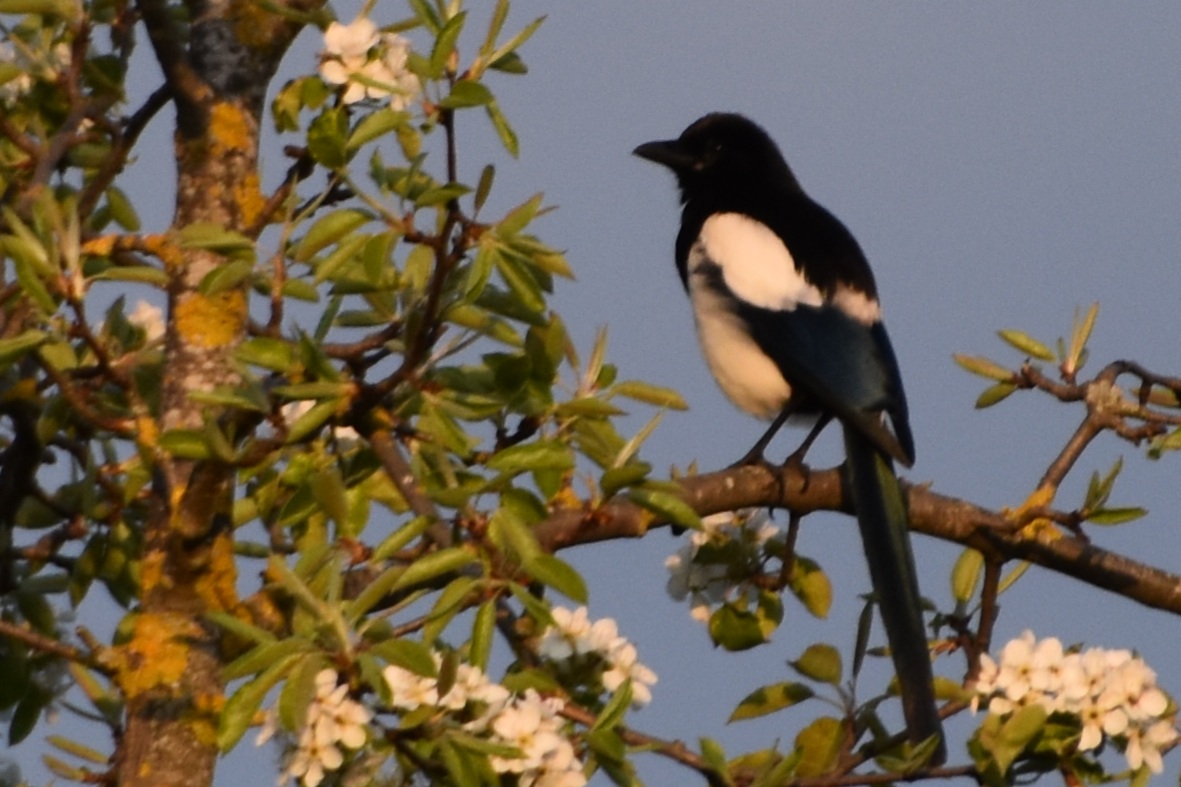
Elster bei friedliweid. 2020-04-13 10.26.40 Friedliweid
First observed in 🇨🇭 on 2020-04-13.
Very common in Fehraltorf. Monogamous. Clever. Female larger than male!
In trees, on roofs or the lawn - frequently underway and too big to hide.
Habitat: ![]() In den 1950er-Jahren sind die Elstern in unsere Städte eingezogen. Zu der Zeit veränderte sich ihr natürlicher Lebensraum. Offene Kulturlandschaften mit Gebüsch und hohen Bäumen verschwanden zunehmend, und in Gebieten mit intensiv genutztem Ackerland fanden die Elstern weder genügend Brutplätze noch ausreichend Nahrung. Dabei haben die Fast-Allesfresser vielfältige Vorlieben. Sie laben sich an Insekten, Reptilien, Amphibien, sie fressen überfahrene Tiere am Strassenrand, und vor allem im Spätsommer ernähren sie sich oft vegetarisch von Früchten und Samen. [Elstern sind besser als ihr Ruf]
In den 1950er-Jahren sind die Elstern in unsere Städte eingezogen. Zu der Zeit veränderte sich ihr natürlicher Lebensraum. Offene Kulturlandschaften mit Gebüsch und hohen Bäumen verschwanden zunehmend, und in Gebieten mit intensiv genutztem Ackerland fanden die Elstern weder genügend Brutplätze noch ausreichend Nahrung. Dabei haben die Fast-Allesfresser vielfältige Vorlieben. Sie laben sich an Insekten, Reptilien, Amphibien, sie fressen überfahrene Tiere am Strassenrand, und vor allem im Spätsommer ernähren sie sich oft vegetarisch von Früchten und Samen. [Elstern sind besser als ihr Ruf]
Song: ![]() Rich repertoire includes soft and surprisingly varied sub-song. [Link]
Rich repertoire includes soft and surprisingly varied sub-song. [Link]
Calls: ![]() Most notable sound a harsh, chattering "chechechecheche" used as warning call, or when mobbing predators. [Link]
Most notable sound a harsh, chattering "chechechecheche" used as warning call, or when mobbing predators. [Link]
Physical details: length=44-46 cm,
wingspan=52-60 cm,
weight=182-272 g
Habitats:
Settlement
Song:
Familiar rattle
Song attributes:
Melody: non-musical, slow, Frequency: low (1-3 KHz) Special sounds: rattle
Eichelhaeher for profile. 2020-04-17 08.48.34 Wald Fehraltorf
First observed in 🇨🇭 on 2020-04-17.
General: ![]() The Eurasian jay (Garrulus glandarius) is a species of bird occurring over a vast region from western Europe and north-west Africa to the Indian subcontinent and further to the eastern seaboard of Asia and down into south-east Asia. Across its vast range, several very distinct racial forms have evolved to look very different from each other, especially when forms at the extremes of its range are compared.
[more]
The Eurasian jay (Garrulus glandarius) is a species of bird occurring over a vast region from western Europe and north-west Africa to the Indian subcontinent and further to the eastern seaboard of Asia and down into south-east Asia. Across its vast range, several very distinct racial forms have evolved to look very different from each other, especially when forms at the extremes of its range are compared.
[more]
Vocalization: ![]() Large repertoire. Many other social sounds. [Link]
Large repertoire. Many other social sounds. [Link]
Song: ![]() Quiet and varied subsong with mimicry, resembling a small passerine heard from both sexes. [Link]
Quiet and varied subsong with mimicry, resembling a small passerine heard from both sexes. [Link]
Calls: ![]() Most heard call a short, drawn and very hoarse, raspy sound, often given in quick successions. Also a Buzzard-like, mewing "peeeaaa" (more drawn and less full tone than Siberian Jay). [Link]
Most heard call a short, drawn and very hoarse, raspy sound, often given in quick successions. Also a Buzzard-like, mewing "peeeaaa" (more drawn and less full tone than Siberian Jay). [Link]
Physical details: length=34-35 cm,
wingspan=52-58 cm,
weight=140-190 g
Habitats:
Forest
Song:
Harsh crow-like call, or quiet questioning, 'grumbling', or plaintive cries.
Song attributes:
Melody: non-musical, fast, Frequency: medium (1-5 KHz) Special sounds: cawing, mimicry
Calls:
1:
Typically harsh jay call. I would say a contact call usually means 'Here I am', answered by 'Good, here I am.' Listening to two jays in the Swiss mountains of Toggenburg, it sounded like 'HEY IDIOT, HERE I AM...WHERE THE HECK ARE YOU?' 'WHAT? YOU HAVEN'T FIGURE IT OUT? OF COURSE I'M OVER HERE. PEABRAIN.' On the other hand, anthropomorphism is always dangerous, usually completely wrong approach.
2:
We saw and heard a jay (Eichelhaeher) at the Pfaeffikersee imitating a common buzzard - very cool.
♫ Source: XENOCANTO
XC97136 - Eurasian Jay - Garrulus glandarius - imitating common buzzard.mp3
(Imitation of another bird's call)
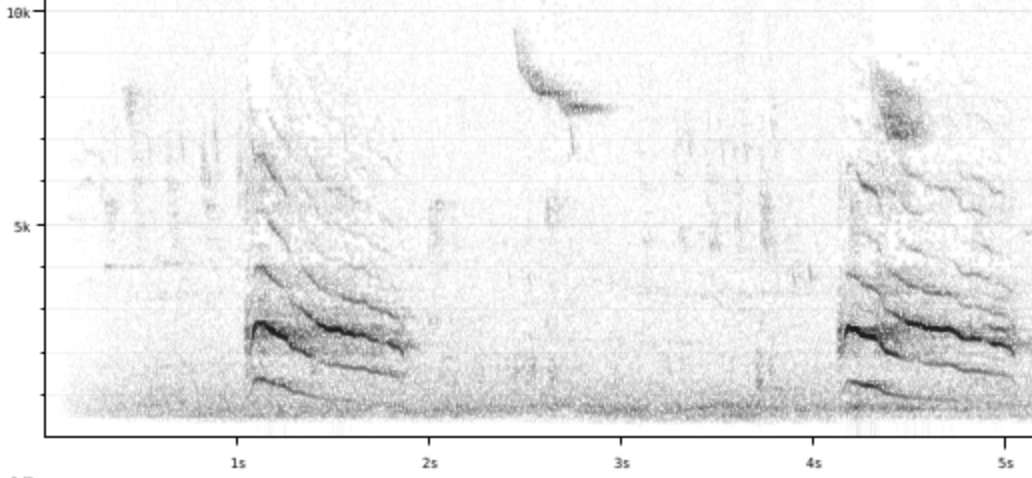
Call attributes:
Call melody: one note, slow, Frequency: medium (1-5 KHz), Special sounds: rasp.
Profile Wikipedia eBird Vogelwarte BirdLife ZH ornitho.ch Xeno-Canto NABU
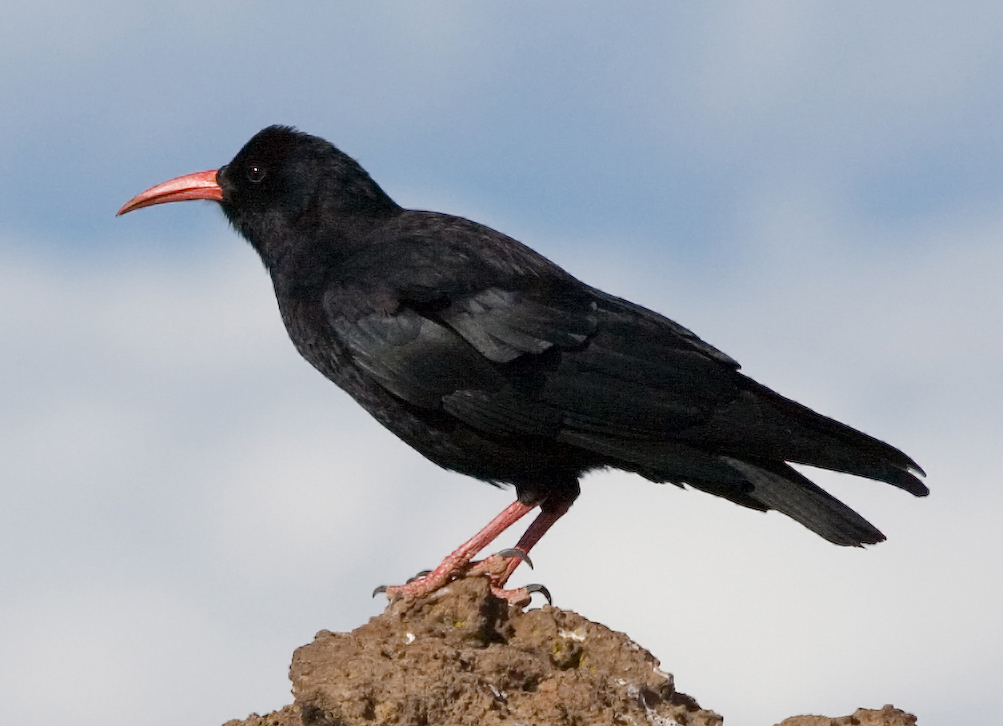
Wikipedia: Red-billed chough Source: OTHER
Pyrrhocorax_pyrrhocorax_-standing-8.jpg
Ebird: Gives a variety of calls, including a loud “chaw!”, as well as higher-pitched gull-like mewing calls. [Link]
Habitats:
Mountain
Call:
Higher-pitched falling graak.
Call attributes:
Call melody: non-musical, slow, Frequency: low (1-3 KHz), Special sounds: cawing.
Near Badi Auslikon at the Pfäffikersee. I thought I had only seen black-headed gulls, but on reviewing my photos,
I noticed the yellow bill. Other typical characteristics: it's bigger than the
black-headed gull next to it, it doesn't have the Charlie Brown half-ring around the eye,
it has less gray and only a few shorter black tail feathers. 2021-02-05 11.34.30 Pfäffikersee
First observed in 🇨🇭 on 2021-03-07.
This bird appears across the great seas in the following continents:
Europe, North America, Africa.
Not so common in Switzerland (most common would be the black-headed gull as far as I can see
Appearance and identification: Nabu: NABU ueber das Aussehen der Sturmmoewe:
'Sturmmöwen sind etwas größer als Lachmöwen, jedoch deutlich kleiner als Silbermöwen. Sie sind überwiegend weiß mit grauem Rücken und grauen Flügeln. Die Flügelenden sind schwarz mit weißer Spitze. Der Kopf ist rundlich, die dunklen Augen dünn rot umrandet. Der schlanke Schnabel und die Beine sind grünlichgelb, ein Schnabelfleck fehlt.' [Portraet]
Vocalization: ![]() Various mewing sounds. Similar in form to Herring Gull, but much higher pitched. [Link]
Various mewing sounds. Similar in form to Herring Gull, but much higher pitched. [Link]
Physical details: length=40-42 cm,
wingspan=100-115 cm,
weight=300-480 g
not sexually dimporphic.
Identifying characteristics:
general:
head = white (Gray in winter and when young), beak = yellow (greenish yellow), legs = yellow (duller in winter), , , ,
Adult:
wings = gray, , ,
Youth:
wings = white (with brown streaks), ,
Winter:
tail = black (and white striped),
Prachtkleid:
tail = white
Habitats:
River and lake
Profile Wikipedia eBird Vogelwarte BirdLife ZH ornitho.ch Audubon AllAboutBirds Xeno-Canto NABU
Lesser black-backed gull - yellow legs, yellow break with red under tip, black back but white shoulders. 2023-09-27 12.40.12 Florida
This bird appears across the great seas in the following continents:
Europe, North America, Africa.
General: ![]() The lesser black-backed gull (Larus fuscus) is a large gull that breeds on the Atlantic coasts of Europe. It is migratory, wintering from the British Isles south to West Africa. It is a regular winter visitor to the east coast of North America, probably from the breeding population in Iceland.
[more]
The lesser black-backed gull (Larus fuscus) is a large gull that breeds on the Atlantic coasts of Europe. It is migratory, wintering from the British Isles south to West Africa. It is a regular winter visitor to the east coast of North America, probably from the breeding population in Iceland.
[more]
Habitats:
River and lake
Herring gulls at Squam Lake, New Hampshire. 2023-10-06 12.47.32 New England
This bird appears across the great seas in the following continents:
Europe, North America, South America.
Deutschland: Brut-, Jahres-, Zugvogel, Wintergast
Vocalization: ![]() Quite vocal. A long and strong "ay-kay-kay-kay-kay" with fading strength commonly heard. A deep "ga-ga-ga" heard from anxious birds. [Link]
Quite vocal. A long and strong "ay-kay-kay-kay-kay" with fading strength commonly heard. A deep "ga-ga-ga" heard from anxious birds. [Link]
Calls: ![]() All calls much deeper pitched than Common Gull. Difficult to distinguish from Lesser Black-backed Gull, but tone is less nasal. [Link]
All calls much deeper pitched than Common Gull. Difficult to distinguish from Lesser Black-backed Gull, but tone is less nasal. [Link]
Physical details: length=55-64 cm,
wingspan=123-148 cm,
weight=750-1440 g
Habitats:
River and lake
Profile Wikipedia eBird Vogelwarte BirdLife ZH ornitho.ch Audubon AllAboutBirds Xeno-Canto NABU
Great black-backed gull (Mantelmöwe), Islay near Bridgend. 2023-08-11 09.31.48 Islay
First observed in Islay on 2023-08-11.
This bird appears across the great seas in the following continents:
Europe, North America.
Deutschland: Brut-, Jahres-, Zugvogel, Wintergast RL R
Habitats:
River and lake
Profile Wikipedia eBird Audubon AllAboutBirds Xeno-Canto BirdID NABU
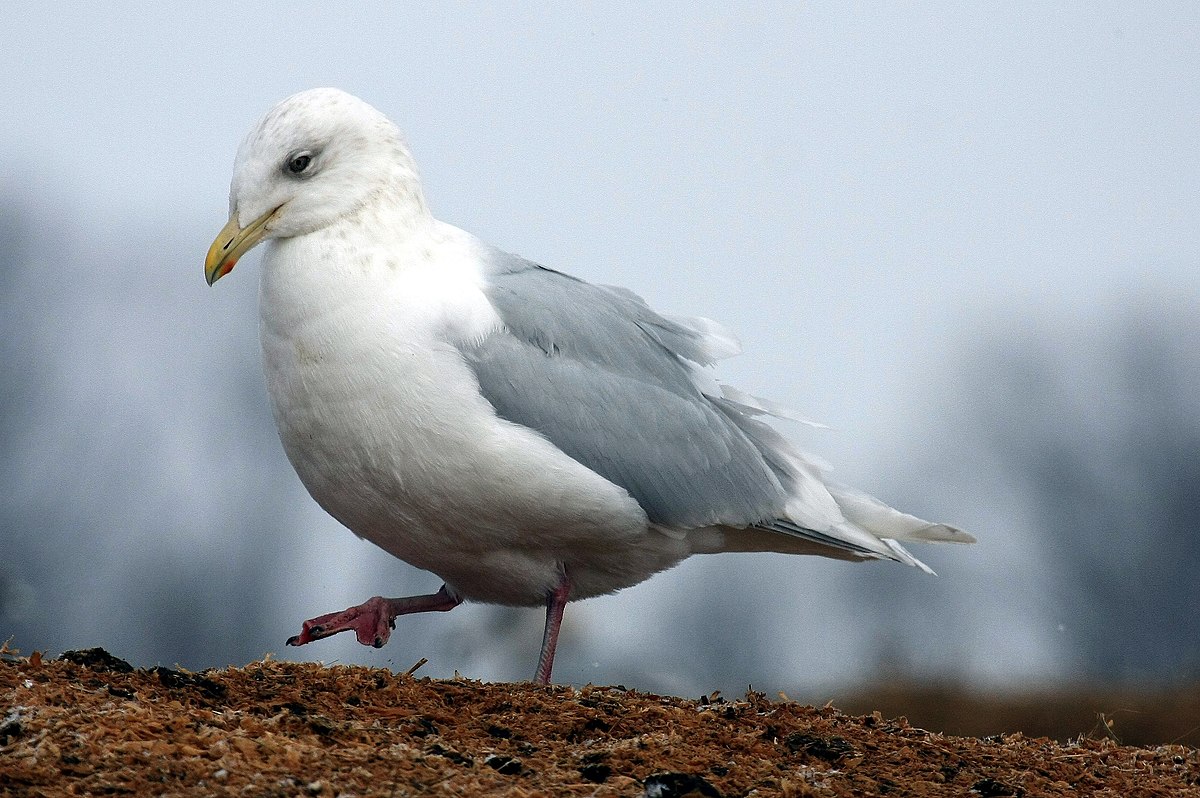
Wikipedia: Iceland gull Source: OTHER
1200px-Larus_glaucoides_IthacaNY.jpg
This bird appears across the great seas in the following continents:
Europe, North America.
General: ![]() The Iceland gull (Larus glaucoides) is a medium-sized gull that breeds in the Arctic regions of Canada and Greenland, but not in Iceland (as its name suggests), where it is only seen during winter. The genus name is from Latin larus, which appears to have referred to a gull or other large seabird. The specific name glaucoides denotes its resemblance to Larus glaucus, a synonym of Larus hyperboreus, the glaucous gull; -oides is Ancient Greek and means "resembling".[2]
[more]
The Iceland gull (Larus glaucoides) is a medium-sized gull that breeds in the Arctic regions of Canada and Greenland, but not in Iceland (as its name suggests), where it is only seen during winter. The genus name is from Latin larus, which appears to have referred to a gull or other large seabird. The specific name glaucoides denotes its resemblance to Larus glaucus, a synonym of Larus hyperboreus, the glaucous gull; -oides is Ancient Greek and means "resembling".[2]
[more]
Vocalization: ![]() Like Herring Gull, but tone sharper. [Link]
Like Herring Gull, but tone sharper. [Link]
Physical details: length=52-60 cm,
wingspan=140-150 cm,
weight=460-1039 g
Profile Wikipedia eBird Audubon AllAboutBirds Xeno-Canto BirdID NABU
MerlinBirdID says glaucous gull and American black duck females. 2023-10-12 13.39.32 New England
First observed in New England on 2023-10-12.
This bird appears across the great seas in the following continents:
Europe, North America.
General: ![]() The glaucous gull (Larus hyperboreus) is a large gull, the second-largest gull in the world. It breeds in Arctic regions of the Northern Hemisphere and winters south to shores of the Holarctic. The genus name is from Latin larus, which appears to have referred to a gull or other large seabird. The specific name hyperboreus is Latin for "northern" from the Ancient Greek Huperboreoi people from the far north [2] "Glaucous" is from Latin glaucus and denotes the grey colour of the gull.[3]
[more]
The glaucous gull (Larus hyperboreus) is a large gull, the second-largest gull in the world. It breeds in Arctic regions of the Northern Hemisphere and winters south to shores of the Holarctic. The genus name is from Latin larus, which appears to have referred to a gull or other large seabird. The specific name hyperboreus is Latin for "northern" from the Ancient Greek Huperboreoi people from the far north [2] "Glaucous" is from Latin glaucus and denotes the grey colour of the gull.[3]
[more]
Vocalization: ![]() Like Herring Gull. [Link]
Like Herring Gull. [Link]
Physical details: length=62-68 cm,
wingspan=150-165 cm,
weight=964-2215 g
On a canal feeding into the Pfäffikersee Paradoxically, they don't have to have a black head. 2020-10-30 16.51.58 Pfäffikersee
First observed in 🇨🇭 on 2020-05-20.
This bird appears across the great seas in the following continents:
Europe, North America, Africa, Asia.
Common waterbird at Pfäffikersee, that doesn't necessarily have the eponymous black head.
not sexually dimporphic.
No breeding plumage
Identifying characteristics:
Summer:
head = black, , , , , tail = black
Winter:
head = white (With Charlie Brown-style half circle behind the eye), , , ,
general:
beak = red, legs = red, wings = gray,
Habitats:
River and lake
Song:
Automatically generated from Xeno-Canto recording
Song attributes:
Frequency:
♫ Source: BirdNet
20210427_165123 birdnet 1485 - Black-headed Gull racket at Chlisee - No confident detection - Wetzikon.mp3
2021-04-27 16.51.23 Wetzikon (song)
Black-legged kittiwake / Dreizehenmöwe (Rissa tridactyla)
Profile Wikipedia eBird Vogelwarte BirdLife ZH ornitho.ch Audubon AllAboutBirds Xeno-Canto BirdID NABU

Wikipedia: Black-legged kittiwake Source: OTHER
1200px-Rissa_tridactyla_%28Vard%C3%B8%2C_2012%29.jpg
This bird appears across the great seas in the following continents:
Europe, North America, Africa.
General: ![]() The black-legged kittiwake (Rissa tridactyla) is a seabird species in the gull family Laridae.
[more]
The black-legged kittiwake (Rissa tridactyla) is a seabird species in the gull family Laridae.
[more]
Vocalization: ![]() Highly vocal at breeding ground. A mewing "kitti-wake", with the pitch rising on the second drawn out syllable, and then falling. Generally silent elsewhere, except when squabbling over food. [Link]
Highly vocal at breeding ground. A mewing "kitti-wake", with the pitch rising on the second drawn out syllable, and then falling. Generally silent elsewhere, except when squabbling over food. [Link]
Physical details: length=38-40 cm,
wingspan=95-105 cm,
weight=310-500 g
Sabine's gull / Schwalbenmöwe (Xema sabini)

Wikipedia: Sabine's gull Source: OTHER
Xema_sabini_-Iceland_-swimming-8_%281%29.jpg
This bird appears across the great seas in the following continents:
Europe, North America, South America, Africa.
General: ![]() Sabine's gull (/ˈseɪbɪn/ SAY-bin; Xema sabini), also known as the fork-tailed gull or xeme, is a small gull. Its generic placement is disputed; some authors treat it as the sole species in the genus Xema as Xema sabini,[2] while others retain it in the genus Larus as Larus sabini.[3][4]
[more]
Sabine's gull (/ˈseɪbɪn/ SAY-bin; Xema sabini), also known as the fork-tailed gull or xeme, is a small gull. Its generic placement is disputed; some authors treat it as the sole species in the genus Xema as Xema sabini,[2] while others retain it in the genus Larus as Larus sabini.[3][4]
[more]
Little tern / Zwergseeschwalbe (Sternula albifrons)
Little Tern, Reykjavik, Iceland. 2015-05-29 11.18.30 Iceland
First observed in Iceland on 2015-05-29.
![]() The little tern (Sternula albifrons) is a seabird of the family Laridae. It was formerly placed into the genus Sterna, which now is restricted to the large white terns.[2] The genus name is a diminutive of Sterna, "tern". The specific albifrons is from Latin albus, "white", and "frons", forehead.[3] The former North American (S. a. antillarum) and Red Sea S. a. saundersi subspecies are now considered to be separate species, the least tern (Sternula antillarum) and Saunders's tern (Sternula saundersi).
[more]
The little tern (Sternula albifrons) is a seabird of the family Laridae. It was formerly placed into the genus Sterna, which now is restricted to the large white terns.[2] The genus name is a diminutive of Sterna, "tern". The specific albifrons is from Latin albus, "white", and "frons", forehead.[3] The former North American (S. a. antillarum) and Red Sea S. a. saundersi subspecies are now considered to be separate species, the least tern (Sternula antillarum) and Saunders's tern (Sternula saundersi).
[more]
Vocalization: ![]() Fairly distinct voice. [Link]
Fairly distinct voice. [Link]
Calls: ![]() Contact call a sharp "kitt", often combined to form undulating, rolling series. Not as sharp and penetrating as Common- and Arctic Tern. [Link]
Contact call a sharp "kitt", often combined to form undulating, rolling series. Not as sharp and penetrating as Common- and Arctic Tern. [Link]
Physical details: length=22-24 cm,
wingspan=48-55 cm,
weight=49-63 g
Habitats:
River and lake
Sandwich tern / Brandseeschwalbe (Thalasseus sandvicensis)
Sandwich tern in flight with distinct yellow tipped bill. 2023-09-27 12.28.34 Florida
First observed in Costa Rica on 2018-03-11.
This bird appears across the great seas in the following continents:
Europe, North America, South America, Africa.
General: ![]() The Sandwich tern (Thalasseus sandvicensis)[2] is a tern in the family Laridae. It is very closely related to the lesser crested tern (T. bengalensis), Chinese crested tern (T. bernsteini), Cabot's tern (T. acuflavidus), and elegant tern (T. elegans) and has been known to interbreed with the lesser crested. It breeds in the Palearctic from Europe to the Caspian Sea wintering to South Africa, India and Sri Lanka.
[more]
The Sandwich tern (Thalasseus sandvicensis)[2] is a tern in the family Laridae. It is very closely related to the lesser crested tern (T. bengalensis), Chinese crested tern (T. bernsteini), Cabot's tern (T. acuflavidus), and elegant tern (T. elegans) and has been known to interbreed with the lesser crested. It breeds in the Palearctic from Europe to the Caspian Sea wintering to South Africa, India and Sri Lanka.
[more]
Calls: ![]() Contact call a sharp and grating "keeree-eek". Often compared to the pressing of amalgam into a tooth. [Link]
Contact call a sharp and grating "keeree-eek". Often compared to the pressing of amalgam into a tooth. [Link]
Physical details: length=36-41 cm,
wingspan=95-105 cm,
weight=215-275 g
Habitats:
River and lake
Little gull / Zwergmöwe (Hydrocoloeus minutus)

Wikipedia: Little gull Source: OTHER
1200px-%C4%8Cajka_mal%C3%A1_%28Larus_minutus%29_a_%284834254958%29.jpg
First observed in 🇨🇭 on 2022-12-03.
This bird appears across the great seas in the following continents:
Europe, North America, Africa.
Deutschland: ausnahmsweise Brutvogel, Zugvogel RL R
Calls: ![]() Repertoire of short, tern-like, hard calls, uttered individually, or in series. E.g. "kep" or "krrk". Also a diagnostic, gull-like, sharp and bouncing "ka-tee,ka-tee,ka-tee", with second syllable rising in pitch. [Link]
Repertoire of short, tern-like, hard calls, uttered individually, or in series. E.g. "kep" or "krrk". Also a diagnostic, gull-like, sharp and bouncing "ka-tee,ka-tee,ka-tee", with second syllable rising in pitch. [Link]
Physical details: length=25-27 cm,
wingspan=75-80 cm,
weight=85-150 g
Habitats:
River and lake
Mediterranean gull / Schwarzkopfmöwe (Ichthyaetus melanocephalus)
Schwarzkopfmoewen, Maennchen in Prachtkleid links, Weibchen rechts. 2022-12-03 10.33.42 Rapperswil
First observed in 🇨🇭 on 2022-12-03.
General: ![]() The Mediterranean gull (Ichthyaetus melanocephalus) is a small gull. The scientific name is from Ancient Greek. The genus Ichthyaetus is from ikhthus, "fish", and aetos, "eagle", and the specific melanocephalus is from melas, "black", and -kephalos "-headed".[2]
[more]
The Mediterranean gull (Ichthyaetus melanocephalus) is a small gull. The scientific name is from Ancient Greek. The genus Ichthyaetus is from ikhthus, "fish", and aetos, "eagle", and the specific melanocephalus is from melas, "black", and -kephalos "-headed".[2]
[more]
Calls: ![]() Distinct calls which can be identified even in mixed flocks. Most common call a short, mewing "yeah". Pitch rises and fall rapidly, with a "surprised" intonation. Timbre is nasal but clear and pure. Alarm call a series of short "ke-ke-ke", with similar timbre. [Link]
Distinct calls which can be identified even in mixed flocks. Most common call a short, mewing "yeah". Pitch rises and fall rapidly, with a "surprised" intonation. Timbre is nasal but clear and pure. Alarm call a series of short "ke-ke-ke", with similar timbre. [Link]
Physical details: length=36-38 cm,
wingspan=92-100 cm,
weight=232-280 g
not sexually dimporphic.
No breeding plumage
Identifying characteristics:
Adult:
head = black, , , , , tail = white,
Youth:
head = white (sprinkled with gray around the eyes), , , , , tail = black (tip of tail black-brown by young birds)
general:
wings = gray (very pale grey mantle and wings with white primary feathers without black tips.), beak = red (Dark red beak [in Levanto I said orange], usually with yellow to orange tip but can also be red. Between the tip and the shaft is a dark band.), legs = red (Their feet are dark red [legs presumably too].), ,
Habitats:
River and lake
Northern lapwing / Kiebitz (Vanellus vanellus)
Profile Wikipedia eBird Vogelwarte BirdLife ZH ornitho.ch bird-song.ch Xeno-Canto BirdID NABU
Kiebitz, Neeracher Ried. 2021-02-24 12.46.02 Neeracherried
First observed in 🇨🇭 on 2021-02-24.
Etymology: ![]() The name lapwing has been variously attributed to the "lapping" sound its wings make in flight, from the irregular progress in flight due to its large wings (the Oxford English Dictionary derives this from an Old English word meaning "to totter"),[4] or from its habit of drawing potential predators away from its nest by trailing a wing as if broken. [Link]
The name lapwing has been variously attributed to the "lapping" sound its wings make in flight, from the irregular progress in flight due to its large wings (the Oxford English Dictionary derives this from an Old English word meaning "to totter"),[4] or from its habit of drawing potential predators away from its nest by trailing a wing as if broken. [Link]
Vocalization: ![]() Quite vocal, especially in flight at breeding ground. [Link]
Quite vocal, especially in flight at breeding ground. [Link]
Calls: ![]() Ruf ist entweder mhhhh oder Bogen-artiges hoch und runter. [Link]
Ruf ist entweder mhhhh oder Bogen-artiges hoch und runter. [Link]
![]() Territorial call: Dry, introductory phrases followed by drawn-out mewing sounds; "wyrrr-peeeoo-weeep". Alarm call "pee-wit". [Link]
Territorial call: Dry, introductory phrases followed by drawn-out mewing sounds; "wyrrr-peeeoo-weeep". Alarm call "pee-wit". [Link]
Physical details: length=28-31 cm,
wingspan=82-87 cm,
weight=140-320 g
Habitats:
Wetland
Common ringed plover / Sandregenpfeifer (Charadrius hiaticula)
Profile Wikipedia eBird Vogelwarte BirdLife ZH ornitho.ch Audubon AllAboutBirds Xeno-Canto BirdID NABU
Sandregenpfeifer im Profil, Neeracherried. 2022-09-04 07.25.18 Neeracherried
First observed in 🇨🇭 on 2022-09-04.
This bird appears across the great seas in the following continents:
Europe, North America, Africa.
General: ![]() The common ringed plover or ringed plover (Charadrius hiaticula) is a small plover that breeds in Arctic Eurasia. The genus name Charadrius is a Late Latin word for a yellowish bird mentioned in the fourth-century Vulgate. It derives from Ancient Greek kharadrios a bird found in ravines and river valleys (kharadra, "ravine"). The specific hiaticula is Latin and has a similar meaning to the Greek term, coming from hiatus, "cleft" and -cola, "dweller" (colere, "to dwell").[2]
[more]
The common ringed plover or ringed plover (Charadrius hiaticula) is a small plover that breeds in Arctic Eurasia. The genus name Charadrius is a Late Latin word for a yellowish bird mentioned in the fourth-century Vulgate. It derives from Ancient Greek kharadrios a bird found in ravines and river valleys (kharadra, "ravine"). The specific hiaticula is Latin and has a similar meaning to the Greek term, coming from hiatus, "cleft" and -cola, "dweller" (colere, "to dwell").[2]
[more]
Vocalization: ![]() Usually heard before seen. [Link]
Usually heard before seen. [Link]
Song: ![]() Song a cyclic repetition of the contact call. Sometimes with a shortened phrases and a more creaking timbre. [Link]
Song a cyclic repetition of the contact call. Sometimes with a shortened phrases and a more creaking timbre. [Link]
Calls: ![]() Contact call a short, soft "koo-eep", with the emphasised second part higher and rising in pitch. [Link]
Contact call a short, soft "koo-eep", with the emphasised second part higher and rising in pitch. [Link]
Physical details: length=18-20 cm,
wingspan=48-57 cm,
weight=55-73 g
Habitats:
Wetland
Black-bellied plover / Kiebitzregenpfeifer (Pluvialis squatarola)
Black-bellied plover eggs. 2016-09-25 16.51.00 Botswana
First observed in Botswana on 2016-09-25.
This bird appears across the great seas in the following continents:
Europe, North America, South America, Africa, Asia.
General: ![]() The grey plover or black-bellied plover (Pluvialis squatarola) is a medium-sized plover breeding in Arctic regions. It is a long-distance migrant, with a nearly worldwide coastal distribution when not breeding.[2] The genus name is Latin and means relating to rain, from pluvia, "rain". It was believed that golden plovers flocked when rain was imminent. The species name squatarola is a Latinised version of Sgatarola, a Venetian name for some kind of plover.[3]
[more]
The grey plover or black-bellied plover (Pluvialis squatarola) is a medium-sized plover breeding in Arctic regions. It is a long-distance migrant, with a nearly worldwide coastal distribution when not breeding.[2] The genus name is Latin and means relating to rain, from pluvia, "rain". It was believed that golden plovers flocked when rain was imminent. The species name squatarola is a Latinised version of Sgatarola, a Venetian name for some kind of plover.[3]
[more]
Calls: ![]() Contact call diagnostic. A plaintive, drawn and trisyllabic (but continuous) "kleeooowee". Pitch falls on second syllable and rises on last. [Link]
Contact call diagnostic. A plaintive, drawn and trisyllabic (but continuous) "kleeooowee". Pitch falls on second syllable and rises on last. [Link]
Physical details: length=27-30 cm,
wingspan=71-83 cm,
weight=190-280 g
Habitats:
Wetland
European golden-plover / Goldregenpfeifer (Pluvialis apricaria)

Wikipedia: European golden-plover Source: OTHER
1200px-Kul%C3%ADk_zlat%C3%BD_%28Pluvialis_apricaria%29_a_%283949776435%29.jpg
General: ![]() The European golden plover (Pluvialis apricaria), also known as the European golden-plover, Eurasian golden plover, or just the golden plover within Europe, is a largish plover. This species is similar to two other golden plovers: the American golden plover, Pluvialis dominica, and Pacific golden plover, Pluvialis fulva, which are both smaller, slimmer and relatively longer-legged than European golden plover, and both have grey rather than white axillary feathers (only properly visible in flight).
[more]
The European golden plover (Pluvialis apricaria), also known as the European golden-plover, Eurasian golden plover, or just the golden plover within Europe, is a largish plover. This species is similar to two other golden plovers: the American golden plover, Pluvialis dominica, and Pacific golden plover, Pluvialis fulva, which are both smaller, slimmer and relatively longer-legged than European golden plover, and both have grey rather than white axillary feathers (only properly visible in flight).
[more]
Song: ![]() In song flight also a trilling, warbling and cyclic "preecaria-preecaria-preecaria". [Link]
In song flight also a trilling, warbling and cyclic "preecaria-preecaria-preecaria". [Link]
Calls: ![]() Most common call at breeding ground a disyllabic, melancholic and wailing whistle with the end falling in pitch. Contact call a straight, short "kluee". [Link]
Most common call at breeding ground a disyllabic, melancholic and wailing whistle with the end falling in pitch. Contact call a straight, short "kluee". [Link]
Physical details: length=26-29 cm,
wingspan=67-76 cm,
weight=160-280 g
Habitats:
Wetland
Curlew sandpiper / Sichelstrandläufer (Calidris ferruginea)
Profile Wikipedia eBird Vogelwarte BirdLife ZH ornitho.ch Audubon AllAboutBirds Xeno-Canto BirdID NABU

Wikipedia: Curlew sandpiper Source: OTHER
1200px-Calidris_ferruginea%2C_winter_adult%2C_Pak_Thale.jpg
This bird appears across the great seas in the following continents:
Europe, North America, South America, Africa, Asia.
Etymology: ![]() Nicolas Baiker sagt, Hauptmerkmale innerhalb der Strandlaeufer sind der Augenstreif und der Schnabel der relativ lang ist und immer lezten Drittel immer krummer, darum Sichelstrandlaeufer. [Link]
Nicolas Baiker sagt, Hauptmerkmale innerhalb der Strandlaeufer sind der Augenstreif und der Schnabel der relativ lang ist und immer lezten Drittel immer krummer, darum Sichelstrandlaeufer. [Link]
Calls: ![]() Flight call a soft, ringing and rolling "krrrrrt, with variations. Lacks the hoarse, nasal quality of similar call by Dunlin. [Link]
Flight call a soft, ringing and rolling "krrrrrt, with variations. Lacks the hoarse, nasal quality of similar call by Dunlin. [Link]
Physical details: length=18-19 cm,
wingspan=42-46 cm,
weight=50-65 g
Habitats:
Wetland
Ruff / Kampfläufer (Calidris pugnax)

Wikipedia: Ruff Source: OTHER
1200px-Philomachus_pugnax_-Diergaarde_Blijdorp-8c.jpg
This bird appears across the great seas in the following continents:
Europe, North America, South America, Africa, Asia.
Etymology: Nabu: Der Name leitet sich vom Balzverhalten der Männchen ab: In Balzarenen tragen sie „Turniere“ aus, um die Weibchen zu beeindrucken, dabei herrscht eine komplizierte Rollenverteilung. [Link]
Vocalization: ![]() Generally silent. Short, muted, nasal, mono or disyllabic grunts sometimes heard. [Link]
Generally silent. Short, muted, nasal, mono or disyllabic grunts sometimes heard. [Link]
Physical details: length=26-30 cm,
wingspan=54-58 cm,
weight=75-230 g
Habitats:
Wetland
Red knot / Knutt (Calidris canutus)
Profile Wikipedia eBird Vogelwarte BirdLife ZH ornitho.ch Audubon AllAboutBirds Xeno-Canto BirdID NABU
Red knots, according to MerlinBirdID - underway to somewhere better at Las Coloradas. 2023-04-15 09.34.08 Yucatan
First observed in Yucatan on 2023-04-15.
This bird appears across the great seas in the following continents:
Europe, North America, South America, Africa, Asia.
General: ![]() The red knot (Calidris canutus) (just knot in English-speaking Europe) is a medium-sized shorebird which breeds in tundra and the Arctic Cordillera in the far north of Canada, Europe, and Russia. It is a large member of the Calidris sandpipers, second only to the great knot.[2] Six subspecies are recognised.
[more]
The red knot (Calidris canutus) (just knot in English-speaking Europe) is a medium-sized shorebird which breeds in tundra and the Arctic Cordillera in the far north of Canada, Europe, and Russia. It is a large member of the Calidris sandpipers, second only to the great knot.[2] Six subspecies are recognised.
[more]
Song: ![]() Song an undulating, nasal mewing "poooor-mee", or "po-hor-mee". [Link]
Song an undulating, nasal mewing "poooor-mee", or "po-hor-mee". [Link]
Calls: ![]() Most commonly heard migratory call, a short "kut" or "knot". Sometimes given in stuttering series. [Link]
Most commonly heard migratory call, a short "kut" or "knot". Sometimes given in stuttering series. [Link]
Physical details: length=23-25 cm,
wingspan=57-61 cm,
weight=110-160 g
Habitats:
Wetland
Sanderling / Sanderling (Calidris alba)
Profile Wikipedia eBird Vogelwarte BirdLife ZH ornitho.ch Audubon AllAboutBirds Xeno-Canto BirdID NABU
Sanderling. 2023-09-27 12.12.20 Florida
First observed in Yucatan on 2023-03-27.
This bird appears across the great seas in the following continents:
Europe, North America, South America, Africa, Asia.
General: ![]() The sanderling (Calidris alba) is a small wading bird. The name derives from Old English sand-yrðling, "sand-ploughman".[2] The genus name is from Ancient Greek kalidris or skalidris, a term used by Aristotle for some grey-coloured waterside birds. The specific alba is Latin for "white".[3]
[more]
The sanderling (Calidris alba) is a small wading bird. The name derives from Old English sand-yrðling, "sand-ploughman".[2] The genus name is from Ancient Greek kalidris or skalidris, a term used by Aristotle for some grey-coloured waterside birds. The specific alba is Latin for "white".[3]
[more]
Calls: ![]() Call not very diagnostic; a short and soft "pleet" or "keek". [Link]
Call not very diagnostic; a short and soft "pleet" or "keek". [Link]
Physical details: length=20-21 cm,
wingspan=40-45 cm,
weight=44-70 g
Habitats:
Wetland
Dunlin / Alpenstrandläufer (Calidris alpina)
Profile Wikipedia eBird Vogelwarte BirdLife ZH ornitho.ch Audubon AllAboutBirds Xeno-Canto BirdID NABU
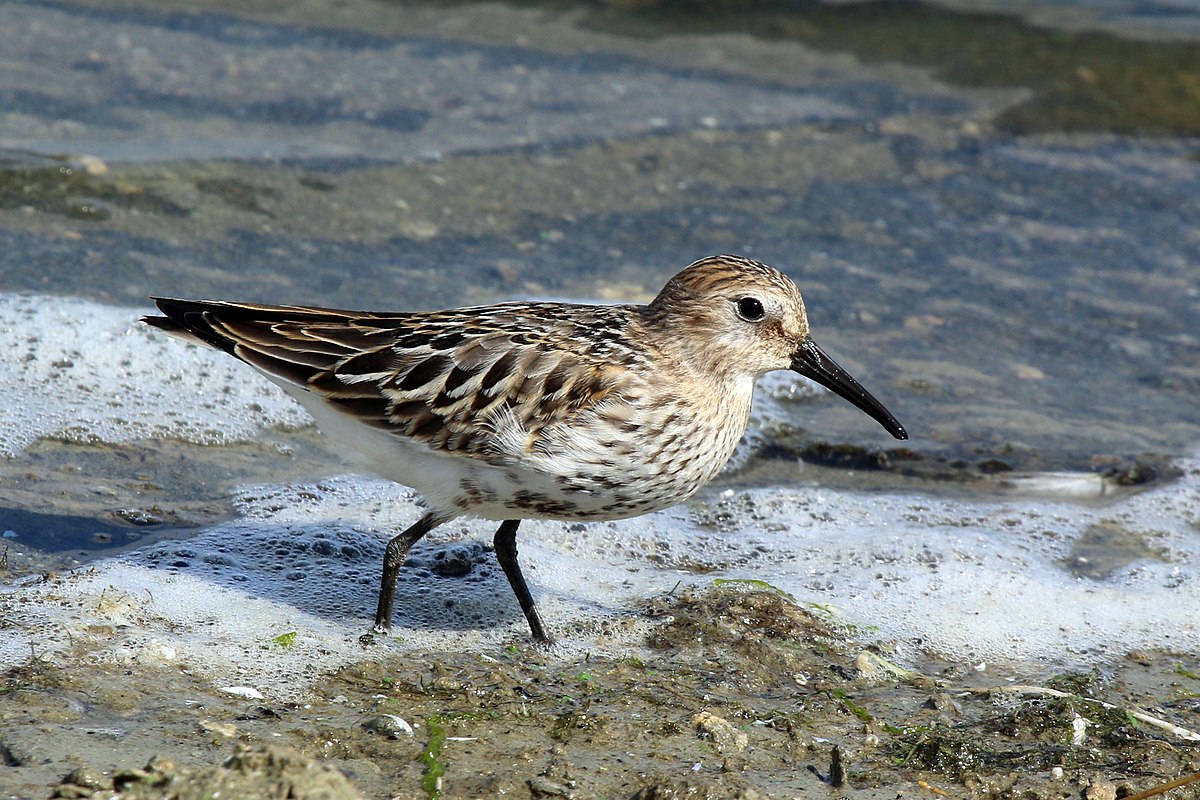
Wikipedia: Dunlin Source: OTHER
1200px-Dunlin_%28Calidris_alpina%29_juvenile.jpg
This bird appears across the great seas in the following continents:
Europe, North America, South America, Africa.
General: ![]() The dunlin (Calidris alpina) is a small wader, sometimes separated with the other "stints" in Erolia. The English name is a dialect form of "dunling", first recorded in 1531–2. It derives from dun, "dull brown", with the suffix -ling, meaning a person or thing with the given quality.[2] The genus name is from Ancient Greek kalidris or skalidris, a term used by Aristotle for some grey-coloured waterside birds. The specific alpina is from Latin and means "of high mountains", in this case referring to the Alps.[3]
[more]
The dunlin (Calidris alpina) is a small wader, sometimes separated with the other "stints" in Erolia. The English name is a dialect form of "dunling", first recorded in 1531–2. It derives from dun, "dull brown", with the suffix -ling, meaning a person or thing with the given quality.[2] The genus name is from Ancient Greek kalidris or skalidris, a term used by Aristotle for some grey-coloured waterside birds. The specific alpina is from Latin and means "of high mountains", in this case referring to the Alps.[3]
[more]
Song: ![]() Song: A drawn out, nasal "tweeet", and ringing variations on the contact call in decrescendo. Low chattering heard from feeding birds. [Link]
Song: A drawn out, nasal "tweeet", and ringing variations on the contact call in decrescendo. Low chattering heard from feeding birds. [Link]
Calls: ![]() Contact call a diagnostic, very nasal "trrreeet" . Given throughout the year and in many situations, including when being flushed. [Link]
Contact call a diagnostic, very nasal "trrreeet" . Given throughout the year and in many situations, including when being flushed. [Link]
Physical details: length=16-20 cm,
wingspan=38-43 cm,
weight=35-60 g
Habitats:
Wetland
Little stint / Zwergstrandläufer (Calidris minuta)
Profile Wikipedia eBird Vogelwarte BirdLife ZH ornitho.ch Xeno-Canto BirdID NABU

Wikipedia: Little stint Source: OTHER
Little_Stint_%28Calidris_minuta%29_2.jpg
General: ![]() The little stint (Calidris minuta) (or Erolia minuta), is a very small wader. It breeds in arctic Europe and Asia, and is a long-distance migrant, wintering south to Africa and south Asia. It occasionally is a vagrant to North America and to Australia. The genus name is from Ancient Greek kalidris or skalidris, a term used by Aristotle for some grey-coloured waterside birds. The specific minuta is Latin for "small.[2]
[more]
The little stint (Calidris minuta) (or Erolia minuta), is a very small wader. It breeds in arctic Europe and Asia, and is a long-distance migrant, wintering south to Africa and south Asia. It occasionally is a vagrant to North America and to Australia. The genus name is from Ancient Greek kalidris or skalidris, a term used by Aristotle for some grey-coloured waterside birds. The specific minuta is Latin for "small.[2]
[more]
Song: ![]() Song a cyclic series of thin "peee-peee-peee" rising and falling in pitch. [Link]
Song a cyclic series of thin "peee-peee-peee" rising and falling in pitch. [Link]
Calls: ![]() Contact call a quite soft, short, high pitched "pit". Sometimes uttered in series, or as soft chattering. [Link]
Contact call a quite soft, short, high pitched "pit". Sometimes uttered in series, or as soft chattering. [Link]
Physical details: length=12-14 cm,
wingspan=34-37 cm,
weight=18-30 g
Habitats:
Wetland
Purple sandpiper / Meerstrandläufer (Calidris maritima)
Profile Wikipedia eBird Audubon AllAboutBirds Xeno-Canto BirdID NABU
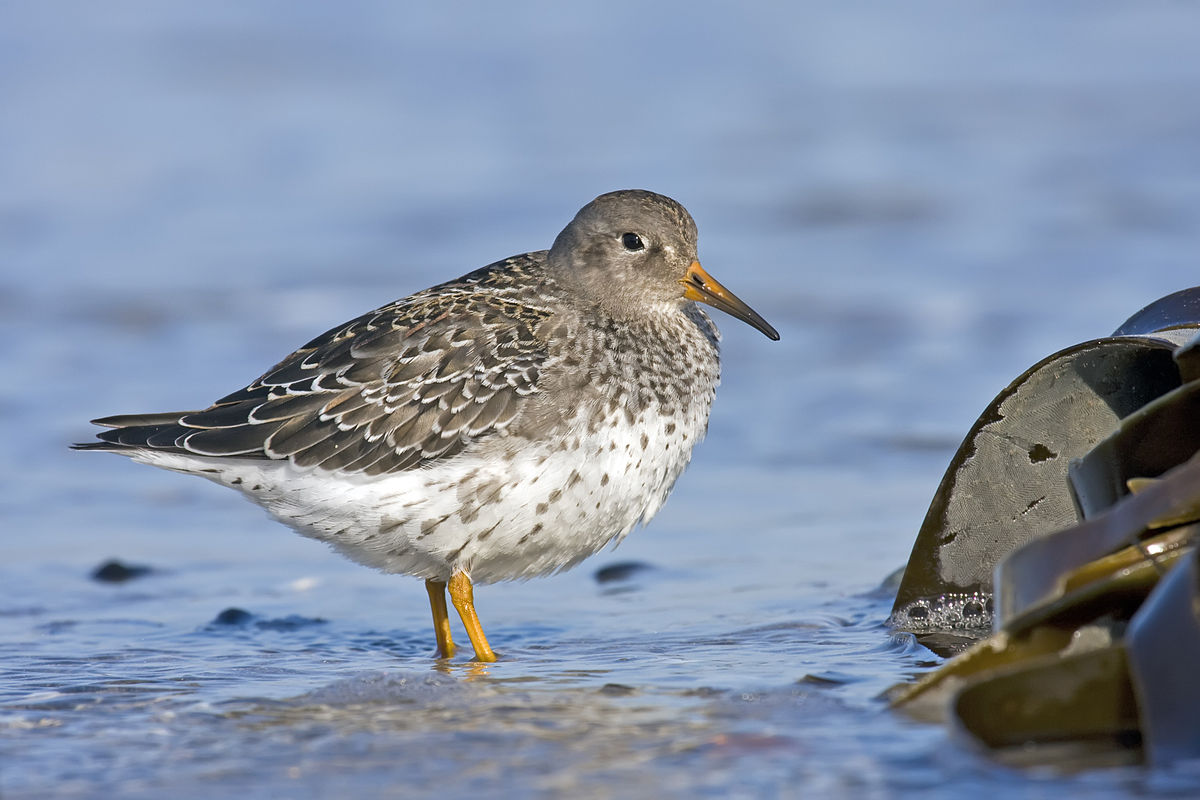
Wikipedia: Purple sandpiper Source: OTHER
1200px-Calidris_maritima.jpg
This bird appears across the great seas in the following continents:
Europe, North America.
Deutschland: Zugvogel, Wintergast
Song: ![]() Song quite varied with series of short, nasal, vibrating sounds, interspersed with drawn out, slower calls. [Link]
Song quite varied with series of short, nasal, vibrating sounds, interspersed with drawn out, slower calls. [Link]
Calls: ![]() Contact call a hoarse and hard "weet". Sometimes in chattering series. [Link]
Contact call a hoarse and hard "weet". Sometimes in chattering series. [Link]
Physical details: length=20-22 cm,
wingspan=42-46 cm,
weight=52-80 g
Eurasian curlew / Grosser Brachvogel (Numenius arquata)
Profile Wikipedia eBird Vogelwarte BirdLife ZH ornitho.ch bird-song.ch Xeno-Canto BirdID NABU
Grosser Brachvogel. 2021-02-12 11.59.24
First observed in 🇨🇭 on 2021-02-12.
In Jona findet man viele auf der Wiese unter Obstbaeumen,
anscheinend weil es dort viele Insekten und Schnecken gibt (siehe oben).
Geography: ![]() Die Brachvögel bruetet im Moment recht viel in Vergleich mit früher. [Link]
Die Brachvögel bruetet im Moment recht viel in Vergleich mit früher. [Link]
Diet: Nabu: Auf dem Speiseplan des Großen Brachvogels stehen vor allem Insekten und deren Larven und andere Kleintiere wie Schnecken und Regenwürmer, aber auch Krebstierchen. Ab und zu frisst er auch Amphibien, Reptilien oder Fische. [Link]
Song: ![]() Song starts similar to Whimbrel, with long wailing notes "kluuueee", but takes on a different ending as it accelerates to an ascending phrase repeated in rapid cycles . [Link]
Song starts similar to Whimbrel, with long wailing notes "kluuueee", but takes on a different ending as it accelerates to an ascending phrase repeated in rapid cycles . [Link]
Physical details: length=50-60 cm,
wingspan=80-100 cm,
weight=540-1300 g
Habitats:
Wetland
Song:
Automatically generated from Xeno-Canto recording
Song attributes:
Frequency:
♫ XC625195-grosser brachvogel, michal jezierski, uk. Source: XENOCANTO
XC625195-grosser brachvogel, michal jezierski, uk.mp3
(song)

Call:
![]() Das Männchen steigt mit einzelnen, klangvollen Rufen auf, die vor der Landung in einen weithin hörbaren Triller übergehen. [Link]
Das Männchen steigt mit einzelnen, klangvollen Rufen auf, die vor der Landung in einen weithin hörbaren Triller übergehen. [Link]
♫ Source: XENOCANTO
XC625195-grosser brachvogel, michal jezierski, uk.mp3
(flight call)

Call attributes:
flight call Call melody: simple rhythmic, slow, Frequency: low (1-3 KHz),
Whimbrel / Regenbrachvogel (Numenius phaeopus)
Regenbrachvogel oder Grosser Brachvogel - dunkle Schwanzfedern ein moegliches Zeichen. 2022-06-23 16.53.34 La Sauge
First observed in Canary Islands on 2022-03-19.
This bird appears across the great seas in the following continents:
Europe, North America, South America, Africa, Asia.
General: ![]() Der Regenbrachvogel (Numenius phaeopus) ist mit einer Spannweite um die 80 cm viel kleiner als der Große Brachvogel, auch der Schnabel ist kürzer und der Oberkopf ist hell und dunkel gestreift. Der Ruf dieser Vogelart ähnelt einem hellen Trillern.
[more]
Der Regenbrachvogel (Numenius phaeopus) ist mit einer Spannweite um die 80 cm viel kleiner als der Große Brachvogel, auch der Schnabel ist kürzer und der Oberkopf ist hell und dunkel gestreift. Der Ruf dieser Vogelart ähnelt einem hellen Trillern.
[more]
Song: ![]() Song starts similar to Curlew with long wailing notes "kluuueee", which then accelerates to a continuous, vibrating single note. Lacks the cyclic phrase ending of Curlew. [Link]
Song starts similar to Curlew with long wailing notes "kluuueee", which then accelerates to a continuous, vibrating single note. Lacks the cyclic phrase ending of Curlew. [Link]
Physical details: length=40-42 cm,
wingspan=76-89 cm,
weight=300-660 g
Habitats:
Wetland
Ruddy turnstone / Steinwälzer (Arenaria interpres)
Ruddy turnstone near Las Coloradas. 2023-04-15 10.06.32 Yucatan
First observed in Canary Islands on 2022-03-19.
This bird appears across the great seas in the following continents:
Europe, North America, South America, Africa, Asia.
General: ![]() The ruddy turnstone (Arenaria interpres) is a small wading bird, one of two species of turnstone in the genus Arenaria. The scientific name is from Latin. The genus name arenaria derives from arenarius, "inhabiting sand, from arena, "sand". The specific interpres means "messenger"; when visiting Gotland in 1741, Linnaeus thought that the Swedish word Tolk "interpreter" applied to this species, but in the local dialect the word means "legs" and is used for the redshank.[2]
[more]
The ruddy turnstone (Arenaria interpres) is a small wading bird, one of two species of turnstone in the genus Arenaria. The scientific name is from Latin. The genus name arenaria derives from arenarius, "inhabiting sand, from arena, "sand". The specific interpres means "messenger"; when visiting Gotland in 1741, Linnaeus thought that the Swedish word Tolk "interpreter" applied to this species, but in the local dialect the word means "legs" and is used for the redshank.[2]
[more]
Song: ![]() Alarm call/song more "wader-like", a staccato "kuvi-kuvi-vit-vit-vitua". [Link]
Alarm call/song more "wader-like", a staccato "kuvi-kuvi-vit-vit-vitua". [Link]
Calls: ![]() Characteristic call: An explosive, hard, resonant and short "koi" or "kott" with a peculiar timbre, usually given in rapid or accelerating series. [Link]
Characteristic call: An explosive, hard, resonant and short "koi" or "kott" with a peculiar timbre, usually given in rapid or accelerating series. [Link]
Physical details: length=22-24 cm,
wingspan=50-57 cm,
weight=85-150 g
Habitats:
Wetland
Eurasian woodcock / Waldschnepfe (Scolopax rusticola)
Profile Wikipedia eBird Vogelwarte BirdLife ZH ornitho.ch bird-song.ch Xeno-Canto BirdID NABU

Wikipedia: Eurasian woodcock Source: OTHER
Scolopax_rusticola.jpg
Deutschland: Brut-, Jahres-, Zugvogel, Wintergast RL V
Vocalization: ![]() Sometimes give a snipe-like hoarse "raaat" when flushed. Male display flight at night distinctive. [Link]
Sometimes give a snipe-like hoarse "raaat" when flushed. Male display flight at night distinctive. [Link]
Calls: ![]() Flies above treetops while calling with 3-5 deep croaking grunts, followed by an explosive high-pitched sneeze, "psst". [Link]
Flies above treetops while calling with 3-5 deep croaking grunts, followed by an explosive high-pitched sneeze, "psst". [Link]
Physical details: length=33-35 cm,
wingspan=56-60 cm,
weight=131-420 g
Habitats:
Forest
Common snipe / Bekassine (Gallinago gallinago)
Rechts nach Links - drei Bekassinen, Kiebitz, Krickenten. 2021-10-24 10.34.58 Neeracherried
First observed in 🇨🇭 on 2021-10-24.
This bird appears across the great seas in the following continents:
Europe, North America, Africa, Asia.
Deutschland: Brut-, Zugvogel, Wintergast RL 1
Vocalization: ![]() Quite vocal, especially at breeding ground. [Link]
Quite vocal, especially at breeding ground. [Link]
Song: ![]() Song an unmistakable bleating, drumming sound produced by vibrating tail feathers in sky-dives. [Link]
Song an unmistakable bleating, drumming sound produced by vibrating tail feathers in sky-dives. [Link]
Calls: ![]() Almost always give diagnostic hoarse and nasal "kaaat" call when flushed. Another territorial call is a rhythmic, mechanical and sharp "tika-tika-tka", or "ika-ka-ka". [Link]
Almost always give diagnostic hoarse and nasal "kaaat" call when flushed. Another territorial call is a rhythmic, mechanical and sharp "tika-tika-tka", or "ika-ka-ka". [Link]
Physical details: length=25-27 cm,
wingspan=44-47 cm,
weight=80-140 g
Habitats:
Wetland
Jack snipe / Zwergschnepfe (Lymnocryptes minimus)
Profile Wikipedia eBird Vogelwarte BirdLife ZH ornitho.ch Xeno-Canto BirdID NABU

Wikipedia: Jack snipe Source: OTHER
1200px-Lymnocryptes_minimus.jpg
Deutschland: ehemaliger Brutvogel, Zugvogel, Wintergast
Vocalization: ![]() May occasionally give a harsh, nasal and rolling "reearrr" when flushed, but is usually silent. "Galloping" interspersed with cyclic, whistling, hissing sounds. Hard to locate when displaying. Seems both close and distant at the same time. [Link]
May occasionally give a harsh, nasal and rolling "reearrr" when flushed, but is usually silent. "Galloping" interspersed with cyclic, whistling, hissing sounds. Hard to locate when displaying. Seems both close and distant at the same time. [Link]
Calls: ![]() Display call a peculiar, cyclic and rhythmic sound performed in flight. Recalling a galloping horse in the distance. [Link]
Display call a peculiar, cyclic and rhythmic sound performed in flight. Recalling a galloping horse in the distance. [Link]
Physical details: length=17-19 cm,
wingspan=38-42 cm,
weight=35-73 g
Habitats:
Wetland
Bar-tailed godwit / Pfuhlschnepfe (Limosa lapponica)
Profile Wikipedia eBird Vogelwarte BirdLife ZH ornitho.ch Audubon AllAboutBirds Xeno-Canto NABU

Wikipedia: Bar-tailed godwit Source: OTHER
1200px-Bar-tailed_Godwit.jpg
This bird appears across the great seas in the following continents:
Europe, North America, Africa, Asia.
Seasonal Behavior: Other: Eine junge Pfuhlschnepfe scheint einen Non-Stop-Rekord für Zugvögel aufgestellt zu haben. Der Vogel sei über 13.500 Kilometer von Alaska in den australischen Bundesstaat Tasmanien geflogen, das berichteten mehrere Medien übereinstimmend. [Link]
Habitats:
Wetland
Black-tailed godwit / Uferschnepfe (Limosa limosa)
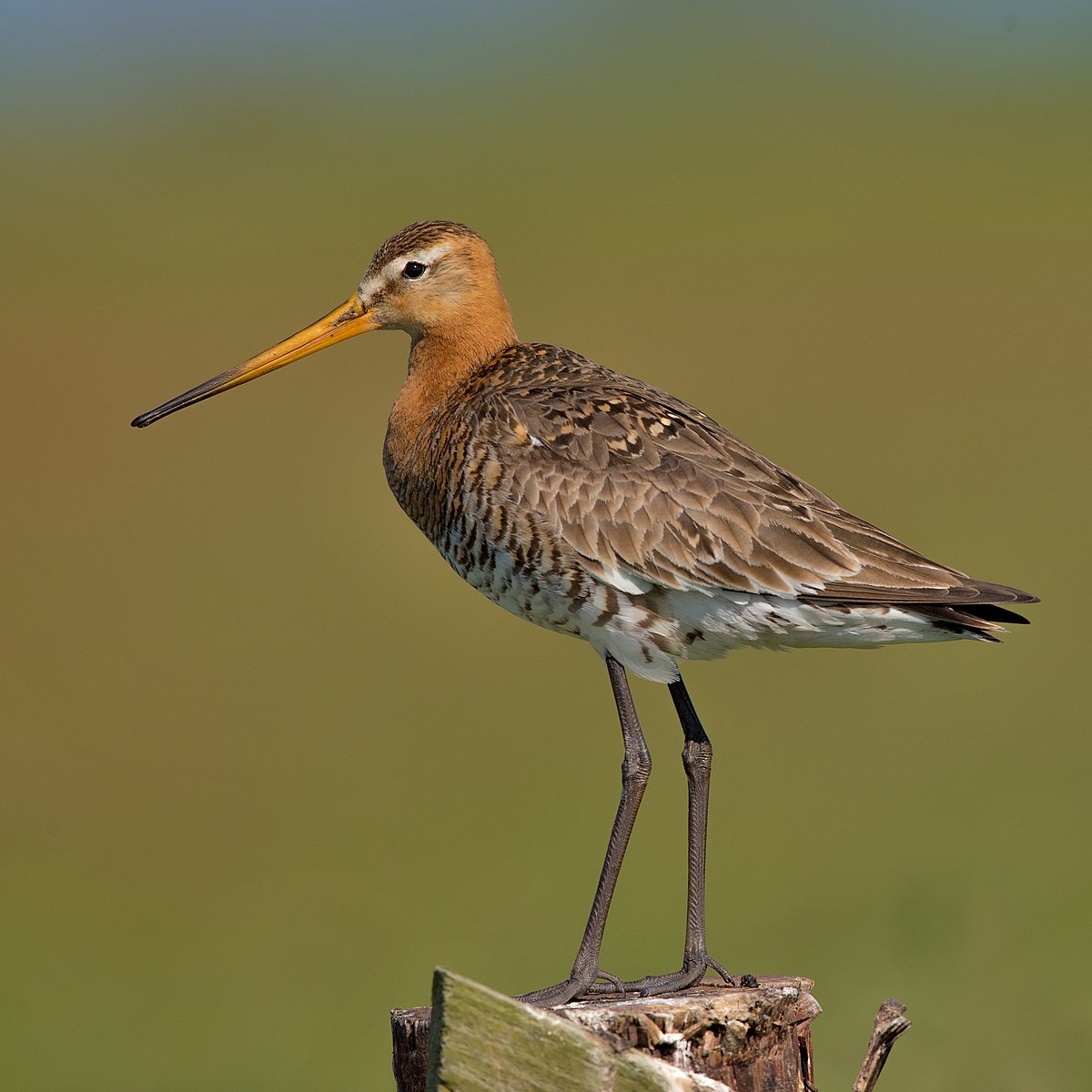
Wikipedia: Black-tailed godwit Source: OTHER
1200px-Black-tailed_Godwit_Uferschnepfe.jpg
This bird appears across the great seas in the following continents:
Europe, North America, Africa, Asia.
General: ![]() The black-tailed godwit (Limosa limosa) is a large, long-legged, long-billed shorebird first described by Carl Linnaeus in 1758. It is a member of the godwit genus, Limosa. There are three subspecies, all with orange head, neck and chest in breeding plumage and dull grey-brown winter coloration, and distinctive black and white wingbar at all times.
[more]
The black-tailed godwit (Limosa limosa) is a large, long-legged, long-billed shorebird first described by Carl Linnaeus in 1758. It is a member of the godwit genus, Limosa. There are three subspecies, all with orange head, neck and chest in breeding plumage and dull grey-brown winter coloration, and distinctive black and white wingbar at all times.
[more]
Habitats:
Wetland
Common redshank / Rotschenkel (Tringa totanus)
Profile Wikipedia eBird Vogelwarte BirdLife ZH ornitho.ch Xeno-Canto BirdID NABU
Common redshank plus common pochard. 2022-04-12 14.02.38 Mallorca
First observed in Mallorca on 2022-04-12.
![]() The common redshank or simply redshank (Tringa totanus) is a Eurasian wader in the large family Scolopacidae. The genus name Tringa is the New Latin name given to the green sandpiper by Aldrovandus in 1599 based on Ancient Greek trungas, a thrush-sized, white-rumped, tail-bobbing wading bird mentioned by Aristotle. The specific totanus is from Tótano, the Italian name for this bird.[2]
[more]
The common redshank or simply redshank (Tringa totanus) is a Eurasian wader in the large family Scolopacidae. The genus name Tringa is the New Latin name given to the green sandpiper by Aldrovandus in 1599 based on Ancient Greek trungas, a thrush-sized, white-rumped, tail-bobbing wading bird mentioned by Aristotle. The specific totanus is from Tótano, the Italian name for this bird.[2]
[more]
Vocalization: ![]() Generally a noisy and loud bird, especially at breeding ground. Most heard is a characteristic "tew-hoo", or "tew-hoo-hoo" with first syllable accentuated. No gap between the syllables like Greenshank, and usually with a marked falling pitch. [Link]
Generally a noisy and loud bird, especially at breeding ground. Most heard is a characteristic "tew-hoo", or "tew-hoo-hoo" with first syllable accentuated. No gap between the syllables like Greenshank, and usually with a marked falling pitch. [Link]
Song: ![]() Song similar to Wood Sandpiper, but with three accented notes in each cycle, not two. [Link]
Song similar to Wood Sandpiper, but with three accented notes in each cycle, not two. [Link]
Physical details: length=27-29 cm,
wingspan=59-66 cm,
weight=85-150 g
Habitats:
Wetland
Wood sandpiper / Bruchwasserläufer (Tringa glareola)
Profile Wikipedia eBird Vogelwarte BirdLife ZH ornitho.ch Audubon AllAboutBirds Xeno-Canto BirdID NABU

Wikipedia: Wood sandpiper Source: OTHER
1200px-Wood_Sandpiper_Safari_Park.jpg
First observed in 🇨🇭 on 2021-08-19.
This bird appears across the great seas in the following continents:
Europe, North America, Africa, Asia.
General: ![]() The wood sandpiper (Tringa glareola) is a small wader. This Eurasian species is the smallest of the shanks, which are mid-sized long-legged waders of the family Scolopacidae. The genus name Tringa is the New Latin name given to the green sandpiper by Aldrovandus in 1599 based on Ancient Greek trungas, a thrush-sized, white-rumped, tail-bobbing wading bird mentioned by Aristotle. The specific glareola is from Latin glarea, " gravel".[2]
[more]
The wood sandpiper (Tringa glareola) is a small wader. This Eurasian species is the smallest of the shanks, which are mid-sized long-legged waders of the family Scolopacidae. The genus name Tringa is the New Latin name given to the green sandpiper by Aldrovandus in 1599 based on Ancient Greek trungas, a thrush-sized, white-rumped, tail-bobbing wading bird mentioned by Aristotle. The specific glareola is from Latin glarea, " gravel".[2]
[more]
Vocalization: ![]() Totally different from Green Sandpiper. [Link]
Totally different from Green Sandpiper. [Link]
Calls: ![]() Flight call a soft, but explosive "whiff whiff" , sometimes with only one syllable. Display call similar to redshank but with only two accented beats; a fast melodious "dee-loo", repeated in cycles. [Link]
Flight call a soft, but explosive "whiff whiff" , sometimes with only one syllable. Display call similar to redshank but with only two accented beats; a fast melodious "dee-loo", repeated in cycles. [Link]
Physical details: length=19-21 cm,
wingspan=56-57 cm,
weight=50-80 g
Habitats:
Wetland
Song:
Automatically generated from Xeno-Canto recording
Song attributes:
Frequency:
♫ Source: BirdNet
20210819_082604 birdnet 1940 - Wood Sandpiper, saw a bird flying, check reports in Ornitho - Wood Sandpiper - Uznach.mp3
2021-08-19 08.26.04 Uznach (song)
Spotted redshank / Dunkler Wasserläufer (Tringa erythropus)
Profile Wikipedia eBird Vogelwarte BirdLife ZH ornitho.ch Xeno-Canto BirdID NABU
Dunkler Wasserlaeufer. 2021-10-24 10.25.42 Neeracherried
First observed in 🇨🇭 on 2021-10-24.
General: ![]() The spotted redshank (Tringa erythropus) is a wader (shorebird) in the large bird family Scolopacidae. The genus name Tringa is the New Latin name given to the green sandpiper by Aldrovandus in 1599 based on Ancient Greek trungas, a thrush-sized, white-rumped, tail-bobbing wading bird mentioned by Aristotle. The specific erythropus is from Ancient Greek eruthros, "red", and pous, "foot".[2]
[more]
The spotted redshank (Tringa erythropus) is a wader (shorebird) in the large bird family Scolopacidae. The genus name Tringa is the New Latin name given to the green sandpiper by Aldrovandus in 1599 based on Ancient Greek trungas, a thrush-sized, white-rumped, tail-bobbing wading bird mentioned by Aristotle. The specific erythropus is from Ancient Greek eruthros, "red", and pous, "foot".[2]
[more]
Calls: ![]() Flight call loud and diagnostic, and is often the first sign of the species' presence; a sharp and short, disyllabic "koo-eett", with the first syllable falling in pitch and the second rising sharply. Display call a squeaky, but melodic "krroo-lee-ooo" repeated in cycles. Alarm call a falcon-like "ke-ke-ke-ke". [Link]
Flight call loud and diagnostic, and is often the first sign of the species' presence; a sharp and short, disyllabic "koo-eett", with the first syllable falling in pitch and the second rising sharply. Display call a squeaky, but melodic "krroo-lee-ooo" repeated in cycles. Alarm call a falcon-like "ke-ke-ke-ke". [Link]
Physical details: length=29-31 cm,
wingspan=61-67 cm,
weight=125-210 g
Habitats:
Wetland
Green sandpiper / Waldwasserläufer (Tringa ochropus)
Profile Wikipedia eBird Vogelwarte BirdLife ZH ornitho.ch Xeno-Canto BirdID NABU
Waldwasserlaeufer. 2023-07-08 19.09.34 Neeracherried
First observed in 🇨🇭 on 2022-09-04.
General: ![]() The green sandpiper (Tringa ochropus) is a small wader (shorebird) of the Old World. The genus name Tringa is the New Latin name given to the green sandpiper by Aldrovandus in 1599 based on Ancient Greek trungas, a thrush-sized, white-rumped, tail-bobbing wading bird mentioned by Aristotle. The specific ochropus is from Ancient Greek okhros, "ochre", and pous, "foot".[2]
[more]
The green sandpiper (Tringa ochropus) is a small wader (shorebird) of the Old World. The genus name Tringa is the New Latin name given to the green sandpiper by Aldrovandus in 1599 based on Ancient Greek trungas, a thrush-sized, white-rumped, tail-bobbing wading bird mentioned by Aristotle. The specific ochropus is from Ancient Greek okhros, "ochre", and pous, "foot".[2]
[more]
Vocalization: ![]() Totally different from Wood Sandpiper. [Link]
Totally different from Wood Sandpiper. [Link]
Calls: ![]() Sharp, penetrating calls. Display call a high-pitched "kee-kleeoo-eet", continuously repeated with a wave-like motion in pitch. Other common calls have similar timbre and tone with different phrasing like; "klooeett -klee-klee-klee-klee-klee" and a rising pitch. [Link]
Sharp, penetrating calls. Display call a high-pitched "kee-kleeoo-eet", continuously repeated with a wave-like motion in pitch. Other common calls have similar timbre and tone with different phrasing like; "klooeett -klee-klee-klee-klee-klee" and a rising pitch. [Link]
Physical details: length=21-24 cm,
wingspan=57-61 cm,
weight=60-90 g
Habitats:
Wetland
Common greenshank / Grünschenkel (Tringa nebularia)
Profile Wikipedia eBird Vogelwarte BirdLife ZH ornitho.ch Audubon AllAboutBirds Xeno-Canto BirdID NABU
MerlinBirdID says common greenshank, probably non-breeding adult. 2022-04-12 14.52.08 Mallorca
First observed in Mallorca on 2022-04-12.
This bird appears across the great seas in the following continents:
Europe, North America, Africa, Asia.
General: ![]() The common greenshank (Tringa nebularia) is a wader in the large family Scolopacidae, the typical waders. The genus name Tringa is the New Latin name given to the green sandpiper by Aldrovandus in 1599 based on Ancient Greek trungas, a thrush-sized, white-rumped, tail-bobbing wading bird mentioned by Aristotle. The specific nebularia is from Latin nebula "mist". Like the Norwegian Skoddefoll, this refers to the greenshank's damp marshy habitat.[2]
[more]
The common greenshank (Tringa nebularia) is a wader in the large family Scolopacidae, the typical waders. The genus name Tringa is the New Latin name given to the green sandpiper by Aldrovandus in 1599 based on Ancient Greek trungas, a thrush-sized, white-rumped, tail-bobbing wading bird mentioned by Aristotle. The specific nebularia is from Latin nebula "mist". Like the Norwegian Skoddefoll, this refers to the greenshank's damp marshy habitat.[2]
[more]
Vocalization: ![]() Most heard is a characteristic, trisyllabic "tew-tew-tew" (sometimes two or four syllables). Can resemble redshank, but pitch more stable, and not falling notably. Each syllable is clearly separated and equally emphasized. [Link]
Most heard is a characteristic, trisyllabic "tew-tew-tew" (sometimes two or four syllables). Can resemble redshank, but pitch more stable, and not falling notably. Each syllable is clearly separated and equally emphasized. [Link]
Song: ![]() Song a clear disyllabic "cloo-eeee", repeated in cycles but each phrase clearly separated. At close range a short creaky sound is audible (between each phrase). Redshank may sing in a slightly similar way, but in continuous, linked phrases. [Link]
Song a clear disyllabic "cloo-eeee", repeated in cycles but each phrase clearly separated. At close range a short creaky sound is audible (between each phrase). Redshank may sing in a slightly similar way, but in continuous, linked phrases. [Link]
Physical details: length=30-33 cm,
wingspan=68-70 cm,
weight=130-270 g
Habitats:
Wetland
Common sandpiper / Flussuferläufer (Actitis hypoleucos)
MerlinBirdID meint Flussuferläufer. 2022-09-04 07.49.06 Neeracherried
First observed in 🇨🇭 on 2022-09-04.
This bird appears across the great seas in the following continents:
Europe, North America, Africa, Asia.
General: ![]() The common sandpiper (Actitis hypoleucos) is a small Palearctic wader. This bird and its American sister species, the spotted sandpiper (A. macularia), make up the genus Actitis. They are parapatric and replace each other geographically; stray birds of either species may settle down with breeders of the other and hybridize. Hybridization has also been reported between the common sandpiper and the green sandpiper, a basal species of the closely related shank genus Tringa.
[more]
The common sandpiper (Actitis hypoleucos) is a small Palearctic wader. This bird and its American sister species, the spotted sandpiper (A. macularia), make up the genus Actitis. They are parapatric and replace each other geographically; stray birds of either species may settle down with breeders of the other and hybridize. Hybridization has also been reported between the common sandpiper and the green sandpiper, a basal species of the closely related shank genus Tringa.
[more]
Calls: ![]() Very vocal with characteristic repertoire of very high-pitched calls. Often heard is a disyllabic call, drawn out and slightly rising in pitch in the second part. This is often repeated in a series of rising tones in a cyclic manner, with approx 5 tones in each cycle. [Link]
Very vocal with characteristic repertoire of very high-pitched calls. Often heard is a disyllabic call, drawn out and slightly rising in pitch in the second part. This is often repeated in a series of rising tones in a cyclic manner, with approx 5 tones in each cycle. [Link]
Physical details: length=19-21 cm,
wingspan=38-41 cm,
weight=40-60 g
Habitats:
Wetland
Red phalarope / Thorshühnchen (Phalaropus fulicarius)

Wikipedia: Red phalarope Source: OTHER
1200px-Phalaropus_fulicarius_10.jpg
This bird appears across the great seas in the following continents:
Europe, North America, South America, Africa.
General: ![]() The red phalarope or grey phalarope (Phalaropus fulicarius) is a small wader. This phalarope breeds in the Arctic regions of North America and Eurasia. It is migratory, and, unusually for a wader, migrating mainly on oceanic routes and wintering at sea on tropical oceans.
[more]
The red phalarope or grey phalarope (Phalaropus fulicarius) is a small wader. This phalarope breeds in the Arctic regions of North America and Eurasia. It is migratory, and, unusually for a wader, migrating mainly on oceanic routes and wintering at sea on tropical oceans.
[more]
Calls: ![]() Flight-call a short and sharp, Coot-like "kit". Cleaner and higher pitched than Red-necked Phalarope. Display sound a rolling cooing, at stable pitch. Other calls: a hissing like the squeezing of a rubber duck, rising quickly in pitch and ending abruptly. [Link]
Flight-call a short and sharp, Coot-like "kit". Cleaner and higher pitched than Red-necked Phalarope. Display sound a rolling cooing, at stable pitch. Other calls: a hissing like the squeezing of a rubber duck, rising quickly in pitch and ending abruptly. [Link]
Physical details: length=20-22 cm,
wingspan=40-44 cm,
weight=40-75 g
Common tern / Flussseeschwalbe (Sterna hirundo)
Profile Wikipedia eBird Vogelwarte BirdLife ZH ornitho.ch bird-song.ch Audubon AllAboutBirds Xeno-Canto BirdID NABU
First observed in 🇨🇭 on 2020-04-27.
This bird appears across the great seas in the following continents:
Europe, North America, South America, Africa, Asia.
Seasonal Behavior: ![]() Die Flussseeschwalbe (Sterna hirundo) ist eine Vogelart aus der Familie der Seeschwalben (Sternidae).
Sie ist in Mitteleuropa ein verbreiteter, aber nicht sehr häufiger Brut- und Sommervogel.
Während der Zugzeiten können im mitteleuropäischen Raum außerdem viele Durchzügler beobachtet werden. [Link]
Die Flussseeschwalbe (Sterna hirundo) ist eine Vogelart aus der Familie der Seeschwalben (Sternidae).
Sie ist in Mitteleuropa ein verbreiteter, aber nicht sehr häufiger Brut- und Sommervogel.
Während der Zugzeiten können im mitteleuropäischen Raum außerdem viele Durchzügler beobachtet werden. [Link]
Vocalization: ![]() Similar to Arctic Tern but deeper. [Link]
Similar to Arctic Tern but deeper. [Link]
Calls: ![]() Lacks latter's high pitched "tip-tip-tip" call, and the drawn out "kree-aaahh" call falls more distinctly in pitch. [Link]
Lacks latter's high pitched "tip-tip-tip" call, and the drawn out "kree-aaahh" call falls more distinctly in pitch. [Link]
Physical details: length=31-35 cm,
wingspan=77-98 cm,
weight=110-150 g
Habitats:
River and lake
Song:
Automatically generated from Xeno-Canto recording
Song attributes:
Frequency:
♫ Source: BirdNet
20200427_140813 birdnet 430 - Common tern.mp3
2020-04-27 14.08.13 Luppmen (song)
Arctic tern / Kü̈stenseeschwalbe (Sterna paradisaea)
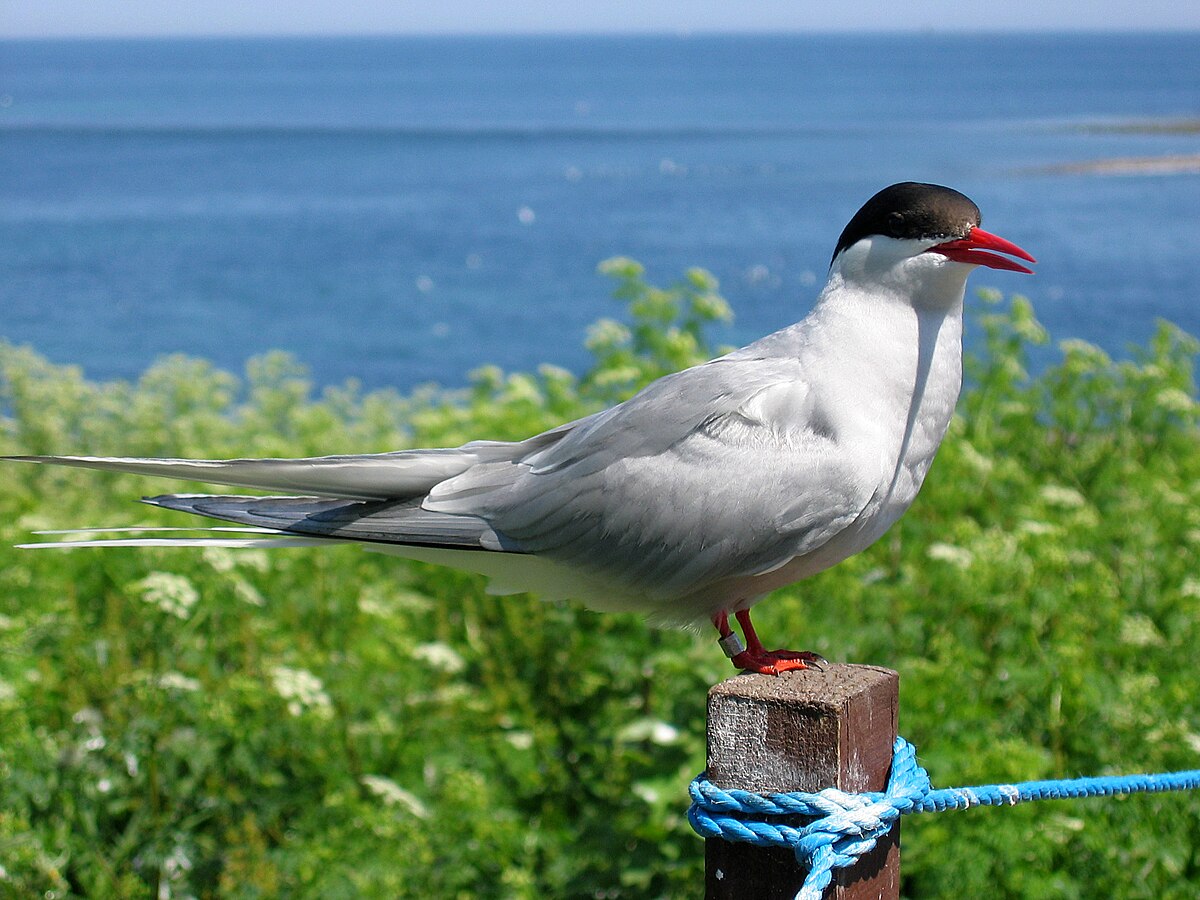
Wikipedia: Arctic tern Source: OTHER
1200px-2009_07_02_-_Arctic_tern_on_Farne_Islands_-_The_blue_rope_demarcates_the_visitors%27_path.JPG
This bird appears across the great seas in the following continents:
Europe, North America, South America, Africa.
General: ![]() The Arctic tern (Sterna paradisaea) is a tern in the family Laridae. This bird has a circumpolar breeding distribution covering the Arctic and sub-Arctic regions of Europe, Asia, and North America (as far south as Brittany and Massachusetts). The species is strongly migratory, seeing two summers each year as it migrates along a convoluted route from its northern breeding grounds to the Antarctic coast for the southern summer and back again about six months later. Recent studies have shown average annual roundtrip lengths of about 70,900 km (44,100 mi) for birds nesting in Iceland and Greenland[3] and about 90,000 km (56,000 mi) for birds nesting in the Netherlands.[4] These are by far the longest migrations known in the animal kingdom. The Arctic tern flies as well as glides through the air. It nests once every one to three years (depending on its mating cycle); once it has finished nesting it takes to the sky for another long southern migration.
[more]
The Arctic tern (Sterna paradisaea) is a tern in the family Laridae. This bird has a circumpolar breeding distribution covering the Arctic and sub-Arctic regions of Europe, Asia, and North America (as far south as Brittany and Massachusetts). The species is strongly migratory, seeing two summers each year as it migrates along a convoluted route from its northern breeding grounds to the Antarctic coast for the southern summer and back again about six months later. Recent studies have shown average annual roundtrip lengths of about 70,900 km (44,100 mi) for birds nesting in Iceland and Greenland[3] and about 90,000 km (56,000 mi) for birds nesting in the Netherlands.[4] These are by far the longest migrations known in the animal kingdom. The Arctic tern flies as well as glides through the air. It nests once every one to three years (depending on its mating cycle); once it has finished nesting it takes to the sky for another long southern migration.
[more]
Vocalization: ![]() Similar to Common Tern but higher pitched. [Link]
Similar to Common Tern but higher pitched. [Link]
Calls: ![]() Typical call a series of high pitched "tip-tip-tip", and longer, ringing, high-pitched "kriiiiii" calls. The drawn out "kree-aaahh" call falls less distinctly in pitch than Common Tern. [Link]
Typical call a series of high pitched "tip-tip-tip", and longer, ringing, high-pitched "kriiiiii" calls. The drawn out "kree-aaahh" call falls less distinctly in pitch than Common Tern. [Link]
Physical details: length=33-35 cm,
wingspan=75-85 cm,
weight=95-120 g
Common murre / Trottellumme (Uria aalge)

Wikipedia: Common murre Source: OTHER
1200px-Guillemots_on_Bear_Island_Svalbard_Arctic_%2819659642914%29.jpg
This bird appears across the great seas in the following continents:
Europe, North America, Africa.
Deutschland: Brut-, Jahres-, Zugvogel, Wintergast RL R
Vocalization: ![]() Very coarse and deep voice. [Link]
Very coarse and deep voice. [Link]
Calls: ![]() Typically rising in pitch, then ending on a prolonged stable note with a laughing quality. Sometimes only the coarse beginning uttered like "ga-ga-ga". [Link]
Typically rising in pitch, then ending on a prolonged stable note with a laughing quality. Sometimes only the coarse beginning uttered like "ga-ga-ga". [Link]
Physical details: length=38-41 cm,
wingspan=64-70 cm,
weight=490-863 g
Razorbill / Tordalk (Alca torda)
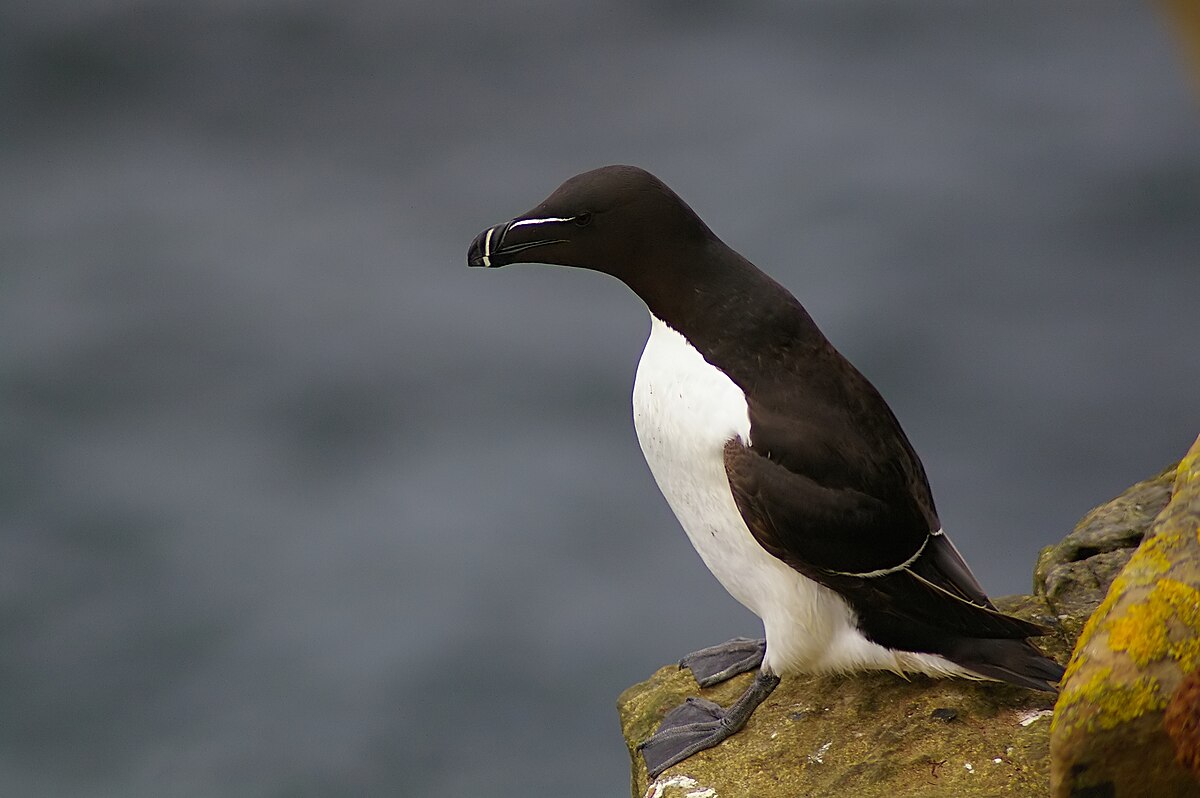
Wikipedia: Razorbill Source: OTHER
1200px-Alca_torda_Caithness%2C_Scotland.jpg
This bird appears across the great seas in the following continents:
Europe, North America, Africa.
Deutschland: Brut-, Jahresvogel, Wintergast RL R
Vocalization: ![]() Very coarse and deep voice. Grunting or snore-like, with little phrasing. Mostly heard at breeding ground, but also sometimes at sea. [Link]
Very coarse and deep voice. Grunting or snore-like, with little phrasing. Mostly heard at breeding ground, but also sometimes at sea. [Link]
Physical details: length=37-39 cm,
wingspan=63-68 cm,
weight=524-890 g
Dovekie / Krabbentaucher (Alle alle)

Wikipedia: Dovekie Source: OTHER
1200px-Little_Auk_%28js%29_24.jpg
This bird appears across the great seas in the following continents:
Europe, North America.
Deutschland: Zugvogel, Wintergast
Vocalization: ![]() Voice higher pitched than other auks (except Black Guillemot). Trilling, rolling and chattering laughter "kreeee he he he he", or shorter, softer utterances; "ke ke" or "hup hup". [Link]
Voice higher pitched than other auks (except Black Guillemot). Trilling, rolling and chattering laughter "kreeee he he he he", or shorter, softer utterances; "ke ke" or "hup hup". [Link]
Physical details: length=17-19 cm,
wingspan=40-48 cm,
weight=140-190 g
Black guillemot / Gryllteiste (Cepphus grylle)
Profile Wikipedia eBird Audubon AllAboutBirds Xeno-Canto BirdID NABU

Wikipedia: Black guillemot Source: OTHER
Tystie1.jpg
This bird appears across the great seas in the following continents:
Europe, North America.
Deutschland: seltener Wintergast
Calls: ![]() Call surprisingly high pitched. Quite pure, drawn out, plaintive whistling notes in same pitch range as Hazel Grouse. [Link]
Call surprisingly high pitched. Quite pure, drawn out, plaintive whistling notes in same pitch range as Hazel Grouse. [Link]
Physical details: length=30-32 cm,
wingspan=52-58 cm,
weight=340-500 g
Atlantic puffin (Fratercula arctica)
Profile Wikipedia eBird Audubon AllAboutBirds Xeno-Canto BirdID NABU

Wikipedia: Atlantic puffin Source: OTHER
1200px-Puffin_%28Fratercula_arctica%29.jpg
This bird appears across the great seas in the following continents:
Europe, North America, Africa.
General: ![]() The Atlantic puffin (Fratercula arctica), also known as the common puffin, is a species of seabird in the auk family. It is the only puffin native to the Atlantic Ocean; two related species, the tufted puffin and the horned puffin, are found in the northeastern Pacific. The Atlantic puffin breeds in Québec, Iceland, Norway, Greenland, Newfoundland and Labrador, Nova Scotia and the Faroe Islands, and as far south as Maine in the west and France in the east. The Atlantic Puffin is most commonly found on the Westman Islands, Iceland. Although it has a large population and a wide range, the species has declined rapidly, at least in parts of its range, resulting in it being rated as vulnerable by the IUCN. On land, it has the typical upright stance of an auk. At sea, it swims on the surface and feeds mainly on small fish, which it catches by diving under water, using its wings for propulsion.
[more]
The Atlantic puffin (Fratercula arctica), also known as the common puffin, is a species of seabird in the auk family. It is the only puffin native to the Atlantic Ocean; two related species, the tufted puffin and the horned puffin, are found in the northeastern Pacific. The Atlantic puffin breeds in Québec, Iceland, Norway, Greenland, Newfoundland and Labrador, Nova Scotia and the Faroe Islands, and as far south as Maine in the west and France in the east. The Atlantic Puffin is most commonly found on the Westman Islands, Iceland. Although it has a large population and a wide range, the species has declined rapidly, at least in parts of its range, resulting in it being rated as vulnerable by the IUCN. On land, it has the typical upright stance of an auk. At sea, it swims on the surface and feeds mainly on small fish, which it catches by diving under water, using its wings for propulsion.
[more]
Vocalization: ![]() Deep, but not so coarse as Razorbill. Smoother and more gliding changes in pitch, like a "slow-motion" laugh or distant chainsaw; "aaaahrrr, aahr, ahr arh". [Link]
Deep, but not so coarse as Razorbill. Smoother and more gliding changes in pitch, like a "slow-motion" laugh or distant chainsaw; "aaaahrrr, aahr, ahr arh". [Link]
Physical details: length=26-29 cm,
wingspan=47-63 cm,
weight=320-480 g
Eurasian oystercatcher / Austernfischer (Haematopus ostralegus)
Profile Wikipedia eBird Vogelwarte BirdLife ZH ornitho.ch Xeno-Canto BirdID NABU
Eurasian oystercatcher, Iceland. 2015-06-09 14.05.20 Iceland
First observed in Iceland on 2015-06-09.
Etymology: Bbc2: A flock of oyster catchers is a parcel [A nugget from Winterwatch 2022, episode 1, from BBC 2]
Vocalization: ![]() Very vocal. [Link]
Very vocal. [Link]
Calls: ![]() Sharp, loud and far carrying, disyllabic or monosyllabic calls "ku-eek" or "kleek". Often works itself up into a crescendos of fast, piping calls, and then mellows out. [Link]
Sharp, loud and far carrying, disyllabic or monosyllabic calls "ku-eek" or "kleek". Often works itself up into a crescendos of fast, piping calls, and then mellows out. [Link]
Physical details: length=40-45 cm,
wingspan=80-86 cm,
weight=430-650 g
Habitats:
Wetland
Pomarine jaeger / Spatelraubmöwe (Stercorarius pomarinus)
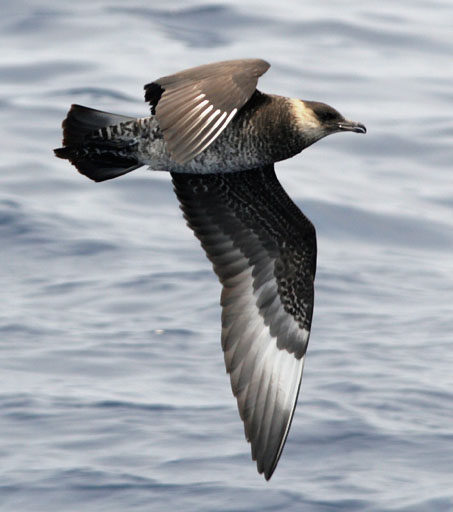
Wikipedia: Pomarine jaeger Source: OTHER
Stercorarius_pomarinusPCCA20070623-3985B.jpg
This bird appears across the great seas in the following continents:
Europe, North America, South America, Africa, Asia.
General: ![]() The pomarine jaeger (Stercorarius pomarinus), pomarine skua, or pomatorhine skua,[2] is a seabird in the skua family Stercorariidae. It is a migrant, wintering at sea in the tropical oceans.
[more]
The pomarine jaeger (Stercorarius pomarinus), pomarine skua, or pomatorhine skua,[2] is a seabird in the skua family Stercorariidae. It is a migrant, wintering at sea in the tropical oceans.
[more]
Calls: ![]() Short "kea" or "ke", and various mewing calls, usually deeper pitched than Arctic Skua. Also a characteristic, laughing and vibrating "kayayayayaya", heard mostly on breeding ground. [Link]
Short "kea" or "ke", and various mewing calls, usually deeper pitched than Arctic Skua. Also a characteristic, laughing and vibrating "kayayayayaya", heard mostly on breeding ground. [Link]
Physical details: length=46-51 cm,
wingspan=125-138 cm,
weight=600-900 g
Long-tailed jaeger / Falkenraubmöwe (Stercorarius longicaudus)

Wikipedia: Long-tailed jaeger Source: OTHER
1200px-Long-tailed_Skua_%28js%29_26.jpg
This bird appears across the great seas in the following continents:
Europe, North America, Africa, Asia.
General: ![]() The long-tailed skua or long-tailed jaeger (Stercorarius longicaudus) is a seabird in the skua family Stercorariidae.
[more]
The long-tailed skua or long-tailed jaeger (Stercorarius longicaudus) is a seabird in the skua family Stercorariidae.
[more]
Parasitic jaeger / Schmarotzerraubmöwe (Stercorarius parasiticus)
Our guide raises his arm, which results in the Arctic Skua keeping a safe distance. 2015-06-10 15.13.04 Iceland
First observed in Iceland on 2015-06-10.
This bird appears across the great seas in the following continents:
Europe, North America, South America, Africa, Asia.
![]() The parasitic jaeger (Stercorarius parasiticus), also known as the Arctic skua, Arctic jaeger or parasitic skua, is a seabird in the skua family Stercorariidae. The word "jaeger" is derived from the German word Jäger, meaning "hunter".[2] The English "skua" comes from the Faroese name skúgvur [ˈskɪkvʊər] for the great skua, with the island of Skúvoy known for its colony of that bird. The general Faroese term for skuas is kjógvi [ˈtʃɛkvə].[3] The genus name Stercorarius is Latin and means "of dung"; the food disgorged by other birds when pursued by skuas was once thought to be excrement. The specific parasiticus is from Latin and means "parasitic".[4]
[more]
The parasitic jaeger (Stercorarius parasiticus), also known as the Arctic skua, Arctic jaeger or parasitic skua, is a seabird in the skua family Stercorariidae. The word "jaeger" is derived from the German word Jäger, meaning "hunter".[2] The English "skua" comes from the Faroese name skúgvur [ˈskɪkvʊər] for the great skua, with the island of Skúvoy known for its colony of that bird. The general Faroese term for skuas is kjógvi [ˈtʃɛkvə].[3] The genus name Stercorarius is Latin and means "of dung"; the food disgorged by other birds when pursued by skuas was once thought to be excrement. The specific parasiticus is from Latin and means "parasitic".[4]
[more]
Vocalization: ![]() Mostly heard at breeding ground. [Link]
Mostly heard at breeding ground. [Link]
Calls: ![]() Most characteristic call is a mewing, kittiwake-like "aeeeee-ah". First syllable drawn-out and rising in pitch, and followed by a deeper conclusive second syllable "ah". Lacks the introductory double accent of Kittiwakes ("kitti-wake"). [Link]
Most characteristic call is a mewing, kittiwake-like "aeeeee-ah". First syllable drawn-out and rising in pitch, and followed by a deeper conclusive second syllable "ah". Lacks the introductory double accent of Kittiwakes ("kitti-wake"). [Link]
Physical details: length=41-46 cm,
wingspan=110-125 cm,
weight=330-570 g
Great skua / Skua (Stercorarius skua)
This bird appears across the great seas in the following continents:
Europe, North America, Africa.
Deutschland: seltener Zugvogel, seltener Wintergast
Vocalization: ![]() Heard mostly at breeding ground. Short, and dry "kek", when agitated. Also a nasal, slightly mewing "kew". [Link]
Heard mostly at breeding ground. Short, and dry "kek", when agitated. Also a nasal, slightly mewing "kew". [Link]
Physical details: length=53-58 cm,
wingspan=132-140 cm,
weight=1210-1630 g
Eurasian coot / Blässhuhn (Fulica atra)
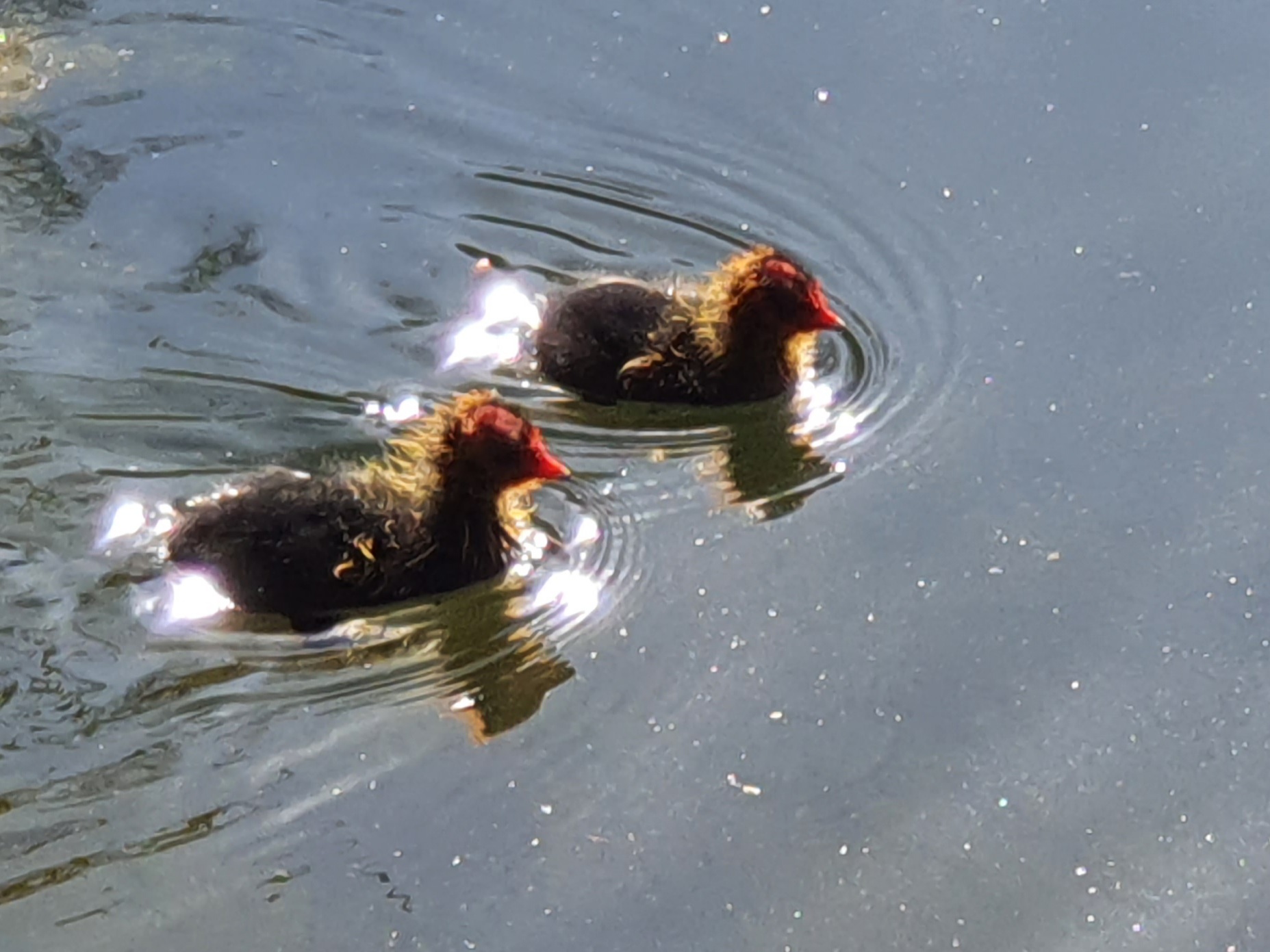
Baby coots near Fehraltorf 2020-04-14 18.00.54 Luppmen
First observed in 🇨🇭 on 2020-04-14.
General: ![]() The Eurasian coot (Fulica atra), also known as the common coot, or Australian coot, is a member of the rail and crake bird family, the Rallidae. It is found in Europe, Asia, Australia, New Zealand and parts of North Africa. It has a slaty-black body, a glossy black head and a white bill with a white frontal shield. The sexes are similar.
[more]
The Eurasian coot (Fulica atra), also known as the common coot, or Australian coot, is a member of the rail and crake bird family, the Rallidae. It is found in Europe, Asia, Australia, New Zealand and parts of North Africa. It has a slaty-black body, a glossy black head and a white bill with a white frontal shield. The sexes are similar.
[more]
Vocalization: ![]() Varied. Usually short, metallic and explosive. [Link]
Varied. Usually short, metallic and explosive. [Link]
Calls: ![]() Most diagnostic call a very short, sharp and explosive "tsk". Sometimes a longer, less sharp but nasal "caw", with varying harshness. [Link]
Most diagnostic call a very short, sharp and explosive "tsk". Sometimes a longer, less sharp but nasal "caw", with varying harshness. [Link]
Physical details: length=36-38 cm,
wingspan=70-80 cm,
weight=600-1000 g
Habitats:
River and lake
Song:
Automatically generated from Xeno-Canto recording
Song attributes:
Frequency:
♫ Taucherli Pfaeffikersee. 2021-02-05 10.34.24 Pfäffikersee (song)
Water rail / Wasserralle (Rallus aquaticus)
Wasserralle im schilf am pfaeffikersee. 2021-02-15 08.33.30 Pfäffikersee
First observed in 🇨🇭 on 2021-02-15.
In reeds at a lake.
Appearance and identification: ![]() The upper parts from the forehead to tail are olive-brown with black streaks, especially on the shoulders. The sides of the head and the underparts down to the upper belly are dark slate-blue, except for a blackish area between bill and eye, and brownish sides to the upper breast. The flanks are barred black and white, and the undertail is white with some darker streaks. The long bill and the iris are red, and the legs are flesh-brown. [Link]
The upper parts from the forehead to tail are olive-brown with black streaks, especially on the shoulders. The sides of the head and the underparts down to the upper belly are dark slate-blue, except for a blackish area between bill and eye, and brownish sides to the upper breast. The flanks are barred black and white, and the undertail is white with some darker streaks. The long bill and the iris are red, and the legs are flesh-brown. [Link]
Vocalization: ![]() Varied but distinct. [Link]
Varied but distinct. [Link]
Song: ![]() Most heard is the territorial song consisting of short, nasal, sharp grunts "tuck- tuck-tuck", ending with a drawn-out trill rising and falling in pitch "kiiiieeerrrr". [Link]
Most heard is the territorial song consisting of short, nasal, sharp grunts "tuck- tuck-tuck", ending with a drawn-out trill rising and falling in pitch "kiiiieeerrrr". [Link]
Calls: ![]() Another diagnostic call is heard from excited birds; a longer pig-like shrilling squeal, with waning repetitions. A bit like someone squeezing a rubber toy. Also short and sharp calls "kvii". [Link]
Another diagnostic call is heard from excited birds; a longer pig-like shrilling squeal, with waning repetitions. A bit like someone squeezing a rubber toy. Also short and sharp calls "kvii". [Link]
Physical details: length=23-28 cm,
wingspan=38-45 cm,
weight=80-180 g
Habitats:
Wetland
Common moorhen / Teichhuhn (Gallinula chloropus)
Teichhuhn bei Rapperswil 2021-02-12 12.54.22 Rapperswil
First observed in 🇨🇭 on 2021-02-12.
This bird appears across the great seas in the following continents:
Europe, North America, Africa, Asia.
Seen at the Pfäffikersee walking across the path from one set of reeds to another.
An apprentice at the nature center gave us the identification, presuming it was a juvenile
because of the lack of color. I'd have said its legs were shorter, but the moorhen definitely
has the main trait we saw, that it holds its short tail in the air.
Habitat: ![]() Common Moorhens prefer to nest in the thicket on the edge of ponds, lakes or rivers and mostly only give themselves away through their guttural calls. They are easier to observe in winter because then they leave their well-vegetated habitat and are seen in meadows, parks and on open waters. [Link]
Common Moorhens prefer to nest in the thicket on the edge of ponds, lakes or rivers and mostly only give themselves away through their guttural calls. They are easier to observe in winter because then they leave their well-vegetated habitat and are seen in meadows, parks and on open waters. [Link]
Song: ![]() Most typical is the territorial call (song); a sharp, loud and resonant "krrrr-ook" or "krrrk". [Link]
Most typical is the territorial call (song); a sharp, loud and resonant "krrrr-ook" or "krrrk". [Link]
Calls: ![]() Rich repertoire of loud calls and softer sounds. Other calls; a sharp, three or four-syllable "kekeke", and a soft "wep" sometimes drawn-out in a more mewing version. [Link]
Rich repertoire of loud calls and softer sounds. Other calls; a sharp, three or four-syllable "kekeke", and a soft "wep" sometimes drawn-out in a more mewing version. [Link]
Physical details: length=32-35 cm,
wingspan=50-55 cm,
weight=240-420 g
Habitats:
Wetland
Corn crake / Wachtelkönig (Crex crex)
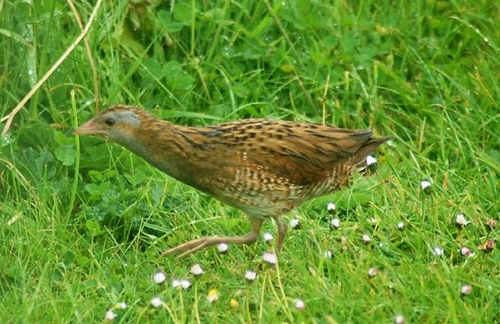
Wikipedia: Corn crake Source: OTHER
Corncrake2.jpg
General: ![]() The corn crake, corncrake or landrail (Crex crex) is a bird in the rail family. It breeds in Europe and Asia as far east as western China, and migrates to Africa for the Northern Hemisphere's winter. It is a medium-sized crake with buff- or grey-streaked brownish-black upperparts, chestnut markings on the wings, and blue-grey underparts with rust-coloured and white bars on the flanks and undertail. The strong bill is flesh-toned, the iris is pale brown, and the legs and feet are pale grey. Juveniles are similar in plumage to adults, and downy chicks are black, as with all rails. There are no subspecies, although individuals from the east of the breeding range tend to be slightly paler than their western counterparts. The male's call is a loud krek krek, from which the scientific name is derived. The corn crake is larger than its closest relative, the African crake, which shares its wintering range; that species is also darker-plumaged, and has a plainer face.
[more]
The corn crake, corncrake or landrail (Crex crex) is a bird in the rail family. It breeds in Europe and Asia as far east as western China, and migrates to Africa for the Northern Hemisphere's winter. It is a medium-sized crake with buff- or grey-streaked brownish-black upperparts, chestnut markings on the wings, and blue-grey underparts with rust-coloured and white bars on the flanks and undertail. The strong bill is flesh-toned, the iris is pale brown, and the legs and feet are pale grey. Juveniles are similar in plumage to adults, and downy chicks are black, as with all rails. There are no subspecies, although individuals from the east of the breeding range tend to be slightly paler than their western counterparts. The male's call is a loud krek krek, from which the scientific name is derived. The corn crake is larger than its closest relative, the African crake, which shares its wintering range; that species is also darker-plumaged, and has a plainer face.
[more]
Song: ![]() Characteristic song can be heard at night. A rasping, hoarse "crex-crex" repeated about every second for long periods of time. [Link]
Characteristic song can be heard at night. A rasping, hoarse "crex-crex" repeated about every second for long periods of time. [Link]
Physical details: length=27-30 cm,
wingspan=46-53 cm,
weight=120-200 g
Habitats:
Agricultural
Maeusebussard. 2020-04-17 08.14.46 Wald Fehraltorf
First observed in 🇨🇭 on 2020-04-17.
This bird appears across the great seas in the following continents:
Europe, North America, Africa, Asia.
General: ![]() The common buzzard (Buteo buteo) is a medium-to-large bird of prey which has a large range. A member of the genus Buteo, it is a member of the family Accipitridae. The species lives in most of Europe and extends its breeding range across much of the Palearctic as far as the northwestern China (Tien Shan), far western Siberia and northwestern Mongolia.[1][2] Over much of its range, it is a year-round resident. However, buzzards from the colder parts of the Northern Hemisphere as well as those that breed in the eastern part of their range typically migrate south for the northern winter, many journeying as far as South Africa.[3] The common buzzard is an opportunistic predator that can take a wide variety of prey, but it feeds mostly on small mammals, especially rodents such as voles. It typically hunts from a perch.[4] Like most accipitrid birds of prey, it builds a nest, typically in trees in this species, and is a devoted parent to a relatively small brood of young.[2] The common buzzard appears to be the most common diurnal raptor in Europe, as estimates of its total global population run well into the millions.[2][5]
[more]
The common buzzard (Buteo buteo) is a medium-to-large bird of prey which has a large range. A member of the genus Buteo, it is a member of the family Accipitridae. The species lives in most of Europe and extends its breeding range across much of the Palearctic as far as the northwestern China (Tien Shan), far western Siberia and northwestern Mongolia.[1][2] Over much of its range, it is a year-round resident. However, buzzards from the colder parts of the Northern Hemisphere as well as those that breed in the eastern part of their range typically migrate south for the northern winter, many journeying as far as South Africa.[3] The common buzzard is an opportunistic predator that can take a wide variety of prey, but it feeds mostly on small mammals, especially rodents such as voles. It typically hunts from a perch.[4] Like most accipitrid birds of prey, it builds a nest, typically in trees in this species, and is a devoted parent to a relatively small brood of young.[2] The common buzzard appears to be the most common diurnal raptor in Europe, as estimates of its total global population run well into the millions.[2][5]
[more]
Vocalization: ![]() Quite vocal. [Link]
Quite vocal. [Link]
Calls: ![]() Most typical call a wailing, mewing "peeoooo". Quite similar to Rough-legged Buzzard, but the pitch falls more rapidly and is then sustained for the last part of the call. [Link]
Most typical call a wailing, mewing "peeoooo". Quite similar to Rough-legged Buzzard, but the pitch falls more rapidly and is then sustained for the last part of the call. [Link]
Physical details: length=51-57 cm,
wingspan=113-128 cm,
weight=550-1300 g
Habitats:
Agricultural
Song:
Automatically generated from Xeno-Canto recording
Song attributes:
Frequency:
♫ Source: BirdNet
20210421_090653 birdnet 1464 - Common Buzzard - 2021-04-21 09:06:53 - Common Buzzard - Fehraltorf.mp3
2021-04-21 09.06.53 Fehraltorf (song)
Sperber am Luppmen nicht weit vom Bahnhof 2021-02-06 10.49.12 Luppmen
First observed in 🇨🇭 on 2021-02-06.
General: ![]() The Eurasian sparrowhawk (Accipiter nisus), also known as the northern sparrowhawk or simply the sparrowhawk, is a small bird of prey in the family Accipitridae. Adult male Eurasian sparrowhawks have bluish grey upperparts and orange-barred underparts; females and juveniles are brown above with brown barring below. The female is up to 25% larger than the male – one of the greatest size differences between the sexes in any bird species. Though it is a predator which specialises in catching woodland birds, the Eurasian sparrowhawk can be found in any habitat and often hunts garden birds in towns and cities. Males tend to take smaller birds, including tits, finches, and sparrows; females catch primarily thrushes and starlings, but are capable of killing birds weighing 500 g (18 oz) or more.
[more]
The Eurasian sparrowhawk (Accipiter nisus), also known as the northern sparrowhawk or simply the sparrowhawk, is a small bird of prey in the family Accipitridae. Adult male Eurasian sparrowhawks have bluish grey upperparts and orange-barred underparts; females and juveniles are brown above with brown barring below. The female is up to 25% larger than the male – one of the greatest size differences between the sexes in any bird species. Though it is a predator which specialises in catching woodland birds, the Eurasian sparrowhawk can be found in any habitat and often hunts garden birds in towns and cities. Males tend to take smaller birds, including tits, finches, and sparrows; females catch primarily thrushes and starlings, but are capable of killing birds weighing 500 g (18 oz) or more.
[more]
Vocalization: ![]() Series of short "ke-ke-ke-ke-ke", with rising pitch. [Link]
Series of short "ke-ke-ke-ke-ke", with rising pitch. [Link]
Song: ![]() Meist in Horstnähe zu hören. Eine Reihe von kurzen Einzellauten,
[Link]
Meist in Horstnähe zu hören. Eine Reihe von kurzen Einzellauten,
[Link]
Calls: ![]() wie „gigigi“. Ähnlichkeit mit Wendehals, aber klarer und schneller. Schneller auch als Grünspecht und tiefer als Turmfalke. [Link]
wie „gigigi“. Ähnlichkeit mit Wendehals, aber klarer und schneller. Schneller auch als Grünspecht und tiefer als Turmfalke. [Link]
![]() Less resonant and less full than similar call of Goshawk, and much faster. Also a short "peeaaaa", shorter and more squeaky than Buzzard. [Link]
Less resonant and less full than similar call of Goshawk, and much faster. Also a short "peeaaaa", shorter and more squeaky than Buzzard. [Link]
Physical details: length=28-38 cm,
wingspan=55-70 cm,
weight=110-342 g
Habitats:
Agricultural
Song:
Automatically generated from Xeno-Canto recording
Song attributes:
Frequency:
♫ XC818384 - Eurasian Sparrowhawk - Accipiter nisus - call, Brandenburg, Germany. Source: XENOCANTO
XC818384 - Eurasian Sparrowhawk - Accipiter nisus - call, Brandenburg, Germany.mp3
Germany (call)
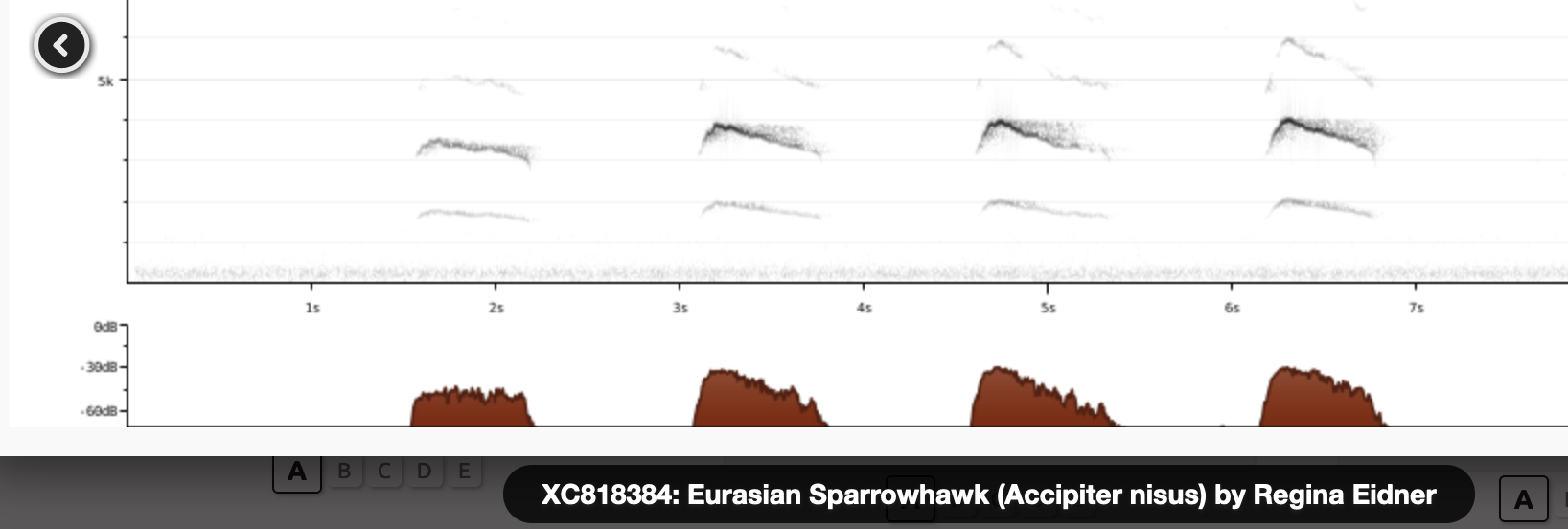
Steinadler. 2022-05-22 12.58.16 Leuk and surroundings
First observed in 🇨🇭 on 2022-05-21.
This bird appears across the great seas in the following continents:
Europe, North America, Africa.
Deutschland: Brut-, Jahresvogel RL 2
Vocalization: ![]() Not very vocal. A short, clear, yelping "kew". Sometimes in series in mellow tempo. [Link]
Not very vocal. A short, clear, yelping "kew". Sometimes in series in mellow tempo. [Link]
Calls: ![]() Also mewing, Buzzard-like calls. [Link]
Also mewing, Buzzard-like calls. [Link]
Physical details: length=75-88 cm,
wingspan=204-220 cm,
weight=2840-6665 g
Habitats:
Agricultural
MerlinBirdID meint Rohrweihe. 2022-05-21 16.00.56 Leuk and surroundings
First observed in 🇨🇭 on 2022-05-21.
General: ![]() The western marsh harrier (Circus aeruginosus) is a large harrier, a bird of prey from temperate and subtropical western Eurasia and adjacent Africa. It is also known as the Eurasian marsh harrier. The genus name Circus is derived from the Ancient Greek kirkos, referring to a bird of prey named for its circling flight (kirkos, "circle"), probably the hen harrier. The specific aeruginosus is Latin for "rusty".[3]
[more]
The western marsh harrier (Circus aeruginosus) is a large harrier, a bird of prey from temperate and subtropical western Eurasia and adjacent Africa. It is also known as the Eurasian marsh harrier. The genus name Circus is derived from the Ancient Greek kirkos, referring to a bird of prey named for its circling flight (kirkos, "circle"), probably the hen harrier. The specific aeruginosus is Latin for "rusty".[3]
[more]
Calls: ![]() Call: A sharp "kwii-uuu" of about a seconds length, rapidly ascending in pitch, and ending on a falling tone. [Link]
Call: A sharp "kwii-uuu" of about a seconds length, rapidly ascending in pitch, and ending on a falling tone. [Link]
Physical details: length=48-56 cm,
wingspan=115-130 cm,
weight=405-800 g
Habitats:
Agricultural
Unklares Bild von entfernter Kornweihe beim Kraftwerk neben Albufera. 2022-04-12 13.11.40 Mallorca
First observed in Mallorca on 2022-04-12.
Deutschland: Brut-, Jahres-, Zugvogel, Wintergast RL 1
Vocalization: ![]() Mostly heard at breeding ground. [Link]
Mostly heard at breeding ground. [Link]
Calls: ![]() Calls with quite soft series of "ke-ke-ke-ke". Also a wailing, squealing whistle, with emphasized first syllable. [Link]
Calls with quite soft series of "ke-ke-ke-ke". Also a wailing, squealing whistle, with emphasized first syllable. [Link]
Physical details: length=44-52 cm,
wingspan=100-120 cm,
weight=300-600 g
Habitats:
Agricultural
Deutschland: Brut-, Jahresvogel, Wintergast
Profile Wikipedia eBird Vogelwarte BirdLife ZH ornitho.ch bird-song.ch Xeno-Canto BirdID NABU
Im Baum am Pfäffikersee 2020-05-20 08.58.48 Pfäffikersee
First observed in 🇨🇭 on 2020-04-13.
Geography: ![]() Very common here in the summer, I've seen up to 30 on a freshly plowed field, and you can seldom look up without seeing one.
(You should look closely though, as they'll often circle in the air with buzzards.)They migrate to Spain in the winter, but increasing numbers stay here.Elsewhere in Europe they've been decreasing, while here they've become so successful that young birds have trouble
finding a territory of their own. Wikipedia mentions them competing with the black kite, which I've never
identified locally, so perhaps that's part of the key to their success. [Link]
Very common here in the summer, I've seen up to 30 on a freshly plowed field, and you can seldom look up without seeing one.
(You should look closely though, as they'll often circle in the air with buzzards.)They migrate to Spain in the winter, but increasing numbers stay here.Elsewhere in Europe they've been decreasing, while here they've become so successful that young birds have trouble
finding a territory of their own. Wikipedia mentions them competing with the black kite, which I've never
identified locally, so perhaps that's part of the key to their success. [Link]
Vocalization: ![]() Mainly heard in breeding season. A piercing long whistle, quickly ascending, then descending "piuuu". Often used in movies to give an eerie wildlife mood. [Link]
Mainly heard in breeding season. A piercing long whistle, quickly ascending, then descending "piuuu". Often used in movies to give an eerie wildlife mood. [Link]
Calls: ![]() Differs from Black Kite in being a clear whistle all the way through the call, without "shivering". Higher pitched than Buzzard, and with less pause between calls. [Link]
Differs from Black Kite in being a clear whistle all the way through the call, without "shivering". Higher pitched than Buzzard, and with less pause between calls. [Link]
Physical details: length=60-66 cm,
wingspan=175-195 cm,
weight=800-1300 g
Habitats:
Agricultural
Song:
Automatically generated from Xeno-Canto recording
Song attributes:
Frequency:
♫ Rotmilan. 2020-05-24 16.56.51 Luppmen (song)
Call:
Automatically generated from Xeno-Canto recording
♫ Check if red kite begging calls. 2021-08-14 10.02.45 (begging call)
Call attributes:
begging call Frequency: ,
Presence: 01-01 - 12-31
Breeding: 04-10 - 07-28
Migration in: 01-20 - 04-30
Migration out: 08-18 - 11-28

Wikipedia: European honey-buzzard Source: OTHER
1200px-Wespenbussard_European_honey_buzzard_Pernis_apivorus%2C_crop.jpg
General: ![]() The European honey buzzard (Pernis apivorus), also known as the pern or common pern,[2] is a bird of prey in the family Accipitridae.
[more]
The European honey buzzard (Pernis apivorus), also known as the pern or common pern,[2] is a bird of prey in the family Accipitridae.
[more]
Calls: ![]() Call an ascending, then descending; "pjuuuuu" much thinner than buzzards, and with a distinct register break when changing pitch. May be confused with newly fledged Buzzard chicks. [Link]
Call an ascending, then descending; "pjuuuuu" much thinner than buzzards, and with a distinct register break when changing pitch. May be confused with newly fledged Buzzard chicks. [Link]
Physical details: length=52-60 cm,
wingspan=135-150 cm,
weight=360-1050 g
Habitats:
Agricultural
Osprey / Fischadler (Pandion haliaetus)
Osprey in flight. 2023-09-27 12.22.08 Florida
First observed in Yucatan on 2023-04-21.
This bird appears across the great seas in the following continents:
Europe, North America, South America, Africa, Asia.
General: ![]() Falco haliaetus Linnaeus, 1758
[more]
Falco haliaetus Linnaeus, 1758
[more]
Calls: ![]() Calls with sequences of short, soft and clear whistling notes. Often in series with rising pitch, then ending with a few lower pitched notes. [Link]
Calls with sequences of short, soft and clear whistling notes. Often in series with rising pitch, then ending with a few lower pitched notes. [Link]
Physical details: length=55-58 cm,
wingspan=145-170 cm,
weight=1120-2050 g
Habitats:
Agricultural
Song:
Automatically generated from Xeno-Canto recording
Song attributes:
Frequency:
♫ 2023-10-12 15 55 surprising sound of an osprey. 2023-10-12 15.55.00 New England (song)
Taube. 2020-04-11 08.25.00 Luppmen
First observed in 🇨🇭 on 2020-04-18.
Song: ![]() Gu-guh-guh-guh guh-gugugu –gu. „ Hansruedi wo geisch hi, ga Thun, was ga mache, ga Mähl hole, wiviel, es mutt“
[Link]
Gu-guh-guh-guh guh-gugugu –gu. „ Hansruedi wo geisch hi, ga Thun, was ga mache, ga Mähl hole, wiviel, es mutt“
[Link]
![]() Song a 5 syllable cooing phrase, with emphasis on first syllable (1.st also higher pitched). Fift syllable functions as an introduction to next phrase. [Link]
Song a 5 syllable cooing phrase, with emphasis on first syllable (1.st also higher pitched). Fift syllable functions as an introduction to next phrase. [Link]
Calls: Other: Usual call has 5 coos: 2+1+2, contrasted with the collared dove's 3 = 2+1 [Link]
Physical details: length=40-42 cm,
wingspan=75-80 cm,
weight=284-614 g
Habitats:
Forest
Song:
Automatically generated from Xeno-Canto recording
Song attributes:
Frequency:
♫ Source: BirdNet
20200418_073258 birdnet - Common wood pigeon.mp3
2020-04-18 07.32.58 Luppmen (song)
Profile Wikipedia eBird Vogelwarte BirdLife ZH ornitho.ch Xeno-Canto BirdID NABU
Hohltaube bei Maienfeld. 2021-05-29 11.42.52 Maienfeld
First observed in 🇨🇭 on 2021-05-29.
General: ![]() The stock dove (Columba oenas) is a species of bird in the family Columbidae, the doves and pigeons. It is widely distributed in the western Palearctic.
[more]
The stock dove (Columba oenas) is a species of bird in the family Columbidae, the doves and pigeons. It is widely distributed in the western Palearctic.
[more]
Song: ![]() „Huuh-hup“ . Das „huuh“ fast zweisilbig, erste Silbe höher, das „hup“ noch höher. Fast wie „Hooh ruck“
[Link]
„Huuh-hup“ . Das „huuh“ fast zweisilbig, erste Silbe höher, das „hup“ noch höher. Fast wie „Hooh ruck“
[Link]
![]() Song a two-syllable, cooing. Much louder and more accentuated first syllable than in Feral Pigeon. First a short ascending "oooh", immediately followed by a short descending "oohh". Tone quite pure, mostly lacking the rolling quality of Feral Pigeon. [Link]
Song a two-syllable, cooing. Much louder and more accentuated first syllable than in Feral Pigeon. First a short ascending "oooh", immediately followed by a short descending "oohh". Tone quite pure, mostly lacking the rolling quality of Feral Pigeon. [Link]
Calls: ![]() Nur noch sehr selten zu hören!
[Link]
Nur noch sehr selten zu hören!
[Link]
Physical details: length=32-34 cm,
wingspan=63-69 cm,
weight=250-350 g
Habitats:
Forest
Rock pigeons at bay in St Petersburg. 2023-09-23 19.15.24 Florida
First observed in 🇨🇭 on 2021-04-18.
This bird appears across the great seas in the following continents:
Europe, North America, South America, Africa, Asia.
General: ![]() The rock dove, rock pigeon, or common pigeon (/ˈpɪdʒ.ən/ also /ˈpɪdʒ.ɪn/; Columba livia) is a member of the bird family Columbidae (doves and pigeons).[3]:624 In common usage, this bird is often simply referred to as the "pigeon".
[more]
The rock dove, rock pigeon, or common pigeon (/ˈpɪdʒ.ən/ also /ˈpɪdʒ.ɪn/; Columba livia) is a member of the bird family Columbidae (doves and pigeons).[3]:624 In common usage, this bird is often simply referred to as the "pigeon".
[more]
Vocalization: ![]() Not loud. [Link]
Not loud. [Link]
Song: ![]() Song a two-syllable, but continuous cooing. First a rolling ascending "orrrrrr" immediately followed by a short descending "oohh". Wings produce a quite audible whistling sound. [Link]
Song a two-syllable, but continuous cooing. First a rolling ascending "orrrrrr" immediately followed by a short descending "oohh". Wings produce a quite audible whistling sound. [Link]
Physical details: length=31-34 cm,
wingspan=63-70 cm,
weight=230-370 g
Habitats:
Settlement
Song:
Automatically generated from Xeno-Canto recording
Song attributes:
Frequency:
♫ Source: BirdNet
20210418_155851 birdnet 1445 - Rock Pigeon and Mistle Thrush clatter - Rock Pigeon - Fehraltorf.mp3
2021-04-18 15.58.51 Fehraltorf (song)
Didn't recognize this collared dove ...so I annotated it with the characteristics I should have recognized 2021-02-01 13.14.42 Luppmen
First observed in 🇨🇭 on 2020-05-21.
This bird appears across the great seas in the following continents:
Europe, North America (introduced), Africa, Asia (introduced).
General: ![]() The Eurasian collared dove (Streptopelia decaocto) is a dove species native to Europe and Asia; it was introduced to Japan, North America and islands in the Caribbean. Because of its vast global range and increasing population trend, it has been listed as Least Concern on the IUCN Red List since 2014.[1]
[more]
The Eurasian collared dove (Streptopelia decaocto) is a dove species native to Europe and Asia; it was introduced to Japan, North America and islands in the Caribbean. Because of its vast global range and increasing population trend, it has been listed as Least Concern on the IUCN Red List since 2014.[1]
[more]
Song: ![]() Gu-guh-gu, klingt wie „ Gross-mue-ti“ Dazu auch „chräi“ oder „chwii“
[Link]
Gu-guh-gu, klingt wie „ Gross-mue-ti“ Dazu auch „chräi“ oder „chwii“
[Link]
![]() Song a characteristic, rhythmic cooing, consisting of three syllables with emphasis on the second. The third lower pitched than the rest. Can be rendered as "su-do-ku" (or "deca-oc-to", latin name derived from song). [Link]
Song a characteristic, rhythmic cooing, consisting of three syllables with emphasis on the second. The third lower pitched than the rest. Can be rendered as "su-do-ku" (or "deca-oc-to", latin name derived from song). [Link]
Calls: ![]() Excitement-call a nasal "wrrraa". [Link]
Excitement-call a nasal "wrrraa". [Link]
Physical details: length=31-33 cm,
wingspan=47-55 cm,
weight=170-240 g
Habitats:
Settlement
Song:
Automatically generated from Xeno-Canto recording
Song attributes:
Frequency:
♫ Tuerkentaube, Fehraltorf. ![]() Source: Zoom H6 2024-05-13 05.51.36 Fehraltorf (song)
Source: Zoom H6 2024-05-13 05.51.36 Fehraltorf (song)
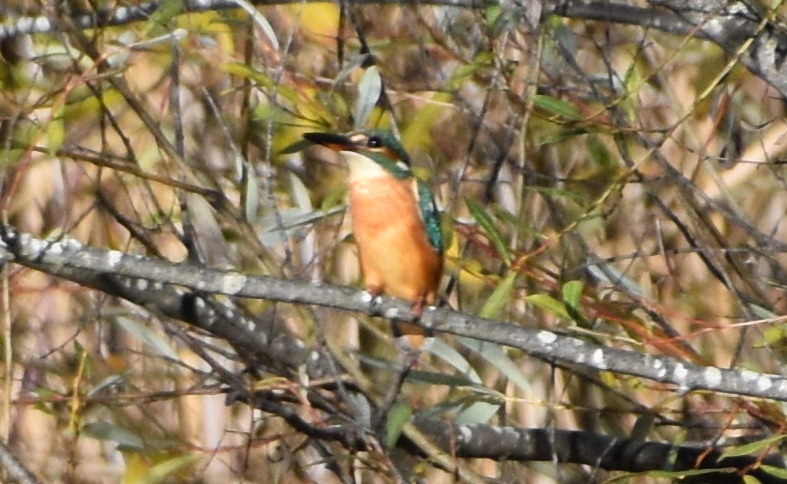
Eisvogel beim Pfaeffikersee Ein paar sind im Herbst und Winter am Meteorwasserkanal nahe Schellenberger Textil zu sehen. 2020-11-17 10.57.56 Pfäffikersee
First observed in 🇨🇭 on 2020-10-08.
This is a favorite bird in Switzerland. On the one hand it's colorful and very active when seen
in its hunting grounds at a waterway; on the other hand, it's seldom seen. Contrast the 400-500 breeding
pairs with 400,000-550,000 of the everpresent great tits.
An apprentice for the nature center on Lake Pfaeffikon told us a bit
about the kingfishers that hunt on a waterway that feeds into the lake.
She said they spend the breeding season elsewhere in sandy areas and return to the lake
in fall. I've read elsewhere that they watch for fish from convenient waterside branches.
A classic motif for a picture is a branch sticking out of the water, and one photographer
said he has actually placed a branch there, knowing the kingfisher would not be able to resist.
Etymology: Nabu: Ob der Name des Eisvogels (Alcedo atthis) tatsächlich mit Eis zu tun hat oder das eisblaue Rückengefieder Pate stand, ist strittig. Manche Deutungen leiten den Namen vom althochdeutschen „eisan“ für „schillern“ oder „glänzen“ ab. Der „Schillervogel“ wäre eine gute Beschreibung für das flirrende Farbenspiel, das der Eisvogel im Sitzen und erst recht im Flug bietet. Wieder andere Autoren interpretieren den „Eisvogel“ als „Eisenvogel“ und vermuten einen Bezug auf das stahlblaue Rücken- oder das rostfarbene Bauchgefieder des Eisvogels. [Link]
Seasonal Behavior: ![]() Status (in CH): regelmässiger, spärlicher Brutvogel, Durchzügler und Wintergast. [Link]
Status (in CH): regelmässiger, spärlicher Brutvogel, Durchzügler und Wintergast. [Link]
Calls: ![]() Wikipedia says 'The common kingfisher has no song.
The flight call is a short, sharp whistle chee repeated two or three times. Anxious birds emit a harsh, shrit-it-it and nestlings call for food with a churring noise.'
The NABU app only has calls,
which seems to confirm this. Therefore I'm classifying all recordings as calls,
even though some say Song at Xeno-Canto. [Link]
Wikipedia says 'The common kingfisher has no song.
The flight call is a short, sharp whistle chee repeated two or three times. Anxious birds emit a harsh, shrit-it-it and nestlings call for food with a churring noise.'
The NABU app only has calls,
which seems to confirm this. Therefore I'm classifying all recordings as calls,
even though some say Song at Xeno-Canto. [Link]
![]() Most heard is the thin and penetrating contact call: A short "tzee", or disyllabic "tzee-tzu", with a ringing metallic quality. In excitement it is often alternated with ringing trills "tzeerrrrrrrrrr". [Link]
Most heard is the thin and penetrating contact call: A short "tzee", or disyllabic "tzee-tzu", with a ringing metallic quality. In excitement it is often alternated with ringing trills "tzeerrrrrrrrrr". [Link]
Physical details: length=16-17 cm,
wingspan=24-26 cm,
weight=34-46 g
Habitats:
Wetland
Song:
Automatically generated from Xeno-Canto recording
Song attributes:
Frequency:
♫ Source: BirdNet
20210822_124621 birdnet 1961 - Common Kingfisher doubtful in the mountains, I thought great tits plus possibly a woodpecker - Common Kingfisher - Ennenda.mp3
2021-08-22 12.46.21 (song)
Call:
Common kingfisher call from Xeno-Canto, similar to one from NABU app.
Fairly high pitched single chirps or occasional high-low pairs.
Call from Xeno-Canto
♫ Call from Xeno-Canto Source: XENOCANTO
XC511677 Common kingfisher call similar to one from NABU app.mp3
(call)

Call attributes:
Call melody: one note, slow, Frequency: 5-7 KHz,
Profile Wikipedia eBird Vogelwarte BirdLife ZH ornitho.ch bird-song.ch Audubon AllAboutBirds Xeno-Canto BirdID NABU
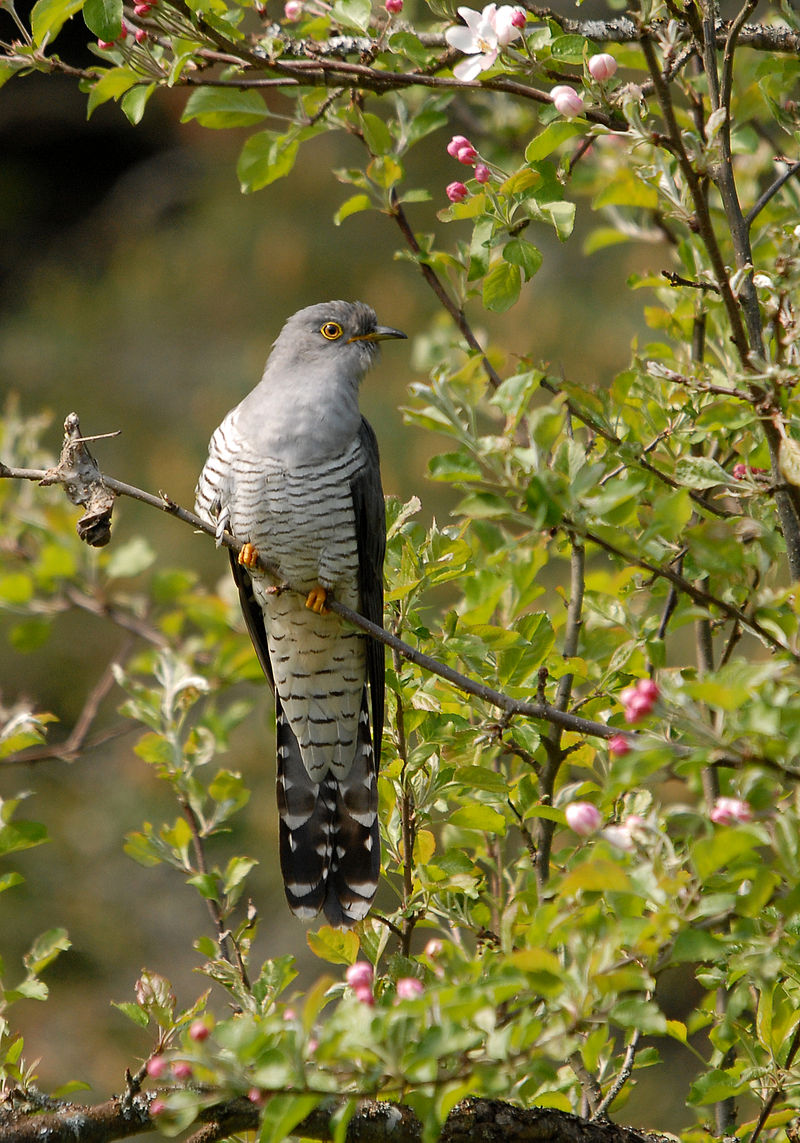
Wikipedia Kuckuck, Cuculus canorus. Von Locaguapa - Eigenes Werk, CC BY-SA 3.0, Link Source: WIKIPEDIA
Wikipedia Kuckuck, Cuculus canorus.jpg
First observed in 🇨🇭 on 2021-05-04.
This bird appears across the great seas in the following continents:
Europe, North America, Africa.
Geography: ![]() A common migratory bird across most of Europe and Asia, it regularly strays to the western Alaskan islands in late spring and early summer. [Link]
A common migratory bird across most of Europe and Asia, it regularly strays to the western Alaskan islands in late spring and early summer. [Link]
Song: ![]() Männchen: Unverwechselbarer Ruf. Weibchen: im Frühling eine kichernde Rufreihe,
[Link]
Männchen: Unverwechselbarer Ruf. Weibchen: im Frühling eine kichernde Rufreihe,
[Link]
![]() Song: the well known disyllabic "cuck-coo" with emphasis on first note, and the second note a third lower than the first one. Also a harsh "tchaa tchaa", and a bubbly trill, reminiscent of Little Grebe, uttered by the female. [Link]
Song: the well known disyllabic "cuck-coo" with emphasis on first note, and the second note a third lower than the first one. Also a harsh "tchaa tchaa", and a bubbly trill, reminiscent of Little Grebe, uttered by the female. [Link]
Calls: ![]() wie „kwickkwickkwick“, 6-8 dicht gereihte, fast metallisch klingende Laute, von unten her angeschlagen. Jungkuckucke betteln durchdringend „ssrieb“
[Link]
wie „kwickkwickkwick“, 6-8 dicht gereihte, fast metallisch klingende Laute, von unten her angeschlagen. Jungkuckucke betteln durchdringend „ssrieb“
[Link]
Physical details: length=32-34 cm,
wingspan=55-60 cm,
weight=95-140 g
Habitats:
Forest
Song:
Two-noter
Song attributes:
Melody: simple rhythmic, slow, Frequency: 0-1 KHz
Flying by Pfäffikon 2020-04-24 12.12.44 Luppmen
First observed in 🇨🇭 on 2020-04-24.
Oft seen in the fields around Fehraltorf, flapping away to stay in place.
Calls: ![]() Turmfalke kann auch wie einen Specht tönen, scharf und relativ hoch [Link]
Turmfalke kann auch wie einen Specht tönen, scharf und relativ hoch [Link]
![]() Most common call a fast series of short, high-pitched "ke-ke-ke". Much less raucous than Merlin or Peregrine. [Link]
Most common call a fast series of short, high-pitched "ke-ke-ke". Much less raucous than Merlin or Peregrine. [Link]
Physical details: length=32-35 cm,
wingspan=71-80 cm,
weight=156-252 g
Habitats:
Agricultural
Song:
Automatically generated from Xeno-Canto recording
Song attributes:
Frequency:
♫ Source: BirdNet
20210421_092214 birdnet 1466 - Eurasian Kestrel uncertain - Eurasian Kestrel - Pf=C3=A4ffikon.mp3
2021-04-21 09.22.14 Pfäffikersee (song)

Wikipedia: Peregrine falcon Source: OTHER
Falco_peregrinus_good_-_Christopher_Watson.jpg
This bird appears across the great seas in the following continents:
Europe, North America, South America, Africa, Asia.
General: ![]() The peregrine falcon (Falco peregrinus), also known as the peregrine,[2] and historically as the duck hawk in North America,[3] is a widespread bird of prey (raptor) in the family Falconidae. A large, crow-sized falcon, it has a blue-grey back, barred white underparts, and a black head. The peregrine is renowned for its speed, reaching over 320 km/h (200 mph) during its characteristic hunting stoop (high-speed dive),[4] making it the fastest bird in the world, as well as the fastest member of the animal kingdom.[5][6][7] According to a National Geographic TV program, the highest measured speed of a peregrine falcon is 389 km/h (242 mph).[8][9] As is typical for bird-eating raptors, peregrine falcons are sexually dimorphic, with females being considerably larger than males.[10][11]
[more]
The peregrine falcon (Falco peregrinus), also known as the peregrine,[2] and historically as the duck hawk in North America,[3] is a widespread bird of prey (raptor) in the family Falconidae. A large, crow-sized falcon, it has a blue-grey back, barred white underparts, and a black head. The peregrine is renowned for its speed, reaching over 320 km/h (200 mph) during its characteristic hunting stoop (high-speed dive),[4] making it the fastest bird in the world, as well as the fastest member of the animal kingdom.[5][6][7] According to a National Geographic TV program, the highest measured speed of a peregrine falcon is 389 km/h (242 mph).[8][9] As is typical for bird-eating raptors, peregrine falcons are sexually dimorphic, with females being considerably larger than males.[10][11]
[more]
Vocalization: ![]() A harsh, drawn out "kiaaaa" with emphasised endings repeated in series. Much slower than Merlin, but higher pitched than Gyrfalcon. [Link]
A harsh, drawn out "kiaaaa" with emphasised endings repeated in series. Much slower than Merlin, but higher pitched than Gyrfalcon. [Link]
Calls: ![]() Also shorter, coarse warning-calls. [Link]
Also shorter, coarse warning-calls. [Link]
Physical details: length=36-48 cm,
wingspan=95-110 cm,
weight=582-1300 g
Habitats:
Agricultural

Merlin SoundID bird list. Source: OTHER
Merlin SoundID bird list.jpg
This bird appears across the great seas in the following continents:
Europe, North America, South America, Africa.
Deutschland: Zugvogel, Wintergast
Vocalization: ![]() Series of harsh "kwik-wik wik". Coarseness similar to Peregrine, but pace much quicker. [Link]
Series of harsh "kwik-wik wik". Coarseness similar to Peregrine, but pace much quicker. [Link]
Calls: ![]() Female call harsher than male. Lacking the clearer tones and attack of Kestrel. [Link]
Female call harsher than male. Lacking the clearer tones and attack of Kestrel. [Link]
Physical details: length=25-30 cm,
wingspan=50-62 cm,
weight=125-300 g
Habitats:
Agricultural
Buntspecht hoch im Baum im Wald 'Im Brand' 2020-04-25 07.57.12 Luppmen
First observed in 🇨🇭 on 2020-04-12.
Most common woodpecker in Switzerland
Vocalization: ![]() It's frequent drumming is easily recognized by its short duration. [Link]
It's frequent drumming is easily recognized by its short duration. [Link]
Calls: ![]() Typically it lasts 0.5 seconds, sometimes slightly longer. Contact call frequently hear throughout the year. A short hiccup "kek", sometimes in series. When excited this may escalate into a trill. [Link]
Typically it lasts 0.5 seconds, sometimes slightly longer. Contact call frequently hear throughout the year. A short hiccup "kek", sometimes in series. When excited this may escalate into a trill. [Link]
Physical details: length=22-23 cm,
wingspan=34-39 cm,
weight=70-100 g
Habitats:
Forest
Song or calls similar to:
Ring ouzel.
Song:
Song: Other: ‘Drumming’ is the sound that Great Spotted Woodpeckers make by hammering their bills against dead wood 10-20 times over 2-3 seconds. The sound resonates in the dead wood and can be heard over large distances. This drumming acts as an advert and is used by Great spotted Woodpeckers and other woodpecker species instead of a song. [From the GardenBird web site]
Nabu: Manchmal, bei strahlendem Sonnenschein, fangen die Spechte schon im Dezember an zu trommeln. [NABU Vogel des Jahres 1997]
Call: Nabu: Das bekannteste Geräusch des schwarz-weißen Spechtes ist aber wohl sein kurzes, aber häufiges Trommeln. [Link]
![]() In a sonogram I can see about 13 taps in just over half a second, but you can never distinguish so many.
It's short but intense, and the second half trails off,
especially contrasted with the constant drumming of the three-toed woodpecker. [[Listen here.]]
In a sonogram I can see about 13 taps in just over half a second, but you can never distinguish so many.
It's short but intense, and the second half trails off,
especially contrasted with the constant drumming of the three-toed woodpecker. [[Listen here.]]
Song attributes:
Melody: non-musical, fast, Frequency: low (1-3 KHz) Special sounds: drumming Singing season: 01-01 - 06-30
♫ Great spotted woodpecker drumming Source: XENOCANTO
XC625181 buntspecht drumming.mp3
(drumming)
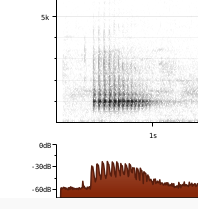
Call:
General: A chirping (that I couldn't associate in my mind with a woodpecker), repeated at somewhat irregular intervals of about a second
2023: klang in bird-song.ch Quiz wie eine lauter Haussperling
Call: Nabu: Der häufigste Ruf ist ein kurzes und spitzes „kix“. Ist ein Buntspecht aufgebracht, etwa durch einen Artgenossen, kann man ein schnelles Schnarren hören. [Link]
Great spotted woodpecker call
♫ Great spotted woodpecker call Source: XENOCANTO
XC200059 Great spotted woodpecker call.mp3
(call)
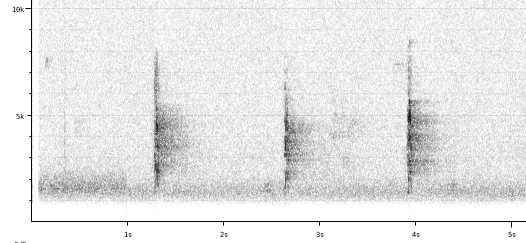
Call attributes:
Call melody: one note, slow, Frequency: 1-8 KHz,

Wikipedia: Red-throated loon Source: OTHER
1200px-Gavia_Stellata_%C3%96lfus%C3%A1_20090606.jpg
This bird appears across the great seas in the following continents:
Europe, North America.
Deutschland: Zugvogel, Wintergast
Habitats:
River and lake
Great northern loon, Squam Lake, New Hampshire. 2023-10-06 12.26.58 New England
First observed in New England on 2023-10-06.
This bird appears across the great seas in the following continents:
Europe, North America.
Deutschland: seltener Wintergast
Song: ![]() Song: Like a slow Black-throated Diver. Pitch slowly rising with a register break, progressing into a cyclic, two to four syllable, motif. [Link]
Song: Like a slow Black-throated Diver. Pitch slowly rising with a register break, progressing into a cyclic, two to four syllable, motif. [Link]
Calls: ![]() Also various vibrating eerie descending calls. Often used as sound effect in horror movies. [Link]
Also various vibrating eerie descending calls. Often used as sound effect in horror movies. [Link]
Physical details: length=69-91 cm,
wingspan=69-91 cm,
weight=3600-4480 g

Wikipedia: Black-throated loon Source: OTHER
Black-throated_Diver%2C_Oulu%2C_Finland_02_%2815195370798%29.jpg
This bird appears across the great seas in the following continents:
Europe, North America.
Deutschland: Zugvogel, Wintergast
Habitats:
River and lake
Profile Wikipedia eBird Vogelwarte BirdLife ZH ornitho.ch bird-song.ch Xeno-Canto BirdID NABU
First observed in 🇨🇭 on 2020-04-27.
Exotic looking waterbird common at Pfäffikersee
Vocalization: ![]() Laughing sequences with nasal grunts, a rolling nasal "treaa" and bill-clattering. [Link]
Laughing sequences with nasal grunts, a rolling nasal "treaa" and bill-clattering. [Link]
Physical details: length=46-51 cm,
wingspan=85-90 cm,
weight=568-813 g
Habitats:
River and lake
Song:
Automatically generated from Xeno-Canto recording
Song attributes:
Frequency:
♫ Source: BirdNet
20210421_103108 birdnet 1470 - Great Crested Grebe - 2021-04-21 10:31:08 - Great Crested Grebe - Pf=C3=A4ffikon.mp3
2021-04-21 10.31.08 Pfäffikersee (song)
Horned grebe, Myvatn, Iceland. 2015-06-05 11.22.28 Iceland
First observed in Iceland on 2015-06-05.
This bird appears across the great seas in the following continents:
Europe, North America.
Deutschland: Brut-, Zugvogel, Wintergast RL 1
Vocalization: ![]() Varied. Vibrating, wailing, dry and cackling sequences. A mewing, falling and far-reaching "kiaa" and various rattling sounds. [Link]
Varied. Vibrating, wailing, dry and cackling sequences. A mewing, falling and far-reaching "kiaa" and various rattling sounds. [Link]
Physical details: length=31-38 cm,
wingspan=46-55 cm,
weight=364-449 g
Habitats:
River and lake
Profile Wikipedia eBird Vogelwarte BirdLife ZH ornitho.ch Audubon AllAboutBirds Xeno-Canto NABU

Wikipedia: Red-necked grebe Source: OTHER
1200px-Podicepsgrisegena.jpg
This bird appears across the great seas in the following continents:
Europe, North America.
Deutschland: Brut-, Zugvogel
Habitats:
River and lake
Profile Wikipedia eBird Vogelwarte BirdLife ZH ornitho.ch bird-song.ch Xeno-Canto BirdID NABU
Zwergtaucher. 2022-06-25 12.07.24 La Sauge
First observed in Gqeberha (former Port Elisabeth) on 2009-10-22.
General: ![]() The little grebe (Tachybaptus ruficollis), also known as dabchick, is a member of the grebe family of water birds. The genus name is from Ancient Greek takhus "fast" and bapto "to sink under". The specific ruficollis is from Latin rufus "red" and Modern Latin -collis, "-necked", itself derived from Latin collum "neck".[2]
[more]
The little grebe (Tachybaptus ruficollis), also known as dabchick, is a member of the grebe family of water birds. The genus name is from Ancient Greek takhus "fast" and bapto "to sink under". The specific ruficollis is from Latin rufus "red" and Modern Latin -collis, "-necked", itself derived from Latin collum "neck".[2]
[more]
Vocalization: ![]() Relatively vocal compared to many other grebes. [Link]
Relatively vocal compared to many other grebes. [Link]
Calls: ![]() Call; sometimes a single quite clear high pitched "dydlylyyt". More often combined into longer phrases with harsher quality, oscillating like laughter and travelling up and down in pitch in agitated motion. Reminiscent of female Cuckoo. [Link]
Call; sometimes a single quite clear high pitched "dydlylyyt". More often combined into longer phrases with harsher quality, oscillating like laughter and travelling up and down in pitch in agitated motion. Reminiscent of female Cuckoo. [Link]
Physical details: length=25-29 cm,
wingspan=40-45 cm,
weight=140-193 g
Habitats:
River and lake
Profile Wikipedia eBird Audubon AllAboutBirds Xeno-Canto BirdID NABU
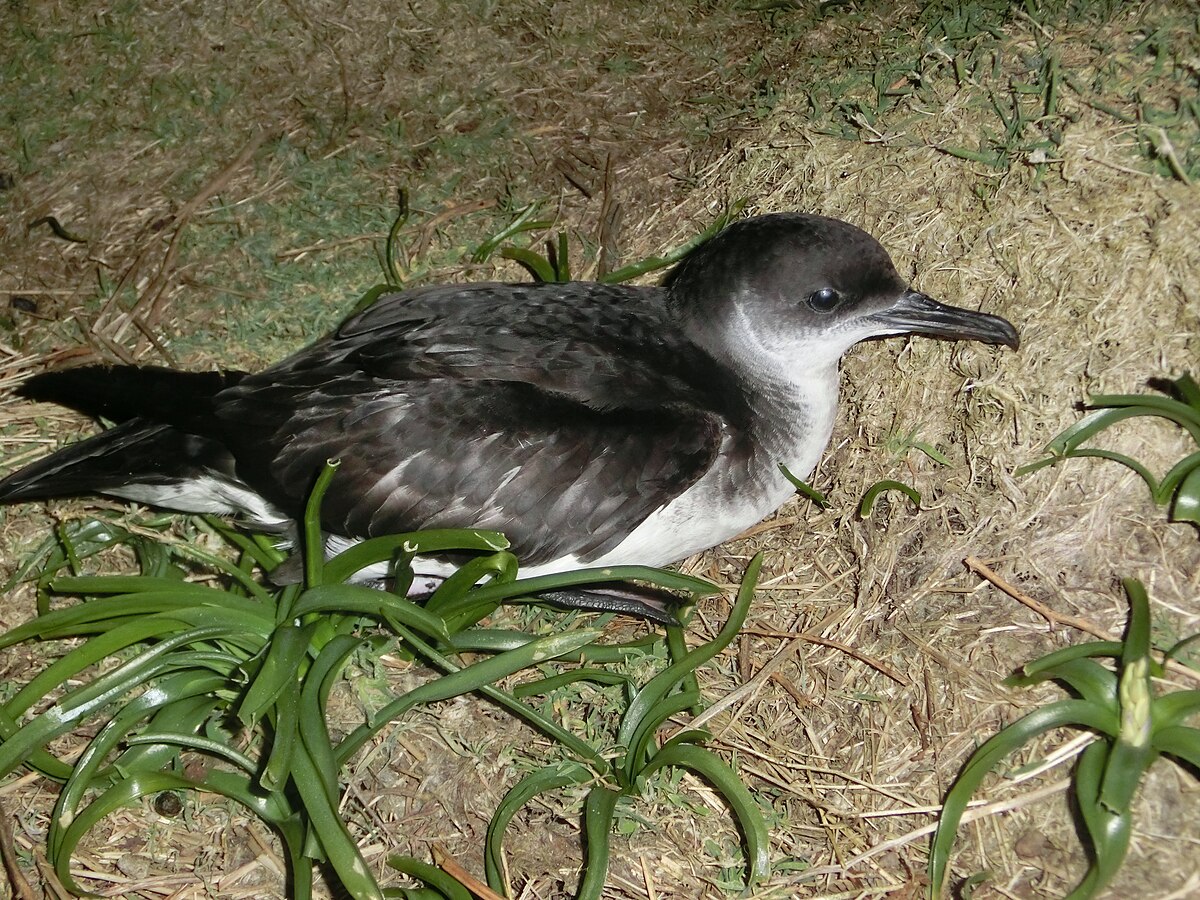
Wikipedia: Manx shearwater Source: OTHER
1200px-Manx_Shearwater.JPG
This bird appears across the great seas in the following continents:
Europe, North America, Africa.
General: ![]() The Manx shearwater (Puffinus puffinus) is a medium-sized shearwater in the seabird family Procellariidae. The scientific name of this species records a name shift: Manx shearwaters were called Manks puffins in the 17th century. Puffin is an Anglo-Norman word (Middle English pophyn) for the cured carcasses of nestling shearwaters. The Atlantic puffin acquired the name much later, possibly because of its similar nesting habits.
[more]
The Manx shearwater (Puffinus puffinus) is a medium-sized shearwater in the seabird family Procellariidae. The scientific name of this species records a name shift: Manx shearwaters were called Manks puffins in the 17th century. Puffin is an Anglo-Norman word (Middle English pophyn) for the cured carcasses of nestling shearwaters. The Atlantic puffin acquired the name much later, possibly because of its similar nesting habits.
[more]
Vocalization: ![]() Vocal at breeding ground. [Link]
Vocal at breeding ground. [Link]
Calls: ![]() The call is sharp and wailing, and consist of two parts. A drawn, "inhalation", is immediately followed by a trisyllabic "ka-ya-ya". [Link]
The call is sharp and wailing, and consist of two parts. A drawn, "inhalation", is immediately followed by a trisyllabic "ka-ya-ya". [Link]
Physical details: length=31-36 cm,
wingspan=76-88 cm,
weight=375-459 g
Profile Wikipedia eBird Xeno-Canto NABU

Wikipedia: Yelkouan shearwater Source: OTHER
Ma_-_Puffinus_yelkouan.jpg
General: ![]() The yelkouan shearwater, Levantine shearwater or Mediterranean shearwater (Puffinus yelkouan[2]) is a medium-sized shearwater in the seabird family Procellariidae.
[more]
The yelkouan shearwater, Levantine shearwater or Mediterranean shearwater (Puffinus yelkouan[2]) is a medium-sized shearwater in the seabird family Procellariidae.
[more]

Wikipedia: Northern fulmar Source: OTHER
Fulmarus_glacialis_Cornwall_UK.jpg
This bird appears across the great seas in the following continents:
Europe, North America.
Deutschland: Brut-, Jahres-, Zugvogel, Wintergast RL R
Vocalization: ![]() Mostly heard on breeding ground. [Link]
Mostly heard on breeding ground. [Link]
Calls: ![]() Coarse, harsh, staccato calls when courting or quarrelling. [Link]
Coarse, harsh, staccato calls when courting or quarrelling. [Link]
Physical details: length=45-50 cm,
wingspan=102-112 cm,
weight=610-1000 g

Wikipedia: Sooty shearwater Source: OTHER
1200px-Puffinus_griseus_in_flight_-_SE_Tasmania.jpg
This bird appears across the great seas in the following continents:
Europe, South America, Africa.
General: ![]() The sooty shearwater (Ardenna grisea) is a medium-large shearwater in the seabird family Procellariidae. Ardenna was first used to refer to a seabird by Italian naturalist Ulisse Aldrovandi in 1603, and grisea is medieval Latin for "grey".[2]
[more]
The sooty shearwater (Ardenna grisea) is a medium-large shearwater in the seabird family Procellariidae. Ardenna was first used to refer to a seabird by Italian naturalist Ulisse Aldrovandi in 1603, and grisea is medieval Latin for "grey".[2]
[more]
Vocalization: ![]() Mostly heard at breeding ground. A peculiar, rhythmic, coarse moaning, with a disyllabic attack, followed by a deeper, cooing "in-breath". [Link]
Mostly heard at breeding ground. A peculiar, rhythmic, coarse moaning, with a disyllabic attack, followed by a deeper, cooing "in-breath". [Link]
Physical details: length=40-51 cm,
wingspan=94-109 cm,
weight=666-978 g

Wikipedia: European storm-petrel Source: OTHER
1200px-European_Storm_Petrel_From_The_Crossley_ID_Guide_Eastern_Birds.jpg
General: ![]() The European storm petrel, British storm petrel, or just storm petrel (Hydrobates pelagicus) is a seabird in the northern storm petrel family, Hydrobatidae. It is the only member of the genus Hydrobates. The small, square-tailed bird is entirely black except for a broad, white rump and a white band on the under wings, and it has a fluttering, bat-like flight. The large majority of the population breeds on islands off the coasts of Europe, with the greatest numbers in the Faroe Islands, United Kingdom, Ireland, and Iceland. The Mediterranean population is a separate subspecies, but is inseparable at sea from its Atlantic relatives; its strongholds are Filfla Island (Malta), Sicily, and the Balearic Islands.
[more]
The European storm petrel, British storm petrel, or just storm petrel (Hydrobates pelagicus) is a seabird in the northern storm petrel family, Hydrobatidae. It is the only member of the genus Hydrobates. The small, square-tailed bird is entirely black except for a broad, white rump and a white band on the under wings, and it has a fluttering, bat-like flight. The large majority of the population breeds on islands off the coasts of Europe, with the greatest numbers in the Faroe Islands, United Kingdom, Ireland, and Iceland. The Mediterranean population is a separate subspecies, but is inseparable at sea from its Atlantic relatives; its strongholds are Filfla Island (Malta), Sicily, and the Balearic Islands.
[more]
Vocalization: ![]() Heard at breeding ground. Dry, cyclic, rattling and cooing, interrupted by deeper nasal moaning or a higher pitched "kee-ee-kee", with emphasis on second syllable. [Link]
Heard at breeding ground. Dry, cyclic, rattling and cooing, interrupted by deeper nasal moaning or a higher pitched "kee-ee-kee", with emphasis on second syllable. [Link]
Physical details: length=14-18 cm,
wingspan=36-39 cm,
weight=23-30 g
This bird appears across the great seas in the following continents:
Europe, North America, South America.
General: ![]() Der Wellenläufer (Oceanodroma leucorhoa) ist eine von weltweit 13 Vogelarten der Gattung der Wellenläufer. Ihren Namen verdanken die Wellenläufer der Verhaltensweise, oft mit herunterhängenden Beinen dicht über dem Wasser zu gleiten. Dabei tauchen sie mit den Füßen ins Wasser ein.
[more]
Der Wellenläufer (Oceanodroma leucorhoa) ist eine von weltweit 13 Vogelarten der Gattung der Wellenläufer. Ihren Namen verdanken die Wellenläufer der Verhaltensweise, oft mit herunterhängenden Beinen dicht über dem Wasser zu gleiten. Dabei tauchen sie mit den Füßen ins Wasser ein.
[more]
Profile Wikipedia eBird Vogelwarte BirdLife ZH ornitho.ch bird-song.ch Xeno-Canto BirdID NABU
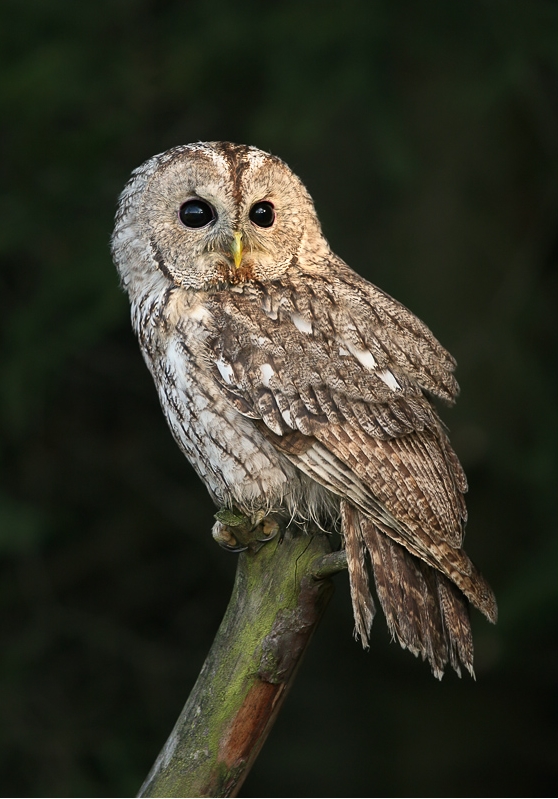
Wikipedia: Tawny owl Source: OTHER
Strix_aluco_3_%28Martin_Mecnarowski%29.jpg
First observed in 🇨🇭 on 2021-04-03.
Zuerst gehört in Carona südlich von Lugano
Vocalization: ![]() Other often heard sounds; a sharp, short, disyllabic "kiu-wik". First syllable ascending then descending, and last ascending in pitch. [Link]
Other often heard sounds; a sharp, short, disyllabic "kiu-wik". First syllable ascending then descending, and last ascending in pitch. [Link]
Song: ![]() Song a resonant descending "hoooooo". After 2-3 sec. [Link]
Song a resonant descending "hoooooo". After 2-3 sec. [Link]
Calls: ![]() typically followed by a slightly ascending, vibrating "hohohohohoho" and quickly another descending "hooooooo". Complete phrase: "hoooooo, hohohohohoho-hoooooo". May omit parts. [Link]
typically followed by a slightly ascending, vibrating "hohohohohoho" and quickly another descending "hooooooo". Complete phrase: "hoooooo, hohohohohoho-hoooooo". May omit parts. [Link]
Physical details: length=37-39 cm,
wingspan=94-104 cm,
weight=340-620 g
Habitats:
Forest
Song:
Automatically generated from Xeno-Canto recording
Song attributes:
Frequency:
♫ Waldkauz in Carona. 2021-04-05 03.44.43 Carona (song)

Wikipedia: Short-eared owl Source: OTHER
1200px-Hibou_des_marais.jpg
This bird appears across the great seas in the following continents:
Europe, North America, South America, Africa, Asia.
Deutschland: Brut-, Zugvogel, Wintergast RL 1
Habitats:
Wetland

Wikipedia: Barn owl Source: OTHER
1200px-Tyto_alba_-British_Wildlife_Centre%2C_Surrey%2C_England-8a_%281%29.jpg
This bird appears across the great seas in the following continents:
Europe, North America, South America, Africa, Asia.
General: ![]() The barn owl (Tyto alba) is the most widely distributed species of owl in the world and one of the most widespread of all species of birds, being found almost everywhere in the world except for the polar and desert regions, Asia north of the Himalayas, most of Indonesia, and some Pacific Islands. It is also known as the common barn owl, to distinguish it from the other species in its family, Tytonidae, which forms one of the two main lineages of living owls, the other being the typical owls (Strigidae).
[more]
The barn owl (Tyto alba) is the most widely distributed species of owl in the world and one of the most widespread of all species of birds, being found almost everywhere in the world except for the polar and desert regions, Asia north of the Himalayas, most of Indonesia, and some Pacific Islands. It is also known as the common barn owl, to distinguish it from the other species in its family, Tytonidae, which forms one of the two main lineages of living owls, the other being the typical owls (Strigidae).
[more]
Vocalization: ![]() Large repertoire of mainly hissing and screeching sounds. [Link]
Large repertoire of mainly hissing and screeching sounds. [Link]
Song: ![]() Song consists of a single, drawn screech, lasting about a second and is often performed in flight. Starting in a very hoarse tone, then progressing with a rising pitch into a more burbling sound, before suddenly ending. [Link]
Song consists of a single, drawn screech, lasting about a second and is often performed in flight. Starting in a very hoarse tone, then progressing with a rising pitch into a more burbling sound, before suddenly ending. [Link]
Physical details: length=33-35 cm,
wingspan=80-95 cm,
weight=240-350 g
Habitats:
Agricultural
Common pheasant (Fasan), Islay en route to Bunnahabhain, Islay. 2023-08-14 10.52.28 Islay
First observed in Islay on 2023-08-14.
This bird appears across the great seas in the following continents:
Europe, North America, Australia.
introduced, King, Flinders & Rottnest Island
Vocalization: ![]() Diverse repertoire of harsh cackling sounds. [Link]
Diverse repertoire of harsh cackling sounds. [Link]
Calls: ![]() Male call can be heard for more than a kilometer away; a very harsh, staccato and explosive "kaa" or "ka-kaa", with last syllable falling in pitch. [Link]
Male call can be heard for more than a kilometer away; a very harsh, staccato and explosive "kaa" or "ka-kaa", with last syllable falling in pitch. [Link]
Physical details: length=53-89 cm,
wingspan=70-90 cm,
weight=750-1700 g
Habitats:
Agricultural
Profile Wikipedia eBird Xeno-Canto NABU
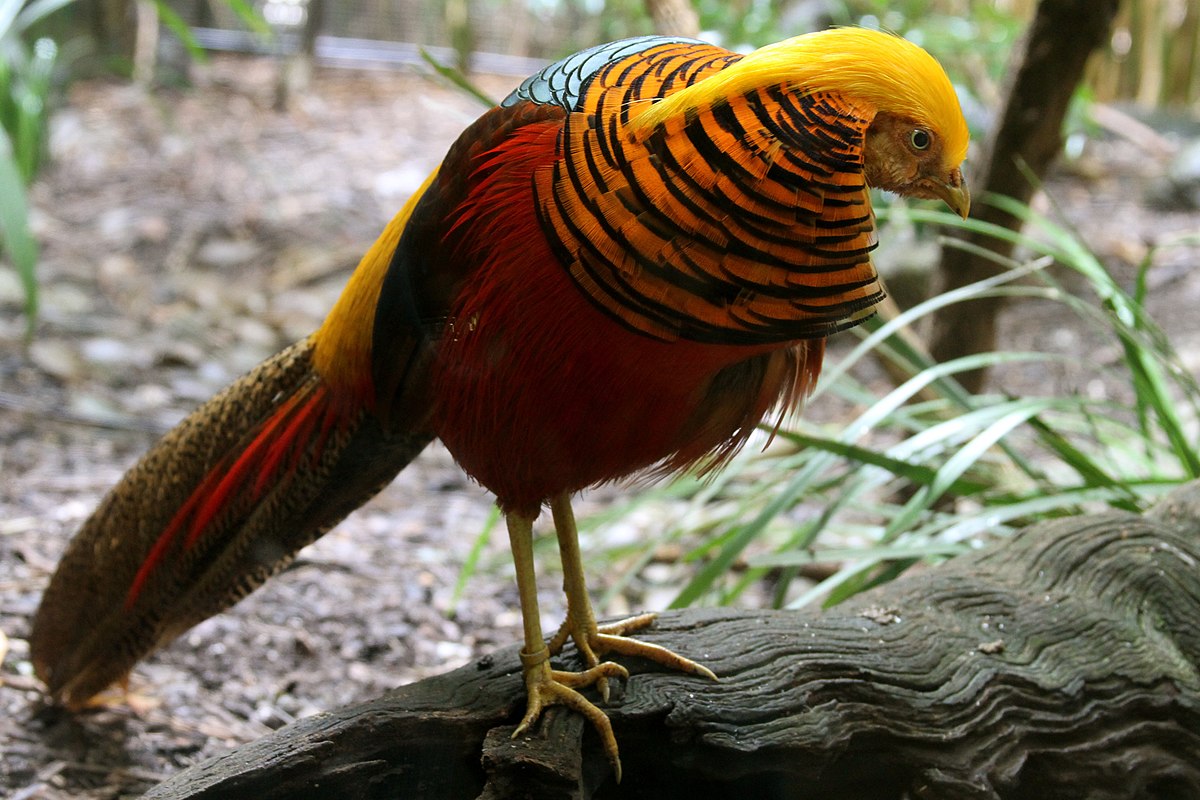
Wikipedia: Golden pheasant Source: OTHER
1200px-Chrysolophus_pictus_-Melbourne_Zoo%2C_Australia-8a.jpg
General: ![]() Phasianus pictus Linnaeus, 1758
[more]
Phasianus pictus Linnaeus, 1758
[more]

Wikipedia: Grey partridge Source: OTHER
1200px-Nurmkanad.jpg
This bird appears across the great seas in the following continents:
Europe, North America.
Deutschland: Brut-, Jahresvogel RL 2
Vocalization: ![]() Also various clucking sounds. [Link]
Also various clucking sounds. [Link]
Song: ![]() Song a sharp, very raspy sound, e.g. "krii-uuu-ii", with middle part lowered in pitch. Often compared to the sound of a rusty gate. [Link]
Song a sharp, very raspy sound, e.g. "krii-uuu-ii", with middle part lowered in pitch. Often compared to the sound of a rusty gate. [Link]
Physical details: length=29-31 cm,
wingspan=45-48 cm,
weight=340-450 g
Habitats:
Agricultural

Wikipedia: Red-legged partridge Source: OTHER
1200px-Perdrix_rouge.jpg
General: ![]() The red-legged partridge (Alectoris rufa) is a gamebird in the pheasant family Phasianidae of the order Galliformes, gallinaceous birds. It is sometimes known as French partridge, to distinguish it from the English or grey partridge. The genus name is from Ancient Greek alektoris a farmyard chicken, and rufa is Latin for red or rufous.[2]
[more]
The red-legged partridge (Alectoris rufa) is a gamebird in the pheasant family Phasianidae of the order Galliformes, gallinaceous birds. It is sometimes known as French partridge, to distinguish it from the English or grey partridge. The genus name is from Ancient Greek alektoris a farmyard chicken, and rufa is Latin for red or rufous.[2]
[more]

Wikipedia: Willow ptarmigan Source: OTHER
1200px-Lagopus_lagopus_-_adult_%28Denali%2C_2010%29.jpg
This bird appears across the great seas in the following continents:
Europe, North America.
![]() The willow ptarmigan (/ˈtɑːrmɪɡən/) (Lagopus lagopus) is a bird in the grouse subfamily Tetraoninae of the pheasant family Phasianidae. It is also known as the willow grouse and in Ireland and Britain, where the subspecies L. l. scotica was previously considered to be a separate species, as the red grouse. It is a sedentary species, breeding in birch and other forests and moorlands in northern Europe, the tundra of Scandinavia, Siberia, Alaska and Canada, in particular in the provinces of Newfoundland and Labrador and Quebec. It is the state bird of Alaska. In the summer the birds are largely brown, with dappled plumage, but in the winter they are white with some black feathers in their tails (British populations do not adopt a winter plumage). The species has remained little changed from the bird that roamed the tundra during the Pleistocene. Nesting takes place in the spring when clutches of four to ten eggs are laid in a scrape on the ground. The chicks are precocial and soon leave the nest. While they are young, both parents play a part in caring for them. The chicks eat insects and young plant growth while the adults are completely herbivorous, eating leaves, flowers, buds, seeds and berries during the summer and largely subsisting on the buds and twigs of willow and other dwarf shrubs and trees during the winter.
[more]
The willow ptarmigan (/ˈtɑːrmɪɡən/) (Lagopus lagopus) is a bird in the grouse subfamily Tetraoninae of the pheasant family Phasianidae. It is also known as the willow grouse and in Ireland and Britain, where the subspecies L. l. scotica was previously considered to be a separate species, as the red grouse. It is a sedentary species, breeding in birch and other forests and moorlands in northern Europe, the tundra of Scandinavia, Siberia, Alaska and Canada, in particular in the provinces of Newfoundland and Labrador and Quebec. It is the state bird of Alaska. In the summer the birds are largely brown, with dappled plumage, but in the winter they are white with some black feathers in their tails (British populations do not adopt a winter plumage). The species has remained little changed from the bird that roamed the tundra during the Pleistocene. Nesting takes place in the spring when clutches of four to ten eggs are laid in a scrape on the ground. The chicks are precocial and soon leave the nest. While they are young, both parents play a part in caring for them. The chicks eat insects and young plant growth while the adults are completely herbivorous, eating leaves, flowers, buds, seeds and berries during the summer and largely subsisting on the buds and twigs of willow and other dwarf shrubs and trees during the winter.
[more]
Calls: ![]() Very characteristic calls: "Kuwa -Kuwa -Kuwa" (go back!) Also: "kauw kauwkkkrrrkekekekekeke" with a short pause after first "kauw", then a decelerating cackle, often followed by the "go back" call. [Link]
Very characteristic calls: "Kuwa -Kuwa -Kuwa" (go back!) Also: "kauw kauwkkkrrrkekekekekeke" with a short pause after first "kauw", then a decelerating cackle, often followed by the "go back" call. [Link]
Physical details: length=37-42 cm,
wingspan=55-66 cm,
weight=450-750 g

Wikipedia: Black grouse Source: OTHER
1200px-Black_Grouse_Nationalpark_Bayerischer_Wald.jpg
Rolf hat einen auf dem Amdener Hoehenweg Mai 2023 gesehen, wuerde den gerne sehen!
Habitats:
Mountain
Song:
Song can be a rapid dove-like cooing that goes up, then repeats.
Song attributes:
Melody: simple rhythmic, slow, Frequency: 0-1 KHz
♫ Source: XENOCANTO
XC731604 - Black Grouse - Lyrurus tetrix.mp3
(song)
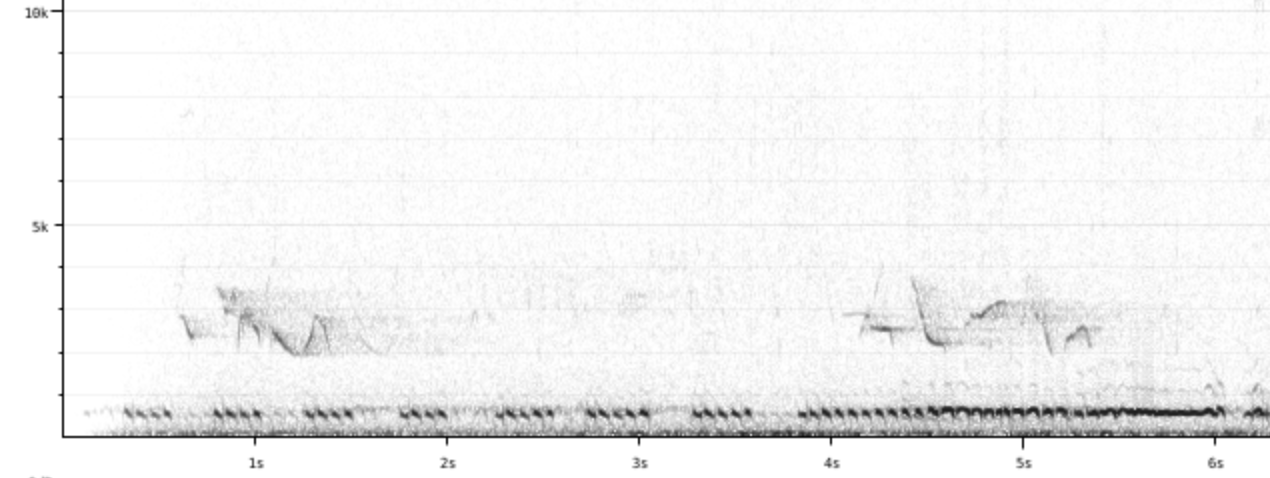
Mauersegler, Sils-Maria. 2020-06-10 12.30.10 Sils
First observed in 🇨🇭 on 2020-06-10.
Vielleicht haben wir bald Mauersegler Brutkaesten am Haus!
Vocalization: ![]() A shrilling trill "zreeeee" of about 1 -2 seconds length, gradually rising in pitch with accentuated firs half, then falling from the middle of phrase. [Link]
A shrilling trill "zreeeee" of about 1 -2 seconds length, gradually rising in pitch with accentuated firs half, then falling from the middle of phrase. [Link]
Calls: ![]() Often continued with a dry lower pitched "trrrrrr" before calling again. Very vocal at breeding area, and often a flock will call together. Despite being quite similar to Pallid Swift, the call is probably the best field character to separate the two. Pallid puts the stress on the ending of the call, followed by a quick fall in pitch (dynamics like moaning with a quick release). Plain Swift calls similar to Common Swift, but differs in slightly fluctuating pitch during the call, and a loss of resonance towards the ending (thinner sounding). [Link]
Often continued with a dry lower pitched "trrrrrr" before calling again. Very vocal at breeding area, and often a flock will call together. Despite being quite similar to Pallid Swift, the call is probably the best field character to separate the two. Pallid puts the stress on the ending of the call, followed by a quick fall in pitch (dynamics like moaning with a quick release). Plain Swift calls similar to Common Swift, but differs in slightly fluctuating pitch during the call, and a loss of resonance towards the ending (thinner sounding). [Link]
Physical details: length=16-17 cm,
wingspan=42-48 cm,
weight=31-56 g
Habitats:
Settlement